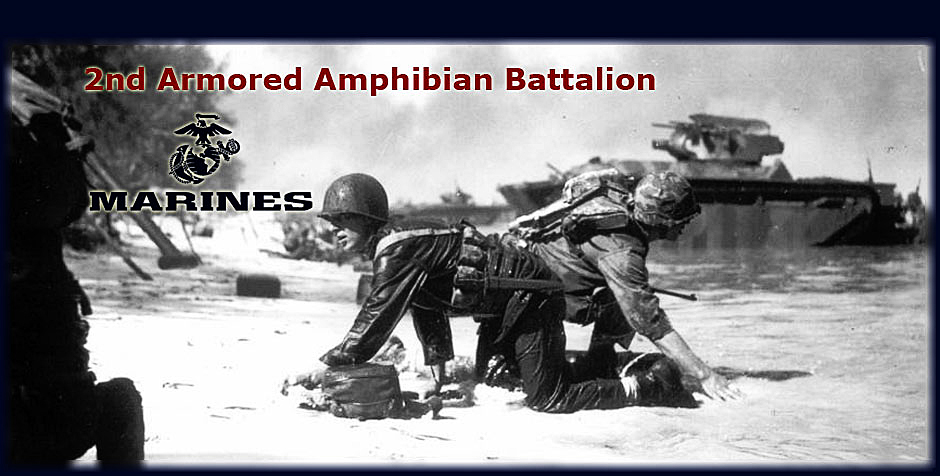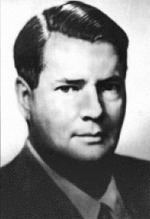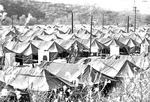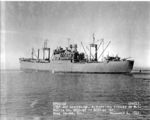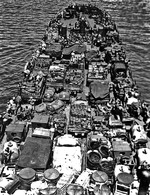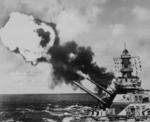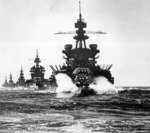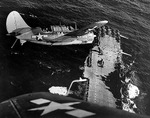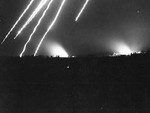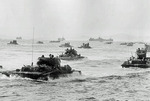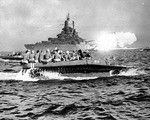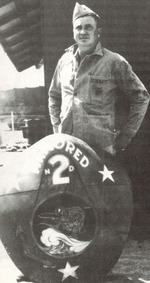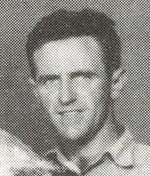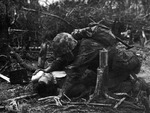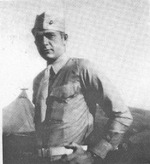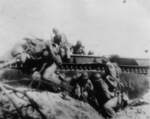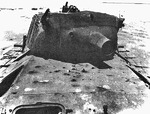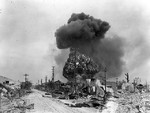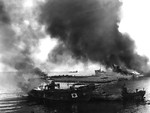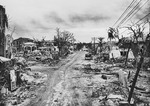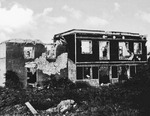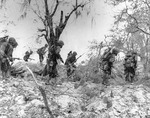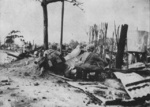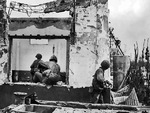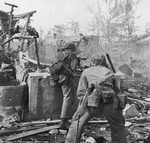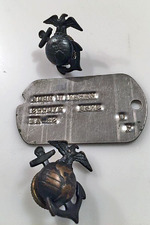GENESIS - Tarawa:
The 2nd Armored Amphibian Battalion was specially designed during the Central Pacific Campaign. This 8000-mile seaborne thrust to the Asian rim began 20 November 1943 at Tarawa. Later, seeing the carnage where 6000 US Marines and Japanese warriors lay dead on Betio's 294 acres, General Holland M. Smith USMC, when asked how the Marines took the atoll, said: I don’t know. It was the most fortified place on earth, never seen anything like it.
One Japanese defender explained simply that: the Marines just kept coming.
 Click to Enlarge p1General Smith wrote later: I realized then we were entering a new uncharted land... guided only by theory and peacetime maneuvers...and, on our first frontal attack on a fortified enemy atoll, we were ignorant of its capacity for resistance and of our own limitations... and I made up my mind that all future landings would be spearheaded by amphibious vehicles...and amphibian tanks, carrying heavier guns. 1/
Click to Enlarge p1General Smith wrote later: I realized then we were entering a new uncharted land... guided only by theory and peacetime maneuvers...and, on our first frontal attack on a fortified enemy atoll, we were ignorant of its capacity for resistance and of our own limitations... and I made up my mind that all future landings would be spearheaded by amphibious vehicles...and amphibian tanks, carrying heavier guns. 1/
Within days after Tarawa Marines began to assemble in the Boat Basin at Oceanside, CA., for an Armored Amphibious Assault Battation yet to be activated. Most were young, between 17 to 21 years old, recently enlisted to serve for the war's duration. Most had never been in combat. Now at Marine Corps Base Camp Pendleton they'd have 90 days to become a battation of 840 men who'd fight 70 amphibious tanks never before used in combat, leading shock troops into three epic battles of perhaps the greatest seaborne offensive in the history of war.
(For Central Pacific Campaign background see Footnote 2 below/)
BATTALION ASSEMBLES at Boat Basin between 1 Dec 1943 and 24 Jan 1944:
JERRY D. BROOKS: I was 15 when the Japs hit Pearl Harbor. Afraid the war would end before I graduated from high school, I got dad's permission and volunteered for the Marine Corps, after the 11th grade. Just 17, I'd never left Wichita, Kansas. So, headed west by train, I was amazed to see mountains and then the huge ocean. In San Diego, California, Marine NCOs met us at the train station. When their Marine Corps bus closed its doors, I was in the United States Marine Corps for sure. In Boot Camp at San Diego I listed my two top choices for advanced training as Paramarines and Raiders. My 3rd choice as Radio since my dad said that I'd learn a trade like he'd done in the Navy learning to be a barber while aboard the USS Nebraska in WW1. The Paramarines and Raiders disbanded before I graduated, so they sent me to radio school then advanced infantry training at Camp Pendleton. There, the place was so large and poorly laid out with hundreds of barracks willy-nilly on crooked roads and tent camps off in the boondocks, we sometimes got lost just trying to find its front gate. Coming in after dark from weekend Liberty, you could wander until sunrise trying to find your barracks. One day I saw a small sign posted on my barracks bulletin board saying: Volunteers wanted for Special Combat Unit. Everyone said it was hush-hush, being formed for immediate combat, just what I wanted. Me and a buddy signed up. Within 48 hours we were trucked to the Boat Basin at Oceanside. There the 2nd Armored Amphibian Battalion was being formed up quick to fight after all the beach losses at Tarawa.
Note: Jerry Brooks wrote 47 illustrated letters home to his parents telling about his experiences at Marine Corps Boot Camp at Marine Recruit Depot, San Deigo, California. Click on Boot Camp Letters within the above Banner to see those letters and illustrations.
JAMES A. (AL) SCARPO: I came direct from LVT driver and maintenance School at Dunedin, Florida. There, one day outside the gate, we stood thumbing for a ride to St. Peterburg. A 300 pound man in a Lincoln Zephyr picked us up. How do you like your amphibian tractors, he asked. One of us said Their inventor should be in hell with his neck broke. The man smiled. Dropping us off in St. Peterburg, he invited us to visit his estate and use his pool while at Dunedin. He was Donald Roebling, the inventor of what we were learning the drive. This was the Donald Roebling I knew, said Battalion CO Reed M Fawell Jr. years later.
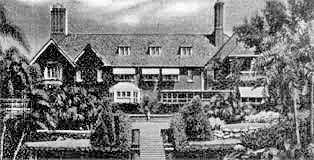 DONALD ROEBLING ESTATE, CLEARWATER, FLA. p3TOBY THOBE: Early amtracs often slipped a track crossing Dunedin's shallow bays, I taught students to dive in, find and reinstall the track. Dunedin was my honeymoon place before I helped set up the LVT school at Camp Lejeune, NC. I joined the 2nd Armored after Saipan. Seeing officers I'd earlier taught at Dunedin - Bill Manner, Basel Godbold, Dale Andrews, Lee Morrison & Quintin Hadwiger - felt like coming home.
DONALD ROEBLING ESTATE, CLEARWATER, FLA. p3TOBY THOBE: Early amtracs often slipped a track crossing Dunedin's shallow bays, I taught students to dive in, find and reinstall the track. Dunedin was my honeymoon place before I helped set up the LVT school at Camp Lejeune, NC. I joined the 2nd Armored after Saipan. Seeing officers I'd earlier taught at Dunedin - Bill Manner, Basel Godbold, Dale Andrews, Lee Morrison & Quintin Hadwiger - felt like coming home.
JAMES D. MACKEY: At Pendleton a notice went up: Wanted! Experienced tank men, drivers, other crew, all volunteers for new amphibious assault group. When Rose, Miller and I reported to the Boat Basin early, they sent us to a tent with a cot, two blankets, overcoat, a sea bag, and 3 Sergeants who put us through Col. Hanley's 3 week Raider physical combat training school. Now Boot Camp looked like a Sunday School picnic: bayonet and knife fighting then crawls through barbed wire under live fire during daylight followed by night marches hauling packs & weapons for 10 miles in 75 minutes at a half run/half swinging walk up and down hills without stop firing 30 & 50 ca. machine guns.
 Click to Enlarge p3ADONALD B. MARSHALL - 5th Amphibious Tractor Battalion: "(At) Pendleton ... I joined a platoon going through Raider physical combat school. Col. Hanley headed it. He and 3 sergeants made us wish we were back in Boot Camp. We double-timed every place ... We navigated inflated rubber boats in pouring rain at night through a muddy swamp, we crawled under machine gun fire, set booby traps, learned jujitsu and knife and club combat ... and had to complete a ten mile run in an hour and 15 minutes. A Marine there from 2nd Armored Amphibian Battalion, a sergeant named Mackey about 30 years old and hard as a rock, reminded me of Sgt. Allred. He never puffed. "If that old man could do it, I can," I kept telling myself. See AlligatorMarines.com
Click to Enlarge p3ADONALD B. MARSHALL - 5th Amphibious Tractor Battalion: "(At) Pendleton ... I joined a platoon going through Raider physical combat school. Col. Hanley headed it. He and 3 sergeants made us wish we were back in Boot Camp. We double-timed every place ... We navigated inflated rubber boats in pouring rain at night through a muddy swamp, we crawled under machine gun fire, set booby traps, learned jujitsu and knife and club combat ... and had to complete a ten mile run in an hour and 15 minutes. A Marine there from 2nd Armored Amphibian Battalion, a sergeant named Mackey about 30 years old and hard as a rock, reminded me of Sgt. Allred. He never puffed. "If that old man could do it, I can," I kept telling myself. See AlligatorMarines.com
QUENTIN HADWIGER: An Oklahoma farm boy, I saw a sign: Wanted! Volunteers for Amphibious Tractors. Tractors gotta be right for me, I figured. But they didn't tell you those 'tractors' were the first wave. That came later.
MARSHALL E. HARRIS: My buddies and I at Radio School spotted the Wanted, all Volunteers sign after someone added in bold black letters: Combat Guaranteed! Seeing that, we signed up and told our friends who said: "Combat Guaranteed! that's B/S, tanks don't float!." Finally we convinced them that ours did, so lots of radio guys joined up with us, a very good thing given the huge shortage of radio operators in the Corps. (Note: Battlefield Radio communication, a burgeoning little understood new technology, was critical to tank warfare.)
RICHARD W. MASON: When the Raider Battalion was deactivated, our Master Sergeant said a special assault group was forming up at the Boat Basin. I got over there. First they sent me to an ordinance school: 50 cal. machine gun, rocket, etc. C. W. (BILL) GOODNIGHT: Just after we'd graduated from Jacques Farm tank school outside San Diego, the Colonel asked for volunteers to start something totally new, an amphibian tank battalion. We volunteered.
RICHARD W. MASON: At the Boat Basin, before the 2nd Armored formed up, Sleepy Adams showed me how to drive an amphibian tractor. Then I made Pfc and didn't have to fall in line when Sgt. Outen hollered: Privates outside! Now my rank meant something to me. Still, with only two blankets, I was cold at night even though we got an extra blanket after some officers arrived. So I still wore my long underwear from Idaho to bed.
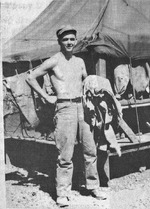 Click to enlarge G. Shirley, p4 G. MILTON SHIRLEY: A bunch of us were trucked to Boat Basin in early December. About 160 Enlisted Men were there but no officers. No one had the slighest idea what was going on. Feeble attempts at a 6 AM roll call produced maybe 30 people. Our tent was situated just right. If I slept in its front corner and heard my named called, I'd just open a hole in the tent and yell out Here!" I didn't even have to get off the cot. My mother sent me a Cake Full of Nuts for Christmas. Three of us on Xmas Eve sat feasting on Nut Cake and Limburger Cheese washed down with beer. Later I spent a lot of time using a brush to Stencil names on our gear until I got the bright idea of using a spray gun instead of a brush. It did the job much quicker. But when Major Williamson caught me, I thought I'll die with my boots on. Instead he said: "That's a damn good idea! Pass the word down the line to the rest of the men."
Click to enlarge G. Shirley, p4 G. MILTON SHIRLEY: A bunch of us were trucked to Boat Basin in early December. About 160 Enlisted Men were there but no officers. No one had the slighest idea what was going on. Feeble attempts at a 6 AM roll call produced maybe 30 people. Our tent was situated just right. If I slept in its front corner and heard my named called, I'd just open a hole in the tent and yell out Here!" I didn't even have to get off the cot. My mother sent me a Cake Full of Nuts for Christmas. Three of us on Xmas Eve sat feasting on Nut Cake and Limburger Cheese washed down with beer. Later I spent a lot of time using a brush to Stencil names on our gear until I got the bright idea of using a spray gun instead of a brush. It did the job much quicker. But when Major Williamson caught me, I thought I'll die with my boots on. Instead he said: "That's a damn good idea! Pass the word down the line to the rest of the men."
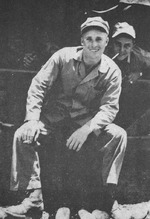 Click to enlarge Stallman p5TOM STALLMAN: At about 10 PM at the Jacques Farm tank school a Public Address system ordered me to report to Headquarters. There I was instructed to pack and leave for the Boat Basin by 11 AM next morning.
Click to enlarge Stallman p5TOM STALLMAN: At about 10 PM at the Jacques Farm tank school a Public Address system ordered me to report to Headquarters. There I was instructed to pack and leave for the Boat Basin by 11 AM next morning.
HARLAN ROSVOLD: After boot camp, I went to Jacques Farm, also near La Jolla, to the land tank school. We trained in the prewar light tanks and later in the M-4 Shermans. About the time I got comfortable and taking a liking to these medium land monsters, word came down that a new Amphibian Tank Battalion was being formed at the Boat Basin, near Oceanside, CA. Many of us were "volunteered" for this group. So later there, I'd start training in seagoing tanks much different from the Shermans.
JOHN L. LEWIS: When I arrived, Captain Bevans, the highest ranking officer, called me into his office and asked "could I handle an important job?" "Do my best Sir." "Okay, go to the PX and fetch me a carton of cigarettes." Then he was promoted to Major.
HAROLD C. MOODY: I went from Boot Camp into Amphibian Training at Oceanside. A Master Sergeant who'd come out of retirement ran things there always said: This is a hell of a way to fight a war. One morning he struck his head outside his tent, pointed into the distance and yelled at me: S-bird. See that hill? They're forming a new battalion up there. You've been wanting action. You'll get plenty with that group. Grab your gear and get over there.
 JACK WHITIS SAIPAN p6JACK W. WHITIS: At the Boat Basin I was sent to a class given by our Company Clerk Robert Rose on the 30 Cal. machine gun under Gunnery Sergeant John Liberatore's supervision. Fletcher Jones and I, caught goofing off, were ordered to field strip the weapon. Smart alecks fresh out of ordinance school, we stripped then reassembled weapon lickedly split while rattling off the name and function of each part. So impressed was Platoon Sergeant Wally Johnson, he had us circle the camp 3 times trotting at double time with weapons held high. We were really off to a great start with this new outfit.
JACK WHITIS SAIPAN p6JACK W. WHITIS: At the Boat Basin I was sent to a class given by our Company Clerk Robert Rose on the 30 Cal. machine gun under Gunnery Sergeant John Liberatore's supervision. Fletcher Jones and I, caught goofing off, were ordered to field strip the weapon. Smart alecks fresh out of ordinance school, we stripped then reassembled weapon lickedly split while rattling off the name and function of each part. So impressed was Platoon Sergeant Wally Johnson, he had us circle the camp 3 times trotting at double time with weapons held high. We were really off to a great start with this new outfit.
L. H. VAN ANTWERP: In Dec. '43 I was assigned to Maintenance Section. Ralph Bevans was our CO, Lee Morrison our Maintenance Officer. We had no Mess Hall so crossed a ravine into another camp to get chow. New people arrived every day, some from Dunedin's LVT School. At that early stage before our Battation CO arrived many of us were on an ego trip, and couldn't work together well. At night we had smokers and sometimes a too well attended Slop Chute.
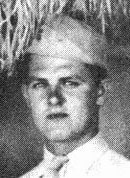 CHARLES H. ORLOSKI p7CHARLES H. ORLOSKI: Restless at Pendleton I wanted more action. So the Post Troop Sgt. Major got me transferred to the 2nd Armored being formed to fight.
CHARLES H. ORLOSKI p7CHARLES H. ORLOSKI: Restless at Pendleton I wanted more action. So the Post Troop Sgt. Major got me transferred to the 2nd Armored being formed to fight.
HAROLD C. MOODY: The battalion had only one amtank, a few men, and hardly any training in how to drive it. GENE LEWIS: I joined from Pendleton's Radio School in February, we had a long way to go, not even close to a full complement of men and gear. We drove a few old LVT(A)1 tanks in and out of surf, none had a working radio.
JOHN C CRAWELY: In the fall of '43 the Boat Basin's Commanding Officer told me to round up 20 good men, go to Hawaii and drive four brand new LVT(A)1 amphibian tanks over the reefs there to see what they could and could not do. That fun duty lasted three months. Then I joined the 2nd Armored Amphibian Battalion, a great bunch of Marines.
R. CARL SCHMIDT: On 2 Nov. 1943 Lt. Crawley took a small group of us to Oahu to experiment on how to blow a path through coral reefs for tanks using car inner-tubes filled with dynamite and other explosives. We always saved the day's last charge for a school of stunned fish that we then traded to the natives for drinks. We returned to the Boat Basin and joined the 2nd Armored on Feb 5, 1944.
JERRY D. BROOKS: I didn't get to Oceanside until March. This was after Boot Camp and Radio school at the San Diego Depot then Advanced Infantry Training at Pendleton. So in January and February at Pendleton, carrying heavy packs and rifles, we scampered up and down cargo nets hanging down the steel sides of ships. Never forget it. Offshore, with us combat loaded, we be hanging off and swinging around on the ropes dangling off sides pf ships, everything in our topsy turvy world seemed precarious - the tall high wall of the ship plunging up and down and high above little Higgins Boat bobbing alongside far below on a wind whipped ocean with us hanging high above with heavy packs and rifles dangling from ropes, all of us swinging and jerking and scrapping, going down the steel sided ship, toward the little open Higgins Boat bobbing below - and with everything moving in our vertical world it got scary and then it got more scary when finally with us trying to get into the Higgins boat that was still bobbing around us tethered to the ship, all moving in opposite directions; the crazy scene of moving steel parts threatened to catch us in between the ship's and boat's walls, crush a leg or more. And then, once we'd dropped abruptly into the Higgins boat, we had to climb back out, going up again into the air, dangling off ropes swinging from the ship still moving up and down on the waves. Finally we'd climb up over its top rail and onto its deck at last, exhausted.
ORIE F. MORGAN: I graduated from Navy Corpsmen school with John H. Brady. He joined the 5th Marine Division and raised the flag on Iwo Jima's Mount Suribachi. I was on Iwo when the flag went up but unlike John I went onto the 2nd Armored after we graduated and detoured first to Saipan and Tinian. Most new Navy Corpsmen were sent to 5th & 6th Marine Divisions being built at the time.
BATTALION Activates & Trains at BOAT BASIN between 24 JAN and 26 APRIL 1944:
The Battalion's Headquarters & Service Company was activated 24 Jan 1944 when Lt. Col. Reed M. Fawell, Jr. arrived from the South Pacific where he'd served as CO, 1st Tank Battalion, 1st Marine Division. Unknown to Col. Fawell or the Marine Corps, his yet to be formed 2nd Armored Amphibian Battalion's primary weapon was only a flash of inspiration in the mind of one man. Only days before US Army Col. William S. Triplet had a grand revelation. After he'd struggled through his waking, dozing, and sleeping hours ... with mental arithmetic, theories of organization, training problems, and tactical uses of amphibian combat ... Col. Triplet realized that the LVT(A)1 Amphibious Tank would be playing David versus Goliath ... throwing shot with the explosive power of a hand grenade (unless we got) a 75mm shell with 8 times the power. 3/ A fix was desperately needed. Col. Triplet's remedy dropped the open topped M8 75mm howitzer turret into the open body of a LVT(A)2 amtrac. This created an upgunned Amphibian Tank with 8 times the hitting power of its predecessor.
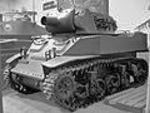 75 MM HOWITZER p8
75 MM HOWITZER p8 LVT(A)2 Click to Enlarge p8AIt's main gun (the 75mm howitzer) was test fired once in quiet offshore California waters in late February, 1944. Since the monster when fired didn't captsize, the Navy gave it a quick 2nd look then rushed it into production by the Food Machinery Corp in Riverside, Ca.
LVT(A)2 Click to Enlarge p8AIt's main gun (the 75mm howitzer) was test fired once in quiet offshore California waters in late February, 1944. Since the monster when fired didn't captsize, the Navy gave it a quick 2nd look then rushed it into production by the Food Machinery Corp in Riverside, Ca.
Meanwhile, at the Boat Basin, new recruits arrived daily, filling the ranks of the novel 840 man battalion with newly minted and just arrived officers who took charge of new companies and platoons being organized daily, until more senior officers arrived. Some learned to drive worn out LVT(A)1s. No one knew their training would be cut five months short. Or that they'd end up driving different machines. Ones just off drawing boards and assembly lines, revolutionary weapons with unknown capabilities, untested in manuevers or battle, leading the charge into a vicious island beach assault unlike any that had gone before.
(See PART D of Amphibious Tank Section for amtank Battalion's Table of Organization.)
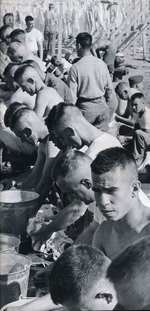 Click to Enlarge p8BROBERT E. WOLLIN: On 28 January 1944 Marvin M. Cleveland, James R. McCarter, Philo R. Please and I reported for duty to Col. Fawell. All 2nd Lts we'd just graduated from Jaques Farm Tank School. Most of us had trained with land tanks, artillery or amphibian tractors. None had trained with LVT(A)1 amphibian tanks. Or heard of the LVT(A)4 we'd get just before battle. Our first task was to get the battalion's platoons and companies up and running. Col. Fawell put Please, McCarter and I in charge of starting Company A. Three green officers trying to jumpstart the beginnings of a brand new kind of fighting unit, we ran it as a 'Community Project. Kept our recruits busy with exercise, close order drill, and scurrying about getting physicals, teeth checked, scrubbing down, laundering up, fitted for boondockers and slotted into tasks.
Click to Enlarge p8BROBERT E. WOLLIN: On 28 January 1944 Marvin M. Cleveland, James R. McCarter, Philo R. Please and I reported for duty to Col. Fawell. All 2nd Lts we'd just graduated from Jaques Farm Tank School. Most of us had trained with land tanks, artillery or amphibian tractors. None had trained with LVT(A)1 amphibian tanks. Or heard of the LVT(A)4 we'd get just before battle. Our first task was to get the battalion's platoons and companies up and running. Col. Fawell put Please, McCarter and I in charge of starting Company A. Three green officers trying to jumpstart the beginnings of a brand new kind of fighting unit, we ran it as a 'Community Project. Kept our recruits busy with exercise, close order drill, and scurrying about getting physicals, teeth checked, scrubbing down, laundering up, fitted for boondockers and slotted into tasks.
JAMES R. MACARTER: Col. Fawell made 2 Lt. Bob Wollin temporary CO of A Company. 2d Lt. Pease got command of 1st Platoon. I got the 2nd and 2nd Lt. Nichol's got the 3rd. Our Company Maintenence officer 1st Lt. Cleaveland and I worked on getting a training schedule into operation. Using beat up Army DUKW's to do beach landings we'd come out soaking wet, wondering how we'd ever control the things during a real landing under fire.
(The first line Company, A Company, was activated 2 Feb 1944, 9 days after Col. Fawell's arrival.)
L. H. VAN ANTWERP: With Col. Fawell in command by February and most officers aboard, things got better organized. A month later (March) we'd started to become a real battalion, increasingly effective working in teams despite our training in beat up equipment. Next month we shipped overseas, in late April.
WINTON W. CARTER: With all the good food now our general belief was: This Commanding Officer must know somebody.
 Gunny Roberts p9ROBERT C. ROSE (via Violet Rose): Once a month Gunnery Sergeant George Roberts came over to our Company Clerk's Office, sat down at our typewriter and went to work writing his wife. Every so often he'd ask where a key was, I'd show him and he'd continue typing. He'd take about an hour and I'd think he'd typed several pages, but he'd only managed a single small paragraph. Gunnery Sergeant Roberts had lots of patience in all things save for military matters. In matters of war, this man was trained and geared for action. When things got toughest in battle, he'd tell me: It's better than no war at all.
Gunny Roberts p9ROBERT C. ROSE (via Violet Rose): Once a month Gunnery Sergeant George Roberts came over to our Company Clerk's Office, sat down at our typewriter and went to work writing his wife. Every so often he'd ask where a key was, I'd show him and he'd continue typing. He'd take about an hour and I'd think he'd typed several pages, but he'd only managed a single small paragraph. Gunnery Sergeant Roberts had lots of patience in all things save for military matters. In matters of war, this man was trained and geared for action. When things got toughest in battle, he'd tell me: It's better than no war at all.
RAY SHERMAN: As Platoon Sergeants we took the men into the boondocks to keep them fit and do schools on tactics and small arms, Jap weapons and fortifications, gear care, and whatever came up.
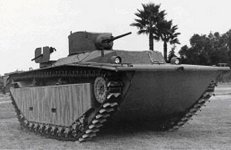 LTV(A)1 Amphibian Tank p10 JAMES A. (AL) SCARPO: Our 1st job in maintenance was getting operational the few LVT's others had left behind. Among many problems, the breaker points in their magnetos had frozen in salt air. After we got the machines up and running, the Enlisted learned to drive in daytime, the Officers learned in the evening. The most critical skill was going in and out of the surf without being swamped or stalling out. But we learned in what we'd never use, LVT(A)1s. The much heavier LVT(A)4s with big 75mm Howitzer open turret gun arrived just in time for Saipan.
LTV(A)1 Amphibian Tank p10 JAMES A. (AL) SCARPO: Our 1st job in maintenance was getting operational the few LVT's others had left behind. Among many problems, the breaker points in their magnetos had frozen in salt air. After we got the machines up and running, the Enlisted learned to drive in daytime, the Officers learned in the evening. The most critical skill was going in and out of the surf without being swamped or stalling out. But we learned in what we'd never use, LVT(A)1s. The much heavier LVT(A)4s with big 75mm Howitzer open turret gun arrived just in time for Saipan.
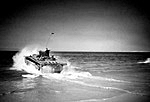 LVT(A)1 p11ORIE F. MORGAN: In January Sergeant James R. (Pappy) Morris spotted me, a just arrived raw recruit medic walking the beach, and hollered "Hop aboard. As I dropped into the radioman's seat he headed into the surf. Gotta hit it straight," he yelled, plunging into a high breaker, "or she'll flip. And men drown." My knuckles whitened, holding on. Surfing a wave back onto the beach, he said, "If one track digs into sand first, it turns her over." Ashore with impish grin, he asked. "Want another spin?" "No!"
LVT(A)1 p11ORIE F. MORGAN: In January Sergeant James R. (Pappy) Morris spotted me, a just arrived raw recruit medic walking the beach, and hollered "Hop aboard. As I dropped into the radioman's seat he headed into the surf. Gotta hit it straight," he yelled, plunging into a high breaker, "or she'll flip. And men drown." My knuckles whitened, holding on. Surfing a wave back onto the beach, he said, "If one track digs into sand first, it turns her over." Ashore with impish grin, he asked. "Want another spin?" "No!"
 Click to Enlarge p11AROBERT E. WOLLIN: Early on Col. Fawell told us to take Company A for bivouac training in the boondocks north of Oceanside. This mission in hindsight was good for us and the Colonel. It got us out from underfoot raising clouds of dust from close order drill at the Colonel's ever more crowded Boat Basin Camp filling up daily with newcomers that he had to form up into other companies.
Click to Enlarge p11AROBERT E. WOLLIN: Early on Col. Fawell told us to take Company A for bivouac training in the boondocks north of Oceanside. This mission in hindsight was good for us and the Colonel. It got us out from underfoot raising clouds of dust from close order drill at the Colonel's ever more crowded Boat Basin Camp filling up daily with newcomers that he had to form up into other companies.
Fortunately Gunny Sergeant Clarron T. Miller (who later won a field commission on Saipan) was assigned to help us. A day or two out one of our trucks fording a stream sank in quicksand at a spot within sight of where the Commanding General each morning and evening passed by going to and from his quarters in the hinderland. We labored for days, shoveling out the truck while trying to hide it from the General. A tank retriever finally hauled it out and Lt. Cleveland got the idea of field stripping then reassembling the truck. It's simple, we call it a training exercise for our maintenance section, making it good as new." His ploy worked. We got training reassembling it better than before. I escaped the brig for destroying of US Government Property. (This tank retriever may well have been operated by PFC James William Gabisch from Helena, Montana, who'd been trained for this job, along with tank transport and maintenance, skills and capabilities that would play important rolls in the upcoming battle for Saipan.)
Next we reported to the aerial gunnery range on the beach near Del Mar, CA. There a frightened pilot towed sleeve targets out over the water as we fired 50 Cal. AA machine guns at the targets floating behind his plane. I say a frightened pilot because we kept hitting his 50-100 yard long towing cable, severing it, dropping his targets into the sea. After this event Col. Fawell relieved me from command of Company A. Next I started up Commany D, tackling the job like a seasoned veteran, sure that I'd made and learned from all possible mistakes with A Company. (D Company was activated 1 March 1944)
JAMES R. MACARTER: Then 1st Lt. Platt took command of A Company and 1st Lt. Pickett became his Executive Officer.
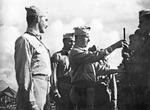 CLICK TO ENLARGE p12CHARLES F. AMBROSE - COMPANY D: Capt. Handyside commanded D Company. I became his Exec. Trained for artillery and Carlson's Raider's, I didn't know amtracs but the Captain did. So did Lts. Wollin and Manner. Lt. Godbold was a near genius in tractor & tank maintenance. Warrant Officer Liberatore knew tanks and artillery. Handyside did a great job welding our diverse group into a team. We had 3 platoons and Company HQ Section. Gunnery Sgt George Roberts, one of the finest Marines I ever worked with, could really ramrod men. We had little equipment and didn't get into LVT(A)4 amphibian tanks until Maui then left so fast we had to be trained the tough way, in battle on Saipan. Photo shows Lt. Wollin on left with Lt. Thobe behind Col. Fawell.
CLICK TO ENLARGE p12CHARLES F. AMBROSE - COMPANY D: Capt. Handyside commanded D Company. I became his Exec. Trained for artillery and Carlson's Raider's, I didn't know amtracs but the Captain did. So did Lts. Wollin and Manner. Lt. Godbold was a near genius in tractor & tank maintenance. Warrant Officer Liberatore knew tanks and artillery. Handyside did a great job welding our diverse group into a team. We had 3 platoons and Company HQ Section. Gunnery Sgt George Roberts, one of the finest Marines I ever worked with, could really ramrod men. We had little equipment and didn't get into LVT(A)4 amphibian tanks until Maui then left so fast we had to be trained the tough way, in battle on Saipan. Photo shows Lt. Wollin on left with Lt. Thobe behind Col. Fawell.
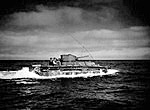 LVT(A)1 p13RAY SHERMAN - COMPANY D: LVTs had been left by outfits before us, all beat up LVT(A)1s and troop carriers (LVTs) stripped of weapons. All we could do was run up and down the beach and go into the surf a bit. I don't recall any 37mm, 75mm, or 30 cal or 50 cal. machine guns at the Boat Basin.
LVT(A)1 p13RAY SHERMAN - COMPANY D: LVTs had been left by outfits before us, all beat up LVT(A)1s and troop carriers (LVTs) stripped of weapons. All we could do was run up and down the beach and go into the surf a bit. I don't recall any 37mm, 75mm, or 30 cal or 50 cal. machine guns at the Boat Basin.
(B Company was activated 15 Feb 1944; C Company on 21 Feb 1944)
JOHN ELOFF - COMPANY B: Right after I had arrived at Oceanside very late in the game, I came upon five Guadalcanal vets out on the beach putting a track on a just arrived LTV(A)4, only to learn they'd put it on backwards. Even at the tender age of 18 years old, I knew that even the old salts had a lot to learn about these brand new weapons.
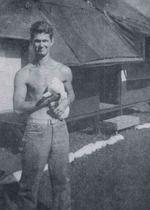 Click to enlarge R. Rose p14DOUGLAS N. MILLICAN - H&S COMPANY: Able to type a little I became H&S Company Clerk. This included Battalion Headquarters, so I wrote up monthy what was happening to Everybody, and handled passes for Liberty. My buddy Bob Rose wanted to marry a church choir girl in San Diego. He needed all the passes he could get to pull it off, visiting with her. I helped him out. It worked. Violet became Violet Rose before we left. As the battalion grew, I knew it was a special outfit.
Click to enlarge R. Rose p14DOUGLAS N. MILLICAN - H&S COMPANY: Able to type a little I became H&S Company Clerk. This included Battalion Headquarters, so I wrote up monthy what was happening to Everybody, and handled passes for Liberty. My buddy Bob Rose wanted to marry a church choir girl in San Diego. He needed all the passes he could get to pull it off, visiting with her. I helped him out. It worked. Violet became Violet Rose before we left. As the battalion grew, I knew it was a special outfit.
BERNARD L. BLUBACH - COMPANY B: We trained at the Boat Basin with old Amphibian tanks with the 37 mm gun.
R. CARL SCHMIDT: Camp Pentleton's land tank Marines taught us engine maintenance, using amtracs that became wrecks.
JAMES D. MACKEY - COMPANY C: After I joined Company C in February, Sergeant Alex "Red" Schmidt trained me to drive Amphibian Tractors in the surf. I made Corporal in April.
WAYNE TERWILLIGER - COMPANY D: Drivers practiced taking their vehicles out into the breakers and bringing them back without stalling or being swamped. Among other problems, the huge waves pushed the tank sideways. This caused it to tip over. Our practice tanks had no guns, We couldn't train with those until we moved overseas to Maui.
JERRY D. BROOKS: I arrived in March and recall training without any amphibian tanks. Instead we spent a lot of time in Higgins Boats going through the motions of making assault landings while trying to get used to the waves so as not to get seasick. A seal took a liking to our Higgins Boat, and took great joy swimming underneath it, going back and forth, poppping to the surface on one side then the other, until after a while he let us reach out and touch him. When a "brave marine" threatened to bust the seals skull with his rifle butt, I threatened to put my rifle butt through the Adams Apple in the Marine's throat if he so much as touched the seal. Never did I understand why anyone would want to harm any such creature for fun. Anyway the seal kept doing his thing happily ever after as best I know. (Note: Jerry Brooks stood 6 feet 4 inches tall and became the battalion's boxing champ on Saipan)
MARSHALL E. HARRIS - COMPANY C: A bow gunner and radioman who sat up front next to the driver, I was trained to drive in and out the surf if the driver was hit. A key rule for hitting the beach was to down shift to first gear and hit the gas, revving up your RPMs, then pop the clutch just as you hit the beach. This put full power on the amtanks front treads, digging their grousers into the sand. Their purchase kept your amtank steady going straight ahead with maximum power despite the surf. Otherwise you might flip or be pushed sideways then flip. Later the technique got us up and over the reef at Saipan. Some of us had never driven a car and/or been out of state before joining the Marines. And here we all were now teen-agers learning to drive huge metal monster amtanks through breaking surf to assault fortified enemy beaches far out in the Pacific Ocean. We all grew up quick.
L. H. VAN ANTWERP - COMPANY C: By April the flower field and bridge outside our camp was well worn by us going on Liberty in Oceanside just outside our Boat Basin camp. I also got liberty to go south to San Diego and north to Los Angeles. Half of San Diego seemed covered with camouflage netting. The night trains to L.A. were blacked out with drawn curtains.
CHARLES H. ORLOSKI - COMPANY B: A mean Pony hung out in that field of flowers. Watch out, the bugger bites, I was warned. But going through a hole in the metal fence there and crossing the field was a half mile quicker into Oceanside than leaving through the Camp's front gate. So one night, coming back to camp in the dark carrying some goodies from town, I took my chances. I couldn't see the pony in the dark, but maybe half way across the field I sure heard the beast, galloping toward me. The race was on. Hoofbeats were pounding hard and gaining fast then suddenly right behind me running for my life when I tossed my goodies over the fence then dove for the hole. Then the HEADLESS HORSEMEN PONY hit it. Fortunately the beast was too big for the hole cause the fence metal stopped him. And I got away.
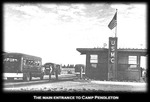 p16DALE G. WOLFRAM - COMPANY D: Married in April I overslept on the night bus back to the Boat Basin so woke up in Long Beach and missed 1st call. That restricted me to camp where I worked with Captain Handyside on packing gear during the day. He'd leave me off from work at my tent at 2000, and I'd sneak out of Camp through the hole on the fence along the railroad trestle to see my bride in San Diego. I didn't get much sleep those last 10 days before we shipped out, and suspect Captain Handyside knew what was going on. We lost a fine officer when he was killed on Saipan.
p16DALE G. WOLFRAM - COMPANY D: Married in April I overslept on the night bus back to the Boat Basin so woke up in Long Beach and missed 1st call. That restricted me to camp where I worked with Captain Handyside on packing gear during the day. He'd leave me off from work at my tent at 2000, and I'd sneak out of Camp through the hole on the fence along the railroad trestle to see my bride in San Diego. I didn't get much sleep those last 10 days before we shipped out, and suspect Captain Handyside knew what was going on. We lost a fine officer when he was killed on Saipan.
HAROLD C. MOODY: After Capt. Handyside learned that I'd been a Crawler Tractor Operator with the State Highway Department, he made me his tank driver.
TOM STALLMAN - COMPANY D: Leaving camp without a pass I was crawling under barbed wire at the trestle when Major Williamson spotted me. His dressing me down was so bad I wished he'd turned me in.
WAYNE TERWILLIGER: Going to Tijuana was a big deal. They warned us Be Careful. I went only once, to a little club with dirt floor and we drank a little and watched exotic dancers, but got back safe and fairly sober. Once, on overnight Liberty in San Diego, after my best buddy Paul Yarcho (from Lincoln, Nebraska) and I drank draft beer with raw eggs, we decided to get tattoos. Yarcho said "You go first." I plopped down 6 bucks and got my arm a big Marine Emblem but Yarcho refused doing his. I was pissed. Later playing Pro Baseball I never regretted my tattoo. People always noticed and asked about it . 4/
JERRY D. BROOKS: Before leaving Boot Camp at San Diego where we'd mingle with civilized folks again, we were shown a movie and given a lecture that scared me so thoroughly that I've never forgotten it's graphic discription and warning about Syphilis and Gonorrhea. When I say graphic I mean GRAPHIC in capital letters. If that lecture would not turn your stomach, nothing would. I think that movie kept a lot of us out of trouble. Later, while strolling around in Los Angeles, I came across a high school classmate from my hometown Witchita, Kansas. She'd left high school a year before me, after her tenth grade. Now here she was a year later working the street in Los Angeles. We were both embarrassed and parted quickly after a quick "Hi where ya been" small talk while I tried to pretend that I hadn't seen her soliciting at all.
MARSHALL E. HARRIS: Those early Navy TCS radios had 6 dails you adjusted to build up enough antenae load to switch to a different frequency for progressively greater ranges. We called it loading the antennae, working the whistle down to "Zero Beat" on each dial, we could bounce the transmission as far north as the big Navy Radio tower up near the Golden Gate Bridge in San Francisco. WAVES worked the radios up there. So we spent a good deal of time working our radios trying to "pick up" female voices up there in San Francisco.
(Note: On 12 March, 1944, the US Joint Chiefs of Staff ordered Admiral Chester Nimitz, Commander, US Pacific Fleet and Pacific Ocean Areas, to occupy the Southern Mariannas by 15 June, 1944, to "secure control of sea communications through the Central Pacific by isolating and neutralizing the Carolines and establishment of sea and air bases for operations against Japanese sea routes and long range against the Japanese home base." Thus sealed the Battalion's schedule for its first battle nearly 3 months before its men learned of its destination on their approach to Saipan. It's fate however was dictated largely by one man, Admiral Ernest King. In February, after Nimitz agreed with MacArthur to by-pass Saipan and abandon the Central Pacific by heading south to quickly merge the Central Pacific's Amphibious forces into MacArthur's Southwest Pacific Campaign, he received this rebuke from King: "The idea of rolling up the Japanese along the New Guinea coast ... and up through the Philippines to Luzon, as our major strategic concept, to the exclusion of clearing our Central Pacific line of communications to the Philippines, is absurd." Nimitz and his staff did an abrupt about face.
This was only one dispute in a long interservice struggle to sustain the Central Pacific Campaign of amphibious landings, including its centerpiece, the thrust of an alligator navy carrying Marine shock troops onto the beaches of the Mariannas, the linchpin to Japan's inner defenses. For details see Footnote 2a/)
BATTALION SAILS to MAUI between 17 APRIL and 2 MAY 1944
5 officers (inc. Warrant Officers) and 50 enlisted left for Mau as advance parties. The first of that group left San Diego on 11 April aboard the LST 131. Another sailed 14 July aboard the USS HAMMONSPORT that arrived at Mau 21 April. A third left 15 April on USS WILLIAM PEFFER. The USS ALCYONE carried the last advance party, sailing 17 April. The Battalion's main force comprising 29 officers (including 3 Marine Warrant Officers and 2 Navy Medical Officers) and 755 Enlisted sailed aboard the newly commissioned troop transport USS Comet. It sailed 26 July. Very few aboard the Comet, passengers or crew, had been to sea or war before.
CHARLES H. ORLOSKI - COMPANY B: Leaving the Boat Basin to go overseas, we hauled our many vehicles by Lowboy Truck down to the San Diego Naval Base. I had an extra man aboard my Lowboy to keep me awake, so made run after run around the clock. With the last one aboard and all squared away below, I went topside to wave goodby. All I could see was distant shoreline. (Without amtanks, we still had some 45 heavy vehicles.)
JERRY D. BROOKS: The stevedores had a work slow down going on at the San Diego docks So a bunch of us (I recall 23 from our Company) worked 6 hour shifts (each of us doing 6 hours on then 6 off) over and over until we'd loaded our ships to go to war, doing the work that the civilian stevedores who still on the docks were getting paid to do, but had decided to loaf instead, just when their nation needed them the most. I'll never forget that.
Also, getting a Battalion of Marines aboard a ship always seemed to overload the circuits of the officers. Say the General would set a boarding time of 8 am, well then each level down - the Colonel, the Lieutenant Colonel, the Major, the Captain and finally the Lieutenent - would each add some slack time into the schedule set by officer just above him to account of some expected or unexpected delay in stuff arriving from our camp or depot. As a result our last boarding instructions got us to dockside with field packs, seabags, and rifles two or three hours early where we'd have to stand around in the dark. But still for me it was a pleasure to board ship and leave the cold waters off the southern California Coast in April of 1944 and sail westward off to war.
 Click to Enlarge p17AROBERT E. WOLLIN: On its maiden voyage the Comet left San Francisco (where it was built) to pick us up in San Diego. We boarded at 1310. Leaving dockside early next morning, some of us were already seasick. Most lined the rail for our last look at San Diego. Shoreline hustle and bustle came alive slowly in the early light. As we passed Point Loma, a voice from the Naval Station there carried out over the waters: Attention all hands, face the water, right hand salute, two, at ease and resume duties. Those salutes honored us going into combat. That's when we all realized that we were headed out into the unknown, and that many of us would not return. Later my wife wrote how she and many other wives and sweethearts stood on the hill there at Point Loma, in tears, watching us leave for war.
Click to Enlarge p17AROBERT E. WOLLIN: On its maiden voyage the Comet left San Francisco (where it was built) to pick us up in San Diego. We boarded at 1310. Leaving dockside early next morning, some of us were already seasick. Most lined the rail for our last look at San Diego. Shoreline hustle and bustle came alive slowly in the early light. As we passed Point Loma, a voice from the Naval Station there carried out over the waters: Attention all hands, face the water, right hand salute, two, at ease and resume duties. Those salutes honored us going into combat. That's when we all realized that we were headed out into the unknown, and that many of us would not return. Later my wife wrote how she and many other wives and sweethearts stood on the hill there at Point Loma, in tears, watching us leave for war.
 Click USS Comet pg18L. H. VAN ANTWERP: Two days out in rough seas we renamed the Comet the USS Vomit or Puke. The Heads, troughs with wooden slots, were filthy. One of our guys down in the hole was in the brig. Guard duty there with no air circulation was awful. RICHARD W. MASON: The Troops Mess became a Chamber of Horrors. DOUGLAS N. MILLICAN: Most all was seasick. Sailors jammed the Heads. Marines hung over the railings, upchucking.
Click USS Comet pg18L. H. VAN ANTWERP: Two days out in rough seas we renamed the Comet the USS Vomit or Puke. The Heads, troughs with wooden slots, were filthy. One of our guys down in the hole was in the brig. Guard duty there with no air circulation was awful. RICHARD W. MASON: The Troops Mess became a Chamber of Horrors. DOUGLAS N. MILLICAN: Most all was seasick. Sailors jammed the Heads. Marines hung over the railings, upchucking.
VERNON C. LOWE: We called her USS Laybelow. We were sick, I mean SICK. SICK for 3 days, running topside to heave over the rail, only to be told to go LAYBELOW FOR DRILL. Amid the horror I'd heave into the latrine, run back up for air, going topside to heave then head back down, me and a lot of others too.
RICHARD G. PEDERSON: Marines lay stacked five high in close quarter bunks below decks, seasick. I couldn't eat, kept going topside to heave. KENNETH E. SMITH: One of our guys was so SICK he wanted to jump overboard, but didn't. He was killed the very first day on Saipan.
GENE LEWIS: I was SEASICK bad. 1st day I was afraid I'd die. The 2nd I was afraid I wouldn't die. ROBERT E. WOLLIN: Lee "Old Man" Morrison visited each junior officer, puffing his big black cigar, sickening everyone more. We wrestled him to his bunk, tied a life belt round his neck, inflated it with CO2 capsules then mashed his cigar into his face and mouth. Each zig and zag of the ship (trying to confuse any Jap subs lurking nearby) brought moans and misery.
At dawn 2nd day men were so SICK and dehydrated they couldn't move. We hauled them topside and laid them out like cordwood. In the fresh air Dr. Galuszka handed out magic pills and potions. The bilge pumps on the new ship didn't work, compounding the mess. Seas of vomit aboard slipped and slided everywhere. With mops we slopped the muck into buckets and hauled the vomit topside, hand-over-hand passing the overflowing sop up ladders in bucket brigades, spilling vomit everywhere, including back down into the hole. Philo Pease felt fine, however. He'd served in the Merchant Marine.
GENE LEWIS: The third day I had mess duty. I was fine after that.
ALBIN A. GALUSZKA - BATTALION MEDICAL OFFICER: Our Battalion had dedication and esprit de corps that was non pareil to any outfit. A case of meningitis in the Comet's crowded hold could have spelled disaster but each man's cooperation avoided one. 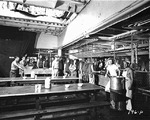 By Don C. Newey. Go to: dnewey.smugmug.com/History ( Col. Fawell credited Dr. Galuszka's quick diagnosis for keeping problem under control. Doc. Galusza was a hell of baseball pitcher, said Biff Crawley later. He helped make us undefeated Champs on Saipan, waiting for Iwo Jima".) On Christmas Eve, 1944 Col. Fawell on Saipan wrote his wife: The General's not happy. My Battalion just beat his whole damn Division, racking up 26 straight wins.)
By Don C. Newey. Go to: dnewey.smugmug.com/History ( Col. Fawell credited Dr. Galuszka's quick diagnosis for keeping problem under control. Doc. Galusza was a hell of baseball pitcher, said Biff Crawley later. He helped make us undefeated Champs on Saipan, waiting for Iwo Jima".) On Christmas Eve, 1944 Col. Fawell on Saipan wrote his wife: The General's not happy. My Battalion just beat his whole damn Division, racking up 26 straight wins.)
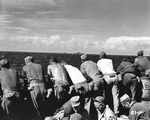 By Don C. NeweyAfter the storm eased and sickness passed, free time was spent loafing: playing cards or checkers, shooting dice, making music with guitars and harmonicas. Others sang, snoozed, watched clouds or hung over the ship's sides and fantail, dangling dungarees into the sea with long ropes, or watched seabirds float over the fantail or flying fish skip ahead of the bow waves as dolphins dived through them. Every so often US Navy loudspeakers blasted out:
By Don C. NeweyAfter the storm eased and sickness passed, free time was spent loafing: playing cards or checkers, shooting dice, making music with guitars and harmonicas. Others sang, snoozed, watched clouds or hung over the ship's sides and fantail, dangling dungarees into the sea with long ropes, or watched seabirds float over the fantail or flying fish skip ahead of the bow waves as dolphins dived through them. Every so often US Navy loudspeakers blasted out:
NOW HERE THIS, CLEAN, SWEEP DOWN, FORE AND AFT.
Then out came the sailors with water hoses and mops as Marines scurried away from the flushing water and sweeping sailors until the lazy topside routine settled in again
JERRY D. BROOKS: The sailors could hardly wait for the speakers to blare out "now hear this, now here this, clean sweep down fore and aft." Then they could work their firehoses to a fairthewell. With many so Marines topside, we got soaked. I never spent a minute below deck unless I had to, it stank of vomit. Fortunately we had the run of the ship. Hanging off the fantail, looking down, was a big deal: watching huge prop blades break through heavy swells of ocean far below. The Red Cross gave us little plastic portable chessboards. Each piece had a peg that fit in the hole in each square on the board. We didn't know chess so used them to play checkers. I learned a bit about shooting craps as I promply lost $20 a dollar at a time. That cured my fastasies of getting rich gambling. My only one lapse after that was losing $10 at Harts. I played my harmonica alot. I played its C note a bit high for singing but we managed anyway. Oftentimes on the fantail I played my harmonia all alone at night. Kaiser who'd never built a ship before, built our Liberty Ship in 30 days so it creaked and groaned as if to break apart especially when the waves started to whip up high. I was glad I hadn't joined the Navy.
 Click to EnlargeJOHN ELOFF: I shipped out on the USS Hammondsport, a big ship with huge open hole in its center. Looking down into it you'd see a line of railroad cars. I also got seasick those first few days at sea.
Click to EnlargeJOHN ELOFF: I shipped out on the USS Hammondsport, a big ship with huge open hole in its center. Looking down into it you'd see a line of railroad cars. I also got seasick those first few days at sea.
CHARLES F. AMBROSE: Our LST disabled we laid over 12 days in San Francisco. This was a lucky thing. We got vital new equipment aboard that arrived way late, long after the rest of our Battalion had departed.
RICHARD MASON - COMPANY C: Our Advance party docked at Kahului before going to Maui. Ashore we stuffed ourselves with pineapples for 3 days before "the runs" ended the feast.
BATTALION TRAINS on MAUI from 2 MAY to 25 MAY 1944:
A handful of unarmed LVT(A)4s arrived the Boat Basin shortly before the Battalion sailed for Maui where it expected to find a full compliment of 70 LVT(A)4s and five months of training in their novel LVA(A)4s before battle. But aboard ship in transit Lt. Col. Fawell learned from his advance party in Hawaii that no LVT(A)4s had arrived for his battalion. He was again caught by surprise on 2 May when greeted on the dock by Col. David Shoup and Lt. Col. Wallace Green, Chief of Staff and G-3 respectively of the 2nd Marine Division. Will you be prepared to sail 12 May for maneuvers and on 19 May for combat action, Col. Shoup said. Despite this remarkable news, Lt. Col. Fawell replied YES SIR then handed Col. Shoup three pages of unmet requirements, including his "lost" 70 Amtanks.
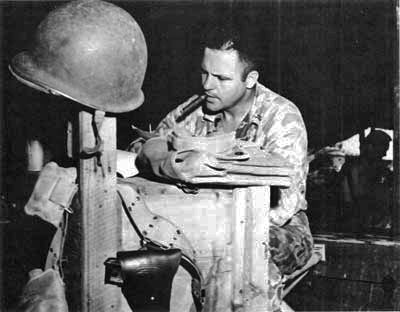 Col. David Shoup circa Tarawa p20
Col. David Shoup circa Tarawa p20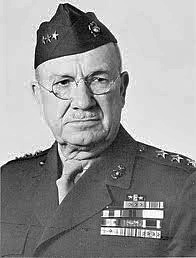 Gen. Holland M. 'Howling Mad' Smith, CO Fleet Marine Force, Pacific, & 5th Amphibious Corp Ashore Col. Fawell wired Gen. Holland Smith asking for air transport to Honolulu to pay his respects to the General at the earliest practicable date. He'd earlier served as the General's Aide-de-Camp. A plane flew him in the next morning. After a 30 minute meeting the General gave Col. Fawell a letter directing all commands to expedite all missing equipment to his Battalion. On 4 May 68 LTV(A)4s arrived unfit for battle, without armor, machine guns, radios, gun sights, periscopes & fire control systems.
Gen. Holland M. 'Howling Mad' Smith, CO Fleet Marine Force, Pacific, & 5th Amphibious Corp Ashore Col. Fawell wired Gen. Holland Smith asking for air transport to Honolulu to pay his respects to the General at the earliest practicable date. He'd earlier served as the General's Aide-de-Camp. A plane flew him in the next morning. After a 30 minute meeting the General gave Col. Fawell a letter directing all commands to expedite all missing equipment to his Battalion. On 4 May 68 LTV(A)4s arrived unfit for battle, without armor, machine guns, radios, gun sights, periscopes & fire control systems.
Armed with the letter Col. Fawell tracked down the Commanding Generals, Regimental COs and staffs of 2nd & 4th Marine Divisions disbursed around the Hawaiian Islands as he worked to unscramble a logistics and training nightmare by finding substitute gear for lost equipment, the expertize to install it and to train his men to use it. Meanwhile he educated Division and Infantry Commanders on the LVT(A)4's capabilities given that their May 3rd battle plan didn't anticipate using LVT(A)4s. See Note 5/. Major John I. Williamson , his Exec. Officer, and all hands up and down the line, had 5 days to prepare before they left for manuevers then battle. See Amphibious Tank Section and Note 6/ for Admiral Ernest J King's rationale behind accelerated schedule.
L. H. VAN ANTWERP: Most of us had never seen or driven our LVT(A)4s before Maui. Fresh off the factory floor, our amtanks lacked howitzer sight, armor plating, machine guns, radios, and most everything else, except notes left in them by factory workers saying stuff like Give the Japs hell! Fortunately, our Battalion CO was well known by top people like General Howling Mad Smith. He gave our Col. a carte blanche letter ordering all concerned to get us all the gear and outside technical help we needed. Suddenly lots of Army and Marine land tank and artillery people came in from the outside to help as we worked round the clock, getting our tanks and ourselves ready for battle.
MARSHALL A HARRIS: Our mechanics from Battalion HQ & Service Company swarmed like ants over those shell amtanks servicing and rigging them alonside outside tank and artillery people. As they finished rigging gear into the tanks, us guys who'd operate them in battle hopped in and started learning how the gear worked and didn't work. As bow gunner I learned things like how to remove and replace quick a hot barrel and reload from the ammo box so as to best feed rounds into a bow 30 cal. machine gun. The 75 mm ammo loader in the back compartment learned how to set cloverleaf ammo patches and fuse times for 75 mm shells. The turret gunners above them learned about the 75 mm turret traverse, manual firing by lanyard, etc. Ultimately we earned the basics of each other's jobs. That way we could operate effectively despite casualties. Amazingly, all this was done without instruction or tech manuals of any kind.
 Maui Click to Enlage p21RICHARD W. MASON: We'd work around the camp then go to Lahaina to fire an alotted 5 rounds of 75mm ammo at targets. Then Major Bevans told us we'd leave for combat in 11 days. Crazy as we were, we thought that was great. The Major didn't think so. He'd expected six more months training plus we hadn't got gear we needed for combat, like 75mm Howitzer sights. It was a miracle that Col. Fawell, working around the clock, got most all we needed before our landing on Saipan. Few knew what Major Bevans did. Our real learning on how to fight in those amtanks would come in battle, fighting Japs.
Maui Click to Enlage p21RICHARD W. MASON: We'd work around the camp then go to Lahaina to fire an alotted 5 rounds of 75mm ammo at targets. Then Major Bevans told us we'd leave for combat in 11 days. Crazy as we were, we thought that was great. The Major didn't think so. He'd expected six more months training plus we hadn't got gear we needed for combat, like 75mm Howitzer sights. It was a miracle that Col. Fawell, working around the clock, got most all we needed before our landing on Saipan. Few knew what Major Bevans did. Our real learning on how to fight in those amtanks would come in battle, fighting Japs.
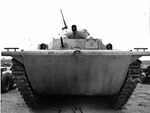 CLICK TO ENLARGE p22From May 5 to 11 the Battalion worked madly rigging shell amtanks. It installed fire control systems, radios, armor plate, gun mounts, shields & sights. Rogue gear had to substitute for what hadn't arrived. Men had to service brand new amtanks without manuals and then learn the amtank's capabilities and limitations in combat. Stuff like how to launch it off LSTs into the sea, drive it in formation through open ocean, over reefs, across lagoons, onto beaches then inland under enemy fire while returning fire. How to make it do what it could do, and avoid doing what it could not do. These skills critical to their mission and survival had to be learned in a war machine never used before. Ones unlike earlier models, and under conditions unlike what they'd confront on Saipan, an amphibious assault unlike any that had done before.
CLICK TO ENLARGE p22From May 5 to 11 the Battalion worked madly rigging shell amtanks. It installed fire control systems, radios, armor plate, gun mounts, shields & sights. Rogue gear had to substitute for what hadn't arrived. Men had to service brand new amtanks without manuals and then learn the amtank's capabilities and limitations in combat. Stuff like how to launch it off LSTs into the sea, drive it in formation through open ocean, over reefs, across lagoons, onto beaches then inland under enemy fire while returning fire. How to make it do what it could do, and avoid doing what it could not do. These skills critical to their mission and survival had to be learned in a war machine never used before. Ones unlike earlier models, and under conditions unlike what they'd confront on Saipan, an amphibious assault unlike any that had done before.
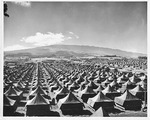 Click Camp Maui 1945, p22AROBERT E. WOLLIN: Our Maalaea Bay tent camp had no electricity or water, just outhouses. Trucked in water fed troughs for washing and open showers. We used daylight to best advantage, prepping our new amphibian tanks and ourselves for combat. We did firing practice and driving in formation, going in and out of the Bay, getting the feel of entering the water, turning about, and clamoring back on land. Lots of shifting and good timing by the driver were needed to hit a wave just right going over a reef so we moved through water in 5th gear then touching land we down shifted and revved the engine, grinding onto the sand. These were critical skills, a stalled amtank is a sitting duck for enemy fire. But our strange new vehicles worked and acted differently than earlier models. And we had to practice without combat loads so didn't know how the added weight would affect their mobility. We assumed we'd float after rolling off an LST into the sea. And had no idea of the terrain we'd face on Saipan or real practice in how to deal with it.
Click Camp Maui 1945, p22AROBERT E. WOLLIN: Our Maalaea Bay tent camp had no electricity or water, just outhouses. Trucked in water fed troughs for washing and open showers. We used daylight to best advantage, prepping our new amphibian tanks and ourselves for combat. We did firing practice and driving in formation, going in and out of the Bay, getting the feel of entering the water, turning about, and clamoring back on land. Lots of shifting and good timing by the driver were needed to hit a wave just right going over a reef so we moved through water in 5th gear then touching land we down shifted and revved the engine, grinding onto the sand. These were critical skills, a stalled amtank is a sitting duck for enemy fire. But our strange new vehicles worked and acted differently than earlier models. And we had to practice without combat loads so didn't know how the added weight would affect their mobility. We assumed we'd float after rolling off an LST into the sea. And had no idea of the terrain we'd face on Saipan or real practice in how to deal with it.
Despite the hectic pace we'd top off each day's training with a swim. Beautiful fish swam in abundance and shone blue and crystal clear over sea urchins bright on coral reefs 50 feet below. Maui flowers bloomed ashore, the scent magnificent, especially at sundown as wind quieted just before the blossoms closed for the night. Our living then felt like Hog Heaven. Compared with what was to come. Our four line Companies, each with 17 amtanks, were up to strength at last, and we were altogether, working hard. Captain Handyside commanded our company, his Exec 1st Lt. Ambrose. 1st Lt. Manner led 1st Platoon with 1st Sgt Livesy his acting Platoon Sgt. I led 2nd Platoon with Plt Sgt. Sherman. Warrent Officer Liberatore led the 3rd Platoon with Sgt. Johnson his Acting Plt. Sgt. 1st Lt. Godbold served as Maintenance Officer extraordinaire assisted by Sgt. James A. Scarpo. But Gunnery Sgt. Roberts in his unique way really ran the company, the one who could always be counted on to get the job done.
JAMES A. (AL) SCARPO: It was a busy time. Most of us had yet to drive our new Amtanks. Only people from outside artillery units knew anything about its 75mm howitzer. Much key gear was still missing, such as gun sights. We had to fix this while our 6 months for training turned into less that 3 weeks to move into a new camp, fix our tanks, learn to use them then pack up, sail to maneuvers, do maneuvers then pack up and leave for battle.
VERNON C. LOWE: On Maui we first saw what our tanks looked like: pretty good. But some worried about their flimsy sheet metal sides, so we welded on armor plate there before we left.
JERRY D. BROOKS: I recall seeing about 70 or 80 of these big beauties on the beach waiting for us. They came equipped with 75mm howitzer in an open turret and a ball socket mount for a 30 caliber machine gun at the right front for use by the radio operator. Our H&S Company welded on each amphibian tank a swivel mount on the left side of the open turret for a 50 caliber machine gun and another mount on the right side for a second 30 caliber machine gun. This rig altogether later gave us a lot of firepower to clear hostile beaches. We spent a lot of time practicing forming a line abreast and moving together as a battalion toward our beach in Maalaes bay on Maui, and fired all our weapons a lot at a small island offshore. We were fairly accurate firing the 75mm from a stationary beach position. I don't recall that we ever tried to fire while moving.
CHARLES F. AMBROSE: We did all we could to get the new amtanks combat ready, adding armor, machine gun mounts, etc. Our Gunners got enough direct fire practice with the 75mm howitzers to become very accurate at a standstill from ranges of up to several hundred yards. We didn't have enough time to train as indirect artillery fire batteries.
MARSHALL E. HARRIS: Our tent was pitched at the far end of our camp at Maui and it faced the ocean. The scene was amazing. At night, after things had settled down, for a kid who'd first seen an ocean only only months before, I'd lay in the dark listening to surf roll onto a Hawaiian island just out my front door. During the day we'd go offshore and head north up the coast past Lahaina. Up there the whales were plentiful, so we had clear instructions: stay on the lookout, never get closer to a whale than 100 yards. Where the surf off the beach was particularly high coming in from the north, we'd practice driving in formation landings onto the beach, and then do manuevers onshore and inland. We'd have lunch inland. Once, I spotted several milk cows and look Jerry Swab over a fence to milk a cow. From Chicago, Jerry didn't know better, so I told him to hold the cow's tail out behind his rear end, otherwise the cow couldn't give us milk. Swab did as instructed as I got two cups of milk, one into each of our helmets. Once back with the guys having lunch, I told them how Swab had done all the hard work, keeping that cow's tail out of way of our getting warm milk. Everyone got a big laugh, except Jerry who insisted he hadn't been fooled, just played along.
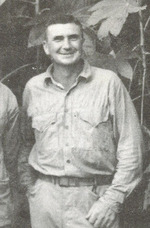 JAMES D. MACKEY p23 RAY SHERMAN: All we could do was direct fire on targets that we could see and aim at. JAMES D. MACKEY: We prepped our brand new amtanks as best we could for combat. This included welding more armor plate particularly in front, and gun mounts for 30 caliber machine gun(s) on the open turret. We practiced driving our tanks in formation on maneuvers from shore to ship and back to shore. We fired our tank weapons.
JAMES D. MACKEY p23 RAY SHERMAN: All we could do was direct fire on targets that we could see and aim at. JAMES D. MACKEY: We prepped our brand new amtanks as best we could for combat. This included welding more armor plate particularly in front, and gun mounts for 30 caliber machine gun(s) on the open turret. We practiced driving our tanks in formation on maneuvers from shore to ship and back to shore. We fired our tank weapons.
GENE LEWIS: I saw our LVT (A) 4 tanks for the first time at Maui. I practiced working the radio, cranking it up, learning to find and stay on frequency, and we talked to one another over the radios between tanks, but not that much. The radio man's other responsibility was keeping the Amtanks' battery charged, as we'd sink without its power. It was a frantic time for everyone. I don't recall maneuvers with 2nd Marine Division, only picking some of them up on the Big Island, Hawaii, before we left for Saipan.
JERRY D. BROOKS: We were confined to our small area. I don't recall being able to leave our campsite except to a little country store mile down the road. Over 2/3's of Maui's people were of Japanese descent or born in Japan so there were too many to 'isolate" as in California, yet no sabotage occurred throughout the war as I understand it.
MARSHALL E. HARRIS: That little country store called Kihei Store was run by a Japanese family, a mom, dad, and 5 year old son. They were nice as could be to us. We'd buy soda pop there, go out on the beach, and sit on a log, drinking pop, watching the waves come in. In the 1970's I returned with my family. The dad had passed away, but his son who ran the store called his mother and we all had a reunion.
From 11-14 May the BATTALION loaded for maneuvers with 2nd Marine Division on 17 May.
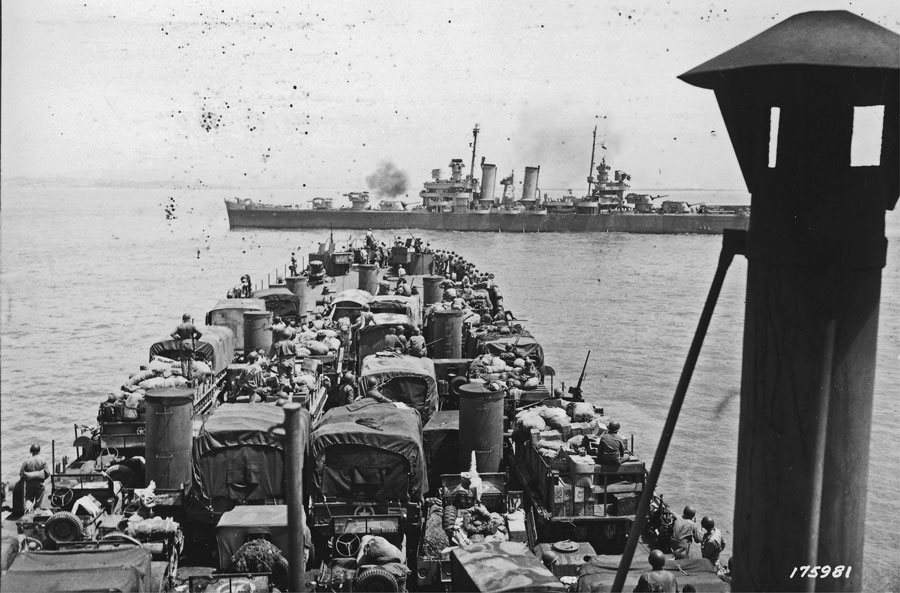 p CHARLES H. ORLOSKI: I kept a small book and transposed my notes into a diary. Here's my 11 MAY ENTRY: AM to board APA 166 and transfer to LST; 13 MAY: Maneuvers about to start. First group with amphibian tanks boarded LSTs. Equipment carried: rifles, carbines, belts, canteens, pack, 2 clips, 125 rounds of ammo, 2 sets dungarees, 4 pr socks, 1 pr underwear, helmet, 2 pr shoes, 1 45 cal automatic with 80 rounds ammo, horseshoe roll w 1 blanket & mosquito net, head net, gas mask, knife, mess gear, poncho, extra shoe laces, camouflage head gear, toilet articles. 17 MAY: Left Maui camp. Maneuvered both days on boats.
p CHARLES H. ORLOSKI: I kept a small book and transposed my notes into a diary. Here's my 11 MAY ENTRY: AM to board APA 166 and transfer to LST; 13 MAY: Maneuvers about to start. First group with amphibian tanks boarded LSTs. Equipment carried: rifles, carbines, belts, canteens, pack, 2 clips, 125 rounds of ammo, 2 sets dungarees, 4 pr socks, 1 pr underwear, helmet, 2 pr shoes, 1 45 cal automatic with 80 rounds ammo, horseshoe roll w 1 blanket & mosquito net, head net, gas mask, knife, mess gear, poncho, extra shoe laces, camouflage head gear, toilet articles. 17 MAY: Left Maui camp. Maneuvered both days on boats.
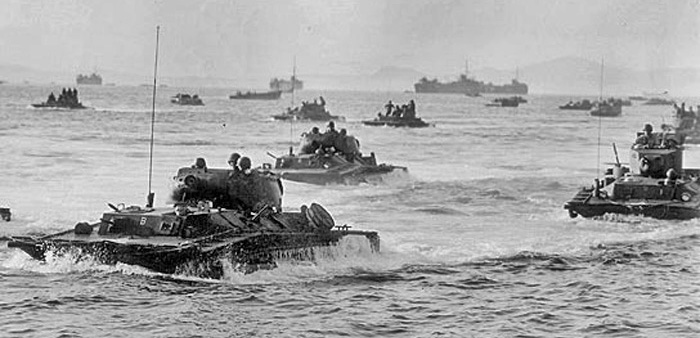 Note LVT(A)4 on left, LVT(A)1 on right, p23
Note LVT(A)4 on left, LVT(A)1 on right, p23
G. BARRINGER: We told Lt. Pease to check for gas with engine running but he ordered the driver to cut it off anyway. Big mistake. It wouldn't restart nor would our Little Joe Battery recharger. We floated off with our CP man standing up sending semaphore signals. An LST threw us a tow line but we sank anyway.
JOHN ELOFF - Restarting those radial engines was tricky; turn them over 3 times then hit the gas. Never turn them off in battle. That we learned quick.
MARSHALL A HARRIS: Never turn off a hot radial aircraft engine in battle. Starting it hot was far more complex and fussy than a cold engine. Hot radials needed just the right fuel mix at ignition and hot metal plays havoc with cylinder vapor locks, piston and push rods, and magnetos. Radials were also far less forgiving to operate, had limited acceleration and de-accelerating ranges. Burning high octane aviation fuel they turned a amtank into a fire bomb quick.
ROBERT E. WOLLIN: We landed in front of the highest Officers in Hawaii. Admiral Nimitz asked permission for his Admirals to come aboard and inspect. They'd never seen an LVT(A)4 before. One sat in the radio operator's seat next to me. Nervous, I gunned the engine into a large wave, soaking us all, including the Admiral who came up sputtering. You're a private again, I figured. But looking at me he laughed. I should be smarter and realize I'm not a kid anymore and stay ashore where I belong, he said. Getting the portly Admiral out of the hatch and over the side popped off several of his shirt buttons. But we got the job done.
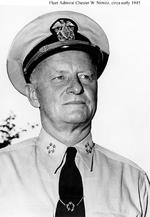 After the 17 May landings in Maalsea Bay the Battalion reloaded its tanks and gear and sailed for battle. Two APAs and 10 LSTs left Maui on 19 May then stopped at Pearl Harbor . 9 of the LSTs left Pearl on 25 May, the last left on the 26th, the two APAs sailed 30 May. Another 9 LSTs sailed directly from Maui for 3,200 miles to Eniwetok. The entire flotilla totalling two APAs and nineteen LSTs assembled at Eniwetok before they all sailed on 10 June for Saipan.
After the 17 May landings in Maalsea Bay the Battalion reloaded its tanks and gear and sailed for battle. Two APAs and 10 LSTs left Maui on 19 May then stopped at Pearl Harbor . 9 of the LSTs left Pearl on 25 May, the last left on the 26th, the two APAs sailed 30 May. Another 9 LSTs sailed directly from Maui for 3,200 miles to Eniwetok. The entire flotilla totalling two APAs and nineteen LSTs assembled at Eniwetok before they all sailed on 10 June for Saipan.
MARSHALL E. HARRIS: Our morale was extremely high. Many years later we'd talk about how our unit's espirit de corps carried us along. It had to do with mutual respect, we all felt it coming up and down the line. Every man got his share and held a respected place whatever his job. So we looked after one another, and held together, for a lifetime really.
REED M. FAWELL - BATTALION: By then we had a Battalion of the finest Marines any unit could have assembled. We were a proud organization and we believed we were ready to fight.
Note: Before he left for battle Col. Fawell reported to General Holland Smith on Battalion's readiness. 68 LTV(A)4s had arrived on 4 May as shells missing all periscopes, telescopes, 30 and 50 Cal machine guns, direct and indirect fire control equipment, blast shields for vision domes, bow guns, dual radio receivers and transmitters, communication accessories, and technical manuals. No missing equipment had been delivered since, save for 40 telescopes and 60 panoramic sights that arrived 12 May. This was after all advanced training (whatever gunnery, tactics, and formation driving its Battalion CO could get across from 5 May to May 10) had ended as Battalion had packed up for maneuvers and sailed for combat. Col. Fawell also reported to the General design flaws built into the LTV(A)4s that would limit combat effectiveness. The amtank's 75 mm howitzer lacked the gyro-stabilizer built into lank tanks allowing the latter to fire with accuracy when on the move. The amtank when sea-borne or moving on land would fire wild. Grossly under-powered, it also had limited mobility. It weighed 20 tons+ when combat loaded but its power plant and power train had been built to move 11 tons. Sea-borne assault troop carrying LVTs would overrun the amtank, masking the amtanks fire. With its engine off the amtank's bilge pumps failed, sinking the amtank in minutes. Faulty waterproofing often shorted out communications and intercom and rendered periscopes useless in a mobile direct fire weapon whose effectiveness was heavily dependent on its mobility, situational awareness and communications. Col. Fawell proposed numerous fixes. He remained confident that his men led by ex-tank and artillery officers and NCOs trained for aggressiveness could produce in any situation as tanks. See Amphibious Tank section 28 May ltr. from Fleet Marine Force Pacific to HQ Marine Corps, Washington DC.
Starting on 19 June a naval armada comprising 800 ships gathered at the Hawaiian islands would begin to sail for Saipan. Fast carrier and battleship strike forces would first engage Saipan on 11 June. Next heavy gunfire ships (old battleships, cruisers, destroyers) would concentrate fire on fixed landing beach defenses, degrading them, before the gunfire ships moved closer inshore and covered the amphibious landings of General Holland Smith's V Amphibious Corps shock troops carried ashore on 15 June in hundreds of smaller landing craft. A vast and varied seaborne logistics train accompanied this warfleet and 71,000 amphibious troops - colliers, oilers, transports, and myriad of speciality ships to support the landing and conquest of Saipan. General Holland Smith's V Amphibious Corps and its logistics train would sail 2250 miles then stage through Eniwetok Atol in the Marshall islands before sailing 950 miles to Saipan.
BATTALION Sails 3,200 MILES to SAIPAN via ENIWETOK from 19 MAY to 14 JUNE 1944:
GLENVILLE BARRINGER : After our tank sank in Maalsea Bay, we got a new one without ammo racks. Sailing to Saipan we built new racks from wood, a hot job in a tank down in LST's hold. MARSHALL E. HARRIS: My quarters aboard LST 450 was a newly liberated Navy mattress spread across my amtank's front deck parked below against the LST's bow doors shut like a clam to keep the seawater out. We'd fall asleep listening to the rhythmic beat of giant doors surging through sea swells. For 3 weeks our 5 amtank platoon shared the LST with the Infantry Company & LVTS we'd lead into battle. I went from June 2 to June 4 in one second crossing the International Date Line at mid-night.
JERRY D. BROOKS: Our convoy comprised lines of ships from horizon to horizon going from Maui to Saipan in early June of 1944. Our LST, a sea-going barge whose topside was jammed with trucks, jeeps, and various odds and ends that came in handy in questionable real estate transactions, chugged along as fast as the slowest ships could go. The smallest torpedo or mine could sink us in minutes. So little destroyers raced up and down the lines of the convoy blinking their signal lights wildly, impressing us with their importance in keeping Japanese subs at bay. Many of us stayed topside at night and slept beneath tarps slung between vehicles anchored to the deck.
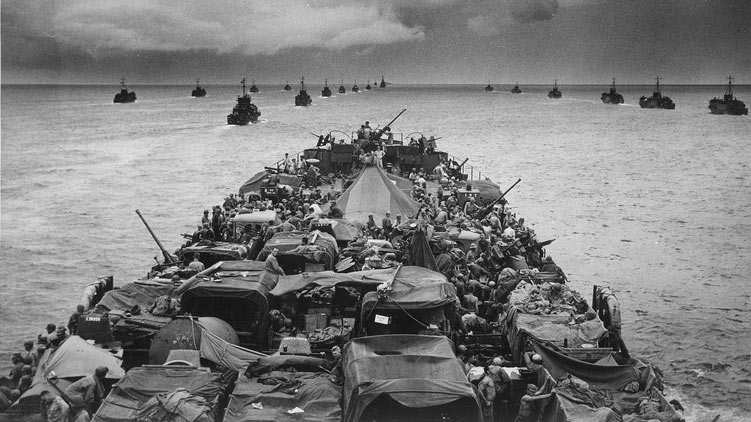 p25
p25
ROBERT E. WOLLIN - COMPANY D: My platoon left Maui on LSD 485. Everything aboard was jammed to the scuppers. Each LSTs carried an Infantry Company as well as its supporting weapons and units; its machine guns and mortars, a platoon of 8 tracked amphibious vehicles (LVTs) to carry the Infantry Company ashore, and our platoon of amtanks to lead its assault ashore. Our amtanks, being the first assault wave, were the last aboard the LST, and parked up tight against its huge bow doors. In transit to battle, we slept on the LST's main deck, under life boats, behind engines or wheelhouses, or under or in medium sized ships called LSPs (landing ship personnel), gunboats (LCTs) or LSMs that transported land tanks ashore. These smaller ships sat on blocks. Huge chains lashed them to the LST's deck. In battle, after our Amtanks and LVTs had left for shore, the ship's captain flooded one side of the LST and its smaller ships slid off the deck into the sea. So each Assault Company was wrapped up in one neat package that was loaded aboard the LSD that then transited it to battle, prepacked and ready to launch its package of war machines and men into their seaborne assault across the sea, over reefs, through lagoons, then up onto the beach before its thrust inland, busting through enemy defenses. That was our mission. We shipped out and went ashore with a very gun ho bunch - G Company, 2nd Battalion, 8th Marines, 2nd Marine Division.
WINTON W. CARTER - COMPANY B: On 21 May our LST docked at Pearl Harbor and unloaded our amtanks so other gear could be loaded in behind them. We'd parked some a 100 yards away when our Gunner began cleaning his howitzer, sliding a shell in an out of its chamber. Watching him, I said: If you let that thing go off, you've had it. Then - BOOM! My first thought was he did it, fired it. Then a guy shouted: Look at that! Smoke and flames shot out of our LST. LSTs moored alongside lit afire then exploded. Sailors leapt overboard. Some got ground up in churning propellers. Shrapnel whizzed by us, ammo, fuel, acetylene tanks, you name it, exploded exploded, cooking off.
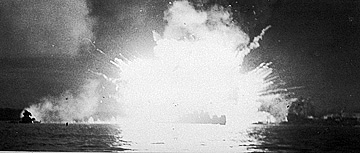
GENE LEWIS - COMPANY B: I don’t know why, but they told me and Ernest Lund to stay aboard LST 353 after our amtanks had driven off, the crew had left and civilians came aboard to reload the hold. We read in an LVCP's shade topside. Lund, a nice quite guy, saying he didn't feel well, went below. I'd read an hour then an explosion knocked me out. I woke amid fire. Chin gashed, bleeding, seeing nobody, I clammered down to where our tanks had been, but didn’t see Lund or anyone. Explosions shuddered the ship. I ran topside, my back and knee hurt, guys thrashed below in oily water. I tossed them lifejackets. “Jump, jump – it’s gonna blow!” People on a LST yelled. I jumped, swam to its ramp, they pulled me out, I must have looked bad. They tried to shoot me with morphine. I'm fine, saying it I wilted. Full of morphine I woke in a hospital. I just wanted to get back to my unit but it took 3 days to talk my way out. Leaving I could hardly walk.
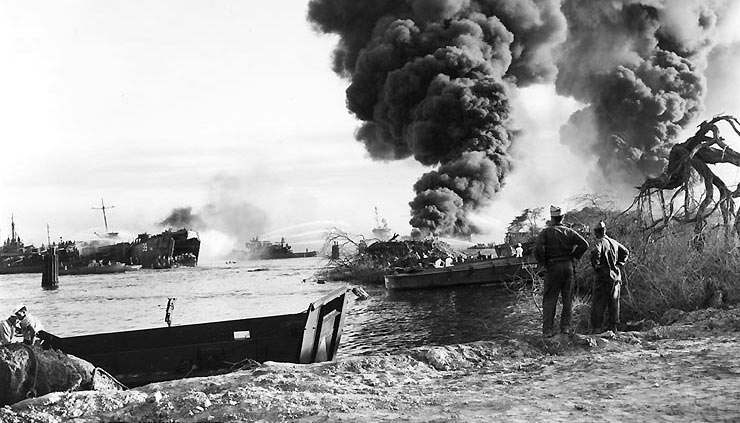 p27 LSTs STILL BURNING AT PEARL HARBOR A DAY LATER
p27 LSTs STILL BURNING AT PEARL HARBOR A DAY LATER
BILL LUC - COMPANY B: I remember helping fish several bodies out of the water.
Mortar rounds exploding aboard LST 353 drove shrapnel into 8 LSTs berthed nearby, causing more explosions that sank 6 LSTs and killed 163 men. This included PFC ERNEST L. LUND. 396 men were wounded. Three men from Company B - PFCS. ARTHUR J. AUXTER JR., MERLE B. CARPENDER and LOUIS SANGOUARD - were awarded NAVY & MARINE CORPS METALS. All had returned into flames and explosions repeatedly to rescue injured men. Gene Lewis was later awarded a Bronze Star on Iwo Jima.
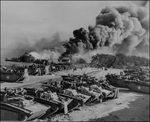 Click to EnlargeJAMES D. MACKEY - COMPANY C: Much equipment was lost, including amtanks. An army base on the big island of Hawaii freely donated lots of gear: socks, shoes, underwear, machine gun barrels, 50 ca. machine guns, cleaning gear, waterproof bags, dehydrated food, stuff better than ours and too numerous to mention. BILL LUC - Army amtanks replaced our lost ones. Their radios were different. Sailing to Saipan I spent much time trying to get them to work on the same frequency as our Marine amtank radios.
Click to EnlargeJAMES D. MACKEY - COMPANY C: Much equipment was lost, including amtanks. An army base on the big island of Hawaii freely donated lots of gear: socks, shoes, underwear, machine gun barrels, 50 ca. machine guns, cleaning gear, waterproof bags, dehydrated food, stuff better than ours and too numerous to mention. BILL LUC - Army amtanks replaced our lost ones. Their radios were different. Sailing to Saipan I spent much time trying to get them to work on the same frequency as our Marine amtank radios.
M. NEIL MUMFORD - COMPANY A: Amid the explosions a 1st Sergeant told a three of us: You, You, and You, come with me. A 6x6 truck took us to Camp Tarawa atop a mountain. We picked up ammo and other supplies. Coming back down our driver, seeing our ships leaving dockside, drove fast, nearly pitching us off the mountain. Dockside, I hopped an amphibian that took me alongside our ship. Climbing its cargo net, I heard My Platoon leader Lt. James Carter asking: "Where's Mumford?" "Here I am, Sir!" Lt. Carter peering over the LST's side discovered me climbing up from below. Who said Marines can't walk on water?
Note: The Battalion's losses at Pearl Harbor were replenished before the last two of the Battalion's 18 ships departed 30 May. But major logistics obtacles remained. Despite its being crated up stateside on 1 April, the battalion's general cargo did not ship overseas until 24 April and didn't arrive in Pearl Harbor until 20 May after 6 battalion ships were already at sea headed for Eniwetok. Col. Fawell's continuing reports to General Holland Smith finally shook loose 90% of the gear he'd reported missing on 3 May but 16 of the battalion's 18 ships had left Pearl before it arrived on 27 May. Thus his two remaining APAs loaded this gear aboard then left Pearl on 30 May. The Battalion's general cargo and most of its still missing amtank parts had to be distributed among 16 ships during their two day layover in Eniwetok's lagoon's before all 18 battalion ships sailed on 10 June for Saipan.
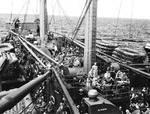 By Don C. Newey. Go to: dnewey.smugmug.com/History G. MILTON SHIRLEY - COMPANY D: Our APA sailing to Eniwetok had a lot of card playing and music going on. At Eniwetok we transferred into LSTs that carried us to Saipan. (Click to Enlarge Don C. Newey's Photos)
By Don C. Newey. Go to: dnewey.smugmug.com/History G. MILTON SHIRLEY - COMPANY D: Our APA sailing to Eniwetok had a lot of card playing and music going on. At Eniwetok we transferred into LSTs that carried us to Saipan. (Click to Enlarge Don C. Newey's Photos)
WINTON W. CARTER - COMPANY B: We wore life jackets 24 hours a day. One bomb or torpedo could sink our tin can LST. Our's darkened at sunset, no smoking allowed. We never saw or heard an enemy plane or torpedo. Guess the strong boys cruising our convoy's outer perimeter took care of them.
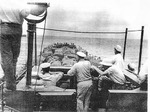 Click to Enlarge p28ROBERT E. WOLLIN - One morning our LST Captain ordered us to swab the decks. We had to tie a rope to a sailor's mop and drop it over the side and haul it back up wet then swing it onto the deck and swab like sailors then repeat. Problem was Marines aren't Sailors. Marines kept 'losing' their sailor mops, dropping them into the ocean. Finally the Captain relented. So sailors became swabbies again and Marines went back to being Marines.
Click to Enlarge p28ROBERT E. WOLLIN - One morning our LST Captain ordered us to swab the decks. We had to tie a rope to a sailor's mop and drop it over the side and haul it back up wet then swing it onto the deck and swab like sailors then repeat. Problem was Marines aren't Sailors. Marines kept 'losing' their sailor mops, dropping them into the ocean. Finally the Captain relented. So sailors became swabbies again and Marines went back to being Marines.
JERRY D. BROOKS: Once aboard ship and underway things settled down at sea and the times got lazy. Leaning over the ship's rail, we'd peer down at the seawater swirling past. At the bow, we'd lean over the rail and watch the dolphin whose sleek and darkly glimmering shapes effortlessly stayed abreast of us, surfing the waves that our bow carved endlessly out of the ocean. It was a beautiful sight - the dophin, the sea gulls, the albatross, all traveling along with us as if our allies, or as if fascinated with us as we were with them. Some days a plane pulling a target sleeve behind it would fly past our line of ships. As the sleeve passed each ship, its AA guns would blast away at the target sailing 100 yards behind the plane, and 50 feet above the water. The target was hardly ever hit, and once its towing line was shot away near the plane's tail, dropping the target into the sea. A radioman, I could read Morse Code, but listening to the Navy signal people sending and reading messages down belowy, it was obvious that they were much faster than we newly trained Marine radio guys. Near Eniwetok, hearing the news of the Army's landing on Normany, we hollered and hooted then we kept our fingers crossed all day for all the guys doing the landing. The radio said it was a success. But didn't tell us about the slaughter on Omaha Beach.
ENIWETOK
 CLICK TO ENLARGEDuring the night of 8 June the Battalion's convoy arrived at Eniwetok, a way station atoll that had been seized only months before. At dawn the Marines found themselves amid hundreds of ships in the atoll's blue lagoon rimmed by a volcano's sunken crater whose outer edges lay like a string of pearls around their floating city, an armada amid its logistics train, arming for battle. Oilers fueled warships. Concrete barges distributed fresh water among 71,000 assault troops afloat. Gunfire ships hoisted ordinance aboard. Smaller boats scurried between the warships finishing up the myriad of tasks necessary to ready the vast war machine afloat for its assault of Saipan: delivering messages, gear, supplies, final instructions, mail, and men for final conferences and to consolidate units aboard amphibious ships.
CLICK TO ENLARGEDuring the night of 8 June the Battalion's convoy arrived at Eniwetok, a way station atoll that had been seized only months before. At dawn the Marines found themselves amid hundreds of ships in the atoll's blue lagoon rimmed by a volcano's sunken crater whose outer edges lay like a string of pearls around their floating city, an armada amid its logistics train, arming for battle. Oilers fueled warships. Concrete barges distributed fresh water among 71,000 assault troops afloat. Gunfire ships hoisted ordinance aboard. Smaller boats scurried between the warships finishing up the myriad of tasks necessary to ready the vast war machine afloat for its assault of Saipan: delivering messages, gear, supplies, final instructions, mail, and men for final conferences and to consolidate units aboard amphibious ships.
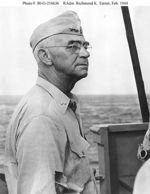 CLICK ADM. TURNER p29ROBERT SHERROD - WAR CORRESPONDENT: "8 June: transports arrived today at Eniwetok with Saipan assault troops. The shooting looks closer. It always looks closer when Kelly Turner and Holland Smith show up ... Turner commands the landings ... Under Turner the Number One man is Lieutenant General of Marines Holland Smith... Throughout the Pacific Campaign he estimated enemy capabilities better than any individual I talked to...He said slowly: A week from today there will be a lot of dead Marines ... Old Man Smith worshipped his beloved Marines."7/ (See photo of pair off Saipan below.)
CLICK ADM. TURNER p29ROBERT SHERROD - WAR CORRESPONDENT: "8 June: transports arrived today at Eniwetok with Saipan assault troops. The shooting looks closer. It always looks closer when Kelly Turner and Holland Smith show up ... Turner commands the landings ... Under Turner the Number One man is Lieutenant General of Marines Holland Smith... Throughout the Pacific Campaign he estimated enemy capabilities better than any individual I talked to...He said slowly: A week from today there will be a lot of dead Marines ... Old Man Smith worshipped his beloved Marines."7/ (See photo of pair off Saipan below.)
(Admiral Richmond Kelly 'Terrible' Turner commanded amphibious operations. General Holland 'Howling Mad' Smith commanded troops ashore. Although often at odds and notorious brawlers, their mutual respect for one another bound them together.)
MARSHALL E. HARRIS: After going topside at dawn, I could see as far as the eye could see. I stood there astounded, glazing out at a world filled with US Navy ships. Every kind of ship imaginable spread out in all directions across the ocean. The whole US Navy had to be there with us. Task Force 58 was that big.
RICHARD W. MASON - COMPANY C: We listened to Tokyo Rose on the radio naming the units in the lagoon. Her words gave us a funny feeling: she knew exactly where we were. So we headed out 10 May, sailing the last 950 miles across the sea for Saipan, with the idea that the Japs knew we were coming.
In Transit to SAIPAN
 Click to Enlarge p
Click to Enlarge p Click to Engarge pOLIE F. MORGAN - COMPANY B: One day an enemy torpedo like an underwater shadow crossed our bow and Destroyers jumped into action, darting about, laying a smoke screen across the entire convoy. Other destroyers dropped depth charges, explosions blooming up the water behind them. (US commanders, thinking the armada's cover blown, moved up the US Navy's Saipan air attacks to 11 May)
Click to Engarge pOLIE F. MORGAN - COMPANY B: One day an enemy torpedo like an underwater shadow crossed our bow and Destroyers jumped into action, darting about, laying a smoke screen across the entire convoy. Other destroyers dropped depth charges, explosions blooming up the water behind them. (US commanders, thinking the armada's cover blown, moved up the US Navy's Saipan air attacks to 11 May)
GENE LEWIS - COMPANY B: In the ship's hole we got our new tanks fit for battle as best we could. Some ran the engines until they couldn’t take the fumes anymore. I practiced working my radio. Otherwise, I went topside and slept with a 2nd Division infantry unit at night.
HAROLD C. MOODY - COMPANY D: Aboard our LST we did things like replace the heavier 50 ca. machine guns on the amtanks turret ring with the 30 ca. machine guns. Some amtank commanders wanted a lighter weapon, easier to handle when swinging it around on a tank tilted on uneven ground.
ROBERT E. WOLLIN: We studied sand mock-ups of Saipan for hours, going over plans and imagining what to expect when crossing the reef and lagoon, landing on Green Beach 2 and then pushing inland. Each company studied their own designated landing Beach.
G. MILTON SHIRLEY - COMPANY D: I wandered into a briefing given by a Marine officer. He was leaning over a model of the island, telling his landing troops: Now this operation will be spearheaded by the 2nd Armored Amphibian Battalion. God help them poor bastards.
ROBERT E. WOLLIN: In the ship's hole, the Chaplains busily baptised men at where the LST's bow doors were slightly ajar, using seeps of seawater for Holy Water. Every Chaplain baptized every man into the faith of their choice.
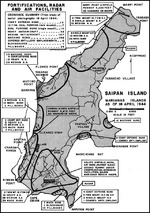 CLICK TO ENLARGEJAMES A. (AL) SCARPO - COMPANY D: A major who been at Tarawa told us: Tomorrow morning we are going to hit the beach. There will be LVTs to take us in, but none to take us out. Only two kinds of men will stay there: the dead and those who are going to die. That got our attention. Lewis Zimmerman heard it too.
CLICK TO ENLARGEJAMES A. (AL) SCARPO - COMPANY D: A major who been at Tarawa told us: Tomorrow morning we are going to hit the beach. There will be LVTs to take us in, but none to take us out. Only two kinds of men will stay there: the dead and those who are going to die. That got our attention. Lewis Zimmerman heard it too.
HARLAND T. ROSVOLD - An LCT lashed to an LST's deck broke loose in a storm and slid into the sea. We watched it plunge overboard but didn't see anyone try to rescue those aboard it. Our convoy just keep sailing on like nothing had happened. By the time we lay off Saipan, however, I felt great confidence. We'd been told repeatedly that our training, equipment, leadership, navy fire support, and the Marine Corps winning tradition were all that we needed for a reasonably rapid and certain victory. Hundreds of warships surrounding us amplified my confidence. Battleships belched 16 inch shells into the inland. Cruisers named after prominent US cities shelled it. Carriers sent off and landed hundreds of planes that swarmed the island. Destroyers scooted just off the reef firing at targets.
ROBERT E. WOLLIN - COMPANY D: We also felt ready. My Platoon's 5 amtamks carried 35 men in the 1st wave: Each amtank had a 5 man crew. Other battle critical personnel filled our ranks - a 2nd Lt, Platoon Sergeant, 4 radio operators, a radio repairman, amphib. mechanic, engine Mechanic, general mechanic. See Roll Call Section for 2nd Platoon, Company D Roster
D Company's other two Platoons each had 6 amtanks in the 1st wave, carrying crews plus its Company CO, Exec. Officer, 2 Navy Corpsman, and other battle critical personal. In addition to the Battalion's four line companies - A, B, C, and D - the Battalion's HQ & Service Company sent two amtanks ashore in the 1st wave. Contrary to protocol, the Battalion's Commanding Officer Reed M. Fawell Jr. landing in his own amtank went ashore with his men in the 1st wave. Thus the 2nd Armored Amphibian Battalion landed 70 amtanks in the 1st assault wave ashore on Saipan.
REED M. FAWELL wrote his BATTALION before it sailed for battle:
I do feel confident after seeing you work under unfortunate conditions that every one of you has the ability to fight, to win, and uphold old established traditions of the United States Marine Corps. Bear in mind - keep cool - use your head, that is what it is there for - the shot that does not hit the target is a shot wasted - KEEP ADVANCING, THERE ARE A HELL OF A LOT OF GOOD MARINES IN BACK OF YOU. Good Luck, Good Shooting. R. M. Fawell, Commanding
But Japan's rapid buildup rendered above 10 April Fortifications Map obsolete, grossly understating Saipan's D-day defenses. Expected to last three days, the battle raged nearly four weeks, required all 5th Amphibious Corps reserves, and delayed Guam's D-Day more than a month and Tinian several weeks.
On night of 14 May the Battalion arrived to ASSAULT SAIPAN.
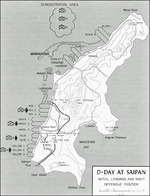 Click to enlargeGiven its size and 1500 miles distance from Japan's home inlands, Saipan was the linchpin stronghold and staging area for Japan's Central Pacific Empire. The island's defenses were complex and highly effective. A vigorous waters' edge defense combined with a robust in-depth interior defense overlooking the beaches. Defiladed artillery and mortars dug into reverse slopes starting 1500 yards inland rose in ridges and ravines branching down from 1554 foot Mt. Tapotchau. When the US landing craft reached Saipan's fringing reef, heavy weapons far inland poured fire down on the invaders, blowing apart the reef, as dual purpose guns hit the invaders from the flanks and machine guns hit them head on from scrub just behind the beaches. Exploding seascape and beaches inflicted heavy casualties, ripping apart units, scattering their broken parts across a broad front while jamming alien remnants together on narrow beaches amid chaos.
Click to enlargeGiven its size and 1500 miles distance from Japan's home inlands, Saipan was the linchpin stronghold and staging area for Japan's Central Pacific Empire. The island's defenses were complex and highly effective. A vigorous waters' edge defense combined with a robust in-depth interior defense overlooking the beaches. Defiladed artillery and mortars dug into reverse slopes starting 1500 yards inland rose in ridges and ravines branching down from 1554 foot Mt. Tapotchau. When the US landing craft reached Saipan's fringing reef, heavy weapons far inland poured fire down on the invaders, blowing apart the reef, as dual purpose guns hit the invaders from the flanks and machine guns hit them head on from scrub just behind the beaches. Exploding seascape and beaches inflicted heavy casualties, ripping apart units, scattering their broken parts across a broad front while jamming alien remnants together on narrow beaches amid chaos.
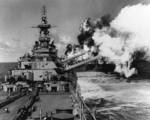 ALL OF NEXT 15 PHOTOS CLICK TO ENLARGE p30
ALL OF NEXT 15 PHOTOS CLICK TO ENLARGE p30
The Northern Task Force, its 2nd and 4th Marine Divisions and supporting arms, was tasked to assault Saipan. Fast carrier air bombardment began 11 June. On 13 June 7 big carriers, 8 light carriers, 7 fast battleships, 3 heavy cruisers and 52 destroyers plastered the Mariana Islands, including Saipan. On 14 June the landing force naval bombardment groups arrived off Saipan. These 7 old battleships, 11 cruisers and 26 destroyers fired at close range. Underwater Demolition Teams reconnoitered the reef and lagoon off the landing beaches, a 10,000 yard front between Garapan to the north and Agingan Point on the south. For details see 8/
Close-in fire ships and LSTs moved into position at 0542 on 15 June to disembark assault craft into the sea 5250 yards offshore. LVTs carried five waves of assault troops: 4 Infantry Battalions of 2nd Marine Division in two Regimental Combat Teams landed abreast onto Red & Green Beaches north of Afetna Point. Two Regimental Combat Teams of 4th Marine Division landed abreast onto Yellow & Blue Beaches south of Afetna Point. 8,000 Marines would land on eleven Saipan's beaches during the first 20 minutes of battle.
Asked to name his favorite sound years later, Col. Fawell replied after a long pause: "US Naval Gunfire."
Complications: Naval gunfire, the most powerful weapon in WW II amphibious landings, had limitations. Its shells travelled on a mostly flat trajectory. Thus even minor elevation error could morph these big shells into friendly fire. This was particularly true when the naval shelling originated from far behind the waves of landing craft. Here there was extreme risk from these naval shells once the landing craft came within 1200 yards of the beach. Secondary battery fire threatened such craft within 300 yards of shore. This forced the gunfire ships to lift their fire off the beaches just when the Marines were most vulnerable to defenders who then could raise their heads and take full advantage of their free fire zone across open water at the US Marines who, packed tightly into landing craft, slowly approached their entrenced enemy.
Saipan's geography ascerbated these terrible threats. The island's reefs and its landing beaches were long and irregular. Peninsulas jutted out from Saipan, into its broad lagoon between its fringing reef and landing beaches. The island's vast corrugated interior rose behind its coastal plain, looking down on its beaches, its lagoon, and the reef that enclosed it. Thus Saipan's defenders enjoyed a variety of well protected, hidden, and highly lethal fixed positions from which to fire at targets moving slowly across the reef, the lagoon's broad open water, and the beach. As a result, flanking fire from dual purpose coastal guns on the Peninsulas seared into the seaborne waves of incoming Marines. And heavy mortar and artillery fire rained down on the slow moving landing craft from far inland. Meanwhile enemy machine gun fire hit the Marines from directly behind the beaches, raking the Marine invaders head on.
These multible threats demanded innovative solutions that kept the defenders heads down long enough for the Marines to survive their final beach approach and then land in sufficient numbers to overpower beach defenses and thereafter seize a defensible beachhead and push inland far enough to destroy artillery and mortars hidden in high rough country deep in the island's interior. US Commanders went to work on solutions. But they lacked the tools during the planning stage to fully appreciate the range and extent of the multible threats posed to the landing force. For example, the heavy artillery and mortars hidden on the reverse slopes of high rough country far inland behind the landing beaches, and formidable hidden natural defenses (strong offshore currents and steep onshore berms) were "overlooked" by intelligence gatherers before D-day. Hence the Marine assault encountered a rattlesnakes' nest of lethal surprises.
Still, the Saipan landing plan was highly creative and built upon the solid foundation of much hard earned experience. So it diluted many a risk. And, ultimately, it gave the Marine frontal assault just enough cover to prevail despite a fierce and sustainded defense that easily would have repelled a less disciplined, cohesive, determined force instead of the one it was forced to fight: an amphibious force of shock troops inblued with the stuff of all Marines, the basic training and mindset to defeat most any major adversity, however filled it was with awful surprises.
Hence, for example, one known solution to the naval gunfire elevation problem put American gunships on far flanks of the Northern Sector Landing Zone. This had proved not only workable but easily accomplished at atolls in the Marshalls. There distances had been short and angles of fire sharp, so shells fired crosswise landed in front of the troops without elevation risk. But the length and configuration of Saipan's reef, beaches, and intervening peninsulas, reduced the angles of US naval flanking fire into the beach to the point where elevation error again rose its ugly head. Meanwhile the same geography not only enhanced the enemy's ability to mass flanking fire into the slow moving waves of the Marine's seaborne approach and landing, it threatened US gunfire ships positioned on the landings' far flanks. These ugly realities, combined with the artillery massed inland, amplified the existential problem inherent in amphibious landings: How do amphibious forces build the offshore cover, power and momentum that Marines require to survive their trip to the beach then bust down its door and force a secure beachhead?
To dilute these risks, the US Commanders "broke up the landing scheme into constituent parts, to amplify US power at junctures deemed critical."
US Marine and Navy planners broke their landing scheme into four major parts, and positioned new offensive assets and tactics within those sectors, to neutralize and then destroy these enemy threats. First, they placed US heavy gunfire ships closer inshore, putting them in slots at the flanks and in the center of the amphibious attack. This sharpened the Gunfire ships angles of fire. This in turn increased that fires' penetration, volume and tempo, and its lateral targeting area, hitting onshore and inland. Simultaneously, this segmentation of offensive fire power better neutralized the enemy's flanking fire that threatened not only the landing craft but the gunships covering those landing craft. To open these gunfire slots in the line of assault that were deemed necceary to accomplish these objectives, the assault waves would land only on four of the interior beaches rather that the original six landing beaches in the Nothern Sector. This allowed the Navy to insert gunfire ships into a slot at each end of the line of attack to insure heavy and effective naval gunfire into Red 1 & Green 3 (including the peninsulas) and their flanks. A naval gunfire slot was also inserted into the attack's center between Red 3 & Green 1. This center slot put sharp angled heavy shell fire into a wider and deeper target area within the center of the enemy's interior defenses.
The Marine and Naval planners also added a novel mix of heavy direct fire weapons into the line and flanks of the US Marine amphibious assault. The mission of these altogether new elements was critical: to fill the gunfire support gaps that would otherwise be left wide open when direct naval gunfire was forced to lift off the beach as the amtracs began to cross the reef. These new and novel war machines included two primary types, each with a different mission. 12 LCI gunboats would lead the amtracs to the reef and then would move to the flanks where they would stand offshore, firing from flanks, as the 70 amtanks coming right behind the LCIs would surmount the reef, swim the lagoon, lead the troop amtracs ashore, and then keep going inland, blasting apart and clearing the way for the Marine infantry coming behind them. Thus, under this new scheme of attack, the LCIs would open fire onto the beaches as direct naval gunfire lifted, and then the amtanks coming behind them would open fire once at the reef, after the LCI had cleared their fire lanes by moving to the flanks of the amtank attack. The tactic was ingenious. The LCI Gunboats and Amtanks by nature worked in tandem, and in complimentary fashion. The LCI gunboats, standing offshore with high trajectory high explosive 4.2 mortars, would loop mortar rounds over the amtanks and landing craft to saturate the beaches before the 70 amtanks's direct fire blew open the door by landing ahead of the infantry. Meanwhile, a third element of the US Marine and Navy plan would dilute yet another enemy threat, namely, that of the crack Japanese Regiment stationed on the far left northern flank north at Garapan. To deal with that veteran enemy outfit, a feign landing north of Tagapag Harbor would hold that enemy regiment in place north of Red 1 during the landing. It would also divert the coastal guns there away from US gunships that had slipped into the gap fronting Red 1 to suppress fire hitting the 6th Marines landing on Red 2 & 3, and enemy fire coming from Garapan as well. Meanwhile gunfire ships slotted into the gap down south facing Green 3 would suppress flanking fire from Afetna Point & Green 3 into the 8th Marines landing on Green 1 & 2.
See below maps of landing, gunfire & demonstration scheme for northern sector incl. Mutcho, Afetna & Agingan Points.
However hopeful the plan, its known trade-offs were painful. The landing scheme across four interior beaches, instead of six across the entire front, broke the Marines landing into more waves. This slowed and weakened their assault. Now 4000 Marines would land in 20 minutes instead of 14 minutes. This gave the defenders more time to recover then concentrate their fire on narrower fronts of landing craft coming at them in wave after wave across the lagoon like soldiers marching across an open field. The LCI gunboats couldn't cross the reef. So their rockets couldn't reach the beach and the distance also diluted their 20mm cannon fire. The amtanks were untested in combat but known to be slow, under-powered, under-armored. Their main weapon, the 75mm Howitzer, was not equipped like land tanks to fire with accuracy when the amtank was on the move. Benefits from the feign landing, however important, were typically short term and speculative. The landing scheme also forced the gunfire ships to move closer inshore than desirable, and to fire for an extended period in confined waters. This exposed these high value assets to a higher risk of mines and counter battery fire. These drawbacks were known risks.
The unknown risks were many. As mentioned earlier, the artillery and mortar positions hidden far inland on the reverse slopes of high ground behind the beaches posed unknown or under appreciated threats that would delay securing the beachhead for days. Aerial naval intelligent mapping likely missed this altogether. It also missed two other major natural defenses: the strong offshore currents, and steep berms behind the beaches, that stalled much of the attack and vastly complicated the landings and push inland, its resupply and reinforcement.
Plus the landings scheme's novelty and its complexity, a profusion of untested moving parts, ramped up Murphy's Law. The unexpected typically goes wrong in amphibious assault. Untested complexity multiplies these risks, too often exponentially, unravelling elaborate plans into skeins of unintended consequences. Thus the LCI's mortars were loss overboard in transit to Saipan. Thus too unexpectedly strong offshore currents on D-Day shifted the entire line of attack in places as much as 400 yards north toward heavily defended Garapan and it also widened gaps in the attack, diluting its force and separating units, while the unanticipated berm behind the beaches stalled much of the attack inland. It left a traffic jam on beaches under surprisingly lethal coastal guns from the flanks and the artillery and mortar positions hidden on reverse slopes far inland. The power of the Japanese defense was therefor magnified exponentially by the unexpected risks and their unexpected consequences while the power of the Marine landing was severely compromised, diluted and scattered. Thus too the chaos intensified as all 4 Infantry Battalion Commanders were wounded once ashore (2 of the 4 Infantry Battalion Headquarders ashore received direct hits), and later waves of assault and reinforcement struggled just to get ashore, not to mention orient themselves to the battle plan and the unfolding battle and get into proper position.
So Murphy's Law ruled. Most everything unexpected went wrong. Chaos reigned. Still the Marines prevailed despite all obstacles. Their strong combat unit cohesion and tenacity in battle fueled by aggressive action by individual Marines at key junctures, along with the Marine Corps' basic training and hard earned Amphibious Doctrine and earlier experiences, combined with ever more nimble US Navy counter-battery gunfire from offshore, all of these combined to hold the assault together and save the day and do it despite all surprises, many the result of the Campaign's blistering pace set by Admiral King. His time constrains had limited the training of Marines, airmen, and sailors, many using new and untested weapons & tactics. They had also thwarted intelligence collection critical for Marine planning to take into account details like coastal currents and topography that magnified defenses. They had also severely limited naval gunfire prep of the battlefield. The final results, however, validated Admiral King's grand strategic judgments and his confidence in those he'd tasked to do the job however difficult.
For naval intelligence photos failure to disclose berms behind beaches and underwater recon's failure to discover offshore currents see Footnote 13A. For Amtanks readiness & operational issues see this website's Amphibious Tank section. For naval gunfire scheme during landing see footnote 8C. For details on Admiral King and commanders he selected to carry out his strategies see Central Pacific Amphibious Drivers - Ernest King USN, Raymond Spruance USN, Holland Smith USMC, and 1941 Flex 7 Manuevers within Footnote 1 of this website's Tinian section.
EARLY AM 15 JUNE 1944 BEHIND LINE of DEPARTURE BATTALION readies for NORTHERN ASSAULT:
On the evening of 15 June the amphibious fleet of troop carrying transports and landing craft arrived off Saipan, joining the vast armada of US naval gunfire ships, aircraft carriers, and their train of logistics and other support ships offshore.
ROBERT E. WOLLIN – COMPANY D: At midnight a huge flotilla of ships lies still on dark water. Black shapes glide silently through the flotilla, ghost ships passing beyond us, going out into the empty water, and we can see them form slowly into a line of dark shapes that sit motionless, quiet on water. All lay aligned. Suddenly they disappear into fires that flash then reappear as shadowy red gunfire ships atop watery glare red ocean patches. Bursts and booms kick back, slamming into us. Grimacing into the lit night beyond the rails of our LST, we hold on. Air bursts rattle metal around us as we watch their bright flashes, watery glares, and streaks beyond them going away into the dark then ignite far distant explosions. Shells hit differently. Some flare sideways. Ragged bits of shoreline lit silently then burn amid stretches of blackness disturbed by smaller fires until brighter blasts coming like silent surprises blow apart the dark into fiery sky high explosions whose shock and roar roll back across the ocean and over us too. Watching, I felt sorry for the Japs under all that hell raining down.
RICHARD G. PETERSON – COMPANY D: Many of us, watching the shells explode in the dark all over Saipan, thought that nothing on the island could survive that pounding, so felt relief that our job going in would be easy. But those Marines who'd been on Tarawa knew a whole lot better.
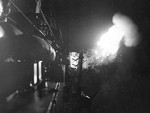 ALL TEN OF NEXT PHOTOS CLICK TO ENLARGE p31
ALL TEN OF NEXT PHOTOS CLICK TO ENLARGE p31
WINTON W. CARTER – COMPANY B: 4 AM and it is dark. We're afloat offshore. Early birds have already gone topside to watch the navy shelling and explosions. One returns and gives us a running account. Then it's chow time. Some eat like it’s another day on the farm. Others, a bit edgy, don’t feel hungry. Then its check your gear, top off your fuel tanks, check your turret traverse, get plenty of clean socks. Two cartons of smokes. Dog tags. Lord don't leave me now. "I shall be with your always." Let's go.
MARSHALL E. HARRIS – Our LST booms out Reveille then Chow down at 0430. From my roost on the bow of our tank in the hold of our LST, I groan. Rolling over, I realize this isn't just another day at sea: it's D-Day. I square away the deck, check gear, make ready for the run into the beach, give up that wonderful mattress on loan from the Navy, then head for Mess Hall. Lo and behold, a great morning meal: sizzling steaks cooked to my liking, fried potatoes, eggs, bacon, ham and fresh milk, toast, butter, juice of all kinds.
CHARLES H. ORLOSKI – COMPANY B: We could see the flashes in the distance that night. They fed us steak and eggs early. I tried to eat but couldn't. I shoved an orange into my pocket. We were all excited.
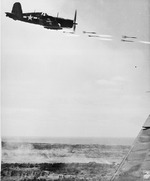 p32L. H. VAN ANTWERP – COMPANY C: As dawn broke I saw a chimney appear above smoke hiding the Charan-Kanoa sugar mill ruins. ROBERT E. WOLLIN: At dawn Navy fighters and bombers swept the shoreline, coming in low, bombing and straffing.
p32L. H. VAN ANTWERP – COMPANY C: As dawn broke I saw a chimney appear above smoke hiding the Charan-Kanoa sugar mill ruins. ROBERT E. WOLLIN: At dawn Navy fighters and bombers swept the shoreline, coming in low, bombing and straffing.
JAMES A. (AL) SCARPO - COMPANY D: Soon after sunrise we got our amtanks ready to go down the metal ramp between our open LST's bow doors and head for the landing beaches. That's when Lewis Zimmer handed me a letter, saying Mail this for me. I looked at him and said: Why should I mail it, I’m going in too. But I took the letter anyway. Within a few hours, Lewis was killed.
CHARLES G. FULTZ - COMPANY A: On our LST one tank wouldn’t start. Santucci was in it and he climbed aboard our amtank and wanted to take my place. We argued back and forth. We both wanted to go in. Finally Santucci's amtank started. An hour later I would have traded with him. I think our amtank was the last one to the north. I’m not sure though. I remember one tank went beyond us and got hit out in the water. A mortar hit its breech, killing 3 men.
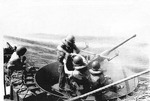 p33HARLAN T. ROSVOLD - COMPANY C: Things got serious just before leaving our LST’s. Still we expected to be lucky. We kept telling ourselves that. We all figured it would probably be some other poor guy that got killed, not us. But maybe Alvin Caldwell knew better. He asked me to remove his religious medal and wristwatch and return them to his family in Oregon should something happen to him. And things didn't work out for Alvin. He was our Amtank CP Man which is the upfront radio man and machine gunner who sits next to the driver.
p33HARLAN T. ROSVOLD - COMPANY C: Things got serious just before leaving our LST’s. Still we expected to be lucky. We kept telling ourselves that. We all figured it would probably be some other poor guy that got killed, not us. But maybe Alvin Caldwell knew better. He asked me to remove his religious medal and wristwatch and return them to his family in Oregon should something happen to him. And things didn't work out for Alvin. He was our Amtank CP Man which is the upfront radio man and machine gunner who sits next to the driver.
 p34At 0700 34 LSTs took station 5200 yards offshore and opened their bow doors then lowered their ramps to begin offloading the first four waves of 719 LVTs that would assault Saipan's beaches from the sea. The first of these LVTs to offload were the 70 amtanks of the 2nd Armored Amphibian Battalion.
p34At 0700 34 LSTs took station 5200 yards offshore and opened their bow doors then lowered their ramps to begin offloading the first four waves of 719 LVTs that would assault Saipan's beaches from the sea. The first of these LVTs to offload were the 70 amtanks of the 2nd Armored Amphibian Battalion.
 p35MARSHALL E. HARRIS : The doors opened. Suddenly we faced Saipan then clattered down the LST's metal ramp toward the sea where our launch was tricky. Our driver had to put our amtank's nose just right into the ocean's ebb and flow then gun its engine. Otherwise our amtank with us inside might sink like a rock, going straight down and deep into Davey Jone's Locker.
p35MARSHALL E. HARRIS : The doors opened. Suddenly we faced Saipan then clattered down the LST's metal ramp toward the sea where our launch was tricky. Our driver had to put our amtank's nose just right into the ocean's ebb and flow then gun its engine. Otherwise our amtank with us inside might sink like a rock, going straight down and deep into Davey Jone's Locker.
WAYNE TERIWILLIGER: We clanked down the metal ramp then our amtank's front plunged into swelling seas. My heart skipped a beat but Up We Popped, suddenly a huge metal cork bobbing on the waves of an open ocean. Our tank's pontoon sides had done their trick.
MARSHALL E. HARRIS: Suddenly afloat but low in the open sea the scene changed. Watery waves everywhere. Battleships, cruisers and smaller ships lay closer inshore Their gray shapes belched fire. Beyond them explosions burst on the island. Along the shore fighter planes raced, bombing and staffing, amid rising blankets of dirt and smoke.
 p36HARLAN T. ROSVOLD: Still on the open sea far out from the reef and shore beyond it, we could see naval shells hitting the island, bursts of fire. My nerves rioted. Rough seas, nervous stomachs digesting steaks, our first battle's excitement had us using empty cardboard tubes 24 inches long but only 4 inches across; tubes that earlier held our 75mm shells were a perilous solution to vomiting while riding in an amtank plunging through 6 foot waves into battle.
p36HARLAN T. ROSVOLD: Still on the open sea far out from the reef and shore beyond it, we could see naval shells hitting the island, bursts of fire. My nerves rioted. Rough seas, nervous stomachs digesting steaks, our first battle's excitement had us using empty cardboard tubes 24 inches long but only 4 inches across; tubes that earlier held our 75mm shells were a perilous solution to vomiting while riding in an amtank plunging through 6 foot waves into battle.
70 2nd Armored Amphibian Battalion Amtanks and 48 troop laden amtracs, once offloaded 5200 yards offshore, headed toward toward various points 4000 yards offshore where they would organize as platoons, each clustered together, into the first wave of assault behind a 2500 yard long Line of Departure. From there, on order, they would begin their assault against the 5000 yard front of Red and Green Beaches, the north half of the 10,000 yard front.
THE ASSAULT GOING IN, CLIMBING the REEF, SWIMMING the LAGOON:
The four assault waves organized behind the Line of Departure 4000 yards off the four Northern Sector landing beaches. Each assault wave arranged itself into a line. The 1st wave (going ashore in front of the other three waves) included 70 2nd Armored Amphibian Battalion Amtanks arranged in nine inverted V echelons. One V echelon anchored each end of the 2500 yard line with the rest distributed among 48 troop laden amtracs broken into in eight linear groups along the line, each comprising six amtracs abreast, and each flanked by one of the 9 amtank echelons. Thus 400 amtankers were to land on Saipan's Red and Green beaches in 70 amtanks ahead of 8 infantry companies carried ashore in 48 amtracs. See Amtank Echelon Formations in 8B/ The 2nd, 3rd and 4th waves coming in behind the 1st wave included 48 troop carrying amtracs, one abreast the other, in a line also 2500 yards long.
 Click to Enlarge 12 gunboats (LCI's) would lead the first wave toward the offshore reef whose outer edge began anywhere from 1400 to 1100 yard offshore. Once there the gunboats would flare right and left before crossing the reef, then fire into the flanks of the landing beaches as the first wave of amtanks and amtracs would mount and traverse the reef, then plunge into the lagoon and swim its broad interior waters, before grinding up onto the beaches to battle several hundred yards inland to an O/1 line to seize an initial beachhead. Three assault waves of amtracs carrying eight infantry companies (1600 men) would follow the first assault wave.
Click to Enlarge 12 gunboats (LCI's) would lead the first wave toward the offshore reef whose outer edge began anywhere from 1400 to 1100 yard offshore. Once there the gunboats would flare right and left before crossing the reef, then fire into the flanks of the landing beaches as the first wave of amtanks and amtracs would mount and traverse the reef, then plunge into the lagoon and swim its broad interior waters, before grinding up onto the beaches to battle several hundred yards inland to an O/1 line to seize an initial beachhead. Three assault waves of amtracs carrying eight infantry companies (1600 men) would follow the first assault wave.
ROBERT E. WOLLIN: At the Line of Departure, we bobbed in the ocean, waiting. Our job: lead the 1st wave onto the Green & Red Beaches, clearing the enemy off those beaches and then push 200 yards inland so Marine infantry coming behind us could cross the beaches intact. The 1st two waves of assault would land within 2 minutes, hitting with cumulative shock in front of two more waves landing within 5 minutes so that 4 assault waves hit the beach in 7 minutes.
At 0807 Navy Control Boats hoisted Wave 1 flags and the LCI gunboats crossed the Line of Departure four thousand yards offshore and headed toward the reef. Meanwhile, the 70 armored up gunned amphibians and 48 troop carrying Amtracs nudged up the Line of Departure, and waited to launch America's first amphibious attack against Japan's Mandated Islands, the inner defenses of the Japanese Empire.
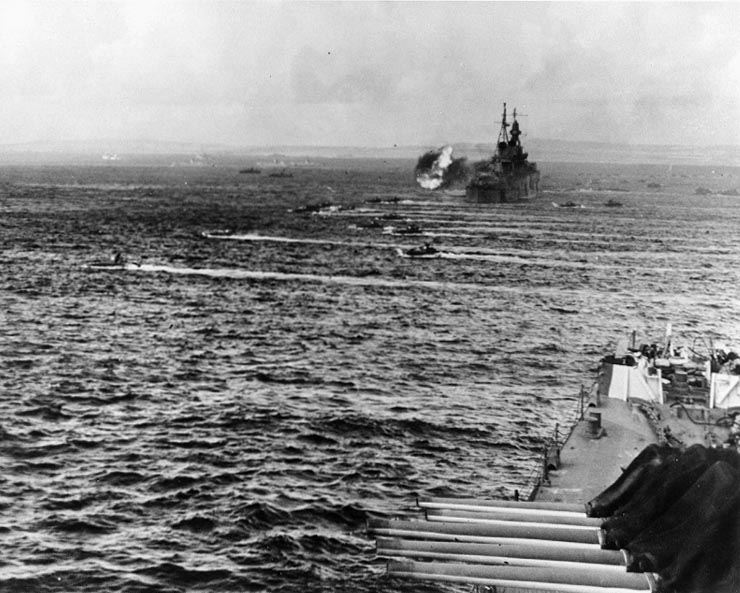
At 0813 the Wave I flags dropped.
The 118 amphibians moving at 4 mph swam the open sea before passing the US Gunfire fire ships on station 2000 yards offshore. G. MILTON SHIRLEY: A battleship with us alongside fired a 16 inch gun. Its concussion hit us like a fist. 'Poing!' Our thin pontoons quivered, not pleasant or reassuring sound but foreboding. Once we'd passed the battleships and cruisers, their heavy naval shells sounded like freight trains passing overhead until the heavy naval gunfire lifted shorty before the amtanks mounted the reef and it exploded.
KENNETH E. SMITH: A kid who hadn’t been out of Iowa but twice, now I was halfway around the world traveling at government expense to visit a place I wasn't welcome but seeing our Company CO Capt Handyside's amtank alongside I felt reassured. He was as fine an officer as you could imagine. I didn't dream he was about to be killed right in front of us.
Capt Handyside's crew also included Gunnery Sergeant George "Gunny" Roberts manning its 75mm Howitzer with loader James Hartman also up in the turret and ammo passers Fred Betz and Chester Scivetti down below the turret. Driver Harold Moody sat up front next to radioman/machine gunner Eugene Lyne Jr.
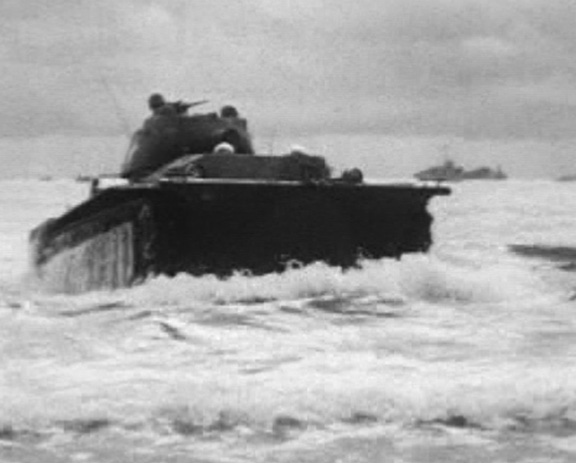 ROBERT E. WOLLIN: We got no Japanese fire outside the reef. Moving over the reef I saw small colored flags sticking out of the water. I thought our frogmen had planted them the day before to show us the way in. Wrong! The Japs drove in a
ROBERT E. WOLLIN: We got no Japanese fire outside the reef. Moving over the reef I saw small colored flags sticking out of the water. I thought our frogmen had planted them the day before to show us the way in. Wrong! The Japs drove in a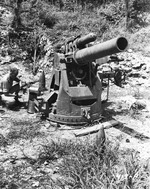 Don C. Newey Click toiming stakes overnight for their artillery now waiting for us to come into range. Then all hell broke loose. Dropping into the lagoon I glanced back but saw only an exploding waterfall falling into our open turret, drenching us.
Don C. Newey Click toiming stakes overnight for their artillery now waiting for us to come into range. Then all hell broke loose. Dropping into the lagoon I glanced back but saw only an exploding waterfall falling into our open turret, drenching us.
JAMES D. MACKEY: My periscope bubble was blown off. Opening the hatch, I saw a high tower in front of us and tracers racing out towards me from a dozen points on the beach. Those tracers wizzed past as we dropped into the lagoon. Tank #2 blew up.
G. MILTON SHIRLEY: Approaching the reef our Driver Elmo Allen down shifted into first gear and we hit coral at the ebb of a wave so had to climb the reef's rugged edge before a big wave coming behind us broke over us and swamped us. Engine stall there would have spelled disaster. Hearing our amtank struggle, I willed our engine tug ever harder. It seemed to have only two churns left when we flopped down on top of that reef. Our driver held our lives in his hands trying to get us safely across the edge of that barrier far from the shore. GENE LEWIS: Our amtank crawled slowly over reef then plunged into lagoon and we started firing everything we had. In the bow machine-gunner's seat, I couldn’t see through the slit.
JERRY D. BROOKS: Large waves breaking over the reef lifted our amtank like a cork and slammed it into the reef under shallow water, dooming our radios, and our alignment moving in V echelon with the other amtanks. Closer in, it dawned on us that steel stakes sticking out of the water at regular intervals were range and deviation points locator points for Jap forward observers calling in pre-registered fire down on us from inland up in the jungled ravines. Closer in yet, we bounced up, down, into and over rough coralheads, making it impossible to keep going in a straight line toward the beach. Fortunately the large caliber flat trajectory direct fire from the beach was less than the indirect artillery and mortar fire coming at us from afar. Those distant mortars had to score a direct hit or very close miss to put us out of action. Enemy accuracy, however, got a lot better as the day wore on.
RICKARD W. MASON: Driving, if I hit the outer edge of the reef wrong, at a bad angle or sideways, I'd roll the amtank, and to keep going straight I had to hit breakers coming over the reef just right. We did then riding atop of a good wave we shot over the reef's far side and plunged into water and came up inside the lagoon headed the right way. Coral heads and holes under the lagoon's surface gave us a bouncy ride in, us going up, down, tilting sideways. Our howitzer's blast blew away my periscope, salt water and powder flew into my eyes. I thought I'd been killed then discovered that I could see again if I just squinted my eyes enough. Closer in, I could see trees with big red blooms on top along the landing beach.
CHARLES H. ORLOSKI: Coming to the reef I waited for a wave to lift us up onto the coral then I shifted as we rode the wave and got across and off it quite well. In the lagoon I felt potholes and coral heads slamming under us as we banged over rough underwater terrain. We were being shelled a lot and returned fire, exhausting a lot of 75mm ammo before we hit the beach. RAY SHERMAN: We started across the reef, Jap artillery opened up, getting several near misses, as we fired back into trees and bushes along the beach.
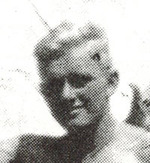 HARLAN T. ROSVOLD HARLAN T. ROSVOLD: The first obstacle was the coral reef the sea was pounding offshore. Our driver PFC Robert Urbatsch did a great job keeping us afloat and headed straight coming across a big wave that crashed down on the reef's edge and then he drove us through all the fire coming at us from across the lagoon.
HARLAN T. ROSVOLD HARLAN T. ROSVOLD: The first obstacle was the coral reef the sea was pounding offshore. Our driver PFC Robert Urbatsch did a great job keeping us afloat and headed straight coming across a big wave that crashed down on the reef's edge and then he drove us through all the fire coming at us from across the lagoon.
RICHARD G. PEDERSON: An ammo passer down below, I didn’t see anything outside but heard explosions all around, and our 75mm howitzer and machine guns firing away.
LLOYD DINSMORE: Also an ammo passer, I heard banging outside as I got tossed around in the amtank crossing the reef. Slamming into coral heads we dropped into holes, floated a moment then bottomed out, slammed into more coral, bounced up and came down, then ground over more reef only to plunge in again until finally we plunged into the lagoon that was wide and shallow in places where we scraped and banged over coral heads underwater.
JOHN ELOFF: An ammo passer, I couldn't see why we weren't firing. Note: Many troop carrying LVTs, being faster, got in front of the amtanks, masking the amtanks' fire.
JERRY D. BROOKS: In the lagoon, hitting coral heads, bouncing us up down and sidways, it was impossible to shoot our 75mm howitzer with accuracy. A couple of our 75 mm shells exploded directly in front of us. Two or three went nearly vertical. Even our machine guns going through the coral head studded lagoon were hard to fire accurately. But our noise and the sight of us alone apparently made a big impression on the enemy. Naval operators monitoring Jap radio traffic picked up their radio messages telling Tokyo that "Monster Guns" mounted on Monster Floating Tanks were coming at them in the Leading assault wave. Our 75mm's muzzle with blast shield looked like an 8 inch gun.
MARSHALL E. HARRIS: Crossing the lagoon I talked with Radio Man Robert B. Lewis in Tank #31 nearby. We went to radio school together, joined the 2nd Armored together, trained in the same platoon, and now we were going into Saipan side by side, best buddies, 18 years old. We were talking about whether we'd gone too far left when his voice vanished in the sound of an explosion. I felt the concussion then shoved up my periscope. Peering out I scanned it. Smoke stopped me. Black smoke splotched with fire roiled off the water, flames boiled out of blackened bent metal hatches - Bob's Tank. Lt. Michael motioned for us to keep going, to hit to the beach. Then Tank # 31 was gone. That was the last time I saw it. Or Bob. Later I saw Bob listed as MIA, presumed dead, his body not found or identified if found. Our Platoon leader was also in that amtank.
M. NEIL MUMFORD: Some of our Tank Commanders going in were talking via radio (instead of intercom) to direct their drivers which way to turn. So the Japs came on the air, saying Turn right or left, trying to confuse us.
HAROLD B. LITZ, JR: By the time we got to the beach the plastic cover over my periscope was filled with water. I couldn’t see to shoot my machine gun.
C. W. (BILL) GOODNIGHT: The mortar and Singapore gun heavy artillery fire from Mt. Tapotchau was on us bad coming across the lagoon going into Saipan.
WINTON W. CARTER: Nearing the beach I saw a watery explosion then another and another. Ahead, slightly to my left, two men got up and started running inland. I stared. Paralyzed. I tried to grasp what this meant. They wore steel helmets, short sleeve shirts. They’re Japanese, you Lummox, the enemy, shoot! It seemed ages. But probably two or three seconds actually passed until my brain and hands got to working together. Then I opened up with my machine gun, firing away.
FRANK E. GAMBLE: We got fire coming at us but got through its splashes and whines off coral, and we had a rough ride, hitting coral heads, but didn’t go belly up over any of them.
WAYDE TERWILLERGER: Once we'd gotten beyond the reef, puffs of water bloomed all around us. Small arms fire rattled off our amtank, shattering the glass in my periscope
PAUL A. HIRSBRUNNER: After the Japs opened up with artillery and mortars I didn’t think we’d get through the splashes without getting hit. But we did.
HAROLD C. MOODY: I was driving Captain Handyside's tank. His orders were to get ashore and set up a CP station at a sugar mill about a half mile inland from the landing beach. Half way across the reef we took a hit that split a pontoon on our left side making it hard to steer. Captain Handyside kept saying, Keep it moving, Driver. As we hit the beach, a sniper killed him.
MARSHALL E. HARRIS: Our driver was having difficulty controlling our amtank. After Bob Lewis went down in Tank #31 nearby, I'd just opened up my 30 Cal bow machine gun firing at the beach when my view disappeared. All I saw outside through my periscope was the lagoon's blue open water. Our tank commander Platoon Sergt. Pappy Outen ordered our driver to turn back, straighten us out, and head directly for the beach. Finally the beach reappeared. For all I know we did a 360 degree turn in the lagoon then headed again for the shoreline. I fired my 30 Cal. machine gun the rest of the way in. My Periscope worked all the way in, giving a view straight ahead and 45 degrees to each side, although I know many of them shattered or got fogged over.
ROBERT E. WOLLIN: My platoon was on the far right flank. Captain Handyside's amtank held that flank's center. Beyond Captain Handyside's amtank on that flank's right side, Lt. Ambrose's amtank was shifting left. At the time we didn't know that strong currents washing north off the beach were carrying us north. Meanwhile Jap artillery was still bracketing us, trying to get our range, and drenching us with near misses, splashing water into open turret hatches. Still they were misses. We were lucky. As the Japs sharpened their range, the assault wave coming in behind us looked to be having the harder time. Note: The artillery and mortar fire coming at the first two assault waves were relatively light compared to what those waves would meet on the beach and inland from it and when contrasted to the fire encountered by later waves crossing the lagoon for the next two days after the enemy refined their targeting.
CHARLES F. AMBROSE: The troop carrying LVTs with faster speeds overan us. Note: This masked the fire of many Amtanks and it greatly accerbated the confusion on the beachhead. Indeed the upgunned armored amphibian LTV(A)4, given its weight when combat loaded, was grossly underpowered. So it was a weak swimmer, highly susceptible to offshore currents, particularly over long distances. This weakness was amplified by the fact than many amtank encountered and collided with coral heads jutting up to just below the shallow water in the lagoon. See Amphibious Tank Section herein for details.
15 JUNE 1944 - STORMING the BEACHES see 8A/ for explanation of landing scheme
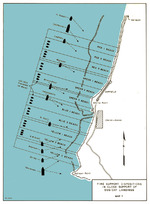 CLICK TO ENLARGEThe 2nd Marine Division Assault Plan dictated that four Infantry Battalions and four 2nd Armored Amtank Companys in two Regimental Combat Teams land abreast on 2550 yards of beach front. The 6th Marines were to land on Red Beaches 2 and 3 up north and the 8th Marines on Green Beaches 1 and 2 down south. In the center of the planned attack a 150 yard wide slot would separate Red 3 from Green 1. The 1st wave of amtanks and LVTs with troops were to push inland to a tractor control line and discharge the troops to establish an initial beachhead. Succeeding waves on the left flank once ashore on Red 2 were to turn north and clear Red I while those on the right flank once ashore on Green 2 would turn further south to clear Green 3. These pivots would extend each flank 600 yards further north and south. However, Murphy's Law intervened. Unexpected sea currents flowing north along the beaches shifted the entire line of attack north. The 2nd Battalion, 6th Marines and Amtank Company A landed up north on Red 1 instead of Red 2, forcing the Battalion and amtank Company to prematurely confront heavy flanking fire from the Garapan area.
CLICK TO ENLARGEThe 2nd Marine Division Assault Plan dictated that four Infantry Battalions and four 2nd Armored Amtank Companys in two Regimental Combat Teams land abreast on 2550 yards of beach front. The 6th Marines were to land on Red Beaches 2 and 3 up north and the 8th Marines on Green Beaches 1 and 2 down south. In the center of the planned attack a 150 yard wide slot would separate Red 3 from Green 1. The 1st wave of amtanks and LVTs with troops were to push inland to a tractor control line and discharge the troops to establish an initial beachhead. Succeeding waves on the left flank once ashore on Red 2 were to turn north and clear Red I while those on the right flank once ashore on Green 2 would turn further south to clear Green 3. These pivots would extend each flank 600 yards further north and south. However, Murphy's Law intervened. Unexpected sea currents flowing north along the beaches shifted the entire line of attack north. The 2nd Battalion, 6th Marines and Amtank Company A landed up north on Red 1 instead of Red 2, forcing the Battalion and amtank Company to prematurely confront heavy flanking fire from the Garapan area.
 CLICK TO ENLARGE Meanwhile 3rd Battalion, 6th Marines, and Amtank Company B landed on Red 2. This left Red 3 wide open on their right flank and created a yawning gap between the divisions two Regimental Combat Teams as most (but not all) of the 3rd Battalion, 8th Marines and Amtank Company C landed as planned on Green 1. Adding to the confusion the 2nd Battalion, 8th Marines and Amtank Company D also landed on Green 1 instead of on Green 2 further south as planned. Thus two Battalions and Amtank Companies became densely packed on a single beach exposed to heavy fire from Afetna Point on their right flank to the south.
CLICK TO ENLARGE Meanwhile 3rd Battalion, 6th Marines, and Amtank Company B landed on Red 2. This left Red 3 wide open on their right flank and created a yawning gap between the divisions two Regimental Combat Teams as most (but not all) of the 3rd Battalion, 8th Marines and Amtank Company C landed as planned on Green 1. Adding to the confusion the 2nd Battalion, 8th Marines and Amtank Company D also landed on Green 1 instead of on Green 2 further south as planned. Thus two Battalions and Amtank Companies became densely packed on a single beach exposed to heavy fire from Afetna Point on their right flank to the south.
Complications fueled the chaos. Unexpected berms behind all beaches magnified a traffic jam of amtracs landing onto already jam packed beaches beneath preregistered artillery and mortar fire from weapons dug into well defiladed positions on heights far inland. Most all of the LTV's carrying infantry stalled before these unexpectedly steep berms. Suddenly stationary targets, the Marines leapt from their stalled LVTS as anti-boat and dual-purpose guns on the flanks raked the stalled lines of Marines, amtracs and amtanks. Those who could battled forward through tank traps, shrubs and fortified defenses spitting out small arms and automatic weapons fire just off the beaches.
GENERAL HOLLAND M. SMITH: "Saipan (instantly became) a savage battle of annihilation ... Spearheaded by armored amphibian tractors which gave the Japanese their first sight of these new machines, the Marines hit the beach at 0843 ... the best we could do was get a toehold and hang on. And this is what we did, just hang on for the first critical day." 9/
WITH COMPANY A's 17 Amtanks and 2nd Battalion, 6th Marines STORMING RED BEACH 1. (Recall that strong north flowing coastal current carried these units onto Red Beach 1, landing these Marines into the teeth of the heavily defended far north flank just south of Garapan town, instead of as planned on lesser defended Red Beach 2 farther south).
CHARLES G. FULTZ : Our tank was the last one to the north, though I’m not sure. One tank went beyond us on the left and got hit, blown out in the water. A mortar struck its breach block, killing three men.
R. E. LEE: On the shoreline we tried two or three times at different places to get inland but heavy beach shubs stopped us. Finally, our driver John Corrado backed into the water, lowered the 75 mm howitzer and tried to blast a path from the water’s edge up through the shrubs. We must have stuck out like a sore thumb. Sitting out in shallow water, blasting away at the thicket, we fired several rounds before a Jap shell hit our turret. Looking behind me, I saw Lt. James Prickett , Gunnery Sgt. Jack Shelly, and Gunnery Sgt. Henry Bixby, all dead. Suddenly I couldn’t see anything but thick smoke. I scrambled to the front compartment and Sgt. James Webb saw all the smoke and yelled Get the hell out of here before she blows up. Our amtank's aircraft engine ran on high-octane gas without self-ceiling gas tanks. Five of us bailed out - me, Sgt. James Webb, Cpl. John Corrado, Pvt. John Lose, Pvt. Gus Evans - and started running through water to the beach. Evans was holding his rifle up high to keep it dry like we'd been taught. But we were taking small arms fire. As I hollered to him to get down, he was hit in face, killed instantly. I reached out to him and was hit twice. “Lights out”, I dropped into shallow water. I heard my 4 year old son calling: Get up Daddy, get up Daddy. By the grace of God and my son I made it to the beach somehow and collapsed. Later I heard a Corpman leaning over me say This guy is dead. I heard it, but couldn't answer or move. Another Corpsman came by and shot me with morphine. It revived me. I stood up, fell back and got back up. I got to our Company CO Capt. Pratt and reported our left flank was wide open. Next thing I remember was being lifted over the side of a Higgins boat. Note: Only Lee survived Saipan. Note: An eight man amtank was a fluke. After Sgt. Web reported his radio unreliable, Lee volunteered as runner to backup communication between Ex. Officer Lt. Prickett and Company CO Capt. Pratt.
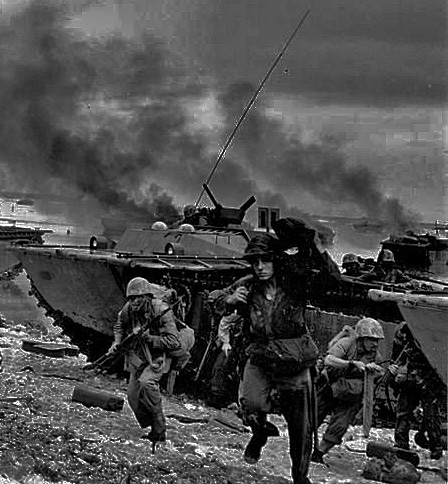 SEE NOTE 9 (A) REGARDING PHOTO
SEE NOTE 9 (A) REGARDING PHOTO
M. NEIL MUMFORD: Coming ashore, I saw out the side hatch an amtank afire next to us, its hatch going up and down. I thought someone was trying to get out but heat was moving the hatch, making it flutter, then the tank's ammo began to blow. A shell hit the base of our turret. We abandoned our tank, only to discover it was safer inside.
CHARLES G. FULTZ: A small mortar blew out our left side pontoon, ripping off our track. Abandon tank! yelled our Platoon Sergeant, taking off. We didn’t see him for two weeks. With nowhere to go, we got back in our busted tank, and kept firing at different targets.
JOHN EINARSON: I drove the 2nd amtank onto Red Beach I's left flank. The Jap's closest targets, we got heavy fire from Garapan but got across the airstrip road into thick woods. With little maneuver room, a nearby amtank lost its track. We fired at enemy spotters on high ground calling artillery down on us. Infantry was moving past when a shell hit us, killing Ammo Loader Delwyn Carlson. Oil pressure fell. Turret Gunner William H. Brence was hit. We lost engine power trying to get to an LST for repairs and sank just off the beach. Only our turret stuck above water peppered with enemy fire. Tank Commander Sgt. Gust E. Wiitala and radioman Donald Viculin were wounded trying to swim away. Brence, Wilmer L. McAfee and I kept low behind the turret, stranded in water for 3 hours until an amtrac got us ashore.
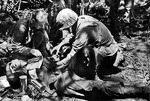 Click to Enlarge p34BRONZE STAR Citation for JOHN R. SMITH, JR - COMPANY A: "For heroic achievement in action against the enemy on 15 June 1944 ... When his armored amphibian, supporting the infantry in driving the enemy from the beach, was temporarily stalled, Corporal Smith received permission from his tank commander to leave the vehicle to aid a wounded Marine. Corporal Smith carried the wounded man back to the aid station on the beach under intense enemy fire. He then returned to his armored amphibian and continued to press the fight against the enemy. His conduct was in keeping with the highest traditions of the United States Naval Service."
Click to Enlarge p34BRONZE STAR Citation for JOHN R. SMITH, JR - COMPANY A: "For heroic achievement in action against the enemy on 15 June 1944 ... When his armored amphibian, supporting the infantry in driving the enemy from the beach, was temporarily stalled, Corporal Smith received permission from his tank commander to leave the vehicle to aid a wounded Marine. Corporal Smith carried the wounded man back to the aid station on the beach under intense enemy fire. He then returned to his armored amphibian and continued to press the fight against the enemy. His conduct was in keeping with the highest traditions of the United States Naval Service."
BRONZE STAR Citation for WILLIAM J. NICHOLS - COMPANY A: For meritorious achievement against the enemy from 15 June to 9 July ... When his armored amphibian was hit by enemy shell fire and completely destroyed during the initial assault and he was wounded, 2nd Lt. Nichols joined his company that had become widely disbursed in the intense action. Throughout the campaign he displayed great initiative and agressiveness and contributed much to the success of his company in the hard fought campaign. His tireless energy and devotion to duty were in keeping with the highest traditions of the United States Naval Service.
S. A. BALSANO: I drove our Platoon Commander Lt. Philo Pease up in the turret across the airstrip then inland before a tank trap stopped us. Japs waiting there were on us like flies. Leroy Clobes stuck his light machine gun out the side hatch and fired away like mad. I had my Thomson sub-machine gun firing out the front hatch. That was a scary morning.
GLENVILLE D. BARRINGER: In Lt. Pease’s tank stuck in that trap we heard Japs crawling under us, but didn’t know what they were doing. (a magnetic mine was found next day). An amtank came up from behind but couldn't pass us due to trees and the amtank behind it also got stuck. Lt. Pease ordered us to stay inside and went to help the tank commander behind us who was trying to hook a tow cable to the tank behind him. When a sniper killed him, Lt. Pease tried to finish the job, but the sniper killed him too. Our third tank took a 37mm round through it, killing the driver. The radio man next to him wasn't hurt.
JAMES R. MACARTER: Trees stopped our amtank and Lt. Please coming up behind tried to get his through the trees but got caught in a ditch. My Sergeant John Mahan tried to pull Lt. Pease’s tank out, but a Jap tank killed them.
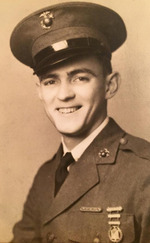 Stg. John W. MahanBronze Star Citation for JOHN W. MAHAN - COMPANY A: For heroic achievement in action against the enemy 15 June 1944. While helping another armored amphibian that stalled, Sergeant Mahan was hit in the arm by an enemy sniper, took cover, bandaged his arm then resumed control of his armored amphibian. Looking for a sniper that had killed his officer and a sergeant, he was mortally wounded by enemy machine gun fire. His conduct throughout distinguised him among those performing duties of the same character.
Stg. John W. MahanBronze Star Citation for JOHN W. MAHAN - COMPANY A: For heroic achievement in action against the enemy 15 June 1944. While helping another armored amphibian that stalled, Sergeant Mahan was hit in the arm by an enemy sniper, took cover, bandaged his arm then resumed control of his armored amphibian. Looking for a sniper that had killed his officer and a sergeant, he was mortally wounded by enemy machine gun fire. His conduct throughout distinguised him among those performing duties of the same character.
The 2nd MARINE DIVISION HISTORY FOLLOW ME picked up the action: "When Amphibian Tank No. 4 manned by seven Marines who had only six days practice in these strange new machines were surrounded by Japs in a tank trap … and it’s Commander (Lieutenant Pease) was shot dead, Corporal Paul A. Durand of Connecticut inherited command. His order: Shoot all the sons of bitches you can! A Chicagoan Private Leroy J. Clobes opened the starboard hatch and killed a whole cluster of Japs with his machine gun. Corporal Durand fired a 75mm shell into a nearby straw house, and blew up a dozen Jap soldiers."
JIM MCCARTER - COMPANY A: After Gunny Bixbe was killed Gunnery Sergeant Clarron C. Miller took over much of Company A, and he got on top of things immediately and performed a most professional job under the most adverse conditions imaginable.
WITH COMPANY B's 17 Amtanks and 2nd Battalion, 6th MARINES STORMING RED BEACH 2 south of Red Beach 1 instead of on Red Beach 1 as planned. (Recall that this much but not all of this landing was farther north than planned so opened a gap in the center of the 2nd Marine Divisions line of attack, one larger than the planned naval gunfire lane that was intentionally left open between the division's two Regimental Combat Teams.)
LEE V. GOTCHALL: Our tank was flying the American flag. I think we got credited with planting the first American Flag on Saipan, and got there first by fiddling with the governor on the amtank's engine, giving it extra speed.
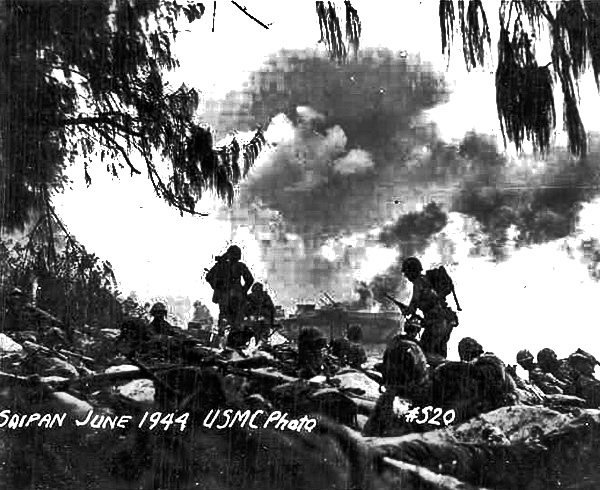 WINTON W. CARTER: Some amtanks move inland, some can't. Bang! Boy, we’ve been hit. She’s on fire. Get out and take cover before our ammo goes off. Exiting, I feel a sharp sting in my thigh. I’m hit but can walk. One of our crew in water a foot deep motions help me. Part of my leg is gone. I feel underwater. It’s bad. No, you just have a wound, that’s all, I reassure him. We wrap him up in GI coats then luckily can hustle him onto a landing craft that's heading out. Once its gone, we realize we’re missing our driver and another guy. Both were killed. The Japanese shell entered up front, exploding the driver’s cab. On the beach I'm dazed. One of our officers appears and we report our mishap. He departs. He returns. “Colonel Fawell would like a word with you.” I was not even aware he had come in with us. The Colonel uses his favorite expression: How’s it going? He listened. Poured me a small whiskey shot. We toasted. He said: Keep under cover.
WINTON W. CARTER: Some amtanks move inland, some can't. Bang! Boy, we’ve been hit. She’s on fire. Get out and take cover before our ammo goes off. Exiting, I feel a sharp sting in my thigh. I’m hit but can walk. One of our crew in water a foot deep motions help me. Part of my leg is gone. I feel underwater. It’s bad. No, you just have a wound, that’s all, I reassure him. We wrap him up in GI coats then luckily can hustle him onto a landing craft that's heading out. Once its gone, we realize we’re missing our driver and another guy. Both were killed. The Japanese shell entered up front, exploding the driver’s cab. On the beach I'm dazed. One of our officers appears and we report our mishap. He departs. He returns. “Colonel Fawell would like a word with you.” I was not even aware he had come in with us. The Colonel uses his favorite expression: How’s it going? He listened. Poured me a small whiskey shot. We toasted. He said: Keep under cover.
 CLICK TO ENLARGEGENE LEWIS: In from the beach our tank got hung up. Perched on a stump, angled up in the air, unable to fire our 75 mm gun or get traction, we're stuck. A Jap 37 mm shell passed between our ammo passer's legs, singing his pants and him too then exited our amtank's other side. We bailed out. I never saw several of my tank crew again. But wounded Marines lay all over the beach, Corpsmen yelling for help. So I helped, going from one wounded Marine to another, putting sulfa drugs in their wounds then bandaging them, all we could do amid exploding shells landing craft coming ashore, dropping off Marines. Mass confusion, I don’t remember most of it, so focused was I on doing my job. But I do recall bullets hitting close by, smashing into a tree inches away.
CLICK TO ENLARGEGENE LEWIS: In from the beach our tank got hung up. Perched on a stump, angled up in the air, unable to fire our 75 mm gun or get traction, we're stuck. A Jap 37 mm shell passed between our ammo passer's legs, singing his pants and him too then exited our amtank's other side. We bailed out. I never saw several of my tank crew again. But wounded Marines lay all over the beach, Corpsmen yelling for help. So I helped, going from one wounded Marine to another, putting sulfa drugs in their wounds then bandaging them, all we could do amid exploding shells landing craft coming ashore, dropping off Marines. Mass confusion, I don’t remember most of it, so focused was I on doing my job. But I do recall bullets hitting close by, smashing into a tree inches away.
 Click to EnlargeE. FRANK GAMBLE: On the far side of the airstrip road our clutch froze, trapping us in shell hole, so we joined infantry coming alongside and advanced on foot 100 yards before two Jap tanks came at us. Watching them grind toward me, I discovered that my 45 Caliber automatic and Thompson submachine gun were worthless against land tanks long before their metal treads passed over my trench, scaring the hell out of me. The 2nd tank stopped next to Francis Whipple, giving him something to thing about too.
Click to EnlargeE. FRANK GAMBLE: On the far side of the airstrip road our clutch froze, trapping us in shell hole, so we joined infantry coming alongside and advanced on foot 100 yards before two Jap tanks came at us. Watching them grind toward me, I discovered that my 45 Caliber automatic and Thompson submachine gun were worthless against land tanks long before their metal treads passed over my trench, scaring the hell out of me. The 2nd tank stopped next to Francis Whipple, giving him something to thing about too.
SILVER STAR Citation for GURNIE G. PETERS - COMPANY B: For Conspicuous gallantry and intrepidity while ... in action against enemy forces ... 15 June 1944. Assuming command of his armored amphibian after his superior was wounded, Corporal Peters proceeded inland with the infantry and, when his 75 mm howitzer was disabled by an enemy shell, manned the 50. Caliber machine gun to clear the way for the infantry, overunning two mortar emplacements and one machine gun nest. After his vehicle was stopped by an obstacle, he refused to abandon it and, remaining alone, moved it once again into operations against the enemy. His courage and devotion to duty reflect the highest credit upon Corporal Peters and the United States Naval Service. Signed for President by Sec. of Navy
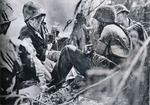 CLICK TO ENLARGEBRONZE STAR Citation for WILLIAM R. TAYLOR - COMPANY B: For conspiciuous gallantry and intrepidity as a hospital corpsman in action against the enemy 15 June 1944 ... Abandoning his armored amphibian, which was destroyed by enemy mortar fire, he successfully evacuated the wounded to LVT's and then voluntarily returned to the front line zone where, as the only corpsman present and in the face of heavy mortar fire and machine gun fire, he (again) treated and delivered the wounded to the beach heedless of his own safety. After his medical supplies were exhausted, he assisted in setting up the Battalion Aid Station of an infantry unit and volunteered his sevice until his own organization's aid station was established. His heroic action and conduct throughout were in keeping with the hight traditions of the United States Naval Services.
CLICK TO ENLARGEBRONZE STAR Citation for WILLIAM R. TAYLOR - COMPANY B: For conspiciuous gallantry and intrepidity as a hospital corpsman in action against the enemy 15 June 1944 ... Abandoning his armored amphibian, which was destroyed by enemy mortar fire, he successfully evacuated the wounded to LVT's and then voluntarily returned to the front line zone where, as the only corpsman present and in the face of heavy mortar fire and machine gun fire, he (again) treated and delivered the wounded to the beach heedless of his own safety. After his medical supplies were exhausted, he assisted in setting up the Battalion Aid Station of an infantry unit and volunteered his sevice until his own organization's aid station was established. His heroic action and conduct throughout were in keeping with the hight traditions of the United States Naval Services.
ORIE F. MORGAN: We were lucky compared to the boys in Company A to our left who took most of the heat of Jap artillery, tanks and infantry coming down from Garapan direction. We landed further south down the beach almost in line with the Jap Radio Station or just to the right of it. Note: if Orie Morgan's recollection is accurate then his amtank landed as planned on or very near Red 1's south end. This comment also applies to Winton Carter's B Company amtank that must have landed on or near the north end of Green 3 since Colonel Fawell's amtank came ashore there as he planned at the center of the line of attack. This illustrates how different units or parts of them became intermixed before landings on the same beach. Thus many individual Marines and/or their units became orphans, out of place and separated from their buddies and commanders, adding to the overall confusion.
WITH COMPANY C's 17 Amtanks & 2nd Bn, 8th Marines STORMING GREEN BEACH 1 on COMPANY B's right.
L. H. VAN ANTWERP: We were to land on Green 1 with the 2nd Bn, 6th MARINES right behind us. Company D's amtanks & 3rd Bn, 8th Marines were to land to our right on Green 2 whose north side included parts of Afetna Point that protruded into the lagoon, an area full of Jap anti-boat and anti-tanks guns. But most of our amtanks going in were buttoned up so when our domes fogged over and periscopes shattered, we had no way good way of knowing the currents were carrying us north or where one designated landing beach zone ended and another started. Company D's amtanks had the same problem. So they and 3rd Bn, 8th Marines landed too far to the north on Green 1 (not Green 2) along with us and the 2nd Bn, 8th MARINES. All were bunched up on the same beach. This left our right flank, including Afetna Point open on on right, leaving a big gap between our 2nd Marine Division on the north and 4th Marine Division to the south on the far side of Afetna Point. From the Point the Japs could see north clear up our landing beaches jammed with amtracs, amtanks and infantry. So they feasted on us. All jammed together, we were hard to miss. Our Infantry later fanned out to the south using shotguns to take Green 2 and finally Green 3, closing most of the gap, but the enemy's artillery and mortars implaced far inland kept coming.
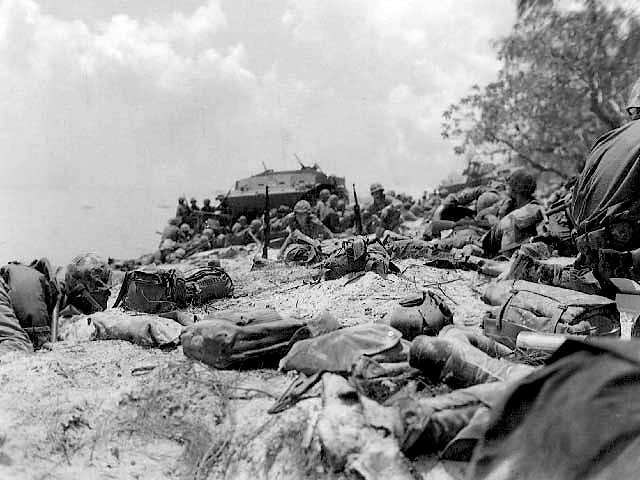 SAIPAN'S RED BEACH 2 ON D-DAY
SAIPAN'S RED BEACH 2 ON D-DAY
NORMAN B. SLOWE: We halted up to the north near Japs who were tossing grenades from a bunker so took them out with hand grenades early that first day and then later got stuck in Lake Susupe swamp behind Green Beach 2 around noon.
MARSHALL E. HARRIS: Stalled at a berm just behind the beach, our clutch kept slipping. We dismounted, took cover, heard small arms fire then: Marine hit! Pappy Outen saw the Japs first and motioned me and McDaniels toward their camouflaged hole. Pappy tossed McDaniels a Thomson submachine gun and the two of us got behind then came around toward the opening. McDaniel's took out at least one Jap then I watched my carbine put two holes in another's helmet. As if in slow motion he rolled over alive but dying. You just killed a man, that hit me hard. Noise came from the bunker. Pappy Outen had Slowe toss me a grenade. Throw on a two count. I pulled counted then threw. Likely it worked but we tossed in two more. I saw those two holes opening that helmet every day for years. So despite all the killing later, the moments of that first kill shook me for years.
JAMES D. MACKEY: Just offshore going in I drove our amtank 8 Ball straight for an opening between trees at the water’s edge. John Mackenzie (driving Lt. Hadwiger's tank) was crowding me from our right. I don’t think John saw me. I slowed to avoid a collision. He got ashore first, went straight in through the opening with us right behind, then he veered right and flashes appeared. I veered left toward the flashes, Jap fire spitting from a stand of cedar seedlings 20 to 25 feet high. Our tank CO Schmidt who saw the Japs first and started firing our 50 Cal. machine gun at them before 8 Ball began knocking over the trees. The Japs took off as trees fell over their emplacement and 8 Ball roared over their 37mm gun big enough to shoot clear through our amtank. An explosion blew chalky fine coral over us, into my driver’s hatch, and broke our left track, disabling us about 150 to 200 yards in from the beach. We stayed with 8 Ball and finally got her fixed and back in action with a track we took off an otherwise totalled amtank.
RICHARD W. MASON: At the beach Lt. Hirsbrunner called “Hard Right Rudder.” I turned hard right between trees along the beach then passed Jim Mackey (outside his tank looking at its broken track), and we got on that little airstrip road parallel to the beach before I saw a bunch of little Marines scurrying about. A quick 2nd look said they weren't Marines, but Japs moving to different positions. We got a 75mm shot off at a Jap land tank but it hit a tree and exploded then we couldn’t get the gun to fire anymore. But, with our 50 cal and two 30 cal machine guns firing away, we were still as mean as a porcupine.
PAUL A. HIRSBRUNNER: Hitting the beach, our intercom failed. I couldn’t use it to direct our driver. A shell fragment hit my steel helmet, but we kept going inland, past Mackey’s disabled tank, toward a Jap tank stopped in a grove of trees. My Gunner cranked the 75mm howitzer around and fired a point detonating round that hit a tree then exploded before hitting the tank. Our loader slammed in another shell, but the Howitzer's firing pin broke. I yanked the 50 cal machine gun around on the turret and fired a couple of bursts before its firing pin broke too. The Jap tank ran off without firing back. Since our battle plan was to hit the beach at a certain location, knock out the gun implacements and kill the Japs opposing us, and then head inland doing the same until we got to a narrow gage railroad track, we kept on going to the railroad tracks.
HARLAN T. ROSVOLD: In Rodweller's tank we crossed the beach and the airstrip road, going into 'no man’s land', before an armor piercing shell coming through the left front bogy wheel hit CP Operator Alvin Caldwell. Going clear though the tank, it killed him instantly. It felt like every big gun on Saipan was aimed at us but we couldn't see where the fire came from, so couldn’t shoot back. It was like being on a pool table with people taking free shots at us.
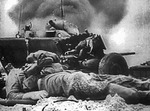 Click to EnlargeROBERT W. URBATSCH: I was driving Rodweller's tank when we took that Jap 37 round, killing Alvin Calwell who was sitting right next to me on my right. I grabbed a machine gun. An Ammo Passer got a tripod and we crossed the road to a ditch. There, we couldn’t figure out how all that Marine infantry got into the woods ahead of us until it dawned that they were all Japs.
Click to EnlargeROBERT W. URBATSCH: I was driving Rodweller's tank when we took that Jap 37 round, killing Alvin Calwell who was sitting right next to me on my right. I grabbed a machine gun. An Ammo Passer got a tripod and we crossed the road to a ditch. There, we couldn’t figure out how all that Marine infantry got into the woods ahead of us until it dawned that they were all Japs.
RICHARD G. PEDERSON: We got inland 150 to 200 yards then got hung up, couldn't move at all. The other ammo passer stuck a 30 cal machine gun out the starboard hatch and fired away.
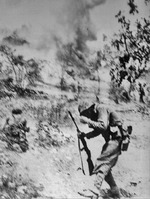 Click to EnlargeJERRY BROOKS: I was a surplus CP but Major Bevans let me go in on Vernon Lowe's amtank as an extra ammo passer. We hit Green Beach 1 or thereabouts and coming ashore we rumbled by some Jap gun positions and didnt' see Japs amid all the smoke, dirt, and dust inside, but cleared those positions out and went in a couple of football fields before we got hung up then, bracketed quickly with artilley explosions, we bailed like rats leaving a sinking ship before the 3rd round coming in finished off our amtank.
Click to EnlargeJERRY BROOKS: I was a surplus CP but Major Bevans let me go in on Vernon Lowe's amtank as an extra ammo passer. We hit Green Beach 1 or thereabouts and coming ashore we rumbled by some Jap gun positions and didnt' see Japs amid all the smoke, dirt, and dust inside, but cleared those positions out and went in a couple of football fields before we got hung up then, bracketed quickly with artilley explosions, we bailed like rats leaving a sinking ship before the 3rd round coming in finished off our amtank.
(Note - Most likely Lowe's amtank with Brooks inside landed north of Green Beach 1 in the naval gunfire lane between Green 1 and Red 3 or within the wide open Red 3 that was now a No Man's Land between the 2nd Marine Division's two Regimental Combat teams, the 6th Marines on the north near Garapan and the 8th Marines to the south. Most likely too Marshall Harris' amtank commanded by Platoon Sgt. Outen and other scattered elements of the 6th and 8th Marines also landed in this No Man's Land.)
VERNON C. LOWE - Inland a good ways we got stuck on a stump dead center under us so we couldn't get any traction. Then Japs shells started zeroing in on us. JERRY BROOKS: Despite the waves of amptracs that were supposed to be just behind us, arriving every two minutes, after we bailed, I can't see any other amtanks or Marines so wonder if only us got ashore then a shell destroys our amtank. Flying coral wicked as metal shrapnel drops me like a sack of cement onto the coral rock that slices, cuts, scrapes and bruises something fierce too. Laying there I spot Japs in kaki and leggings running left to right along the narrow gauge railway track and empty a full carbine magazine at the Japs, don't drop a one, but others scurrying from one position to another start taking pot shots at me. Stuff hums my way then whizzes by. It's like pulling targets at the rifle range: I knew exactly which rifle cracks were headed at me, but now the target is me unless I fire back.
 pJACK HARVEY: Our Tank CO Sgt. Edward T. Grant, a Guadalcanal veteran, probably only his experience got us through that first day, like his telling us to bail out moments before a shell put a 6 inch hole through where our driver had been. That was after we got to the radio tower, fell into a shell hole, and got bracketed by artillery. Charles Kelly was our Gunner.
pJACK HARVEY: Our Tank CO Sgt. Edward T. Grant, a Guadalcanal veteran, probably only his experience got us through that first day, like his telling us to bail out moments before a shell put a 6 inch hole through where our driver had been. That was after we got to the radio tower, fell into a shell hole, and got bracketed by artillery. Charles Kelly was our Gunner.
HAROLD B. LITZ, JR.: We reached a bamboo shack with goat outside before Japs inside blew their shack up, them going up with it. Beyond there we bellied up on something and couldn't move. I was opening our hatch when a shell exploded, blowing the top off our Tank Commander's shoulder. Plt. Sgt. Kenneth Van Bebber's was going into shock, all his bones exposed, as Jap mortars and artillery zeroed in on us.
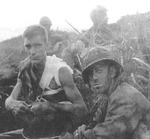 CLICK TO ENLARGEORVIS WHITAKER: Our amtank stuck out like a sore thumb amid lots of heavy stuff dropping in on us from a distance. Marines fell left and right, Japs were everywhere. We dug in as best we could but shrapnel hit our driver's shoulder. I was never so scared in my life.
CLICK TO ENLARGEORVIS WHITAKER: Our amtank stuck out like a sore thumb amid lots of heavy stuff dropping in on us from a distance. Marines fell left and right, Japs were everywhere. We dug in as best we could but shrapnel hit our driver's shoulder. I was never so scared in my life.
KEITH NEAL: A Mechanic & Welder I went in with the first wave supposedly at Green Beach 1 or 2 but I think we veered left. Passsing ammo up to the loader it was a hectic time, growing more so with every minute after we got ashore. And hot. Unbelievable.
L. H. VAN ANTWERP: Up front our radio operator Lloyd Harper sat next to Joe Filipowich driving. Behind them Henry York and Joe Jackowski Henry passed ammo up to Harold Wilcox in the turret. An awful lot of artillery and mortar fire were coming down on us from Jap positions inland. Afetna Point's flanking fire added to the mess. Near the radio station inland from Green Beach 1's north edge, an artillery shell hit us just below the turret. Nobody was killed. As we bailed Wilcox spotted a bunch of Japs nearby, so he jumped back in our amtank's turret and nailed them and then a machine gun nest.
(Note: Van Antwerp's amtank landed alongside or very near Colonel Fawell's HQ CO. amtank).
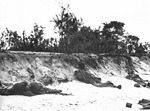 CLICK TO ENLARGE(To paraphase a 1945 US Army Report on the 24 LVTs of the 715 Amphibian Battalion that carried that 1st Wave of the 8th Marines into Green Beach 1: When a bank topped with trees stopped 22 of the 24 troop carrying LVTs at beach the Marines left the LVTs at the water's edge and took cover behind the bank. The 2nd wave of assault troops arrived soon thereafter and within next five minutes all 5 waves had landed, jamming troops between the tractors behind them and Japs in front. One LVT that did get over the bank drove a road through small trees to the airstrip road then took it north 150 yards before the driver stalled its engine when confronted by 3 Jap tanks. All aboard bailed out and returned to beach. The only other LVT driver who managed to get over the bank and off the beach crossed the same airstrip road and got to the radio tower 700 yards inland then disappeared for two days before he reappeared at the beach, suffering from shock, unable to tell anyone how he got inland or back. 5/)
CLICK TO ENLARGE(To paraphase a 1945 US Army Report on the 24 LVTs of the 715 Amphibian Battalion that carried that 1st Wave of the 8th Marines into Green Beach 1: When a bank topped with trees stopped 22 of the 24 troop carrying LVTs at beach the Marines left the LVTs at the water's edge and took cover behind the bank. The 2nd wave of assault troops arrived soon thereafter and within next five minutes all 5 waves had landed, jamming troops between the tractors behind them and Japs in front. One LVT that did get over the bank drove a road through small trees to the airstrip road then took it north 150 yards before the driver stalled its engine when confronted by 3 Jap tanks. All aboard bailed out and returned to beach. The only other LVT driver who managed to get over the bank and off the beach crossed the same airstrip road and got to the radio tower 700 yards inland then disappeared for two days before he reappeared at the beach, suffering from shock, unable to tell anyone how he got inland or back. 5/)
Note in photo the steep grades topped by trees that stopped 22 of 24 troop carrying LVTs at the beach. These berms or stretches of erroded beach thwarted the initial thrust of the assault troops to the O-1 line. This wreaked havoc on the landing beaches, causing a traffic jam of troops and vehicles trapped on the beaches compounded by offshore currents that carried and additional Infantry Battalion and amtank Company north onto Green 1 instead of Green 2. Suddenly Green 2 on the south flank was wide open, exposing its jammed Marines and vehicles to particularly heavy anti-tank and dual purpose flanking fire from Afetna Point. At the same time Red 1 was also left open in the center of the line, leaving the right flank of Amtank Company B and the 6th Marines wide open while Amtank Company A and its cohort Infantry Battation landed in the teeth of heavy enemy defenses on Red 1. See 10/ See Also 13A/
WITH COMPANY D's 17 Amtanks & 3rd Bn, 8th Marines STORMING GREEN BEACH 1 on COMPANY C's right or mixed in with it.
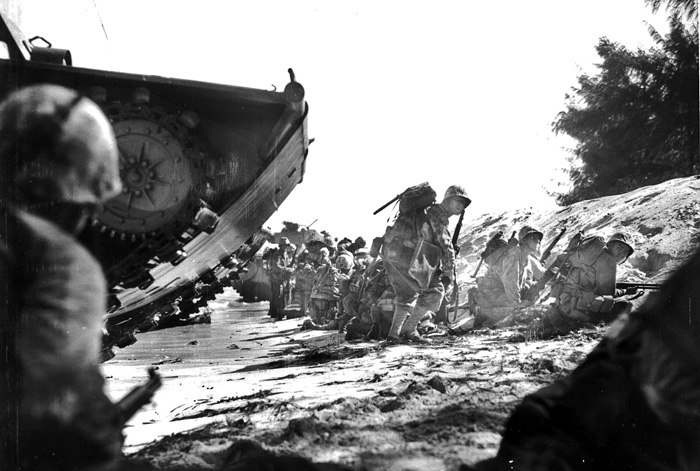
HAROLD C. MOODY: We got heavy fire from the right flank and drifted left coming in. Capt. Handyside was killed. Roberts, Hartman and Scivetti were wounded. Scivetti was killed at the beach aid station when it took a direct artillery hit.
ROBERT WOLLIN: Capt. Handyside's last words: "Ambrose, take command" went out over the radio. No one knows how he said it. We considered it a sort of miracle. The bullet hit him over one eye.
CHARLES F. AMBROSE: My tank was far right, Handyside's was in center. Despite noise and confusion, a lot of us heard his order over the radio.
Platoon Report on Tank 70: After Captain Handyside was hit in the head by rifle fire and rendered unconscious, Gunny Sgt. Roberts proceeded inland 100 feet to camouflaged position, rendered first aid to the Captain, evacuated him to 3rd Battalion 8th Marines Aid Station, and then pulled Sgt. Norton's tank from a shell hole. Next, realizing they'd landed on the wrong beach, he went by foot on reconnaissance, leaving Sgt. Hartman in charge of tank. On recon Sgt. Roberts wounded by Hip Mortar.
KENNETH E. SMITH: On the beach after Jack Whitis ran us into a hole, an infantryman with a semi-automatic shotgun killed two or three Japs right beside us. Then Jack bucked us out of the hole.
SIMON MILLER: Our tank crew of Lee Price, Jack Whitis, George Cote, Kenneth Smith, Ron Davis landed on a beach that received a lot of shelling before and as we landed. Then surprise. About 20 yards inland, looking over the turret, I saw a Jap getting out of his hole with a rifle, and got him with my carbine.
Report on 1st Platoon by Lt. MANNER – COMPANY D: Led 1st platoon ashore onto right flank Green Beach 1. Led infantry inland 800 yards, knocking out two machine gun nests on the way, firing 75mm only at pointed targets, and firing machine guns at snipers, while advancing under heavy mortar and artillery fire. At section between road junction and radio station, tanks 55-56-57 bogged down in rice paddy. Tank 56 and 58 were abandoned when artillery got their range. Their crews going back to beach cleaned out one machine gun nest with grenades and rifle fire. One man, Keily, killed. Sgt. Livesey in tank 57 moved 50 yards beyond the bogged down tanks, took cover in palm grove cover, abandoned tank for pillbox. Crew returned to tank and moved 200 yards north to take cover from enemy shell fire then abandoned tank to dig in and saw enemy tank approaching road junction 72-1 near vicinity of Charon-Keja. So crew returned to tank 57 and opened fire on enemy tank, and spotted two more enemy tanks firing on bogged down amtanks, so moved 100 yards south to fire on these enemy tanks moving on road towards R.J.-3-1 at Areai. This action forced enemy tanks to turn and fight. Sgt. Livesey received numerous hits from enemy fire before knocking out enemy tanks. Sgt. Dickens used his tank in similar fashion. The two LTV(A)4s may be credited with destruction of four enemy machine gun nests, three enemy tanks, one gasoline dump, and generally clearing 400 yards of Red Beach 3, scattering the enemy, leading the infantry, harassing the rear of the retreating enemy and preventing an enemy counterattack, the action taking place in vicinity of an exploding enemy ammunition dump. Despite repeated jams, Sgt. Livesey and Dickens were able to fire all 75mm rounds with exception of smoke shells. When Dicken's crew forced to abandon tank, shrapnel killed Pvt. Leo Pletcher.
BENJAMIN R. LIVESEY: We got to the beach okay and through a tree line along the beach then crossed a small air strip and headed inland about a hundred yards to an abandoned radio station. From there we continued to a narrow cart path just wide enough for two vehicles to pass. A few small open fields lay amid thick groves of palm trees. We stopped in a grove and lay out on the ground. Minutes later we started receiving small arms fire from directly in front of us. We scrambled back into our tank and scanned ahead into the grove of trees, using our gun sight and binoculars to spot a building with some Japs moving around inside it. We opened fire with everything we had - 75 mm high explosives and incendiary, and 30 caliber machine guns - and kept up a steady stream of fire, igniting several explosions and a huge fireball. It was spectacular. Moving in closer we pasted the area then drove a 100 yards further inland to a clearing on our right flank. There we stopped to count up our ammo and hit the water bucket when Sgt. Onel Dicken's amtank came alongside. We didn’t see any other amtanks or Marines this far inland. We were alone and isolated, but enjoying our success. Some of us dismounted to talk with Dickens and his crew. Suddenly one of us spotted four Jap land tanks running in a column, headed for the landing beach. We got back in our tanks, turned them into position and started firing. Our first hits didn’t seem to have any affect. The Jap tanks kept running. We pursued them, and were getting our armor piercing shells ready for the next go, when suddenly they turned and came at us. It was us or them. We fired everything we had at them. Our ammo passer and loader were working their butts off to keep the shells coming. Dickens' crew was keeping their 75mm hot also. The last Jap tank stopped about 50 to 70 yards from us. I remember that clearly because one of the Japs got out of his tank and started for the hills. I also remember I was a poor shot because I could not hit him.
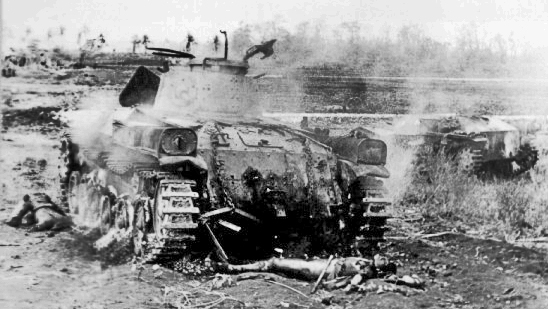 pMILTON G. SHIRLEY: Sgt. Dickens was our tank commander. Sgt. Livesey commanded the tank next to us. At noon most of the Jap artillery was firing at targets behind us, down to the beach. So it was calm where we were, parked under a tree in a banana grove, eating K-rations, when Livesey spotted Jap tanks and pulled up alongside us. I don’t know how many of the Jap tank cannon rounds were fired in the exchange but one hit Livesey's engine compartment. It was a dud. We received a hail of machine gun fire. We probably fired no more than six rounds each. But the Japs were immobilized with their tanks burning. Hardly any of their crew got out. The firefight got the Jap's attention so they moved their artillery fire inland from the beach to us. We bailed out and barely got away.
pMILTON G. SHIRLEY: Sgt. Dickens was our tank commander. Sgt. Livesey commanded the tank next to us. At noon most of the Jap artillery was firing at targets behind us, down to the beach. So it was calm where we were, parked under a tree in a banana grove, eating K-rations, when Livesey spotted Jap tanks and pulled up alongside us. I don’t know how many of the Jap tank cannon rounds were fired in the exchange but one hit Livesey's engine compartment. It was a dud. We received a hail of machine gun fire. We probably fired no more than six rounds each. But the Japs were immobilized with their tanks burning. Hardly any of their crew got out. The firefight got the Jap's attention so they moved their artillery fire inland from the beach to us. We bailed out and barely got away.
The 2nd MARINE DIVISION HISTORY FOLLOW ME reported: The amtanks had jolted inland ahead of the first wave of riflemen, their 75s blowing an open road ... They crossed the end of the airstrip, plowed through some grass seedlings, and turned up a dirt road leading toward the mountain. Livesey and Dickens had been land tankers, and now they were to try out the sea-going "armored pigs" in tank-to-tank combat. Dickens spotted three Jap tanks moving down the dirt road ... bearing down on three Marine Amphibians stuck in the slime of the swamps inshore from the beach. As the Japs moved in for the kill, Dickens and Livesey and their twelve crewmen came bucketing up behind them. The Japs wheeled too late. One stalled. Dickens blew it to pieces with a blast from his 75, even as Livesey opened up on the other two. Wham. The lead Jap rocked up on one side and then caroomed off the road. The Marine pigs came up side by side and blew the treads off the last Jap tank.
NAVY CROSS Citation for BENJAMIN R. LIVESEY: "For extraordinary heroism while serving as an Armored Amphibian Commander in a platoon of Company D ... 15 June 1944. Maneuvering his vehicle under heavy artillery fire in company with the only other remaining armored amphibian in his platoon, Sergeant Livesey pushed 1500 yards inland and, unsupported by infantry deep in hostile territory, delivered effective fire which destroyed machine gun nests and pillboxes and set fire to a fuel dump. Encountering four enemy medium tanks, he opened fire and destroyed two of them and, when forced by heavy shellfire to abandon his vehicle, successfully led his crew to the front lines ...
NAVY CROSS Citation for ONEL W. DICKENS used the same words but cites his amtank's destruction of one enemy tank. Both citations were signed for the President by the Secretary of the Navy.
 Click to EnlargeReport on 2nd Platoon by Lt. Wollin: Platoon landed opposite Road Junction 15. Tank 62 struck a tree breaking its right drive. Crew, on evacuating tank, killed or wounded at least 12 Japs that had established on O.P. 15 yards from shore. PFCs Markasky and Jacobson killed and Corp. DeRoeck, PFC Ackley, PFC Branch wounded in this action. Corporal Bing, tank commander of 62, was shell-shocked and flash blinded after this action. The remainder of Platoon tanks advanced some 400 yards toward radio station. A right flank was executed before Platoon advanced Southwest between air strip and improved road. After crossing railroad tracks in their zone of advance, the Platoon received heavy artillery fire (est. to be 105mm or larger) from ridge to east. Tank 60 halted in area west of road junction 30 and, while under fire, took small building to its immediate front. Preparing to move out, its clutch failed, and crew forced to evacuate. PFC. Tippery was wounded by shrapnel as he returned to beach. PFC. Priest was wounded on his return to beach. PFC. Parker is known to have returned to beach but now is missing, although believed to be aboard ship. After Platoon crossed railroad tracks there was no infantry support, and all its further action was carried out without the support of Infantry.
Click to EnlargeReport on 2nd Platoon by Lt. Wollin: Platoon landed opposite Road Junction 15. Tank 62 struck a tree breaking its right drive. Crew, on evacuating tank, killed or wounded at least 12 Japs that had established on O.P. 15 yards from shore. PFCs Markasky and Jacobson killed and Corp. DeRoeck, PFC Ackley, PFC Branch wounded in this action. Corporal Bing, tank commander of 62, was shell-shocked and flash blinded after this action. The remainder of Platoon tanks advanced some 400 yards toward radio station. A right flank was executed before Platoon advanced Southwest between air strip and improved road. After crossing railroad tracks in their zone of advance, the Platoon received heavy artillery fire (est. to be 105mm or larger) from ridge to east. Tank 60 halted in area west of road junction 30 and, while under fire, took small building to its immediate front. Preparing to move out, its clutch failed, and crew forced to evacuate. PFC. Tippery was wounded by shrapnel as he returned to beach. PFC. Priest was wounded on his return to beach. PFC. Parker is known to have returned to beach but now is missing, although believed to be aboard ship. After Platoon crossed railroad tracks there was no infantry support, and all its further action was carried out without the support of Infantry.
Tank 61 supported Tank 60 while its crew was evacuating and then moved in the platoon's zone of advance in the vicinity of target square 159M. There the tank failed to function due to faulty clutch. Crew of Tank 61 returned safely. Heavy artillery fire on beach killed PFC. Harriman. PFC. Rice and Guthrie were wounded. Tank 63 advanced to target area 147-7 (2-9) where the tank was stopped due to clutch failure. Sgt. Halder, tank commander, was wounded by machine gun fire prior to reaching beach and was evacuated when tank reached beach. PFC. D. A Koenig assumed command of tank and continued to point described above. When crew attempted to evacuate tank they found they were completely surrounded by enemy infantry. Crew removed machine guns, and breach block from 75mm Howitzer. They opened side hatches to use machine guns and small arms to beat back attacking enemy party."
BRONZE STAR Citation for DONALD A. KOENIG - COMPANY D: "For heroic achievement while serving with Company D ... during operations against enemy on 15 June 1944. Assuming command of his armored amphibious tractor after his commanding officer had become a casualty, PFC KOENIG calmed the crew and promptly moved the vehicle forward to deliver effective fire on hostile targets then rejoined his platoon leader for further action against the enemy. His cool and decisive action and unwavering devotion to duty were in keeping with the highest tradtions of the United States Naval Service. Signed James Forestal, Secretary of the Navy.
Continued Report on 2nd Platoon by Lt. Wollin: Tank 64 advanced to cover Koenig's tank 63 then took its crew aboard and were carrying them back about 50 yards to platoon zone of advance when tank 64 ran into shell crater and got stuck. PVT. Shuman of Tank 63 was wounded in beating off enemy attack. Both crews then evacuated Tank 64. Led by Pt. Sgt. Sherman both crews fought back enemy counterattacks and successfully returned to beach. Major Williamson contacted platoon and it attemped to reach the battalion command post. Heavy enemy artillery fire directed at the beach wounded Pt. Sgt. Sherman, Sgt. Michaels, and Private Guild. Corporal Springer and PFC Blankenship went missing. It later determined that Springer was wounded and Blankenship went into shock, both evacuated.
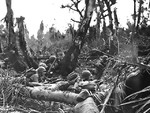 CLICK TO ENLARGERAY SHERMAN: As we landed Jap artillery was hammering the beach, exploding all along the front. About 50 yards inland we drove around gravel pits dug out to build the road airstrip. Past the pits we drove into a field surrounded by woods, and Lt. Wollin's tank and two others gave out. Our orders were to return to Battalion HQ if we lost our tanks. But mine was working and, having landed to the north of our landing site, I headed it south with Sgt. Michael's tank on a road parallel to the airstrip 3/4 of a mile in from the beach. Along there we ran into small groups of Japs, 3 to 5 individuals moving inland from beach into new firing positions. We were firing at them, and they at us. Sometimes they were up in trees, firing down into our open turrets. We used our 75mm to blow the tops off trees to kill snipers up there. We also blasted dug-in bamboo shelters the Japs were firing from. When Michael's tank quit we took his crew aboard ours, and kept going for another 50 yards before our clutch froze, dropping us into a huge shell hole made by a battleship main battery gun or a 500 lb. bomb. Sitting ducks then, we took our rifles, carbines, Tommy guns, and grenades and started on foot through the woods toward the beach. Bo Blanton who'd pulled his 30 cal. Machine gun off his tank was carrying it. In a small clearing a sniper held us up until we spotted him and picked him off. Where the woods ended halfway to the beach, there were shallow gravel pits again, stretching to the airstrip. Some Marine infantry had made it across the pits to the edge of the tree line on the far side. But Jap artillery had chopped their unit up so badly when trying to cross the pits, that most had scattered into small groups using the pits for trenches, just holding on until more troops could get inland to join them. One Lieutenant had half of one squad left. With a B.A.R., trying to clean out snipers in the trees around us, he said he didn’t know where his commanding officers were - whether they were dead or alive - that less than one company was left from his whole battalion.
CLICK TO ENLARGERAY SHERMAN: As we landed Jap artillery was hammering the beach, exploding all along the front. About 50 yards inland we drove around gravel pits dug out to build the road airstrip. Past the pits we drove into a field surrounded by woods, and Lt. Wollin's tank and two others gave out. Our orders were to return to Battalion HQ if we lost our tanks. But mine was working and, having landed to the north of our landing site, I headed it south with Sgt. Michael's tank on a road parallel to the airstrip 3/4 of a mile in from the beach. Along there we ran into small groups of Japs, 3 to 5 individuals moving inland from beach into new firing positions. We were firing at them, and they at us. Sometimes they were up in trees, firing down into our open turrets. We used our 75mm to blow the tops off trees to kill snipers up there. We also blasted dug-in bamboo shelters the Japs were firing from. When Michael's tank quit we took his crew aboard ours, and kept going for another 50 yards before our clutch froze, dropping us into a huge shell hole made by a battleship main battery gun or a 500 lb. bomb. Sitting ducks then, we took our rifles, carbines, Tommy guns, and grenades and started on foot through the woods toward the beach. Bo Blanton who'd pulled his 30 cal. Machine gun off his tank was carrying it. In a small clearing a sniper held us up until we spotted him and picked him off. Where the woods ended halfway to the beach, there were shallow gravel pits again, stretching to the airstrip. Some Marine infantry had made it across the pits to the edge of the tree line on the far side. But Jap artillery had chopped their unit up so badly when trying to cross the pits, that most had scattered into small groups using the pits for trenches, just holding on until more troops could get inland to join them. One Lieutenant had half of one squad left. With a B.A.R., trying to clean out snipers in the trees around us, he said he didn’t know where his commanding officers were - whether they were dead or alive - that less than one company was left from his whole battalion.
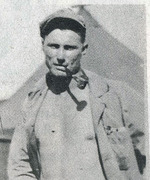 SILVER STAR Citation for RAY SHERMAN: For conspicious gallantry and intrepidity in action against the enemy on 15 June 1944 ... as leader of an armored amphibian section. Unsupported by infantry, Platoon Sgt. Sherman led his section one thousand yards beyond the front lines and by cool and capable direction caused his section repeatedly to deliver accurate and effective fire, destroying enemy machine gun nests, pillboxes, and troops and disorganizing enemy rear areas. During this action, the other armored amphibian of his section was disabled. He successfully evacuated the crew of the disabled vehicle while still continuing to deliver fire in the face of heavy enemy gun fire. His heroic action and conduct throughout were in keeping with the highest traditions of the United States Naval Service. Signed General Holland M. Smith
SILVER STAR Citation for RAY SHERMAN: For conspicious gallantry and intrepidity in action against the enemy on 15 June 1944 ... as leader of an armored amphibian section. Unsupported by infantry, Platoon Sgt. Sherman led his section one thousand yards beyond the front lines and by cool and capable direction caused his section repeatedly to deliver accurate and effective fire, destroying enemy machine gun nests, pillboxes, and troops and disorganizing enemy rear areas. During this action, the other armored amphibian of his section was disabled. He successfully evacuated the crew of the disabled vehicle while still continuing to deliver fire in the face of heavy enemy gun fire. His heroic action and conduct throughout were in keeping with the highest traditions of the United States Naval Service. Signed General Holland M. Smith
REED FAWELL - BATTALION - Our NCOs, the Battalion's backbone, trained for a battlefield that required cool thinking, agressive action, and individual initiative, performed admirably.
BRONZE STAR Citation for CARROL BLANTON: For distinguishing himself conspicuously by gallanty and fortitude in action against the enemy 15 June 1944. While receiving heavy enemy artillery fire, the armored amphibian in which he was the radio operator was hit. Everyone in the crew abandoned the vehicle, except the driver who was unconscious. Realizing the driver was still in the vehicle, he immediately returned to it amidst sniper and heavy artillery fire with utter disregard for his own personal safety and dragged the unconsious man two hundred yards to cover where he remained with him for two hours until he was revived. He further assisted the wounded man's safe return to the beach. His courage and self sacrifice represents the highest traditions of the United States Naval Service.
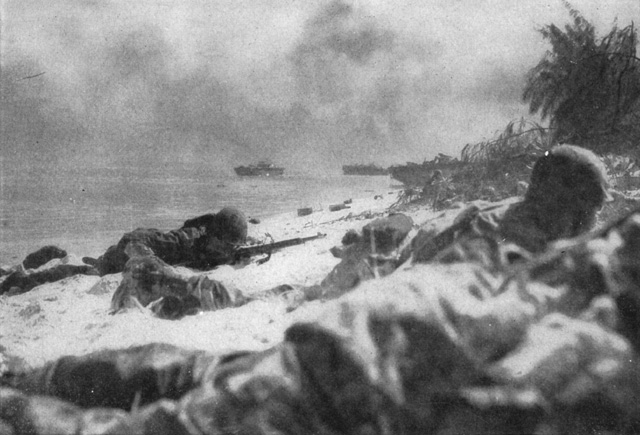 Art L. HOMES' INTODUCTION TO SAIPAN'S GREEM BEACH 1
Art L. HOMES' INTODUCTION TO SAIPAN'S GREEM BEACH 1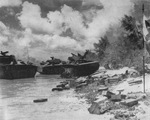 CLICK TO ENLARGE
CLICK TO ENLARGE
ART L. HOMES: I landed in the middle of the afternoon with my radio gear along with our maintenance crew and their gear, and had to hit the deck and scratch deep for cover against incoming shells. Hot shrapnel was hitting within reach of my head. One shell blew a water purification unit next to us to pieces. That was my introduction to Saipan.
S. A. BALSANO: That June 15 was some day for sure. Two officers, a Gunny Sergeant, three Sergeants, two Corporals, two Private First Classes, and three Privates were killed in our Company alone. Hot as hades, it was our worse day in battle.
During the first hours of the assault, all four Infantry Battalion Commanders on Red and Green Beaches were wounded. The 6th Marines Regimental Command Post was nearly overrun at 0100. On the right flank, when its 3rd Battalion lost momentum, Col. Riseley, CO, 6th Marines, ordered his Regiment's Reserve Battalion ashore.
This unit was the 1st Battalion, 6th Marines, commanded by LT. COL. WILLIAM JONES. He describes his relief of the 3rd Battalion: Jap mortar and artillery fire registered on the reef knocked hell out of our formation (coming in), and (my) Companies became widely separated. Instead of landing on Red Beach 2 as ordered, we landed C Company on Red 1, A Company on Red 2, and B Company on Red 3 ... In fact the Battalion had over 100 casualities before reaching the beach and loses of equipment due to men swimming in from wrecked amtracs were terrific. This equipment was replaced by equipment no longer needed by the dead boys who had preceded us ... (and since) we had orders to pass through the 3rd Battalion immediately, to give them a chance to reorganize ... (I pretended my orderly) was my lost B Company, and praying the Nips wouldn't hit my open left flank, I tacked my left flank onto the 2rd Battalion and started a swinging gate movement to the left with 2 Companies ... and we deepened the beachead 700 yards before Captain Golding was killed. 11/
Heavy flanking fire across the wide open Green Beaches 2 and 3 south to Afetna Point threatened the 8th Marines whose north flank across Red Beach 3 was also open. Col. Wallace, its Regimental CO, called his reserve Battalion onto Green Beach 2. The 2nd Marine Division also threw its last reserve Battalion into the battle. War correspondent ROBERT SHERROD describes this relief effort that included Brig. General Merritt A. (Red Mike) Edson:
 Click to Enlarge pAt eleven the Second Division's "spare battalion" - 1st Battalion, 29th Marines - was ordered to land on Green Beach 2 ... At noon, just after (we received) a report of heavy mortar and artillery fire throughtout Red and Green Beach Area, General Edson asked via radio the Division Commander's permission to land. It was 1430 when the amtracs crunched ashore ... Whether we should ever leave there alive was in considerable doubt for the rest of the day and night. A artillery or mortar shell ... landed near us every three seconds for the next twenty minutes. 12/
Click to Enlarge pAt eleven the Second Division's "spare battalion" - 1st Battalion, 29th Marines - was ordered to land on Green Beach 2 ... At noon, just after (we received) a report of heavy mortar and artillery fire throughtout Red and Green Beach Area, General Edson asked via radio the Division Commander's permission to land. It was 1430 when the amtracs crunched ashore ... Whether we should ever leave there alive was in considerable doubt for the rest of the day and night. A artillery or mortar shell ... landed near us every three seconds for the next twenty minutes. 12/
Saipan's most critical phase suddenly became the brawl for its beachhead: America's struggle to seize, hold and secure an area ashore sufficient to collect and sustain the forces necesary to punch inland then wheel north and conquer the island. Murphy's Law ruled the landing beaches. Strong offshore currents unexpectedly combined with an unanticipated berm just behind those beaches to trap the Marines on narrow beaches under murderous artillery, mortar and machine gun fire. Currents carried the southern most landing craft north into the center of the line and carried the northern most landing craft further north into the teeth of Garapan's heavy defenses. This left Marine flanks wide open at both ends and within the center of their attack. Meanwhile the attacking Marines jammed up against a nearly impassable berm just behind the beaches. The day long pile-ups of landing Marines compounded the chaos. US naval shelling had failed to neutralize artillery and mortal fire from inland and both flanks. This fire hit Marines coming into the beach and kept hitting them on the beach all day as Japs infantry ashore attacked their exposed flanks. Critical supplies and reinforcement, unable to get ashore until well into the 2nd day, compounded the challenge facing the Marines. Saipan's two stage battle plan broke violently into three parts. The battle for a secure beachhead lasted 5 days and the push beyond it required three divisions. See 13 & 13B for naval gunfire details.
D-DAY: 2ND ARMORED AMPHIBIAN BATTALION after INITIAL LANDING 15 JUNE 1944:
CHARLES H. ORLOSKI - COMPANY B: When Nip land tanks laid into us, we lost our left track, bailed out, got back to the beach and dug in.
JAMES H. MOORE - COMPANY A: That first morning on Saipan our tank had gotten mired down in a Jap tank trap. We received orders over the radio to leave the tank and get back to the beach and take over a tank there that had been hit but was still operable. We got back to the beach and found GUNNY SGT. CLARRON T. MILLER walking up and down the beach road even though there was heavy mortar fire coming down on us plus a lot of Jap artillery fire coming our way. I was sure Gunny would be killed at any moment but I don't think he got a nick. He got into the tank with us and was preparing to have us pull out and go up north toward Garapan. I think we are alive today because that order was countermanded by someone higher up. JOHN EINARSON: GUNNY MILLER was fearless in battle.
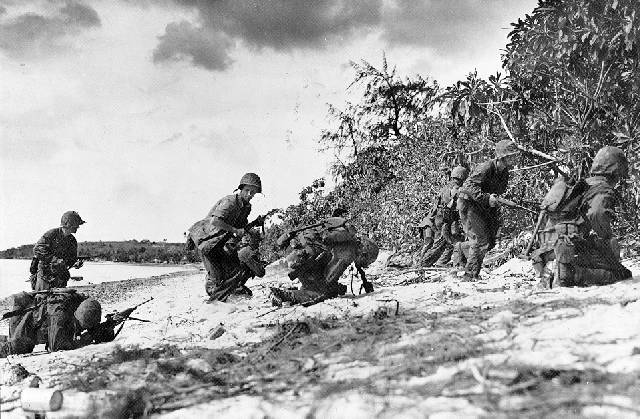 D-DAY GREEN BEACH 1RICHARD G. PEDERSON - COMPANY C: With our amtank disabled 150 to 200 yards inland, Jap fire zeroed in. I leapt out, hit the deck, and rolled into a depression with four or five other Marines. It was awfully hot. I tried crawling out for water but a Jap tank fired its machine guns at us. Moving closer, to about 50 yards off, it opened up its 37 mm canon. We threw grenades at the beast then ran, passing dead japs. There was nowhere to go really. The beach too was under heavy artillery and mortar fire. The first dead Marine I saw was from my own Company. Soon there were dead and dying Marines wherever I went.
D-DAY GREEN BEACH 1RICHARD G. PEDERSON - COMPANY C: With our amtank disabled 150 to 200 yards inland, Jap fire zeroed in. I leapt out, hit the deck, and rolled into a depression with four or five other Marines. It was awfully hot. I tried crawling out for water but a Jap tank fired its machine guns at us. Moving closer, to about 50 yards off, it opened up its 37 mm canon. We threw grenades at the beast then ran, passing dead japs. There was nowhere to go really. The beach too was under heavy artillery and mortar fire. The first dead Marine I saw was from my own Company. Soon there were dead and dying Marines wherever I went.
VERNON C. LOWE - COMPANY C: Across the airstrip road we left the infantry behind on the beach. All alone there we got stuck on a stumb. The Japs were bracketing us with shells landing all around when the order came to bail out. I leapt through the radio man's hatch and started for the beach. Bullets zipped by. I hit the deck, pinned down by a sniper. Bullets kicking dirt over my helmet abruptly stopped. I looked up. The sniper dangled from a tree, a bullet hole killed him, one between his eyes. Some good Marine saved my life for sure. I ran for the beach. Japs were all over, moving back into new positions. I ran a foot race back and forth, hoping to outrun or outsmart exploding shells, then came across Al Caldwell mortally wounded. He'd come home with me and met my family before going overseas. I stayed with him until he died.
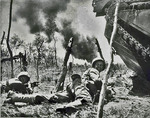 Click to EnlargeJERRY BROOKS - COMPANY C: As our amtank gets obliterated I hit deck and when all the shooting stops the Japs disappear. I can't see anybody, not even my crew. Suddenly it dawns that I'm all alone. Slowly going north with airstrip road inland on my left, I head toward Garapan, searching for friendly faces, thinking I'm going to where we should have landed. I find a Marine infantryman. He's lost his squad, an orphan like myself, we dig a hole. Its fiercely hot. l see dead Marines around us and crouch there worried, looking out, we're being isolated, cut off, could run out of ammo. Sand jams my carbine. There was never any thought of being captured. It simply was not going to happen. No Marine was going to give himself up to be tortured, and no Marine was going to waste a bullet that could kill another Jap. I remember thinking that at the time. I crawl out of my hole and collect stuff off dead Marines. An M-1 rifle, two bandoliers of ammo, two canteens full of water, little morphine needle capsules, and sulfa packets, precious stuff we need to kill more Japs and save ourselves, doing it. To carry it all I need my gas mask's container so I toss my mask, an awkward thing anyway, and fill its container with the extra ammo magazines, capsules and packets. Thankfully, armed at last with an M-1 that can stop a Jap in his tracks, I'm set to move again. Me and my buddy start off, going north gradually, carefully, alert, still searching for friendly and familiar faces. Maybe we're a mile south of Garapan when we dig in again just off the beach. Still between the shoreline and airstrip road, the water is some 20 yards away, the airstrip road maybe 30 yards inland from us, we settle in. Up there it got wild quick, and it stayed wild for days, wild.
Click to EnlargeJERRY BROOKS - COMPANY C: As our amtank gets obliterated I hit deck and when all the shooting stops the Japs disappear. I can't see anybody, not even my crew. Suddenly it dawns that I'm all alone. Slowly going north with airstrip road inland on my left, I head toward Garapan, searching for friendly faces, thinking I'm going to where we should have landed. I find a Marine infantryman. He's lost his squad, an orphan like myself, we dig a hole. Its fiercely hot. l see dead Marines around us and crouch there worried, looking out, we're being isolated, cut off, could run out of ammo. Sand jams my carbine. There was never any thought of being captured. It simply was not going to happen. No Marine was going to give himself up to be tortured, and no Marine was going to waste a bullet that could kill another Jap. I remember thinking that at the time. I crawl out of my hole and collect stuff off dead Marines. An M-1 rifle, two bandoliers of ammo, two canteens full of water, little morphine needle capsules, and sulfa packets, precious stuff we need to kill more Japs and save ourselves, doing it. To carry it all I need my gas mask's container so I toss my mask, an awkward thing anyway, and fill its container with the extra ammo magazines, capsules and packets. Thankfully, armed at last with an M-1 that can stop a Jap in his tracks, I'm set to move again. Me and my buddy start off, going north gradually, carefully, alert, still searching for friendly and familiar faces. Maybe we're a mile south of Garapan when we dig in again just off the beach. Still between the shoreline and airstrip road, the water is some 20 yards away, the airstrip road maybe 30 yards inland from us, we settle in. Up there it got wild quick, and it stayed wild for days, wild.
PAUL A. HIRSHBRUNNER - Company C: Our battle plan was to hit the beach at a certain location, knock out the gun implacements and kill the Japs opposing us there then head inland killing Japs and destroying defenses until we got to a narrow gauge railroad tracks then stay put until the infantry arrived and after that support their advance inland if any such infantry push was possible. Two of our platoon's tanks made it to the railroad tracks, but the infantry never arrived. So we remained alone out in Indian Country all day and first night, waiting for them.
RICHARD W. MASON - Company C: We also got to the railroad tracks (the 0-1 line) but the infantry never caught up to us. We were out there alone until another amtank arrived. But it got hung up. We hooked onto it and tried to pull it loose, but our clutch froze. The Japs began to zero in, bracketing us with explosions. That 1st day a disabled Amtank as the fattest target for Jap artillery and mortars up high scanning the battlefield for big targets within clear lines of fire, became a deathtrap quick. So we bailed at least temporarily. Bill Bishop lay out on the ground exhausted in the awful heat and humidity, close to 100 degrees. Bill Barns hit by shrapnel in the shin could hardly walk until he saw a Jap tank. Then he outran me back to the railroad tracks.
HAROLD B. LITZ, JR - COMPANY C: Getting Van Bebber to the beach with his shoulder blown off was hard duty. Weaker by the minute he passed out. I dumped him over my shoulder and kept going. Finally we got back but air bursts rolled up the beach, exploding over Marines trying to outrun them, getting hit anyway. Van Bebber wanted my 45 for protection before I left to find him an Amtrac. I left him my 45. When I returned with the amtrac, he gave my 45 back but wanted my knife, so I gave to it him. When the Amtrac pulled out for the hospital ship, it was last I heard or or saw Van Bebber. The Corpsmen were busy all day. I got wounded in the eye.
ROBERT W. URBATSCH - COMPANY C: After Rodweller's tank took that Jap 37 round that killed Alvin Calwell right next to me, I grabbed a light machine gun and my Ammo Passer took its tripod, and we worked our way through Jap infantry moving back off the beach. At the beach I found my friend Lloyd Burton against a tree, his hand frozen around a Jap bayonet. He'd been returning to the beach when a Jap swinging the bayonet jumped him. Lloyd yanked the bayonet away, slicing open his own hand before he drove its blade through the Jap, killing him before Lloyd's behind caught a hunk of flying shrapnel that took a 4 inch round slice off his backside. Still he'd somehow managed to get to the beach and there, I learned how hard it is keeping a bandage on a Marine's backside in a battle, can't be done, impossible.
HARLAND T. ROSVOLD - COMPANY C: Hit bad on the airstrip road our tank sat like a ball on a pool table. People were taking free shots at us, we couldn't fire back, and there was no friendly infantry nearby. We headed back toward the beach per instructions if our tank got disabled. I ran into our Company CO Major Bevans and others from Company C amid lots of incoming fire all along the beach and much confusion. We'd landed north of our assigned beaches, onto a beach quicky jamming up with troops and gear coming ashore amid incoming fire without let up. As we were assigned to Lt. Col. Crowe's Infantry Battalion, Major Bevans sent me to find him and get intructions. I headed south down the beach. Shells were hitting fast and furious into chaos. No one knew where Col. Crowe was or his Battalion CP either. Finally I found him laying out on the beach badly wounded. All he could say was Carry On.
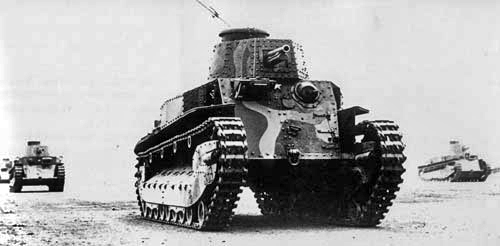 JERRY BROOKS: We felt lonely up north: most all the 2nd Marine Division was out of sight down south when engines scream like 1000 Jap tanks are coming down from Garapan just to get us teenagers. Stuck in a hole we got nothing to stop tanks - no bazooka, anti-tank gun, rifle grenade, or B.A.R. or 50 Cal. machine gun. I think We've had it. VERNON C. LOWE: Hearing the racket, I dig a hole under a shrub. An infantryman comes by looking for a bazooka but I see no bazooka, only dead and wounded Marines. JERRY BROOKS: Never would I be so scared in battle. Then 50 yards to my left two Marines jump up and run across the airstrip road, headed for one of our amtanks tilted up behind some bushes, missing a track. 2nd Armored Marines, climbing aboard, up into its turret, then somehow crank its 75mm barrel to the left, lower its muzzle then fire a half dozen rounds hitting the Jap tanks in quick succession stopping them all as Japs scatter, their loose shirts flapping as they got hit, the rest melting into the trees. Suddenly it dawns on me: all that racket came only from three tanks.
JERRY BROOKS: We felt lonely up north: most all the 2nd Marine Division was out of sight down south when engines scream like 1000 Jap tanks are coming down from Garapan just to get us teenagers. Stuck in a hole we got nothing to stop tanks - no bazooka, anti-tank gun, rifle grenade, or B.A.R. or 50 Cal. machine gun. I think We've had it. VERNON C. LOWE: Hearing the racket, I dig a hole under a shrub. An infantryman comes by looking for a bazooka but I see no bazooka, only dead and wounded Marines. JERRY BROOKS: Never would I be so scared in battle. Then 50 yards to my left two Marines jump up and run across the airstrip road, headed for one of our amtanks tilted up behind some bushes, missing a track. 2nd Armored Marines, climbing aboard, up into its turret, then somehow crank its 75mm barrel to the left, lower its muzzle then fire a half dozen rounds hitting the Jap tanks in quick succession stopping them all as Japs scatter, their loose shirts flapping as they got hit, the rest melting into the trees. Suddenly it dawns on me: all that racket came only from three tanks.
MARSHALL E. HARRIS - Company C mostly landed on Green 1 as planned but our amtank landed north of the Radio tower on Red 1. Our drift on offshore currents likely was magnified when we turned away from the beach before Pappy Outen straightened out our driver. Ashore after McDaniel's and I took out the Jap bunker, Pappy told me to drive our amtank down the beach then pointed "Past that burning amtrac turn inland, you'll see our guys waiting for you." As radio man & bow machine gunner I was the assistant driver and did as Pappy said.
 p
p
 BURIAL AT SEA OFF SAIPADriving the amtank I discover I'm alone. I don't remember shifting the damn thing, just going full throttle down the beach, swinging out into the water past the burning amtrac then back onto the beach. An nearby explosion rattled me then I saw 2rd armored guys running out onto the beach, waving me inland.
BURIAL AT SEA OFF SAIPADriving the amtank I discover I'm alone. I don't remember shifting the damn thing, just going full throttle down the beach, swinging out into the water past the burning amtrac then back onto the beach. An nearby explosion rattled me then I saw 2rd armored guys running out onto the beach, waving me inland.
Where you hit? one asked as I climbed out. Corpsman! another yelled.
Hit? I didn't feel it, just adrenalin. Your shirt, he said.
It was soaked in blood. I'd split my lip, jamming it up into the Periscope's end hanging from the driver's cab's roof.
KENNETH E. SMITH - COMPANY D: Jack Whitis bucked us out of the hole and kept going till we hit another. Unable to move we bailed and got separated. I help an infantryman blow up two pillboxes then run to the beach to find my own people. Coming through trees I think I see a Jap but it's Gunny Roberts with a big hole in his back. I help him to a foxhole where Lt. Wollin shares his stateside booze, clearing out our heads, then we dash out, looking for safer ground as two shells hit where we'd just been. I keep trying to stay ahead of arty blasts stepping down the beach before Zimmerman and I dig in behind a bush. Explosions hit around us. I look at Zimmerman but he's gone (killed).
JACK WHITIS - After we bail, gunner Ken Smith and I go with the infantry then get separated. I go for the beach but a sniper pins me down. My carbine jams, things get dicey. I scramble away, dive into a hole with a dead Marine and spent the night with the corpse, me working my jammed carbine, trying to fix it, tearing it apart in my lap, praying I wouldn't lose parts in the sand and that Japs wouldn't find me. At dawn I scamper out, grap the first M-1 rifle I see, a far more reliable and effective weapon, and find guys from my platoon along the beach. I'm shocked to learn that I'd been killed in action.
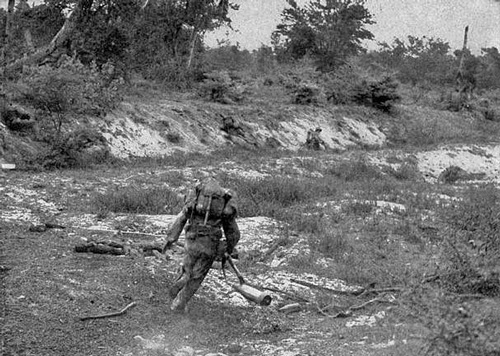 BENJAMIN R. LIVESEY - COMPANY D: After our howitzer in Dicken's tank jams and our ammo runs out (but for star shells), we bail. Getting to the beach is tricky, we weave, bob and crawl through explosions and Japs all around. But we went back that same first day or the next and retrieved our tanks.
BENJAMIN R. LIVESEY - COMPANY D: After our howitzer in Dicken's tank jams and our ammo runs out (but for star shells), we bail. Getting to the beach is tricky, we weave, bob and crawl through explosions and Japs all around. But we went back that same first day or the next and retrieved our tanks.
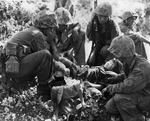 Click to EnlargeG. MILTON SHIRLEY: Us knocking out the 3 Jap tanks got their attention. We barely got away. Shrapnel knocked Dickens down. Moving back across the airstrip road we found a boy with a hole in his stomach. His friend asked for help. I slung my rifle, we made a pack saddle, and carried the boy across a field into the shade of some trees. We didn't want our amtank left way out there alone, loaded, in running condition for the Japs. Donald Speck and I went back inland and drove it to the beach late that afternoon.
Click to EnlargeG. MILTON SHIRLEY: Us knocking out the 3 Jap tanks got their attention. We barely got away. Shrapnel knocked Dickens down. Moving back across the airstrip road we found a boy with a hole in his stomach. His friend asked for help. I slung my rifle, we made a pack saddle, and carried the boy across a field into the shade of some trees. We didn't want our amtank left way out there alone, loaded, in running condition for the Japs. Donald Speck and I went back inland and drove it to the beach late that afternoon.
RAY SHERMAN - COMPANY D: We left the Infantry Lieutenant trying to clean out snipers with his BAR and moved back across the pits and airstrip road. I found Lt. Wollin in a fringe of trees along the beach. It was as bad or worse there. Jap arty opened up on every LVT wave coming onto the beach, filling the trees with airburst shrapnel. Our Battalion Exec. Major Williamson came up looking for a usable amtank to take out an observer up in the chimney over in Charan-Kanoa town in the 4th Division area. Aftetna Point, between us and that chimney, was loaded with Japs and 37mm and 47mm anti-tank and anti-boat guns, though we didn't know it. But by then none of our amtanks could move or fire. An amtrac wave came in and Jap artillery took out 9 or 10 Marines on the beach. Shrapnel ripped into my hand. Amtracs unloaded troops without even stopping.
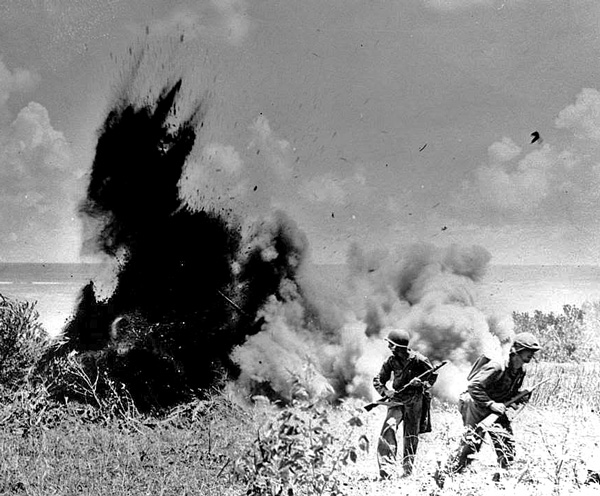
RICHARD W. MASON - COMPANY C: A blast torn up my rump as 'Eel' Evans and I crossed the airstrip road. We dug under a breadfruit tree amid heavy artillery clipping off tree tops dropping breadfruit nuts big as grenades.
KEITH NEAL - COMPANY C: My biggest headache was trying to keep the Little Joe back up generator up and running. Otherwise the amtank's battery lost its charge then our engine's starter and radio failed.
CHARLES F. AMBROSE - COMPANY D: Shrapel drilled me. Corpsman Jim Guest had a field day, tweezering metal out of my leg and butt. It still puzzles me how amid all that mass confusion we kept our unit cohesion. How? It still puzzles me. My deepest appreciation goes to Col. Fawell, what he'd done for us in so little time.
ROBERT WOLLIN: Arty harrasses us going to the beach. Down to two or three of our original tank crew, one is Gordon Nulty, another, Raymond Guild, gets hit on the way back, we bandage him and keep going. Gunny Roberts and Arnold DeWald joins us and tells me about Capt. Handyside then we find an infantryman looking after two shelled shocked Marines who, hiding in a hole, want to go to The Zoo. Their protector, seeing I'm an officer, ask if I'll take his friends to the beach for evacuation. If they'd give us their weapons, I say. They disarm, their guardian goes off to fight the war and we take his friends. The woods along the beach are pocked with shell holes, trenches between Jap pillboxes and gun emplacements. Japanese and Marine bodies lay sprawled everywhere. Explosions rock the place. We dive in a shell hole and peer out, alert for snipers. Artillery on high ground far inland pulverizes the beach as amtracs approach. We don't want them bringing death our way, so try waving them off. It doesn't work. Distant guns rain explosions on us just as they please all day long.
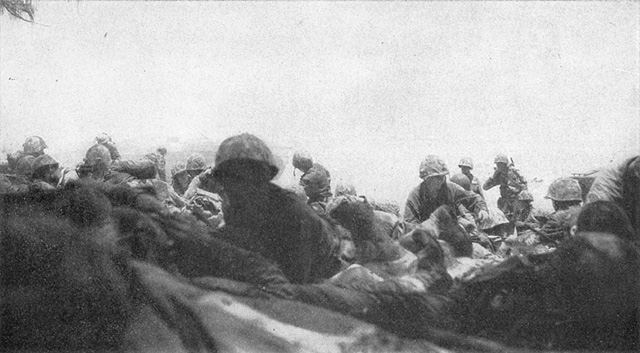 Gunny Roberts who's got a headache from too tight earphones in his gunners helmet runs to get a new one off a dead Marine in a nearby hole. A blast sends 4 by 6 inch shrapnel into his shoulder blade and sends him back, asking could I help, his arm is numb? I grab the hot metal, badly burn my hand that I wrap in a rag but still can't pull the shard out so try wriggling it loose as Gunny hollers. It doesn't work so I get him into a departing Amtrac then dive into a small crater as two Marines piled in on top. One saves my life. I'm on my side curled into a ball when his flying leap lands in front of my face as shrapnel comes through his shoulder. Its point ends up an inch from my nose. 15 June 1944 I'll remember always.
Gunny Roberts who's got a headache from too tight earphones in his gunners helmet runs to get a new one off a dead Marine in a nearby hole. A blast sends 4 by 6 inch shrapnel into his shoulder blade and sends him back, asking could I help, his arm is numb? I grab the hot metal, badly burn my hand that I wrap in a rag but still can't pull the shard out so try wriggling it loose as Gunny hollers. It doesn't work so I get him into a departing Amtrac then dive into a small crater as two Marines piled in on top. One saves my life. I'm on my side curled into a ball when his flying leap lands in front of my face as shrapnel comes through his shoulder. Its point ends up an inch from my nose. 15 June 1944 I'll remember always.
WILLIAM HOOVER - COMPANY D: At the air strip road our Tank Commander Sgt. Wallace Johnson spotted a amtank stuck in a tank trap, and trying to pull it out, our clutch burned up, and our tank got hit. On open ground, trying to get back to beach under heavy artillery and mortar fire, I dove into a huge shell hole some 7 feet deep and maybe six feet across occupied by four Marines hunkered down. Two Jap tanks came clanking up. One tried but could couldn't lower its 37mm canon enough to fire into our hole. Four rounds sailed overhead. When both tanks clanked off, we ran like hell.
RAY SHERMAN - COMPANY D: Shrapnel air bursts hit 9 or 10 of our crewmen (including myself) on the beach, Corpsmen bandaged us up, got stretchers for the five that couldn't walk, and told us the wounded were being moved off the beach due to all the artillery fire, and where to get aboard an amtrac that'd take us out to ships offshore. I was waiting for a amtrac when a Jap crawled out of a hole under a tree I was leaning on. He put his hands up, standing there naked to the waist, trying to surrender before someone shot him. We sent him to Battalion Headquarters. The arriving amtrac hardly stopped with infantry jumping out over the sides as we barely managed to get our wounded aboard. The drivers would not spend one second longer on the beach if they could help it.
NORMAN B. SLOWE - COMPANY C: Around noon our amtank sank to its belly and spun its tracks in Lake Susupe, a swamp behind Green Beach 2. Japs were everywhere but we decided to stay put. We couldn't move but were under some cover, making it hard for the Japs to see us, and our tank's weapons still worked. We stayed all night isolated behind enemy lines. No other Marines were nearby. Next morning two amtanks came by and pulled us out. Small groups of Japs operated in the swamp, spooking about, causing trouble for the next week.
HARLAND T. ROSVOLD - COMPANY C: After I found Col. Crowe badly wounded on the beach I finally got back to Major Bevans who assigned me to Lt. Hirsbrunner's amtank. He needed a crew replacement for their amtank set up on the beach to counter a seaborne or beach attack during the night.
VERNON C. LOWE: Mortar explosions moved methodically up and down the beach. They started north of Charan-Kanoa moving north through us the on toward Garapan. South of Garapan, the explosions reversed direction, coming back down the beach toward us and then thought us again, all fired from a distance, raining down on us, blowing us apart.
JERRY D. BROOKS: Up north that afternoon I found a cardboard box with 12 Jap grenades. Unlike our serrated ones with handles you pulled to arm the explosive, these were smooth steel cylinders without handles. I didn't have the foggiest notion how to arm them so, carrying them back to our hole, I stopped alongside a Marine sitting on a tree stump on the beach. With his rifle across his lap he stared out to sea. I asked him how the Jap grenades worked. But he ignored me, and I was asking him again when I saw a little bullet hole in his forehead, no blood, just a hole. His eyes were wide open, blue staring out at the sea. I'd only turned 18 a few months before but he looked 16, dead. Earlier that day I'd seen a lot of dead Marines. I'd see many more later. But this young marine sitting on that Saipan beach all alone is the Marine that I'll always remember.
 SAYING GOODBY (click to enlarge)HAROLD B. LITZ, JR. - COMPANY C: I kept looking at the casualty reports coming in. We were family. Everyone gone left a wound in the rest of us.
SAYING GOODBY (click to enlarge)HAROLD B. LITZ, JR. - COMPANY C: I kept looking at the casualty reports coming in. We were family. Everyone gone left a wound in the rest of us.
THAT MORNING 400 MEN FROM THE 2ND ARMORED AMPHIBIAN BATTALION CAME ASHORE IN THE FIRST WAVE ONTO THE BEACHES OF SAIPAN. DURING THE NEXT TWELVE HOURS, 135 OF THOSE 400 MEN WOULD BE KILLED OR WOUNDED IN BATTLE. NOTE: For Casualities of 2nd Platoon, D Company: See Website Roll Call Section.
 BUT HE IS ALWAYS WITH US
BUT HE IS ALWAYS WITH US
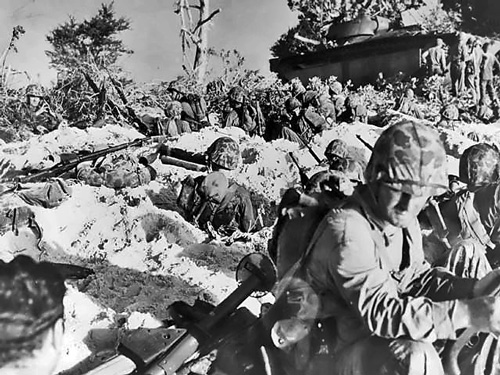
JAMES R. MCCARTER - COMPANY D: Col. Fawell gave the word to dig in along the beach and guard against enemy attacks from the north or from the reef.
JOHN EINARSON - COMPANY A: After our tank was blown up, I got to the beach and worked as a runner for Col. Fawell and Major Williamson who were operating from a make shift Command Post on Green Beach I. In the Colonel’s bunker near the beach just seaward from the Jap radio station behind Green Beach 1 he was trying his best to keep up with what was going on with all our Companies and the Regimental Combat Teams they were assigned to assist. But our radio and wire communications were spotty. That’s why we used Runners so much. Carrying his messages I ran several to Col. Shoup, 2nd Division Chief of Staff and Lt. Col. Barney Oldfield, artillery CO.
JAMES D. MACKEY - COMPANY C: I kept trying to repair our communication wires. With all hell pouring down it was like trying to hold water in a sieve.
CHARLES F. AMBROSE: Lt. Wollin set up our perimeter defense that first night. JACK BOUVY- COMPANY C - Late the 1st day along the beach, checking my radio operators and their TCS radios, I got lost, caught out in the dark far from HQ so scooped out a hole for the night amid gunfire and confusion.
JERRY D. BROOKS: The Japs had every square yard of beach zeroed in so likely thought that Marine artillery or tanks couldn't get ashore the first day. They were wrong. Before sundown, still in our hole, I heard the sweet sound of our artillery blasting away down south near CHARAN-KANOA and Marine Shermans came clanking up the airstrip road towards us - those beauties were a sight to behold. Three or four clanked by us, rumbled on for several hundred yards toward Grarapan then stopped.
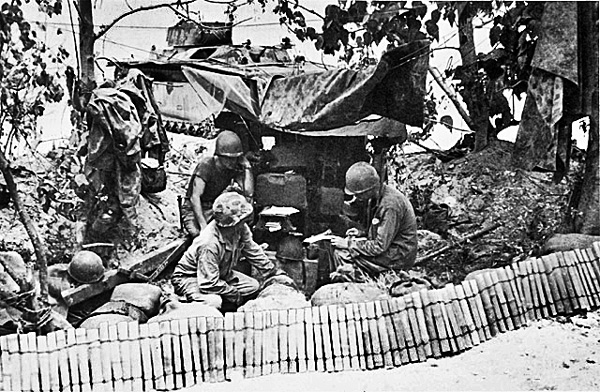
Minutes later a short tanned Marine came walking toward us, looking around, headed south. I should have known better but figured he was Navaho Windtalker. He'd gone 50 yards past us toward Charan-Kanoa when shots rang out. Marines had challenged then killed him going for his weapon. A Jap scout in Marine dungarees, he'd been gathering intel on our positions for the Jap attack that night. Those Shermans, key to stopping that night's Jap attack, had loaded for bear.
Note: By nightfall 20,000 Marines are ashore. 70 2nd armored amtanks lay across a battlefield 2 miles long and 1500 yards deep. Only 13 are operable. Enemy fire disabled 33. Anti-tank disabled 12. Arty, anti-boat or mortar fire disabled 12 more. Small arms fire (50 Caliber or less) stopped 5. Land mines knocked out 3. An anti-boat mine stopped one. Obstacles immobilized 16. Mechanical breakdown permanently halted 8 others, 7 by burnt out clutch, 1 with engine failure. Overheated clutches stopped 20 amtanks for up to an hour. 14/ The Japs hadn't finished. Its 31st Army radioed Tokyo on D-day afternoon: The army this evening will make a night attack with all its forces and expects to annihilate all enemy at one swoop. The Jap Regiment held up north by the US D-Day feint landing off TANAPAG Harbor now head south that night down the Garapan Road. 2000 Infantry and 22 tanks hit the 2nd Marine Division's far left flank and shatter when met buy the 6th Marines, 2nd Armored and Marine Shermans that held the line 15/ Another enemy thrust attacked from the east, driving the center of the Division's line there back 400 yards. 16/
JERRY D. BROOKS: The Japs knew we were there to stay unless they drove us into the sea quickly so their tanks and infantry came at us for the next three nights. The first night they came under our flares and star shells that lit the scene bright as day so caught them clanking down the airstrip road, Japs riding tanks, others running between tanks, bugles blowing. Note: Many enemy soldiers earlier bypassed by the Marines now also came out of the woodwork, going at the Marines from all directions, adding to the lethal chaos. HARLAN ROVOLD - COMPANY C: There was a lot of firing that first night. The password was "Philadelphia," the Japs had trouble pronouncing it. HAROLD B. LITZ - Dug in behind an Ironwood tree 4 inches in diameter, I felt safe as if behind armor plate. JERRY D. BROOKS: If you're out there like that and it moves out in the dark, shoot it.
JAMES A. (Al) SCARPO - COMPANY D: It was hot that first night up north. They moved out of Garapan, coming towards us. All hell broke loose. Japs got in among us. We fought them under starshell bursts. Dug in, I had my M-1 rifle and 45 Cal. automatic. Russell Albright had his Thompson submachine gun. At dawn we discovered we were too far north, so headed south to join our main body. Albright going first drew fire from a nearby Jap. When his submachine gun jammed, he took off with me right behind, bullets kicking up around us.
JERRY D. BROOKS: At one point in that hole I was so positive I'd get knocked off before dawn I envisioned Mom getting the government notice and promptly fading away ... I wasn’t afraid, I don’t know why, being so sure I'd die. Finally, Lou’s rifle didn't work, nor did mine. When incoming shells smother you, your hole, and weapon with sand until your rifle is only usable only as a ball bat, you tell yourself a lot of things and I recall thinking that more than one marine had secured a nip or two that way, swinging his rifle, killing japs that way. Plus we had a batch of hand grenades, ours and Nip ones, plus we had two combat knifes and a mightly sharp Nip bayonet, so we had a lot of potential power left anyway. But even then I knew that a guy can’t get them all when they come all at once like flies. Several attacks came that night but never got us. But if the Japs had thrown all their strength at us in one rush, why J. B. wouldn’t be writing this today Dad. (from 1945 letter written to his father the day Japan surrendered.)
Note. That night Japanese attackers when broken would leave more than 700 dead behind on the battlefield.
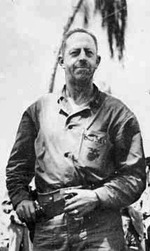 Gen. 'Red Mike' EdsonROBERT E. WOLIN -COMPANY D: We didn't get any sleep. Enemy counter attacks and infiltration along with incoming artillery and mortar came fire all night. Just to be alive at sunrise that 2nd morning was one of the great experiences of my life. It's all hazy in my memory - not wanting to move at dawn from the bottom of my shell hole with Dewald and Nulty, fearful that all hell would rain down if I did - but I vividly recall watching the approach of a high ranking officer carrying a swagger stick under his arm. He walked through the trees all by himself. He stopped, wanted to know our unit and who was in charge? I identified myself, and he said we were out of position and "suggested" that we move 100 or 200 yards south, collecting men as we went. After all, Lt., he said, you don't want to live forever. My fear melted away, and what's what we did. Almost every man I have ever talked to about War will admit that at some critical time someone or something moved them through a barrier of fear to do what they'd been trained to do. (Note: This high ranking officer surely was General Merritt 'Red Mike' Edson. Known for roving battlefield hot spots, he'd offer advice from his long combat experience to all. See ROBERT SHERROD's comment above)
Gen. 'Red Mike' EdsonROBERT E. WOLIN -COMPANY D: We didn't get any sleep. Enemy counter attacks and infiltration along with incoming artillery and mortar came fire all night. Just to be alive at sunrise that 2nd morning was one of the great experiences of my life. It's all hazy in my memory - not wanting to move at dawn from the bottom of my shell hole with Dewald and Nulty, fearful that all hell would rain down if I did - but I vividly recall watching the approach of a high ranking officer carrying a swagger stick under his arm. He walked through the trees all by himself. He stopped, wanted to know our unit and who was in charge? I identified myself, and he said we were out of position and "suggested" that we move 100 or 200 yards south, collecting men as we went. After all, Lt., he said, you don't want to live forever. My fear melted away, and what's what we did. Almost every man I have ever talked to about War will admit that at some critical time someone or something moved them through a barrier of fear to do what they'd been trained to do. (Note: This high ranking officer surely was General Merritt 'Red Mike' Edson. Known for roving battlefield hot spots, he'd offer advice from his long combat experience to all. See ROBERT SHERROD's comment above)
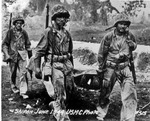 Click to Enlarge JOHN EINARSON - COMPANY A: At 0300 the morning of Day 2, Gunny Miller rounded up the Company A people who'd lost their Amtanks to serve as stretcher bearers for Marines wounded in that first night's Jap counterattack. We headed north towards Garapan. It was getting light as we made our second trip back to the beach, carrying the wounded to the aid station there. CHARLES H. ORLOSKI - COMPANY B: Later that day we retrieved our amtank. ART L. HOLMES - COMPANY D: By then very few still ran.
Click to Enlarge JOHN EINARSON - COMPANY A: At 0300 the morning of Day 2, Gunny Miller rounded up the Company A people who'd lost their Amtanks to serve as stretcher bearers for Marines wounded in that first night's Jap counterattack. We headed north towards Garapan. It was getting light as we made our second trip back to the beach, carrying the wounded to the aid station there. CHARLES H. ORLOSKI - COMPANY B: Later that day we retrieved our amtank. ART L. HOLMES - COMPANY D: By then very few still ran.
CHARLES H. ORLOSKI - COMPANY B: The 1st night we'd dug our hole too close to the water. At dawn the tide was filling it with us inside, but we kept digging, had to with all the artillery still coming in on us.
Quote: D Plus One (16 June) Enemy resistance during this period was fierce, stubborn, and sustained; his highly effective use of mortars and artillery ... especially from masked positions on higher ground, ... resulted in casualies among assault elements, delay in unloading supplies, interference on roads behind beaches, ... and generally prevented advance of our forces...17/
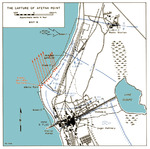 Click to enlargeROBERT E. WOLIN - COMPANY D: The 2nd morning we moved south down Green Beach 2 towards where we should have landed the day before, picking up isolated Marines as we went, some from our battalion, others infantry. Before we reached the end of the airstrip road, we were up to 20 or 30 strong, alert for snipers in the palm trees and checking out pillboxes but we had no working amtanks and had lost 21 of the 35 men in our platoon so we dug foxholes about 500 yards from the Charan Koanoa sugar mill pier, guarding the south flank of the 8th Marines. Later, hearing that our Battalion HQ was up north near the Radio Tower, several of us set out to report in. There, after learning that Lt. Ambrose had reported us missing in action, we got radios, a few missing men and headed back to the south flank. Lt. Manner and others stayed behind to help get our amtanks back into action. Plt. Sgt. Ray Sherman who'd had his finger shot off, later got his wounds patched up and returned from offshore. So did Gunny Roberts who'd escaped the hospital ship after they denied him permission to return to action.
Click to enlargeROBERT E. WOLIN - COMPANY D: The 2nd morning we moved south down Green Beach 2 towards where we should have landed the day before, picking up isolated Marines as we went, some from our battalion, others infantry. Before we reached the end of the airstrip road, we were up to 20 or 30 strong, alert for snipers in the palm trees and checking out pillboxes but we had no working amtanks and had lost 21 of the 35 men in our platoon so we dug foxholes about 500 yards from the Charan Koanoa sugar mill pier, guarding the south flank of the 8th Marines. Later, hearing that our Battalion HQ was up north near the Radio Tower, several of us set out to report in. There, after learning that Lt. Ambrose had reported us missing in action, we got radios, a few missing men and headed back to the south flank. Lt. Manner and others stayed behind to help get our amtanks back into action. Plt. Sgt. Ray Sherman who'd had his finger shot off, later got his wounds patched up and returned from offshore. So did Gunny Roberts who'd escaped the hospital ship after they denied him permission to return to action.
HAROLD C. MOODY - COMPANY C: Lt. Wolin sent a runner to get a forward observer from beyond the front lines. When both returned, Jap artillery fire started coming in close, as Lt. Wolin gave the forward observer instructions who finally asked: Lieutenant, could you hurry this up, so I can get back up to where its safe?
Note: That 2nd afternoon Marine infantry, wielding shotguns against fierce resistance, pushed south down Green Beaches 2 & 3 toward the enemy anti-boat gun positions on Afetna Point. On the 2nd day limited supplies got ashore across Red Beaches. That 2nd night ashore the Japanese would launch of fierce counter attack including 44 tanks against the 6th Marines.
 CHARLES F. AMBROSE – My Company B's personel were down to two platoons, one led by Lt. Wollin the other by warrant officer W.O. Liberatore. We were cut in two: Wollin's platoon on the right flank, the rest north from Green 1 into the Red Beaches toward Garapan. Wollin had shrapnel in his butt and a burnt hand. Gunny Roberts was hit, evacuated, but returned badly wounded to fight. Company Clerk and Runner Bob Rose had a bad leg. So it went up and down the line. Plus we'd lost over 60% of our tanks. But we held together, kept at it. Lt. Godbold and Sgt. Scarpo and their people worked hard finding then salvaging tanks with parts from tanks beyond repair. All hands pitched in, finding crews and fixing as many tanks as possible, putting crews and operable tanks back together, building us into an active, effective two Platoon Company growing stronger and better each day. Wollin's platoon moved north as amtanks were repaired.
CHARLES F. AMBROSE – My Company B's personel were down to two platoons, one led by Lt. Wollin the other by warrant officer W.O. Liberatore. We were cut in two: Wollin's platoon on the right flank, the rest north from Green 1 into the Red Beaches toward Garapan. Wollin had shrapnel in his butt and a burnt hand. Gunny Roberts was hit, evacuated, but returned badly wounded to fight. Company Clerk and Runner Bob Rose had a bad leg. So it went up and down the line. Plus we'd lost over 60% of our tanks. But we held together, kept at it. Lt. Godbold and Sgt. Scarpo and their people worked hard finding then salvaging tanks with parts from tanks beyond repair. All hands pitched in, finding crews and fixing as many tanks as possible, putting crews and operable tanks back together, building us into an active, effective two Platoon Company growing stronger and better each day. Wollin's platoon moved north as amtanks were repaired.
The Battalion collecting men and amtanks from across the battlefield resurrected itself out of its broken parts in the midst of battle and as its men fed off adversity, the battalion went looking for more, getting ever more power back into the fight.
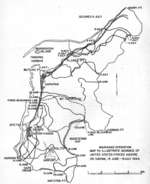 Click to EnlargeUp north as we reorganized and reconstituted our strenght we guarded the beach and sea flanks from attack. In daylight we provided key firepower the 2nd Marine Division's seaward flank that we moved slowly north toward Garapan, securing our position before we later pushed north through Garapan and Tanapag to Marpi Point before overunning Maniagassa Island. Doing this we marveled at how Col. Fawell worked us into a combat Battalion IN THE FIELD. He and Major Williamson were a superb Team. Our Platoons and Companies were assigned to various infantry units as situations demanded and Col. Fawell kept in touch with these units and had our battalion ready at all times to move in and assist as called upon. Many separate missions were performed successfully as a result. Col. Fawell was everywhere. How he survived through the battle I’ll never know. I know he had a lot of close calls.
Click to EnlargeUp north as we reorganized and reconstituted our strenght we guarded the beach and sea flanks from attack. In daylight we provided key firepower the 2nd Marine Division's seaward flank that we moved slowly north toward Garapan, securing our position before we later pushed north through Garapan and Tanapag to Marpi Point before overunning Maniagassa Island. Doing this we marveled at how Col. Fawell worked us into a combat Battalion IN THE FIELD. He and Major Williamson were a superb Team. Our Platoons and Companies were assigned to various infantry units as situations demanded and Col. Fawell kept in touch with these units and had our battalion ready at all times to move in and assist as called upon. Many separate missions were performed successfully as a result. Col. Fawell was everywhere. How he survived through the battle I’ll never know. I know he had a lot of close calls.
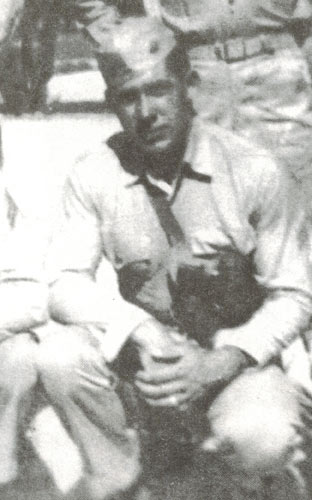 JAMES A. SCARPOJAMES A. (AL) SCARPO – COMPANY D: Under heavy artillery coming down along the tree line on the beach, I dived into a foxhole. Almost immediately a heavy body slammed down on top of me. An exploding shell knocked off tree limbs above us and blew sand and dirt all over us. Another shell landed awfully close, really jarring us both. The body on top said "Where did that one land?” I knew its voice: Col. Fawell, our Battalion Commander. “Hell, I don’t know. You’re on top. SIR!” If a combat newsman had been there, his headline could have been: “Faithful Battalion Commander protects his Sgt!”
JAMES A. SCARPOJAMES A. (AL) SCARPO – COMPANY D: Under heavy artillery coming down along the tree line on the beach, I dived into a foxhole. Almost immediately a heavy body slammed down on top of me. An exploding shell knocked off tree limbs above us and blew sand and dirt all over us. Another shell landed awfully close, really jarring us both. The body on top said "Where did that one land?” I knew its voice: Col. Fawell, our Battalion Commander. “Hell, I don’t know. You’re on top. SIR!” If a combat newsman had been there, his headline could have been: “Faithful Battalion Commander protects his Sgt!”
When the shelling stopped Col. Fawell took off to check on something and I didn’t see him for a few days. No Marine Battalion ever had a finer Commander than we had … in or out of battle.
JACK HARVEY - COMPANY C: We were back at the beach on the 2nd day to reorganize with the rest of our battalion when Gunny Sgt. Chapman sent us to Green Beach 1. There that night we stayed in a hole near Col. Fawell and Major Williamson. Heavy shell fire the next morning forced us to move to a new place.
C. J. EVERS – COMPANY: PFC John Huekels kept taking off looking for souvenirs. Since he liked to endanger his life so much, we made him the Company runner, a job that might satisfy his desire for excitement.
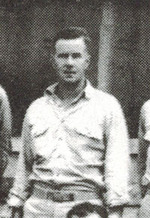 REED M. FAWELLREED M. FAWELL - BATTALION: Our Amtanks took a beating that first day. Some 80% were not operable by the first afternoon. But we had our own workshops, equipment, and mechanics who worked miracles, taking parts of disabled vehicles beyond repair to bring others back to life. We got 35 back into action.
REED M. FAWELLREED M. FAWELL - BATTALION: Our Amtanks took a beating that first day. Some 80% were not operable by the first afternoon. But we had our own workshops, equipment, and mechanics who worked miracles, taking parts of disabled vehicles beyond repair to bring others back to life. We got 35 back into action.
JAMES A. (Al) SCARPO - COMPANY D: I was Chief of Maintenance for our Company and Colonel Fawell made very clear in no uncertain terms that all Battation mechanics would spare nothing to get our savagable amtanks up and running and back into the battle as soon as possible no matter the cost. If you all can't do it, I'll find the men who can, he said. I'll never forget his words, and their impact on us. After that we went everywhere, repairing our own salvageable amtanks with spare parts from those otherwise destroyed, or by yanking those needed parts off a variety of amtracs belonging to others, if they'd work in our armored ones.
ALBIN A GALUSZKA M.D. - BATTALION DOCTOR - Among events too numerous to mention, when one of our amtanks was destroyed out on the reef or behind enemy lines, it often took several tries to outwit the enemy just to get to it, then retrieve the bodies from inside the amtanks, and finally retrieve the amtanks that the bodies had been in. It was a horrible and dangerous business, very demanding. ORIE F. MORGAN, CORPSMAN: Col. FAWELL and Doc. GALUSZKA were absolute best friends. We all could see it, how they kept track of one another, and stepped off to talk alone, working things out. Somehow, us seeing them working together helped keep us going, doing what we had to do.
JOHN H. HOBAN - COMPANY A: I remember helping move the remains of our own dead Marines from their amtanks that we were trying to salvage and get back into action. That for me was probably the worse part of the battle, and it went on constantly for several days. C. W. (BILL) GOODNIGHT - COMPANY B: I'll never forget the 2nd day when, looking into my best friend's turret, I saw the carnage left after he was hit by a 37mm shell. Then after the Jap counterattack against our position that 2nd night on Saipan, I saw the Japs stacked up on the wire.
Note: 37 mm shell hole in photo of turret below right.
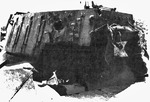 CLICK TO ENLARGEJAMES A. (Al) SCARPO: Four of us had returned to Lake Susupe to retrieve our disabled amtanks when machine gun and automatic rifle opened up on us. Despite being out in the open, we made it to the nearest tank without getting hit. Its engine cover was open. After the firing stopped, I crawled onto the tank's back and spied 2 small grey wires, not our kind, dropping inside the engine compartment. Carefully I traced the wires down to an electrical mine that had been tied into the ignition's magneto. I dismantled the trick and got our tank out.
CLICK TO ENLARGEJAMES A. (Al) SCARPO: Four of us had returned to Lake Susupe to retrieve our disabled amtanks when machine gun and automatic rifle opened up on us. Despite being out in the open, we made it to the nearest tank without getting hit. Its engine cover was open. After the firing stopped, I crawled onto the tank's back and spied 2 small grey wires, not our kind, dropping inside the engine compartment. Carefully I traced the wires down to an electrical mine that had been tied into the ignition's magneto. I dismantled the trick and got our tank out.
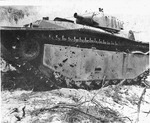 Pontoon Bullet HolesKEITH NEAL - COMPANY C: The 2nd day, another welder and I were told to put more armor on our tanks right away. Their steel pontoon sheets were very vulnerable. Only paper thin they wouldn't stop a 30 caliber bullet, so as underarmored prime targets, we took a beating from all kinds of Jap weapons. L. H. VAN ANTWERP: Our maintenance people did a great job stripping parts off destroyed amtanks to get others back in action. 80% of our amtanks were out of action at the end of that first day on Saipan. Cannibalizing got half back into operation.
Pontoon Bullet HolesKEITH NEAL - COMPANY C: The 2nd day, another welder and I were told to put more armor on our tanks right away. Their steel pontoon sheets were very vulnerable. Only paper thin they wouldn't stop a 30 caliber bullet, so as underarmored prime targets, we took a beating from all kinds of Jap weapons. L. H. VAN ANTWERP: Our maintenance people did a great job stripping parts off destroyed amtanks to get others back in action. 80% of our amtanks were out of action at the end of that first day on Saipan. Cannibalizing got half back into operation.
THOBY THOLE - COMPANY D: We added sorely needed armor after Lt. Godbold scrounged Jap boiler plate that he cut into 12 inch strips then heated and rolled in a forge where, with a sledge hammer, he moulded rings that fit around the ring mounts for our 30 and 50 cal. machine guns atop our tank's turrets. The 1/4 inch plate wasn't hardened so he spaced two 1/4 inch rings a 1/4 inch apart, creating a double shield giving us a 1/2 inch+ thickness for protection. On Iwo his double shield stopped a 30 or 50 caliber round before it penetrated the inner ring behind my head, saving my life. Lt. Godbold, a good friend before. became a dear friend afterward up till the day he died in the "70s".
MARSHALL E. HARRIS: Our mechanics did amazing work finding new ways to improve our amtanks. They added armor by welding forged rings spaced a 1/4 inch apart for enhanced stopping power. They curved metal shields to protect otherwise exposed gunners atop the turret firing the 50 Cal and 30 Cal scarf guns. They welded swivel rings for more 30 Cals atop the turret. The plexiglass domes atop the driver and bow gunner kept fogging over and their periscopes shattered in battle, blinding the driver and bow gunner, so they cut slits for us to see where we were going and what we needed to fire at. Their blow torched horizontal slits gave us 45 degree angles of vision in front and sideways. They also cannibalized wrecked tanks to resurrect others. Much work was done in midst of battle. After beating back the 2nd night Jap tank attack we stopped at our 2nd Armored HQ to get slits and other upgrades, and also repairs before heading north into the battle for Garapan after our antank CO Platoon Sgt. Outen said expect European style street fighting up there.
JERRY D BROOKS - COMPANY C: The treads on our amtanks were their weakest link. Designed to paddle through the water, they easily broke when propelling the tank's heavy weight overland, digging into rocky soil, pulling a tank forward or up steep inclines or over obstacles. The amtank's high octane aircraft engine also proved fragile when abruptly down shifted and was highly flamable. The thin sheet metal pontoons when hit left wierdly shaped gashes and tears in our high sided amtanks between their treads. These tears and gashes were submerged underwater when the tank was seaborne and hard for us to plug against leaks. So amtanks easily sunk, during or after combat.
WINTON W. CARTER - COMPANY B: 2nd day, told to drive a repaired amtank down the beach, I say: Wait here, men, I'll drive it up and we'll load. Inside I found clean clothes, socks, a carton of Camels, and Soap! Oh Boy! I jump out with the soap and am washing my hands in surf when a shell explodes nearby. In comes another then explodes. I gawk. WHAM! A 3rd goes smack down the turret of our tank. Up she goes! I go running, telling HIM: I will never leave you.
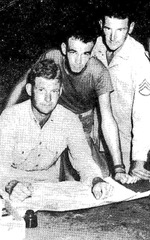 CLICK TO ENLARGEJAMES R. MACARTER - COMPANY A: On the 2nd day Lt. Pratt and I met with Company COs at Col. Fawell's Command Post. After his instructions we went up the beach with Captain Henry H. Shiver, B Company CO. At his Command Post he invited us in. Lt. Pratt said we had to keep going to dig in out tanks as Col. Fawell had instructed. It was a good thing. We'd walked another 25 yards when Captain Shriver's CP took a direct hit. E. FRANK GAMBLE - COMPANY B: We'd gone looking for our Company CO and had just spotted him talking to Gas Miller and John Lampert when an air burst killed him and wounded a bunch of Marines.
CLICK TO ENLARGEJAMES R. MACARTER - COMPANY A: On the 2nd day Lt. Pratt and I met with Company COs at Col. Fawell's Command Post. After his instructions we went up the beach with Captain Henry H. Shiver, B Company CO. At his Command Post he invited us in. Lt. Pratt said we had to keep going to dig in out tanks as Col. Fawell had instructed. It was a good thing. We'd walked another 25 yards when Captain Shriver's CP took a direct hit. E. FRANK GAMBLE - COMPANY B: We'd gone looking for our Company CO and had just spotted him talking to Gas Miller and John Lampert when an air burst killed him and wounded a bunch of Marines.
GENE LEWIS - COMPANY A: After explosion I ran to Captain Shiver. Turning him over, I saw the head wound that killed him. A Marine hung over the side of a DUKW, his arm dangling by a thread.
(Photo left to right: James MacCarter, Larry Peeples, and Thomas Carlisle)
DOUGLAS N. MILLICAN - H&S COMPANY: I got ashore the 2nd day with carbine and typewriter in a little green box to list for my Battalion those killed, wounded, missing in action, evacuated from beach, etc. We set up shop in a bomb crater near our Battalion HQ and a "hospital" set up by the Corpsman a few feet away. That night a mortar blew hospital away. Corpsmen had a job trying to evacuate the wounded to the hospital ships.
HAROLD B. LITZ, JR. - COMPANY C: Late the 2nd day Vernon Lowe and I strung communication wire along the beach to hook us into the 5th, 2nd, and 10th Amphibian battalions. LVTs crossing just laid wire tore it up or shells blew it sky high. Chaos was still in full swing, and never let up.
PAUL A. HIRSBRUNNER - COMPANY C: We got to the railroad tracks (the 0-1 line) the 1st day and stayed there all afternoon and night waiting for the Infantry to catch up. They failed to arrive the 2nd day so I sent a runner back to find out what was going on. He returned saying Col. Fawell wanted to see me. I ran back to the beach. The Colonel was not happy, we weren't with our assigned infantry group. He sent us there where the dope was that we'd attack at daybreak the next coming morning (17 June).
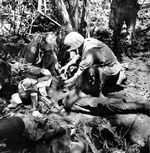 CLICK TO ENLARGERICHARD W. MASON - COMPANY C: Since our amtank was hung up, when Lt. Hirshrunner got back at the railroad tracks (0-1 line) on day 2, we started back to the beach on foot. Lt. Hisbrunner, a powerful man went with us, moving fast, carrying a heavy ammo box on one shoulder and a five gallon water can on the other. It was hard keeping up with him. On the way Eil Evans found a badly wounded 8th Regiment Marine we'd known aboard ship. We carried him in a poncho back to the beach. There he insisted I take his knife that stayed sharp (mine never held its edge.) We heard later he died aboard ship.
CLICK TO ENLARGERICHARD W. MASON - COMPANY C: Since our amtank was hung up, when Lt. Hirshrunner got back at the railroad tracks (0-1 line) on day 2, we started back to the beach on foot. Lt. Hisbrunner, a powerful man went with us, moving fast, carrying a heavy ammo box on one shoulder and a five gallon water can on the other. It was hard keeping up with him. On the way Eil Evans found a badly wounded 8th Regiment Marine we'd known aboard ship. We carried him in a poncho back to the beach. There he insisted I take his knife that stayed sharp (mine never held its edge.) We heard later he died aboard ship.
HARLAND T. ROSVOLD - COMPANY C: Alvin Caldwells' asking me to return his religious metal and watch to his parents if anything happened to him dogged me the whole first day and night. He was a good friend and I'd promised him. So, on the 2nd morning, I returned to our badly damaged tank, climbed inside through the driver's hatch and carefully removed the religous metal and watch from the body of our very popular and able CP Operator. After that I carried his metal and watch with me everywhere I went. When I got back from overseas afterward, I sent them to his family in Oregon.
JERRY D. BROOKS - COMPANY C: For some reason, incoming artillery and mortar fire (except tree bursts) never bothered me as much as small arms fire. I had discovered while on the boot camp rifle range that the crack of a rifle aimed at my target sounded differently from the crack of a rifle aimed at the target next to mine. Whenever on Saipan I heard that first kind of crack, I knew somebody was shooting at me, and not at the Marine one foxhole over from mine. Simply put, the Jap may not be shooting at me personally but he was still shooting to kill me nevertheless, a fact that I took as a personal affront. On the other hand I considered incoming artillery and mortars to be simply "For Whom It May Concern." Some of the Marines around me thought just to opposite. Guess everybody's war different for the next guy over.
RICHARD W. MASON - COMPANY C: The enemy controlled Garapan until we moved against it later, but our Navy and Marine artillery were throwing shells up that way, helping to neutralize it. That started with a big bang on Day 2.
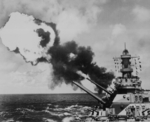
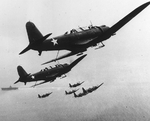 WINTON W. CARTER - COMPANY B: The Navy had intended to leave Garapan intact. But the Japs kept using the town to launch attacks and pour fire from there in on us. So when the USS California eased in near shore, I thought, God, what a monster to be staring you in the face! She opened up all her guns then carrier planes roared in, bombing and straffing. On our flank position 1000 yards south, we felt the ground tremors under us as BIG CAL. laid down salvo after salvo, leveling the place. (Click any photo to enlarge it)
WINTON W. CARTER - COMPANY B: The Navy had intended to leave Garapan intact. But the Japs kept using the town to launch attacks and pour fire from there in on us. So when the USS California eased in near shore, I thought, God, what a monster to be staring you in the face! She opened up all her guns then carrier planes roared in, bombing and straffing. On our flank position 1000 yards south, we felt the ground tremors under us as BIG CAL. laid down salvo after salvo, leveling the place. (Click any photo to enlarge it)
ART L. HOLMES - COMPANY D: Garapan, fairly close to us, was spared from shelling until we learned that the Japs hiding there were using it as a base to launch attacks. The order was given to destroy it. A battleship turned and leveled the town mostly.
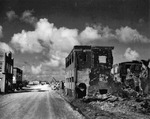 Click Don C. Newey
Click Don C. Newey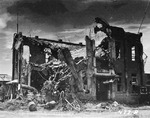 Click Don C. Newey
Click Don C. Newey
KENNETH E. SMITH - COMPANY D: We kept busy knocking out Jap pillboxes on the right flank. Sgt. Johnson gave me credit for nailing a Jap forward artillery observer. Felt sorry for that Jap in a way ever since.
HARLAN T. ROSVOLD- COMPANY C: That 2nd afternoon Col. Fawell sent us to join Lt. Hisbrunner's other amtanks to help the Marine infantry there that needed artillery support in a push several hundred yards inland towards Mount Tipo Pali, the Radio Tower and Lake Susupe that was planned for dawn the next day, 17 June. We drove over and Jack Brancheau and I dug a foxhole away from our amtank because they were alway prime targets for counter-fire. Later that night we heard a loud Thud as a sizzling chunk of shrapnel buried itself into dirt we'd shoveled out digging our hole. Around 3 AM yelling, screaming, and gunfire along with the sound of bugles came rushing our way. The entire front came alive, lit by star shells and flares. The ruckus died a half hour later, leaving several hundred bodies spread out in front of our lines. We were lucky, but not Lt. Hisbrunner who'd was nearby.
PAUL A. HIRSBRUNNER - COMPANY C: With the Japs dropping lots of artillery and mortars on us out there in the dark, I was on my knees in a foxhole, talking about the planned dawn offensive with my Sergeant when a shell burst broke one arm, took off a finger, busted a thumb joint, and tore flesh from both arms. I told the Sergeant to take over, and got to the beach where they evacuated me. RICHARD W. MASON: Losing Lt. Hirshrunner one of the finest Marine officers you could ever hope to meet or work for, was a blow.
MARSHALL E. HARRIS - COMPANY C: Dug in there too that 2nd night, Paul McDaniel was hit, his shoulder ripped up bad. We pumped him with morphine, and still under heavy fire, we took turns looking after him. As the sun rose Pappy Outen got him to an aid station. It was blown away minutes later, killing scores of Marines. Paul survived the beach but died two days later on the hospital ship and was buried at sea.
JERRY D. BROOKS - COMPANY C: As I recall, the largest attack came the 2nd or 3rd night out of the ravines coming down from Mt. Tapotchau and hit off to our right, south of us toward Charan-Kanoa, 44 tanks and six or seven hundred Jap infantry, the tanks stopped by good bazooka work, rocket lauchers, anti tank fire and the infantry by rifle and machine gun fire, especially 50 Cal. machine gun fire, the sweetest sound for me in battle, those 50 Cal. slugs torn Jap infantry apart. Nothing got through our positions on the beach.
Note: The enemy also counterattacked south from Garapan through the 2nd night (16-17 June). Heavy artillery, mortar fire, and infantry supported tank attacks. All were repulsed. 29 Japanese tanks were destroyed. 18/
JERRY D. BROOKS - COMPANY C: Up on the north flank near Garapan, Japs were all around us that first and second night. On the 2nd night me and my buddy dug into a hole twenty feet from the water and just off the road then hunkered down with our young senses on sharp alert for death lurking out in the dark. We'd hear most everything out in the blackness: ever so slight sounds would give the Japs away, even Japs coming at us quiet as fog, or those making an ever so slight rustle of sand. We'd hear slight noises even over the noise of rifle and machine gun fire north and south of us and got to hearing things that weren't there, and trusted nothing. Couched side by side, on our knees, facing opposite ways to see all around, we had our 45 automatics out, ready to blast the Japs dumb enough to be creeping towards us, when suddenly sand flew. A thing came flying into our hole, bouncing off, making a racket between us. A GRENADE! I grabbed for it but the DAMN THING got away. I kept scrambling, grabbling for IT, some kind of scary new Jap Weapon. Fortunately IT was a dud. A sandcrab! The beast munching its way through the wall of our hole, had dropped inside, a sandcrab! Up there most of the week at the beach's north end us teenagers helped to get that 2nd Marine Division flank position moved about 800 to a 1000 yards farther north toward Garapan. Those first few days were the craziest and most exciting I'd ever have in combat. (Note: Jerry Brooks, also in the thick of stopping Tinian' 1st night's Banzai charge, received a Bronze Star on Iwo Jima for saving his Marine buddy's life.)
BEACH DEFENSE ON SOUTH AND NORTH FLANKS & THE PUSH TO GARAPAN (D-DAY+3 - 1 JULY)
Note: In the early morning hours of D-Day + 3 (18 June) Japanese boats and barges loaded with troops attempted to leave Tanapag Harbor and attack from the Marine's seaward flank. LCIs and Amtanks caught and sank 13 of the enemy vessels. The rest turned back.
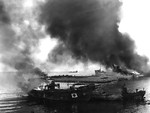 click enlarges burning bargesMARSHALL E. HARRIS: I remember it clear as yesterday. We were ready, waiting for them. Our amtanks at a right angle to the beach streched in a line across the lagoon's shallow water to the reef. Other amtanks, including mine, were dug into a berm ashore looking down on the lagoon. Beyond the reef LCIs had waited too. As bow 30 Cal Machine gunner I had a clear field of fire and enjoyed it, sighting down tracer bullets flaring off into the dark, every 3rd bullet a tracer round. Behind and above me that night, our Platoon Sqt. Pappy Outen squatted on the amtank's back deck, firing the 50 Cal. machine gun ring mounted on the turret. The enemy barges sailed into our trap. We opened up first then the LCI's 20mm cannons. Tracers skimmed the flat black water. The barges milled in the cross fire as if confused then terrified with Japs jumping overboard. 13 barges loaded with troops sank. Marines ashore got many trying to swim ashore. Nothing got through us alive. If a barge escaped it headed north from where it'd come, but I didn't see any get away.
click enlarges burning bargesMARSHALL E. HARRIS: I remember it clear as yesterday. We were ready, waiting for them. Our amtanks at a right angle to the beach streched in a line across the lagoon's shallow water to the reef. Other amtanks, including mine, were dug into a berm ashore looking down on the lagoon. Beyond the reef LCIs had waited too. As bow 30 Cal Machine gunner I had a clear field of fire and enjoyed it, sighting down tracer bullets flaring off into the dark, every 3rd bullet a tracer round. Behind and above me that night, our Platoon Sqt. Pappy Outen squatted on the amtank's back deck, firing the 50 Cal. machine gun ring mounted on the turret. The enemy barges sailed into our trap. We opened up first then the LCI's 20mm cannons. Tracers skimmed the flat black water. The barges milled in the cross fire as if confused then terrified with Japs jumping overboard. 13 barges loaded with troops sank. Marines ashore got many trying to swim ashore. Nothing got through us alive. If a barge escaped it headed north from where it'd come, but I didn't see any get away.
(Note: The next morning Japanese troops began digging defensive positions south of Garapan. Seeing this activity the 2nd Marine Division supported by 2nd Armored amtanks and land tanks moved north to disrupt these enemy efforts and solidify their own lines that later anchored the pivot of three Infantry Divisions that wheeled abreast and headed north, taking by force Saipan's north end.)
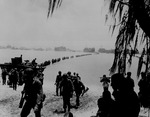 CLICK to ENLARGESaipan's fierce resistance that inflicted 2500 US casualties in the first two days postponed the assault on Guam that was to have occurred 100 miles to the south and the Army's 27th Infantry Division landed south of Afetna Point where it was attached to the 4th Marine Division. America's battle for Saipan had become a three division offensive brawl directed by General Holland Smith who now commanded the largest combat field army in Marine Corps history. Until its later pivot north, however, the battle's center shifted onto the front lines of the 4th Marine Division and 27th Infantry Division, trying to secure the the island's south end, including areas east of Charan-Kanoah, Lake Supupe, Aslito Airfield, Tsutsuran, Objijan, and Nafutan Peninsula). 9B/
CLICK to ENLARGESaipan's fierce resistance that inflicted 2500 US casualties in the first two days postponed the assault on Guam that was to have occurred 100 miles to the south and the Army's 27th Infantry Division landed south of Afetna Point where it was attached to the 4th Marine Division. America's battle for Saipan had become a three division offensive brawl directed by General Holland Smith who now commanded the largest combat field army in Marine Corps history. Until its later pivot north, however, the battle's center shifted onto the front lines of the 4th Marine Division and 27th Infantry Division, trying to secure the the island's south end, including areas east of Charan-Kanoah, Lake Supupe, Aslito Airfield, Tsutsuran, Objijan, and Nafutan Peninsula). 9B/
JERRY D. BROOKS - COMPANY C: Once organized, our main job was to destroy any Jap effort to come down the "road" or beach from Garapan or come offshore in small barges to force a landing in our midst or south of us then hit our troops inland from the rear. Sometimes as we waited for these attacks, fog rolled in over us from off the ocean, cutting our view to ten yards or less while creating strange acustics. If the Japs ramped up artillery and mortar fire, we knew a major attack was coming from Garapan.
REED M. FAWELL - BATTALION: GUNNY SERGT. CLARRON T. MILLER'S recieved a Bronze Star for his exceptional work and leadership from 15 June to 9 July on our left flank up near Garapan, and later for operations pushing north of Garapan. "For meritorious service in action against the enemy on SAIPAN ISLAND ... from 15 June to 9 July ... when his company was charged with beach defense of the advancing left flank, Gunnery Sergeant MILLER was responsible for the establishment of the defense each night. This resulted in his being on or ahead of the front lines in enemy territory after dark. On the night of 3 July one of the armored amphibians hit an enemy mine. Gunnery Sergeant MILLER and one other sergeant made their way at midnight to the disabled tank in enemy territory, disabled its weapons and located two of its crew members who were missing. His conduct was in keeping with the hight traditions of the United States Naval service." BRONZE STAR citation for GUNNY SERGEANT. CLARRON T. MILLER.
ROBERT CZAPEWSKI : Gunny Miller was one of a kind. When things got really bad, like after heavy D-Day casualities, particularly among officers, his coolness under fire set an example for all of us. I recall bullets and shrapnel were flying around like raindrops and everyone was scurrying for cover but not Gunny Miller He sat with feet propped up on the edge his amtank's open turret and elbows on his knees, looking through his field glasses for targets.
KEITH NEAL - COMPANY C: Our amtanks up north were positioned to repel any counter attack from the north or seaward. Our men without amtanks filled the gaps between amtanks. They dug in with dismounted 30 & 50 Cal machine guns and assorted small arms (M-1 rifles, carbines, Thompson submachine guns, 45 cal. automatics) between amtanks bristling with 75 mm Howitizers amid their own mounted 50 and 30 Cal. machine guns. Despite all the punishment on D-Day, we were still a force to be reckoned with, growing stronger and more seasoned by the hour.
RICHARD W. MASON - COMPANY C: After losing Lt. Hirshrunner, Major Bevens and his crew, including Sgt. James Bartley, helped us get Lt. Hirshbrunner's amtank out of Lake Susupe on the 3rd day, and we moved it north where we dug into a defensive line some 1000 yards south of Garapan to protect against our biggest threat, the Japs coming down south at us from there.
JAMES D. MACKEY - COMPANY C: After we got our amtank back into action on 17 June, we'd go every other night up north toward Garapan to help anchor the front line. Our spot on the beach later was the pivot point for the 2nd Marine Division as it moved inland around Garapan then turned north. So we were the front line and also the left flank on the 2nd Divison.
HAROLD B. LITZ, JR. - COMPANY C: On his off days on Green Beach 1, Jim Mackey and others repaired amtanks, tearing stuff like grousers off one (or even abandoned US Army tanks) to get another amtank running. I replaced our TCS radios with the Army's SCR 528s.
HAROLD B. LITZ, JR. - COMPANY C: Rifle fire was coming at us the 3rd night when Vernon Lowe said: Happy Birthday, Deacon! In all the excitement I'd forgotten my 21st birthday.
JERRY D. BROOKS - COMPANY C: The 3th morning brought a real surprise. Most all the US Navy ships that had filled the ocean to its horizon had disappeared. The Jap Imperial Navy (or a large hunk of it) was steaming east to Saipan to sink our Navy, blow our aircraft out of the sky, then kill us. So our Navy had left Saipan in the dark the night before and steamed west to kill the Japs first. For us Marines left behind onshore, our immediate question was how to get replacement ammunition and also get water if our distillation units were overrun or blown up. These questions were more than academic. If things didn't go well for our Navy now headed for the Philippine Sea to destroy the Jap fleet before it hit us, we could be in a bind. By noon that 3rd day the word came down for extra strict water discipline and for us not to fire at any Jap unless he got so close you didn't need to waste a second shot on him. Late that afternoon I was sent north with two empty five gallon water cans to refill at a distillation station up the beach. I got there and got the refills. Its water was racky, tasting awful, but better than none at all. But hauling those full water cans back down the beach was harrowing: The heavy cans tried to pull my arms out of my shoulder sockets with me trying to dodge Jap artillery explosions. The explosions coming my way walked up the beach then it was Russian Roulette, explosions all around with air bursts too. Chaos forced me into a hole. There I spent the night with two 8th Regiment Marines cursing a blue streak about the tree bursts. Tarawa vets unfamiliar with heavy Jap artillery air bursts amid all the trees on Saipan, this pair had scrounged up a 30 caliber machine gun minus its tripod but with a half dozen boxes of belt ammo, and argued all night over who fed the 30 Cal, who held the 30 Cal. despite its hot metal and who fired it, and how and when to shoot all the Japs vague or hidden out in the dark. But I was pleased as punch to be with these guys. They were heavily armed seasoned Marine infrantry vets. All I had were two five gallon cans of water, a 45 caliber automatic and few magazines of ammo. When the sun rose, however, my full water cans were gone, blown away or hijacked. When finally I got back near to where I had started out the day before, the guys there, spotting me coming, thought they were seeing a ghost, what had been left of me after I got caught out in the open by one the explosions that had earlier walked across their position. On arrival I also learned that a DUKW had resupplied my people with full water cans soon after I'd left. Our Navy reappeared offshore a few days later. A happy bunch of Marines woke up to that view. That Navy of ours had destroyed Jap airpower in the Central Pacific during their Great Marianas Turkey Shoot, saving our bacon for sure. Nobody appreciated our US Navy for what they did more than us thousands of Marines still fighting on Saipan.
MARSHALL E. HARRIS - COMPANY C: Sometime after the 4th morning, parked with engine off, concealed in a grove of banana trees, we waited for orders to push north. Our job was protecting the far left flank of K Company, 8th Marines. Two Sherman tanks held K Company's right flank. A racket sounded up north, a rattling and squeeking, getting louder, coming south. Our Gunner Orvis Whitaker from Stab, Ky, up high in the turret, had the best view. He rotated our 75 mm Howizer turret, seaching up north then yelled for armored piercing shells. Then I saw it too, a Jap tank popping up over a low rise. Jerking to a halt it swung its turret gun 90 degrees right. Looking that way I spotted what it was going for, 2 Marine Shermans on K Company's far flank. Our 75 roared. It decapitated the Jap tank, blew its turret clean off. More explosions rocked it, blowing up then burning out whatever was left left inside.
KENNETH E. SMITH - COMPANY D: On guard duty parked offshore the 4th night, Simon shot his carbine several times out into the dark. What the hell is that, Japs? I asked. It was a log. Simon then became our Company Barber.
ROBERT E. WOLLIN - COMPANY D: Down south the Japs also infested the Lake Susupe swamp between us and the 4th Division for several days after our landing. We'd either bypassed them earlier or they'd infiltrated back through our lines at night. Daytimes they'd generally hide or play dead rather than shoot at us. We'd hear them at night splashing around in the water. Now and then we'd kill one or two as they tried to break into our position. After the first few days most of the Japanese artillery and mortar fire had shifted onto our infantry advancing inland, but still we had to be wary. Intermittent Jap fire could hit us at any time. They still had us in their sights.
Note: By 20 June Japan's grip on Saipan's south end was broken, Alsilo Airfield captured, and major defenses east of Charan-Konaoa were crumbling as 50% of Japan's line troops and heavy weapons had been destroyed. But survivors, expecting reenforcement from overseas by 29 June, fought on fanatically so the fighting inland remained dogged and tough, as American forces rooted enemy out of caves and pillboxes in rugged terrain. On 21 June enemy forces began to concentrate around Mt. Tapotchou as the 2nd Marine Division pushed northeast to ultimately take that peak while on the west coast it solidified its position up north, waiting for the 4th Marine Division and 27th Infantry Division to turn north. (9B)
JERRY D. BROOKS - Marines in the line companies in the jungles and ravines were constantly up close in one-on-one contact with Japs day after day. So the Marine Infantry punching it out inland, trying to move the Japs back yard after yard day after day, had a much rougher time than we did.
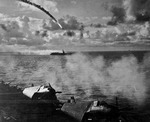 click to enlargROBERT E. WOLLIN - Now the south flank had quieted enough for me to try doing laundry. At the lagoon I'd bent over with a water bucket when I heard an artillery shell coming my way. (It's an old wive's tale that you only hear the shell that's has passed you by, a shell coming at me always sounded different.) This one passed overhead then landed 75 feet out in the water beyond me, but knowing the gunner was adjusting to hit me, I dropped the bucket and ran toward trees 50 yards distant. Halfway there the 2nd shell passed overhead then landed in my bucket. I'd reached the trees and hit the deck as the 3rd blast hurled shrapnel that wacked my behind. Like the flat side of a hot shovel it burned through my pants, my 2nd butt wound of the battle! Afraid they's telegram my mother, I told the medic not to report the wound. Those telegrams they sent drove our mothers crazy.
click to enlargROBERT E. WOLLIN - Now the south flank had quieted enough for me to try doing laundry. At the lagoon I'd bent over with a water bucket when I heard an artillery shell coming my way. (It's an old wive's tale that you only hear the shell that's has passed you by, a shell coming at me always sounded different.) This one passed overhead then landed 75 feet out in the water beyond me, but knowing the gunner was adjusting to hit me, I dropped the bucket and ran toward trees 50 yards distant. Halfway there the 2nd shell passed overhead then landed in my bucket. I'd reached the trees and hit the deck as the 3rd blast hurled shrapnel that wacked my behind. Like the flat side of a hot shovel it burned through my pants, my 2nd butt wound of the battle! Afraid they's telegram my mother, I told the medic not to report the wound. Those telegrams they sent drove our mothers crazy.
CHARLES H. ORLOSKI - COMPANY A: Excerpts from diary: 19 June - Under mortar fire early this morning and under artillery fire all day. 20 June - Same routine of receive and return fire. Mortared in the evenings, bombed at night, and shelled or mortared in the mornings. (Note: Japanese aircraft from Guam, Rota, and Iwo Jima paid nightly visits, dropping bombs that typically inflicted light damage. Escort carriers also fended off air attacks off Saipan.)
JAMES A. (Al) SCARPO - COMPANY D: That first week I went into the dark of a Jap pillbox filled with "dead Japs". I'd just stepped past a side room when shots rang out. They were lifesavers. Two Marines behind me had shot a Jap going at me with his bayonet then grabbed another that they hustled outside.
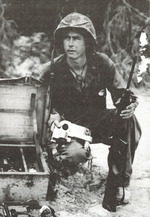 CLICK TO ENLARGEJACK W. WHITIS - COMPANY D: I need a volunteer - Whitis! said Sergeant Johnson before sending me into a Jap bunker to dismantle a British 76mm the Japs used at night, firing at our ships at sea. Going into that dark tunnel I had Jim Whitehead behind me as backup. As I brought the weapon's breech block and gun kit outside a Coast Guard photographer took a photo. Japs later punched into a Sea Bee position up to the north, killing quite a few. Rhe rest came running down the beach screaming at us: Get way! You're the only ones left! Gunny Liberatore, nonchalant as ever, said: We're staying right here; just double the watch.
CLICK TO ENLARGEJACK W. WHITIS - COMPANY D: I need a volunteer - Whitis! said Sergeant Johnson before sending me into a Jap bunker to dismantle a British 76mm the Japs used at night, firing at our ships at sea. Going into that dark tunnel I had Jim Whitehead behind me as backup. As I brought the weapon's breech block and gun kit outside a Coast Guard photographer took a photo. Japs later punched into a Sea Bee position up to the north, killing quite a few. Rhe rest came running down the beach screaming at us: Get way! You're the only ones left! Gunny Liberatore, nonchalant as ever, said: We're staying right here; just double the watch.
R. CARL SCHIMDT - COMPANY C: After several days Mackey and I spotted chickens running loose, birds that ended up chicken barbeque ... not like mother's, but better than C-Rations.
JERRY D. BROOKS - COMPANY C: After the 1st week up north in foxholes I returned to my own Company and joined the crew of a repaired amtank. Lou Laulive commanded its fine crew. Gordon Patterson was Gunner, and Louis Tapio its Driver. We named her LOW-GUT. She had a lot more action left in her. (See Tinian section for LOW-GUT's defense of beachhead's left flank on Tinian)
HAROLD B. LITZ - Jap artillery on Tinian 3.5 miles away opened up at night. Fireballs arched over us then exploded in the distance. Others hit our Green Beach. O ne blew up a gas storage facility whose flames spread to our ammo dumps, killing a lot of Marines.
JERRY D. BROOKS - COMPANY C: One oddity of the Saipan Campaign was the nightly visits of a lone jap bomber with far more than nine lives. I don't believe we ever shot it down. If someone did we never heard about it. The lone wolf came in very low and slow, its engine caughing and sputtering as if about to stall. It dropped stick bombs that mostly landed harmlessly but the plane coming over at tree top level seemed impossible to hit. The plane flew in from the island of Tinian, flying low over the three mile wide sea between Tinian and Saipan, through a sky lit up like the 4th of July with naval gunfire. Once across the beach, he disappeared and then we could hear him turn to the north over Saipan and he came at us from the south for what seemed minutes as the navy ships offshore lit up the sky. But now he was flying low over the trees just off the beach, headed our way for what seemed a long time, before he flared overhead, just above the trees, then was gone so quick I couldn't get the rifle bead on him so I was reduced to using my 45 automatic on him, trying for wing shots, as he sputtered northward out of sight again. He'd fly past Garapan, engine changing as he turned into the dark over the sea, and then all went quiet. That pilot had guts galore. We came to admire him, taking those risks night after night, flying alone trying to kill us.
DOUGLAS N. MILLICAN - H&S COMPANY: Dead Japanese and Americans lay on shore and out in the water for days. Many Marines who were still alive caught Dengue Fever and lay on the beach with Corpsmen washing their faces and lips with alcohol, trying to keep the flies out of their eyes and mouths.
L. H. VAN ANTWERP: Denque fever and dysentery washed us out with high temperature, chills, dizziness, and fatigue. On 5th day I was made runner for our Company CP on the beach. The place was a mess, the smell bad. Dead Marines and Japs floated in the water. Dead people and animals littered the island. Big blow flies got worse and worse, banqueting 24/7 on live Marines. KEITH NEAL - At night they'd circle above the trees, collecting in a swarm then dive attack us. HAROLD B. LITZ, JR.: The flies were terrible. A major effort went into burying the dead. A outfitted plane sprayed the island to kill the flies.
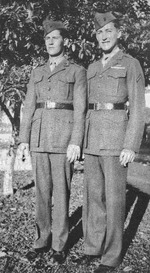 Click to EnlargeJOHN EINARSON - COMPANY A: Col. Fawell was very concerned about his men. I remember how he personally took action to see that the Graves Registration people took care of Delwyn Carlson who'd been killed a week earlier. The men who worked closely with Col. Fawell thought highly of him. (Note: Photo on left taken at Boat Basin before departure for battle. DELWYN CARLSON stands on left. JOHN EINARSON stands on right)
Click to EnlargeJOHN EINARSON - COMPANY A: Col. Fawell was very concerned about his men. I remember how he personally took action to see that the Graves Registration people took care of Delwyn Carlson who'd been killed a week earlier. The men who worked closely with Col. Fawell thought highly of him. (Note: Photo on left taken at Boat Basin before departure for battle. DELWYN CARLSON stands on left. JOHN EINARSON stands on right)
CHARLES H. ORLOSKI - COMPANY A: 23 June - We have 1/3 of island. Our infantry is nearing the suburbs of Garagan north of us. We are eating K, C, and 10 in 1 rations. Lots of dysentery. We are in beach defenses with 50 & 30 cal machine guns dug in between our 75 mm amtanks. Shrapnel from 77mm Jap artillery piece missed my ankle by 1/4 of an inch today. Shrapnel about 2x1 inch ripped through my foxhole, tearing four holes in my poncho.
JAMES R. MACARTER - COMPANY A: Lt. Pratt ordered me to take two amtanks up toward Garapan after dark to pick up wounded men. As we approached the beach an anti-boat mine separated its track. A 2nd blew a hole through its side, knocking me to the deck. Men in the turret were blown out. Driver, radio operator and transmission blown into the air landed out in the water.
M. NEIL MUMFORD - COMPANY A: One amtanks taking ammo north to the front closest to Garapan was hit a big anti-boat mine, blowing its transmission, driver, and radio man 125 feet.
ROBERT E. WOLLIN - COMPANY D: To clear Garapan our infantry first had to move up the radio road and clear the enemy from the high ground inland to the east and encircle the city before moving against it.
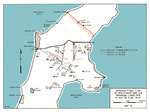 Click to EnlargeWINTON W. CARTER - COMPANY B: We advanced north toward Garapan as the 2nd Marine Division moved inland and northward slowly, encirling the town from the landward side. We provided left flank anchor protection inward from the beach and also seaward, clear out into the water for several hundred yards. Our job was to stop any Jap end-runs day or night.
Click to EnlargeWINTON W. CARTER - COMPANY B: We advanced north toward Garapan as the 2nd Marine Division moved inland and northward slowly, encirling the town from the landward side. We provided left flank anchor protection inward from the beach and also seaward, clear out into the water for several hundred yards. Our job was to stop any Jap end-runs day or night.
CHARLES H. ORLOSKI - COMPANY B: We had carbines and 45s plus two Thompson submachine guns in our amtank. We took the stock off the Thompson's and carried them without stocks, so turning sideways quick, we got good and effective firepower quick.
JERRY D. BROOKS - COMPANY C: We helped move our north flank some 800 to 1000 yards toward Garapan.
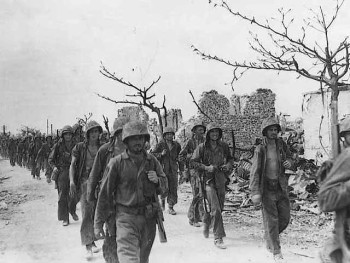
HAROLD A. ALLEN - COMPANY C: As our amtanks moved north on the road to Garapan flanked by infantry on the march, a radioman with Denque Fever in the amtank ahead got the GOES BAD. Rather than mess up the inside of his tank, he jumped out of the overhead hatch and hung his behind over the amtank's side. We hollered, pointing at him. The infantry took off into the weeds until his butt hanging out in the air, bumping up and down, passed them by.
 CLICK FOR HILL 500NORMAN B. SLOWE - As our infantry manuevered to encircle Garapan on 23 June, three K Company Marines had Sgt. Outen move our Amtank into woods a half mile behind Green 3 and pointed to where a big Jap gun was hidden on Hill 500 that we'd overun earlier. It took 30 minutes, looking though our Howitzer sight, to spot the target a 1000 yards away sliding out from behind two steel doors then it fired and disappeared. We cut away branches for a clear shot then waited. Doors opened, gun with crew slid into view, a few quick shots got us on target, then BOOM. Stuff flew all over the place. That took care of that.
CLICK FOR HILL 500NORMAN B. SLOWE - As our infantry manuevered to encircle Garapan on 23 June, three K Company Marines had Sgt. Outen move our Amtank into woods a half mile behind Green 3 and pointed to where a big Jap gun was hidden on Hill 500 that we'd overun earlier. It took 30 minutes, looking though our Howitzer sight, to spot the target a 1000 yards away sliding out from behind two steel doors then it fired and disappeared. We cut away branches for a clear shot then waited. Doors opened, gun with crew slid into view, a few quick shots got us on target, then BOOM. Stuff flew all over the place. That took care of that.
MARSHALL E. HARRIS - Pappy zeroed in the Howitzer then laid its high explosive (HE) shell dead on target. A yell went up. Slugging it out with land tanks wasn't our game but, properly deployed, we could get the job done as a direct fire assault gun outfit.
JERRY D. BROOKS - COMPANY C: I was impressed seeing the rocket trucks in action for the first time. The rockets, stacked one atop the other in racks, dropped in horizonal lines, each pulled by gravity until its line of rockets hit the bottom rack and then flared off, roaring then screaming into another long line of fiery ribbons chasing the last, all going into the far distance towards where the explosions of earlier lines had already plastered the earth and had left cane fields burning, down into scorched earth burnt black finally. Seeing the flame thrower tanks at work for the first time was great too. At Camp Pendleton we'd done practice runs with Marines with flame thrower packs on their backs, that's all.
JOHN EINARSON - COMPANY A: After things became a bit more stable a week and a half into the battle, it was interesting to observe that Col. Fawell had a morning routine. Only after he'd shaved and tidied up would he greet his right hand man (Major Williamson) with the satutatory expression Good Morning, Major! I'll never forget that routine. Mind you, they slept in the same bunker, a hole 10 feet by 10 feet with some cover and sandbagged sides.
JOHN ELOFF - COMPANY D: After a scout plane went down in the lagoon, we retrieved the pilots body. The guys having breakfast on the beach lost it as we dragged the pilot's body ashore.
JERRY D. BROOKS - COMPANY C: After a rain the humidity got heavy and dense, lingering for hours, and the mosquitoes got rambuctious, particularly at night, so I added a mosquito net to my helmet. The musty netting hung in front of your nose smelled awful but it beat getting eaten alive by little winged varmits. And the key here to some measure of bearable living was water to drink. Food we could live without for days but not water. In the food department, mostly we ate K rations in Cracker Jack boxes. Occasionally we got C rations in cans, not too bad but for the canned hash. Once, living high off the hog, we were given a big box of 10-in-1, including a hard chocolate bar that we shaved into hot water cooked up in our helmets. Dengue Fever and dysentery laid me low, miserable, for a couple of days, taking pills until feeling better I took a whack at a banana tree. My Jap bayonet sliced that tree trunk nearly clear through, so I figured I was okay again.
On 25 June the 2nd Marine Division took Mt. Tapotchou and pushed into the south edge of Garapan. Kalman Peninsula on the island's east side also fell, but the enemy held firm on Nafutan Peninsula. 80% of their front line troops had been killed, but the Japanese fought on fanatically. 19/)
 On 25 June the 2nd Marine Division's left flank advanced into Garapan to 8th Street and within sight of four disabled Jap tanks amid dead enemy soldiers but the Division settled down to small patrol action until the other two divisions operating inland straightened out the fronts lines inland to Garapan. "We're having a hard time holding these boys back, said Colonel Shoup ... they want to go ahead but it'd be bad tactics to push too far ahead of the others. 20/
On 25 June the 2nd Marine Division's left flank advanced into Garapan to 8th Street and within sight of four disabled Jap tanks amid dead enemy soldiers but the Division settled down to small patrol action until the other two divisions operating inland straightened out the fronts lines inland to Garapan. "We're having a hard time holding these boys back, said Colonel Shoup ... they want to go ahead but it'd be bad tactics to push too far ahead of the others. 20/
 Diary. 25 June: Half island secured. Garapan's south edge taken. Bombed again last night. Artillery shells (pack howitzers, 155s & 105s) go over night & day. 28 June: got my first mail on Saipan. Saw 2 planes downed. Days wore on, we dug better holes with sandbagged sides, timbered roofs under sandbags. We're shelled and mortared a lot. I watch sand crabs scurry across the road. They're everywhere. Lay in your hole, they dig out the sand under you. Kill them they stink like hell. I sit with my 45 trained on my foxhole's roof or lay on soggy blankets with pistol across my chest. Always wet, at night, lying there, I hear Japs party like hell getting loaded as I watch Oliver Kennedy's knife blade shine in the dark before Banzi charge in A.M.'s wee hours. CHARLES H. ORLOSKI
Diary. 25 June: Half island secured. Garapan's south edge taken. Bombed again last night. Artillery shells (pack howitzers, 155s & 105s) go over night & day. 28 June: got my first mail on Saipan. Saw 2 planes downed. Days wore on, we dug better holes with sandbagged sides, timbered roofs under sandbags. We're shelled and mortared a lot. I watch sand crabs scurry across the road. They're everywhere. Lay in your hole, they dig out the sand under you. Kill them they stink like hell. I sit with my 45 trained on my foxhole's roof or lay on soggy blankets with pistol across my chest. Always wet, at night, lying there, I hear Japs party like hell getting loaded as I watch Oliver Kennedy's knife blade shine in the dark before Banzi charge in A.M.'s wee hours. CHARLES H. ORLOSKI
THE PUSH NORTH THROUGH GARAPAN and TANAPAG HARBOR to MARPI POINT
Through the night of 1 July a US Heavy Cruiser and four Destroyers working with Shore Fire Control Parties prepped the battlefield for the 2nd Marine Division's push north into Saipan's largest town (pop. 10,000) Garapan and the high country behind it. The next morning a Heavy Cruiser, three Light Cruisers, five Destroyers, and Corps Artillery massed close in fire support beginning 0900 when the troops jumped off for their assault
ROBERT E. WOLLIN: We'd picked up repaired Amtanks at our Battalion HQ before the offensive and moved north to support our infantry in driving the enemy from banana groves inland from Garapan. Initially we spent uncomfortable nights in the banana groves outside Garapan. Not up againt the main Japanese line, we fought pockets left behind to destroy as many of us as they could using Japanese 'knee mortars." A hand grenade-type shell dropped down its short tube on a concave base "popped" when fired. Then the round went nearly silent even if coming your way. Unlike Company C, we were held in reserve at the city's edge until 6 July although city was taken on 3 July.
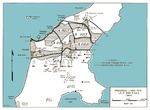 Click to EnlargeThe weeks of earlier pounding paid dividends. The 1st and 3rd Battalions a ttacked abreast, making excellent progress. Company C, 2nd Tank Battalion supported the 3rd Battalion that swept through the rubble strewn streets . 2nd Armored amtanks provided close fire support against targets near the beach. 21/ By noon the push by was 800 yards into Garapan. The 6th Marines took 1200 yards of high ground outside of town by 1740.
Click to EnlargeThe weeks of earlier pounding paid dividends. The 1st and 3rd Battalions a ttacked abreast, making excellent progress. Company C, 2nd Tank Battalion supported the 3rd Battalion that swept through the rubble strewn streets . 2nd Armored amtanks provided close fire support against targets near the beach. 21/ By noon the push by was 800 yards into Garapan. The 6th Marines took 1200 yards of high ground outside of town by 1740.
JAMES D. MACKEY - COMPANY C: Part of a 5-tank echelon seaward to the water's edge we enjoyed a good field of fire as Marine infantry moved into Garapan. Bank vaults were blown, Jap booty strewn everywhere: money, rifles and pistols, lots of liquor. Walter Potter found a Jap Admiral's sword, hat, and uniform. I got four rifles then was notified that I'd made Sergeant two days before the invasion.
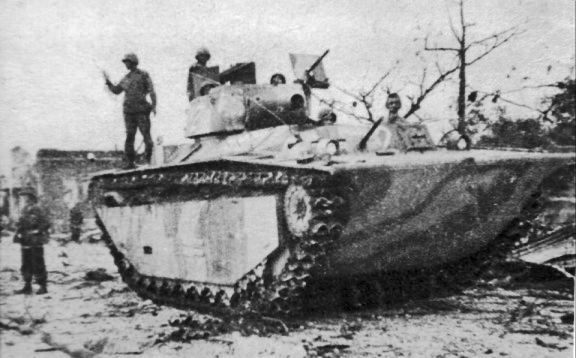
HARRY S. SLOTH - COMPANY A: As our infantry attacked, setting much of the town afire, I went into a small burning building. From one of 12 small desks inside, I pulled out a child's comic book. Its color cartoons showed Jap planes bombing our Statue of Liberty and White house.
BRONZE STAR Citation for LARRY I PEEPLES - COMPANY A: "For heroic achievement in action against the enemy on 3 July 1944 ... Volunteering for a patrol into enemy territory with one other sergeant, Sergeant Peeples made his way to an armored amphibian, previously put out of action by the enemy, and disabled the weapon to prevent its use against our own troops. The partrol also found two missing members of an armored amphibian. The patrol safely made its way back to the company commander with valuable information. His courage and devotion to duty were in keeping with the hightest traditions of the United States Naval Services.
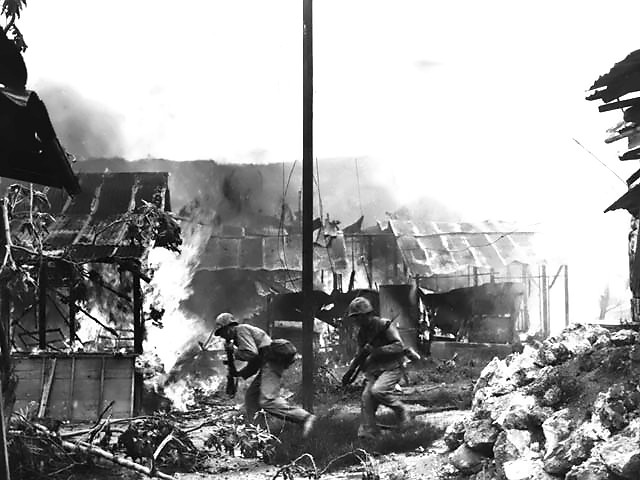
ROBERT C. ROSE - COMPANY D: (Via VIOLET ROSE) Simon Miller and I stood watch from 4 A.M. to 8 A.M. then went souvenir hunting in Garapan before our lines had moved through and beyond the city. We'd been going in and out of buildings when Simon mentioned that some bullets flying about were coming from the direction of our Marines. Then it dawned on us that we were behind enemy lines. We ran into a house to wait for our troops to catch up. Three Japs inside were firing into our guys. Fortunately we spotted them first, so took them out. Then we hurried back to our people, and didn't get a single souvenir that day.
ROBERT E. WOLLIN - COMPANY D: We moved into a house on Garapan's south edge, kept a wary eye on the shoreline, especially at night, and did reconnaissance work into foothills just east of town.  Click to EnlargeNearby chickens slowly disappeared down out gullets. So did a water buffalo after he'd helped haul us stuff. Garapan fell on 3 July. We found sacks of Jap money scattered around a bank, a wind-up record player and a few unbroken records that we played them morning to night. I found a pair of hand carved underwater goggles.
Click to EnlargeNearby chickens slowly disappeared down out gullets. So did a water buffalo after he'd helped haul us stuff. Garapan fell on 3 July. We found sacks of Jap money scattered around a bank, a wind-up record player and a few unbroken records that we played them morning to night. I found a pair of hand carved underwater goggles.
HERB CRACRAFT - COMPANY A: We'd filled our amtank pontoons full of booze from a Garapan liquor shop, would have sunk going back out in the water. M. NEIL MUMFORD: It was more a warehouse, stuffed with cases of Sake. Having drunk all we could we wanted to hide the rest, but where? B. J. Harris suggested "Why not dig a hole that's lined up with that destroyer there out in the water." We did. Going back a few days later we found the destroyer and hole gone.
After Garapan fell the 2nd Division spent a busy Fourth of July. The 3rd Battalion, 2nd Marines took 3 Mutcho Point to the north by 0900 ... by 1000 the 2nd Marines were on the beach at Tanapag Harbor ... That afternoon Marines using amtanks cleaned out defenders trapped in the Boat Basin. 22/ GLENVILLE D. BARRINGER - COMPANY A: Pushing into Tanapag Harbor we shelled the breakers and bunkers then our amtank hung up on something underwater. We went over side and got in among the bunkers, tossing in grenades. Another amtank later pulled ours off what had caught it.
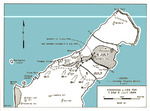 Click to EnlargeJAMES D. MACKEY - COMPANY C: We helped the 3rd Battalion go up through Garapan then moved beyond Tanapag Harbor.
Click to EnlargeJAMES D. MACKEY - COMPANY C: We helped the 3rd Battalion go up through Garapan then moved beyond Tanapag Harbor.
CHARLES G. FULTZ - COMPANY A: With E. L. Bailey as Tank Commander plus Kaczmarek, Balsano and Barringer, we moved up the coast past Garapan, watching for Japs coming down offshore toward Tanapag Harbor. A bullet ricocheted off the amtank then hit my helmet before it fell into my lap.
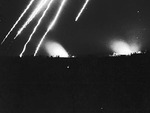 KEITH NEAL: At night, after moving up the coast during the day, we watched big red shells slowly arch up and over us and down into targets up beyond Garapan. The 16 inch shells big as garbage cans were coming in from the sea, beautiful sights that kept many a Jap from sleeping at night. HAROLD B. LITZ: At night we'd watch the lazy arc of big shells our Navy was firing into Saipan's north end.
KEITH NEAL: At night, after moving up the coast during the day, we watched big red shells slowly arch up and over us and down into targets up beyond Garapan. The 16 inch shells big as garbage cans were coming in from the sea, beautiful sights that kept many a Jap from sleeping at night. HAROLD B. LITZ: At night we'd watch the lazy arc of big shells our Navy was firing into Saipan's north end.
JERRY D. BROOKS - COMPANY C: On 7 July a large Jap banzi attack of several thousand Japs came down from Makunsha just before dawn. This surprised the US Army up around Tanapag Harbor, hitting a 500 yard gap between two army battalions and other weak points in the Army lines, so the Jap horde on their rampage picked up a bunch of US yardage. It smashed through Tanapag and, tangling up with US Army soldiers, the rampage took another 800 yards to the south, going butt up against a US Army Regimental CP and then, passing around it, the horde smashed into the Tenth Marine artillery that did most of the killing, much of it by canister fired at point blank range. We were rushed north to help finish killing that the Marine artillery had left over and help to reclaim the lost yardage, and horror left reeking within it. In one spot, we confronted some 500 mostly dead Japs jumbled up into killing grounds maybe the size of a football field. By then I knew that the best way to tell a dead jap who didn't stink was to test how hard he was. A dead Jap stiffened in a few hours. I'd learned this early on Saipan when I poked a not yet bloated pair lying beside a light machine gun. Both had felt hard to my untutored touch, but 30 minutes later, going back the way I'd come, I discovered those two Japs and their machine gun gone. Somebody had snatched only these two corpses and their light machine gun, fetched all three out from all the mangled carnage still piled up and strewn about just as I'd left it 30 minutes before - no way did that happen - so I made a mistake. So from then on I stuck enemy battlefield bodies hard. In any case, on 7 July, I recall in particular one Jap who, flushed out of a hole in that killing field, came up jabbering and, pointing his sword at his gut, he held its handle with both hands, as if about to kill himself, before he came charging at us, waving his sword around in the air, whereupon we shot him. That last Banzai charged roiled out into the water too. A bit later two Marines waded out to the reef offshore to inspect a seemingly abandoned light tank. As they approached the tank a Japanese bayonet sailed out of its open hatch, landing harmlessly in the water. The Marines replied by sailing a pair on grenades neatly into the still open hatch. Ammo cooked off inside, finishing off the Jap inside as black smoke billowed up out the hatch. That night things remained unstable. Japs lay strewn in front, behind, and to our right, and Japs floated in the water to our left, and not all had gone to their reward. Dead bodies in water shifted around, moving slowly back and forth in unison. Anything that 'didn't go with the flow' caught our attention quick. Dispatched to its reward, it began shifting like the rest. Things got back under control the next day. A Marine bulldozer was digging long trenches and pushing Japanese bodies into it, clearing up a horrible scene. The awful stench lingered everywhere, particularly in our clothes, and wouldn't wash out. The odor penetrated even the handles on Jap swords unless they were recovered quick enough. Death was all over that island. You couldn't get away from it. In wind blowing wrong, you'd vomit.
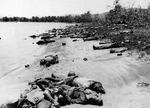 Click to Enlarge (caution graphic)JACK HARVEY - COMPANY C: Bill Dean and I were positioned along the beach north of Tanapag Harbor where hundreds of dead and not so dead enemy from their 7 July night Banzai charge, floated in the water or lay out along or just inland from the beach. But we dug in too close to the water. The rising tide carried the dead floating in over us. We had to shove them away with sticks, and stay alert for the live ones. That stick duty was awful.
Click to Enlarge (caution graphic)JACK HARVEY - COMPANY C: Bill Dean and I were positioned along the beach north of Tanapag Harbor where hundreds of dead and not so dead enemy from their 7 July night Banzai charge, floated in the water or lay out along or just inland from the beach. But we dug in too close to the water. The rising tide carried the dead floating in over us. We had to shove them away with sticks, and stay alert for the live ones. That stick duty was awful.
ROBERT E. WOLLIN - COMPANY D: That Jap counterattack out of Makunsha down to Tanapag Village penetrated 1500 yards. We helped retake lost ground and then we pushed north to Marpi Point, firing from the sea to help Marine infantry root out enemy onshore. We scouted ahead, tallying enemy strength, locating them in coastal caves, killing those we could then calling in the Infantry. We guarded the reef against enemy action at night, laying down flanking fire, stopping Jap counter thrusts trying to slip in behind our infantry ashore. Our platoon supported the 2nd Battalion, 23rd Marines. Lt. Ambrose was attached to Lt. Col. Dillon's staff, the infantry CO. His radio man with backpack radio in our tank kept up with the infantry's needs and movements as we squeezed the enemy into Saipan's north end. We ran 8 tanks round the clock for days, stopping only to refuel, pick up food and ammo, every 8 to ten hours.
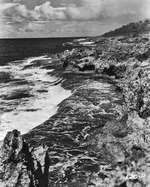 SAMPLE SECOND PLATOON LOG FILED BY LT. CHARLES AMBROSE, CO COMPANY D: "After reaching 266 tare, this platoon received orders from Lt. Col. Dillon, 2nd Bn, 23rd Marines (Pelican) to shell Japanese troops in caves along the shore of 272 Q.V. Three LVT(A)4's were used in an inverted V echelon to the left, and their formation approach was made to within eighty yards from the shore. Here, shelling ceased, on orders of Orlando Dog, after approximately twenty rounds per turtle had been fired. Statistics supplied by men under command of Lt. Col. Dillon indicated 194 Japanese killed. Ammunition used: H.E. delayed. Time: 1500 9 July 1944. (Next) an entire beach in vicinity of 272 M&I was saturated with 75 mm fire. Again H.E. delayed was used. An estimated eighty Japanese killed." Note: Click to Enlarge photo by Don C. Newey. Go to dnewey.smugmug.com/History.
SAMPLE SECOND PLATOON LOG FILED BY LT. CHARLES AMBROSE, CO COMPANY D: "After reaching 266 tare, this platoon received orders from Lt. Col. Dillon, 2nd Bn, 23rd Marines (Pelican) to shell Japanese troops in caves along the shore of 272 Q.V. Three LVT(A)4's were used in an inverted V echelon to the left, and their formation approach was made to within eighty yards from the shore. Here, shelling ceased, on orders of Orlando Dog, after approximately twenty rounds per turtle had been fired. Statistics supplied by men under command of Lt. Col. Dillon indicated 194 Japanese killed. Ammunition used: H.E. delayed. Time: 1500 9 July 1944. (Next) an entire beach in vicinity of 272 M&I was saturated with 75 mm fire. Again H.E. delayed was used. An estimated eighty Japanese killed." Note: Click to Enlarge photo by Don C. Newey. Go to dnewey.smugmug.com/History.
ROBERT E. WOLLIN: Between the infantry ashore and our 2nd and 3th Amtank Platoons offshore, we had the enemy constanty on the run. We saved the lives of many Marine infantrymen who did not have to clean out those caves one by one in the cliffs along the shoreline. We did that job. We saturated the Jap shoreline positions with cannon and machine gun fire until the area turned completely quiet. Then Lt. Col. Dillon would send his troops down through our fire zone and they'd report the enemy had been annihilated. At night one of our two platoons took reef duty ofshore. Before we started that duty the enemy would swim or paddle out onto the reef at low tide at night and move south a 1000 yards or so to get in behind our lines, and kill or wound Marines. We stopped that cold. Nothing could get through our lines.
WILLIAM HOOVER - COMPANY D: A Marine Infantryman onshore pointed to where he'd seen 20 to 30 Japanese Infantrymen wade through a 4 foot high tide into a cave entrance. On our approach I could see the cave went back several yards then angled right 45 degrees. We fired off several rounds and heard screaming. When it stopped we yelled inside telling them to surrender. Machine gun and rifle fire answered us. Then out sailed several grenades. We answered back with 10 rounds of 75 mm HE. Seawater stained red was flowing out the cave when the Marine infantrymen went inside to make sure the cave was secure. They returned to report 50 or so dead Japanese soldiers, and a dozen dead civilians. I regret those dead civilians to this day. But we could not leave the Japs soldiers behind (at our back). Nor would I do it now. (Note: see kilroywashere.org/003-Pages/Hoover/03)
JOHN C (BIFF) CRAWLEY - H&S COMPANY: After we helped recover the area north of Tanapag Harbor retaken by the Japs in their last banzai attack, Gunny Sgt. Pierce and I in Garapan spotted a parrot in a tree. He climbed up, got the parrot and trained it to say: Togo, Eat Shit. It was crazy. We were lucky a Jap sniper didn't nail us at the time.
 ORIE F. MORGAN - COMPANY B: I went up north to Tanapag Harbor in an ambulance jeep with our Doctor. We tended to civilians, some wounded, others hurt, all rescued by Company A amtanks from caves along the shore. Our amtank crew went back north again and again, trying to find civilians to rescue.
ORIE F. MORGAN - COMPANY B: I went up north to Tanapag Harbor in an ambulance jeep with our Doctor. We tended to civilians, some wounded, others hurt, all rescued by Company A amtanks from caves along the shore. Our amtank crew went back north again and again, trying to find civilians to rescue.
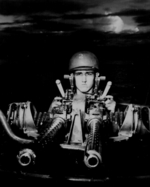 PT boat - CLICK TO ENLARGELEO R. RODWELLER - COMPANY C: We put our amtanks offshore north of Tanaapg Harbor to stop Japs from flanking our lines. One night Navy boats approached, firing at us as we moved into position. It took near misses, frantic radio calls, and flares from us and the beach before the firing stopped. Sorry Marines, didn't know it was you, a US Navy guy shouted.
PT boat - CLICK TO ENLARGELEO R. RODWELLER - COMPANY C: We put our amtanks offshore north of Tanaapg Harbor to stop Japs from flanking our lines. One night Navy boats approached, firing at us as we moved into position. It took near misses, frantic radio calls, and flares from us and the beach before the firing stopped. Sorry Marines, didn't know it was you, a US Navy guy shouted.
JACK W. WHITIS - COMPANY D: On night watch up in our turret with Jack Schrader's amtank to my right, we heard a boat out quite a way. We gave it a light but got no reply so signaled it again. We don't have a light, a voice said in the dark. Get one or we'll blow you out of the water, we fired off two 50 Cal. bursts. A light flared.
GEORGE STEINHEIMER - COMPANY D: We kept on repairing as many amtanks as we could and took H&S Company mechanics south one day to Charan-Kanoa to retrieve some amtanks abandoned by the US Army's 708th Amphibian Tank Battalion. Inside we found lots of food rations, empty shell castings, even bullet proof vests among clean clothes and socks, all of which we sure needed. The Army amtanks were like ours and in pretty good shape, except for stuff like dead batteries, broken grousers, and engines needing a tune up. Back home we dressed them up in US Marine camouflage quick, then put them to good use, in action, including on Tinian. Company D took at least four to Tinian.
CORNELIUS J. VANDERKOLK - COMPANY C: I joined the Battalion before the Marpi Point operation was over. I knew something about amphibian tractors (LTVs) but nothing about armored amphibians, LVT(A)4s. Sergeant Bill Watkins taught me how the crews operated the vehicle as well as all about the 75mm Howitzer. He was great. I especially appreciated all the help and good advice received from "Regulars" like Sergeant Watkins and Gunny Sergeant Ed Chapman. No one could have had a better bunch of guys that were in my platoon of the 2nd Armored Amphibian Battalion. (Note: Lt. Vanderkolk replaced the wounded Lt. Hirshbrunner as Platoon Commander.)
JERRY D. BROOKS: Cornered up at Marpi Point, the Japs started killing civilians, whole families - fwomen, children, old men - forcing them off the high cliffs then blew up themselves with hand grenades. I couldn't figure it out. Why didn't the Japs didn't go down fighting to the last man, killing as many of us as they could. Instead they blew themselves up.
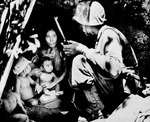 Click to OpenKENNETH E. SMITH - COMPANY D: North beyond Tanapag Harbor we used loudspeakers along the shoreline, trying to talk civilians out of killing themselves with hand grenades or by jumping off the cliffs. Jap soldiers were helping, even forcing, men, women, and children to kill themselves. Our gunner up in the turret, looking through the gunsight, I sighted in three Japs drinking Sake. After finishing off the bottle, they started shooting at us. A few bullets hit the turret. With them in my sights, I told Gunny Liberatore I could finish them off easily at the 250 yards or so. "Let them go" was his reply. I was always glad he said that. They'd have ended up duck soup, but some civilians that managed to survive the Jap soldiers might have been hit by my fire.
Click to OpenKENNETH E. SMITH - COMPANY D: North beyond Tanapag Harbor we used loudspeakers along the shoreline, trying to talk civilians out of killing themselves with hand grenades or by jumping off the cliffs. Jap soldiers were helping, even forcing, men, women, and children to kill themselves. Our gunner up in the turret, looking through the gunsight, I sighted in three Japs drinking Sake. After finishing off the bottle, they started shooting at us. A few bullets hit the turret. With them in my sights, I told Gunny Liberatore I could finish them off easily at the 250 yards or so. "Let them go" was his reply. I was always glad he said that. They'd have ended up duck soup, but some civilians that managed to survive the Jap soldiers might have been hit by my fire.

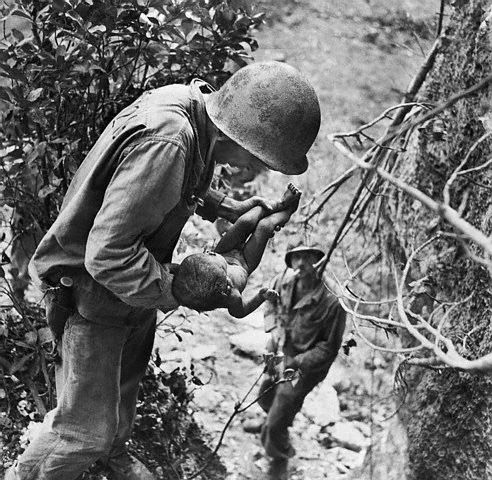 W. Eugene Smith
W. Eugene Smith
E. FRANK GAMBLE - COMPANY B: Ordered north to Marpi Point at battle's end, we fought Jap soldiers and tried to save civilians from jumping off the cliffs, or being pushed off. Below the cliffs we turned our tracks against the current, holding our position in the water as we picked up an elderly man, a small boy in a coma, a woman with a new-born baby. Going back to Tanapag we stayed 400 to 500 yards offshore but a Jap bullets got Howard DeWitt anyway. Shattering on the turret it sent slivers into his behind. At Tanapag Harbor we unloaded our passengers, bummed 50 gallons of gas, and returned to our area.
ROBERT E. WOLLIN - COMPANY D: Soldiers got among the civilians up on the seaside cliffs and encouraged people to jump, saying we Marines would torture them. Many jumped or blew themselves up despite our loud speakers from the water below urging them not to. Soldiers were also blowing themselves up with grenades.
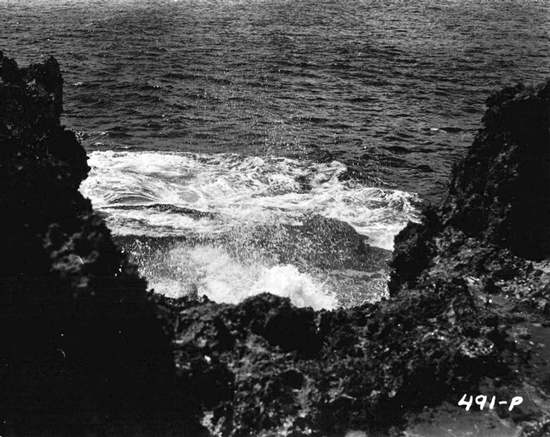 Photograph by Don C. Newey. Go to: dnewey.smugmug.com/History
Photograph by Don C. Newey. Go to: dnewey.smugmug.com/History
CANARA CARRUTH - COMPANY D: W e arrived in three amtanks, mine in the center. It was terrible, people sailing down toward us, hitting the rocks. Blood awash tinted seawater red. We kept all but one Jap soldiers from scrambling to cliff base to finish off any jumpers who survived. He charged us, throwing a grenade. One of our crew shot and killed him.
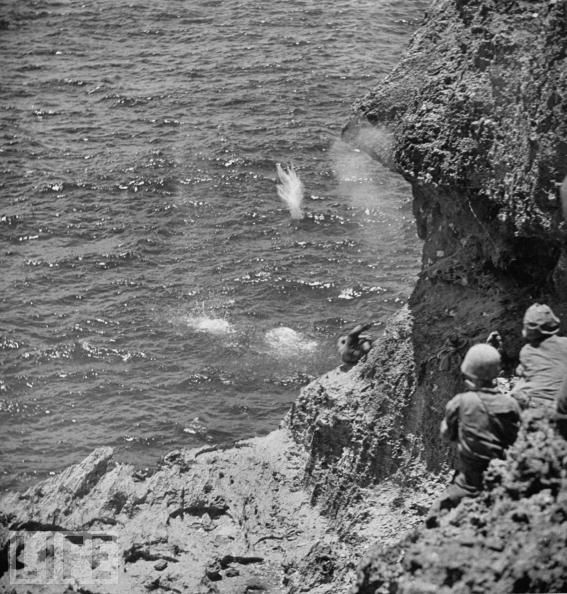 SUICIDE CLIFFS AT MARPI POINT W. Eugene Smith
SUICIDE CLIFFS AT MARPI POINT W. Eugene Smith
WINTON W. CARTER - COMPANY B: Below the cliffs corpses floated around us. Many had jumped or been pushed. Afraid of being captured by Americans, hundreds jumped. A nude young woman held a naked infant in her arms. Stop! I yelled. She didn't and plunged down in front of us. Our amtank driver took our engine out of gear, but the tank's momentum carried us over the bodies. She was turning slowly over, still holding her baby.
JAMES D. MACKEY - COMPANY C: Saipan was declared secured on July 9... a technicality rather than a truth. We returned to our Battalion area south of Garapan and took over a Jap shack with canvas over a galvanized roof. It kept the rain off us. We had bananas hanging in a lean-to-shed. We fought flies during the day and mosquitoes at night. Aircraft came in low level spraying DDT soaking us and all living things. Nearly sick from the DDT we came down with dengue fever too.
CHARLES H. ORLOSKI: 11/7 Diary: Services and Mass were held at the 2nd Division Cemetery for the dead.
WAYNE TERWILLIGER: The 1st day on Saipan is mostly a blur but I recall the moment I saw my first dead Marine, a young Lieutenant who'd only made it a few steps onto the beach. He had his helmet on, not a mark on him, looking like he was just sleeping, but clearly dead. I recall every detail, even his wristwatch. Closing my eyes now I still see his face, how young he looked. An American League empire looked a lot like him. Whenever I saw that umpire years later, I remembered that young face. ( Wayne Terwilliger played for Cubs, Dodgers, Senators, Giants, and Athletics after the War. 3A/)
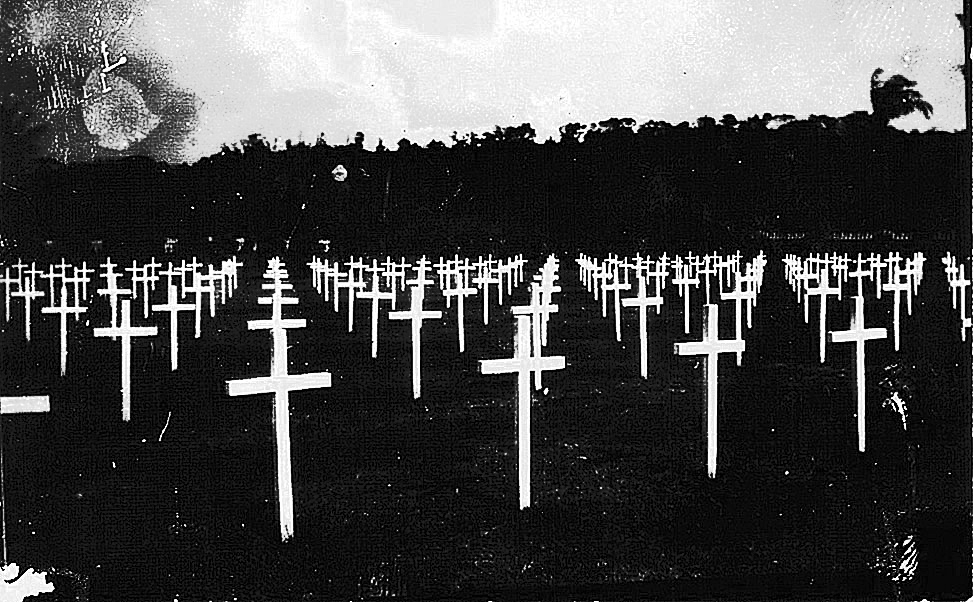
Note: Saipan was declared secure on 9 July but on 13 July an amphibious landing by a 2nd Armored Platoon had to wrest Maniagassa Island (off Tanapag Harbor) from a garrison manning a light machine gun in a pillbox. The amtanks led assault of 3rd Battalion, 6th Marines killing 18 of 31 defenders before resistance ended. Mopping up Saipan lasted for weeks. Months later the last Japanese holdouts surrendered or were killed.
Learning that Saipan had fallen, Fleet Admiral Osami Nagano, Supreme Naval Advisor to the Japanese Emperor declared that: "Hell is upon us."
Japan's Premier Hideki Togo declared that: "Japan has come to face a unprecedentedly great national crisis." One month later he and his entire War Cabinet resigned in disgrace.
GENERAL HOLLAND M. SMITH later said: I have always considered Saipan the decisive battle of the Pacific offensive ... Saipan was decisive because it varied the Pacific drama in all its subsequent scenes. 23/ The general also believed that the Battle for Saipan marked the birth of the modern US Marine Corps. 24/
REED M. FAWELL - The history of our Battalion was initiated in November of 1980 by a Company D officer, Robert E. Wolin. He died in 1982 ... Had he lived to complete his work, he would have dedicated it To those who didn't return and made it possible for us survivors.
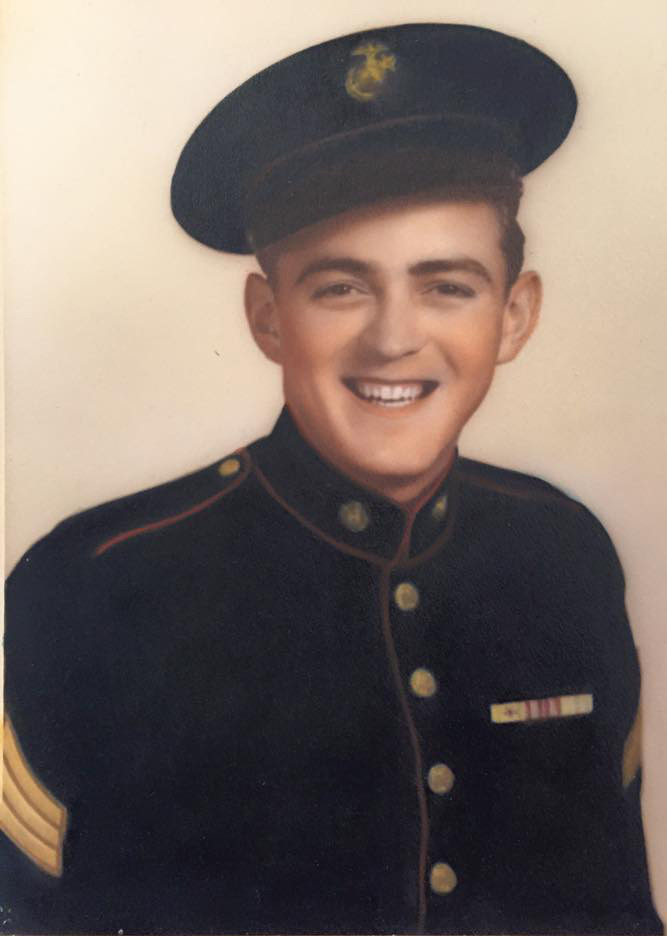 Sgt. John W. Mahan
Sgt. John W. Mahan
SAIPAN: KILLED IN ACTION, DIED OF WOUNDS, MISSING IN ACTION & PERSUMED DEAD
COMPANY A:
Private First Class JOHN B BALLEW - Gunnery Sergeant HENRY N BYXBE
Corporal JOHN E CORRADO Jr - Corporal ROBERT L EICHMAN - Private GEORGE C ESTRADA
Private First Class WILLIAM C LARIMER - Corporal RALPH S MADISON - Sergeant JOHN W MAHAN
Sergeant CARL R MCPHERSAN JR - 2nd Lieutenant PHILO R PEASE - Private BRUCE H PRESTA
1st Lieutenant JAMES R PRICKET - Sergeant JACK E SHELLY - Corporal ROY E SNIDER
Private DELBERT H GRIFFITH - Private First Class CARL C W MAUE
Staff Sergeant JAMES H WEBB - Private GUS E EVANS - Private DELWYN R CARLSON
COMPANY B:
2nd Lieutenant MYRON B. CARSTENSEN - Captain HENRY H N SHRIVER
Private TRUMAN L. LURGAR - Corporal FRANK G BENNING JR
Private First Class MERLE G MCVEY - Private CLIFFORD LASLEY - Private STEVEN J SRSTKA
COMPANY C:
Private First Class ALVIN O CALDWELL - Private First Class NATHANAEL EVANS
Private RICHARD F FRANDSEN - Private First Class PAUL M. MCDANIEL
Private First Class ROBERT B LEWIS - Private First Class WILLIS O OFTEDAHL
Private First Class John A. Bistline
COMPANY D:
Captain KENNETH D HANDYSIDE - Private First Class WILLIAM R HARRIMAN
Private First Class AL S JACOBSON - Corporal THOMAS L. KIELY
Private First Class JOHN R. KILGORE - Private First Class FRANK E MARKASKY
Private LEO FLETCHER - Private First Class LEWIS N. ZIMMERMAN
Private First Class WILLIARD R PRIEST - Private First Class CHESTER R SCIVETTI
WOUNDED IN ACTION ON SAIPAN
COMPANY A:
A. L. ALLEN - D. R. ANDERSON - G. D. BARRINGER - W. H. BRENCE - P. B BUFF - J. D. CHRISTIANSEN
A. E. CURTIS - F. B. DAWSON - C. V. DELLINGER - J. B. FLETCHER - J. B GARNER JR. - F. V. HILL
F. J. HORVATH - R. L. HOYT - A. R. JONES - R. H. KEARNEY - P. E KILPATRICK - P. J. LACOURSE
R. J. LEE - E. MANSARD, JR. - G. E. MATTHIAS - J. R. MCCARTER - M. C. MCCARTHY - L. C. MELMS JR.
K. F. MORFORD - J. F. NICHOLS JR. - W. J. NICHOLS - H. L. NIXON - C. J. PALMER - L. I. PEEPLES
R. H. SANDERS JR. - N. N. SCHANTZEN - V. R. SHIPP - W. A. SMIALEK - G. M. STEWART - D. VICULIN
G. E WIITALA
COMPANY B:
E. J. ALLEN - C. L. BOPP - H. E. DEWITT - H. W. DOWELL - H. O. HERMAN - O. D. HEWITT - O. W. HYDE
J. K. INGRAM - R. B. JONES - J. H. R. LAMPERT - A. E. LEARY - M. E. MCKELVEY - S. H. H. MCNEILL JR.
M. H. POLLOCK. JR. - J. N. RONEY - B. SIMPSON - N. L. STEPP - W. E. STORM II - M. M. TRUE
H. P. WELDON JR.
COMPANY C:
W. C. ABLES, F. D ALBRICK - D. L. BULLOCK - L. C. BURTON - R. W. DEVITT - P. A. HIRSHBRUNNER
R. Z. MICHAEL JR. - H. C. RAWLS - R. J. ROZIVKA - E. E. SANCE JR. - K. H. VAN BEBBER
COMPANY D:
C. F. AMBROSE - T. L. BING - J. L. BISHOP - H. E. BLANKENSHIP - B. A. BRANCH - R. DEROECK
D. R. ENRIGHT - J. C. GANNT - R. L. GUILD - J. N. GUTHRIE - R. C. HALDER - J. G. HARTMAN
D. A. KOENIG - H. J. LIBERATORE - O. S. LOWE - W. G. MANNER - D. R. MICHAELS - E. C. NORTON
J. N. RICE - G. V. ROBERTS - R. O. SHERMAN - R. M. SMITH JR. - H. F. SPRINGER - B. L. SWEAT
J. O. TIPPERY - G. E. WARD - E. E. WAY - J. G. WILBER - R. W. WOLLIN - P. J. YARCHO
H & S COMPANY:
L. L. COOKE JR - L. H. DUNCAN - W. D. JAGGER - T. B. OLDSEN - J. M. REHL
For Full BATTALION ROSTER of men IN THE FIELD AT SAIPAN, SEE this website's ROLL CALL SECTION.
For the Battalion's After Action Report on Saipan, and official reports on performance of the LVT(A)4 amphibian tank in combat on Saipan, see this website's Amphibian Tank Section.
CREDITS:
REED M. FAWELL - BATTALION: On Robert E. Wolin's death in 1982, work on the battalion history was taken up in 1989 and completed in 1991 by 101 Battalion members these many years after the amphibious assault landings on Saipan, Tinian, and Iwo Jima. Speical thanks goe to Robert C. Rose, Robert Wollin, Charles Ambrose, Bernard G. Thobe, Hadrian J. Liberatore, and Jack W. Whitis, key Marines in the Battalion who worked successfully over several decades after WW11 to locate Battalion members, create the battalion Association, and/or keep it alive.
CREDITS - Ultimately a total of 107 men of the 2nd Armored Amphibian Battalion from all five companies pooled their REMEMBRANCES, DOCUMENTS, PHOTOS, etc, and RESEARCHED, WROTE, REVIEWED, and COMPILED their Battalion's military history as set out in 2nd Armored Amphibian Battalion USMC WW II, ISBN - 9656571-0-7 and/or later furnished more oral histories to this site's web creator Reed M. Fawell 111 who also collected and researched additional documentary and archived material. All this was then edited, reordered and supplemented by extensive narrative written into text and added into footnotes by Reed M. Fawell 111 and placed into this digetized narrative format by the website creator Reed M. Fawell 111 starting 2011 and ongoing as of the spring of 2015. Copyright © 1991 2nd Armored Amphibian Battalion Association per ISBN -0-9626571-0-7 & Copyright © 2011 Reed M. Fawell 111, website creator. All rights reserved.
Well over 1200 men served in the Battalion during its short life (from 24 Jan 1944 to 30 Nov 1945). Many of their memories, actions, individual experiences and achievements that are important parts of the Battalion's history are not recorded in the 2nd Armored Amphibian Battalion USMC WW II, ISBN - 9656571-0-7, or here, BUT ARE AND ALWAYS WILL REMAIN, criticial to the history and achievements of the Battalion. Thanks are also due to the US Marine Corps Achives and Special Collections at Quantico Va., for their documents and collections and the valuable assistance they rendered in accessing them.
The Battalion history contains a Special Note: The Japanese soldier fought a bravely as any warrior the world has ever seen. (Note: After the war Cornelius J. Vanderkock said: Next time let's be sure the Japanese are on our side.)
FOOTNOTES: Drafting and editing in progress by Website Creator as of the fall and winter of 2015:
(Footnotes & Photo Credits throughout site are under construction. Photos of other units in other battles are used herein for purposes of illustration. These will be idenified and credited as to unit and campaign as notes are edited and completed. All of website is under contruction daily as of 2015 by Reed M. Fawell III. AWWII Marine Amtank Battalion history in the Pacific including photographs will be included in the companion Website at amphibiouslanding.com)
1/ Coral and Brass, by Holland McTyeire Smith, C. Scribner's Sons (1949)
Footnote 2/ Eight months after Pearl Harbor (in August 1942) Admiral Ernest J. King countered the rising Japanese threat to US sea and air lanes of transit to New Zealand and Australia by ordering US Marines to seize two obscure enemy outposts: a seaplane base at Tulagi and a foothold on Guadalcanal, across from each other on the Florida straights, deep in the lower Solomon Islands of the South Pacific.
The 1st Marine Division was initially tasked with this job. Its amphibious landings halted Japan at its high water mark in the Pacific and then seized the springboard for later US offensives that rolled Japan back up the Solomon chain for 600 miles to the Bismarck Archipelago off New Guinea. This 14 month campaign proved decisive. It's naval battles, its amphibious landings and its air attacks ousted Japan from the South Pacific. It also 1/ secured America's southwest flank for future operations against the Japanese Empire, 2/ degraded Japan's offensive war machine beyond replenishment and repair, and 3/ gave America the time and combat experience it needed to marshal the forces and skills necessary to launch an altogether new and devastating two pronged attack that delivered that knock out punch that ended the war.
By late November 1943 US landings at Tarawa and Makin in the Gilberts shifted the bulk of the US naval war against Japan squarely onto a bold thrust across the Central Pacific. Then, as General MacArthur pushed up the New Guinea coast, isolating enemy armies on the southern flank, Ernest King's brand new 5th Fleet on the northern flank struck like a knife deep into Japan's Imperial Empire. Japan never recovered. In less than 2 years after Pearl Harbor America had built the strategic position and massed forces with revolutionary capacity, reach, speed and power to hit Japan with two fists that worked in tandem to exhaust and isolate then unconditionally defeat Japan.
 Click to enlargeErnest King's Central Pacific sea-borne offensive was ambitious. His battle fleet would destroy Japan's carrier air power while its amphibious forces destroyed enemy armies in their island strongholds across the Central Pacific. This campaign reached its highpoint at Saipan and Tinian. Here it cut Japan's home islands off from its southern Empire, severing its conquered colonial dominions from military resupply, and its industrial home islands from critical resources, while it brought those home islands within the range of US strategic bombers that delivered the knockout punch.
Click to enlargeErnest King's Central Pacific sea-borne offensive was ambitious. His battle fleet would destroy Japan's carrier air power while its amphibious forces destroyed enemy armies in their island strongholds across the Central Pacific. This campaign reached its highpoint at Saipan and Tinian. Here it cut Japan's home islands off from its southern Empire, severing its conquered colonial dominions from military resupply, and its industrial home islands from critical resources, while it brought those home islands within the range of US strategic bombers that delivered the knockout punch.
The campaign, unlike any that had gone before, was audacious. It unleashed sea-borne armadas into air and sea battles across thousands of miles of open ocean punctuated by shock troop assaults launched from ships against island strongholds guarded by fringing reefs. This demanded that great quantities of radically new war machines be built - floating tanks, flamethrowers, strategic bombers, amphibious vehicles with highly specialized uses - then quickly deployed with new ultra modern war fleets - fast battleships, cruisers, destroyers, carriers of sea-borne air forces. These combined forces had to work closely together, doing highly interdependent tasks, to rapidly engage enemy battle groups in radically new joint land, air and sea operations of great complexity on a massive scale using revolutionary weapons systems that required new strategies & tactics, all done over land and open ocean while deployed thousands of miles from home base.
Fighting was the smallest part of the job. Whole fleets had to be built to transport, launch and supply these fleets of amphibious armies and supply and maintain the fleets of heavy gunfire ships and sea-borne airforces. Equally important it required the sea and air lift and managerial skills to build and coordinate huge sea-borne logistics trains that were capable not only of maintaining these fleets, seagoing armies and air forces, but the islands they seized and installations built in their wake - ports, depots, bases, airfields across the Pacific.
To do all this required that hundreds of thousands of men be trained to do thousands of new tasks - underwater recon and demolition, amphibious assault, complex communications - amid the chaos of war waged on massive scale across the world's largest ocean against a determined enemy. From its grand strategy to its fine detail, from its choreography of combined arms to the multiplicity of its successes, Admiral Ernest King's Central Pacific Campaign was unique. And the Admiral's demanded that it all be done fast. Here's how fast.
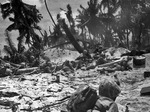 Click enlarges Tarawa BeachOn 20 Nov. 1943 the Central Pacific Campaign was launched against Betio in Tarawa Atoll by a Fleet and Amphibious Force activated only 60 day earlier and first assembled the night before its D-day assault. At Betio 87 amphibious landing craft (LVTs) landed 1500 marines onto its beaches in 15 minutes. Despite valiant D-Day efforts to land another 2500 Marines, barely more than 3000 Marines clung tenuously to the beaches by nightfall. Confronting a debacle, the Marines prevailed. Seven months later the same Fleet and Amphibious Force launched 719 LVTs that landed 8,000 Marines from the sea onto Saipan's beaches in 20 minutes. 20,000 Marines got ashore by nightfall despite fierce resistance. So began America's three island Marianas' assault by 127,500 troops and US Fleet that destroyed enemy carrier air power in the Central Pacific.
Click enlarges Tarawa BeachOn 20 Nov. 1943 the Central Pacific Campaign was launched against Betio in Tarawa Atoll by a Fleet and Amphibious Force activated only 60 day earlier and first assembled the night before its D-day assault. At Betio 87 amphibious landing craft (LVTs) landed 1500 marines onto its beaches in 15 minutes. Despite valiant D-Day efforts to land another 2500 Marines, barely more than 3000 Marines clung tenuously to the beaches by nightfall. Confronting a debacle, the Marines prevailed. Seven months later the same Fleet and Amphibious Force launched 719 LVTs that landed 8,000 Marines from the sea onto Saipan's beaches in 20 minutes. 20,000 Marines got ashore by nightfall despite fierce resistance. So began America's three island Marianas' assault by 127,500 troops and US Fleet that destroyed enemy carrier air power in the Central Pacific.
Admiral Richmond Kelly Turner, CO, Joint Expeditionary Force under Admiral Spruance's Fifth Fleet said:
The Marianas Campaign, from an amphibious point of view, had nearly everything: great strategic importance, major tactical moves including successive troop landings on three enemy islands, tough enemy resistance of all kinds, including major Fleet battle; coordination of every known type of combat technique of land, sea, and air; difficult logistic problems, and the build up of a great military base area currently with the fighting. (Turner presentation delivered at General Line School 5 Dec. 1949)
Commodore H. B. Knowles added: The Saipan Landing Plan is a landmark in Pacific Amphibious history, for it incorporates what became the techniques for all later amphibious landings in the Central Pacific and the major assaults in the Philippines ... (Transport Squadron 12, Command History, 8 Nov. 1945, pg. 16)
General Holland Smith declared: The Battle of Saipan marked the birth of the modern US Marine Corps . See 14/ below.
Footnote 2a/ This footnote HAS BEEN MOVED TO FOOTNOTE 25 FOUND BELOW.
3/ Jon T. Hoffman,General Editor, A History of Innovation, U.S. Army Adaption in War and Peace, Center of Military History, US Army, 2009
4/ See Terwilliger Bunts One by Wayne Terwilliger (with Nancy Peterson & Peter Boehm), Insiders Guide, Guilford Press, imprint of Globe Piquot Press, 2006.
5/ - V Amphibious Corps Operational Plans for Saipan dated 3 May 1944 (that encorporate Division Plans dated 27 April) do not anticpate the use of LVT(A)(4)s but using LVT(A)1 amphibian tanks instead. Five days after meeting Lt. Col. Reed M. Fawell, Jr., CO of 2nd Armored Amphibian Battalion, General Holland M. Smith amended the war plans to encorporate the LVT(A)(4)s and require that all relevant After Action Reports answer questions regarding the LVT(A)(4)s namely ...:
...;(2) How were LVT(A)(4)'s (75mm howitzer) employed? How effectively? (3) (What was) Accuracy of weapons while afloat (4) To what depth did amphibian tanks support assault troops? (5) How soon were standard land tanks landed ashore?
General Holland M. Smith also raised issues such as refueling, maintenance, weak points mechanically and armorwise, matters presumably discussed at 3 May meeting with Co. Fawell. See this website's Amphibious Tank for concerns raised by Lt. Col. Reed M. Fawell, Jr. before and after Saipan Battle as well as post battle reports of superior commands and Official Observer's on LVT(A)4's combat performance .
6/ Ernest King drove the accelerated schedule that targeted Saipan. He'd long considered Saipan key to control of the Central Pacific. So after the quick success of US amphibious assaults on the Marshall Islands and the unexpected neutering of the Japanese stronghold at Truk by US Navy carrier air strikes, he determined that speed was essential to ripe the heart out of Japan's outer ring of inner defenses, given Japan's frantic build up of the Marianas' defenses. He also believed that this assault would force Japan's Combined Fleet to confront the US 5th fleet in a major way for the first time since the Gualacanal Campaign nearly two years before, and recognized that Saipan and Tinian's seizure brought Japan's home islands within the range of US Strategic Bombers. Thus King (with the support of the US Army's air chief Arnold) targeted Saipan for 15 June, and radically altered MacArthur and Nimitz's plan to attack on a different target on 15 November.
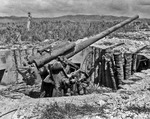 Click 120 Dual Purpose GunErnest King's rationale was simple: we're not ready to attack Saipan in June but Japan will be even less ready to defend it then. Every day we delay shifts an advantage to our enemy. This judgment proved correct. Japans' plan to make Saipan 'impregnable' within 6 months was 25% complete on 15 June. Although US troops encountered 30,000 defenders (instead of 12,000 to 14000 per outdated US intelligence), the surprised enemy was greatly hampered by incomplete defenses. 57 of their heavy artillery pieces, including 35 120mm Artillery pieces, were in storage, loaded for transit to batteries, or at batteries but not yet emplaced. These weapons if ready would have doubled the destruction that rained down on the Marines assaulting Saipan's narrow beaches. As King also predicted, Japan's Combined Fleet sallied forth to defend Saipan with disastrous results. Its offensive carrier airpower was destroyed by US carrier air at the Great Marianas' Turkey Shoot. It lost 428 planes on 19-20 June and 750 aircraft between 15-20 June, plus 18 ships sunk or heavily damaged. US strategic bombing launched from the Marianas led to Japan's unconditional surrender, affirming King's strategic vision. But his accelerated schedule came at a cost. See below.
Click 120 Dual Purpose GunErnest King's rationale was simple: we're not ready to attack Saipan in June but Japan will be even less ready to defend it then. Every day we delay shifts an advantage to our enemy. This judgment proved correct. Japans' plan to make Saipan 'impregnable' within 6 months was 25% complete on 15 June. Although US troops encountered 30,000 defenders (instead of 12,000 to 14000 per outdated US intelligence), the surprised enemy was greatly hampered by incomplete defenses. 57 of their heavy artillery pieces, including 35 120mm Artillery pieces, were in storage, loaded for transit to batteries, or at batteries but not yet emplaced. These weapons if ready would have doubled the destruction that rained down on the Marines assaulting Saipan's narrow beaches. As King also predicted, Japan's Combined Fleet sallied forth to defend Saipan with disastrous results. Its offensive carrier airpower was destroyed by US carrier air at the Great Marianas' Turkey Shoot. It lost 428 planes on 19-20 June and 750 aircraft between 15-20 June, plus 18 ships sunk or heavily damaged. US strategic bombing launched from the Marianas led to Japan's unconditional surrender, affirming King's strategic vision. But his accelerated schedule came at a cost. See below.
7/ Robert Sherrod, On to Westward, by copyright, 1945
8/ US NAVAL GUNFIRE AT SAIPAN:
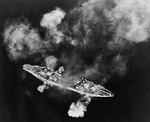 Click enlarges PennsylvaniaGeneral Background - US Naval gunfire, the most powerful weapon in the arsenal of WW II Amphibious Assault, depended upon highly complex weapons systems aboard ships being skillfully operated by Naval Personal using information fed to them by a myriad of different sources. These sources included spotters operating aboard the fire ships, fixed map coordinates that had been earlier provided, spotter aircraft working overhead, fire control parties stationed ashore, Marine liaison aboard ship and onshore, and other ships firing on the line, as well as G-2 and artillery ashore and attack Aircraft overhead. This information changed constantly as targets were identified, bracketed, and destroyed, and as targets moved or new ones emerged, and as lines of battle shifted and forces assembled or dissipated, across an ever evolving battlefield. So targeting informaton was often faulty, incomplete or outdated. Thus naval gunfire into a rapidly changing battlefield confronted major challenges. It was only as effective or ineffective as 1/ the relevance, accuracy and currency of its targeting information, 2/ the skills of those communicating and receiving that information, and 3/ the gunners who engaged the target. Also each target (or target group) often presented unique challenges that needed custom on the spot solutions that required skills learned and honed only in combat, including from mistakes in combat. Such learning carried a heavy price. Shortcomings in naval gunfire (whether they arose from overly aggressive or conservative gunfire or from one error in a long chain of error free executions) often left US troops ashore more exposed to the enemy fire ashore and/or to friendly fire from offshore. Painful mistakes often ensued. These terrible wages had to be paid to gain the last measure and refinement of skills necessary to avoid those mistakes in the future, and assure victory. So on the spot learning was most always hard. Thankfully it often carried with it a flip side. Such is the way warriors must learn to deal with and overcome chaos in combat.
Click enlarges PennsylvaniaGeneral Background - US Naval gunfire, the most powerful weapon in the arsenal of WW II Amphibious Assault, depended upon highly complex weapons systems aboard ships being skillfully operated by Naval Personal using information fed to them by a myriad of different sources. These sources included spotters operating aboard the fire ships, fixed map coordinates that had been earlier provided, spotter aircraft working overhead, fire control parties stationed ashore, Marine liaison aboard ship and onshore, and other ships firing on the line, as well as G-2 and artillery ashore and attack Aircraft overhead. This information changed constantly as targets were identified, bracketed, and destroyed, and as targets moved or new ones emerged, and as lines of battle shifted and forces assembled or dissipated, across an ever evolving battlefield. So targeting informaton was often faulty, incomplete or outdated. Thus naval gunfire into a rapidly changing battlefield confronted major challenges. It was only as effective or ineffective as 1/ the relevance, accuracy and currency of its targeting information, 2/ the skills of those communicating and receiving that information, and 3/ the gunners who engaged the target. Also each target (or target group) often presented unique challenges that needed custom on the spot solutions that required skills learned and honed only in combat, including from mistakes in combat. Such learning carried a heavy price. Shortcomings in naval gunfire (whether they arose from overly aggressive or conservative gunfire or from one error in a long chain of error free executions) often left US troops ashore more exposed to the enemy fire ashore and/or to friendly fire from offshore. Painful mistakes often ensued. These terrible wages had to be paid to gain the last measure and refinement of skills necessary to avoid those mistakes in the future, and assure victory. So on the spot learning was most always hard. Thankfully it often carried with it a flip side. Such is the way warriors must learn to deal with and overcome chaos in combat.
 Click to enlargeFor example, pinpoint naval gunfire supporting an amphibious landing exposed the ship delivering it to greater risk. The ship had to navigate through hazards such as minefields and shoals to move in close to their targets and remain there dead in the water to provide a stable platform for slow, deliberate pinpoint shelling of specific targets. The crew thus offered up its ship as a stationary target for enemy air and submarine attacks and counter battery fire from onshore. These risks carried brutal consequences. The USS Colorado's suffered far more D-Day casualties (240) at Tinian that did the assault troops it protected. So a great question loomed over gunfire support decisions: at what point in a particular case did its risks outweigh its benefits. Decisions were hard. Before the landing at Tarawa, short term and general area Naval Gunfire had proved sufficient cover for getting the troops ashore. Even at Tarawa, where such gunfire was deficient in its destruction of gun batteries ashore, it still disabled the enemy's communication net and killed it's atoll commander and his staff on D-Day afternoon. This likely thwarted a night counter attack that might otherwise have pushed the Marines back into sea. Other external factors also interfered with gunfire support. The Central Pacific Campaign's rapid pace often diverted US Navy ships to other critical tasks. Such as protect the Carrier Task Forces at the Battle of the Philippine Sea that destroyed Japanese air power in the Central Pacific. So the US Navy, as overall theatre and amphibious landing commander, jealously retained control over all naval decisions, including naval gunfire support decisions. Such systemic conflicts of interest assured that the Marines' Best Friend on D-Day and beyond, US Naval Gunfire, remained a constant source a controversy. Despite all the conflicts, everyone made unrelenting efforts to make naval gunfire more effective.
Click to enlargeFor example, pinpoint naval gunfire supporting an amphibious landing exposed the ship delivering it to greater risk. The ship had to navigate through hazards such as minefields and shoals to move in close to their targets and remain there dead in the water to provide a stable platform for slow, deliberate pinpoint shelling of specific targets. The crew thus offered up its ship as a stationary target for enemy air and submarine attacks and counter battery fire from onshore. These risks carried brutal consequences. The USS Colorado's suffered far more D-Day casualties (240) at Tinian that did the assault troops it protected. So a great question loomed over gunfire support decisions: at what point in a particular case did its risks outweigh its benefits. Decisions were hard. Before the landing at Tarawa, short term and general area Naval Gunfire had proved sufficient cover for getting the troops ashore. Even at Tarawa, where such gunfire was deficient in its destruction of gun batteries ashore, it still disabled the enemy's communication net and killed it's atoll commander and his staff on D-Day afternoon. This likely thwarted a night counter attack that might otherwise have pushed the Marines back into sea. Other external factors also interfered with gunfire support. The Central Pacific Campaign's rapid pace often diverted US Navy ships to other critical tasks. Such as protect the Carrier Task Forces at the Battle of the Philippine Sea that destroyed Japanese air power in the Central Pacific. So the US Navy, as overall theatre and amphibious landing commander, jealously retained control over all naval decisions, including naval gunfire support decisions. Such systemic conflicts of interest assured that the Marines' Best Friend on D-Day and beyond, US Naval Gunfire, remained a constant source a controversy. Despite all the conflicts, everyone made unrelenting efforts to make naval gunfire more effective.
So, after naval gunfire's general area shelling left operable most fortifications dug into Betio's 390 acres during the D-day landings at Tarawa, the Navy and Marines replicated then shelled those defenses on friendly soil until they'd learned at what range, velocity, angle of plunge, volume, pace and accuracy of fire, various types of shells dug out then breached and destroyed individual revetments that had proved imperious to naval gunfire at Betio. Sixty days later these lessons leveled enemy defenses on the tiny atolls in the Marshall Islands. But each island and its defences were different. Lessons learned at Betio and the Marshalls failed at Saipan where enemy artillery and mortars dug into high rough country far inland caught the Marines by surprise on the beaches, reeking heavy casualties.
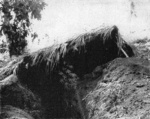 concealed revetment SaipanSo new skills sets, tools and protocols of coordination had to be found that overcame far greater obstacles and risks of error that abruptly rose their ugly head during combat at Saipan. This included such matters as spotting, identifying, targeting and destroying fixed and mobile guns hidden behind distant ridges, within jungled ravines and caves, and scattered amid dense shrub across a vast corrigated landscape rising and falling beyond a 10,000 yard long and highly irregular beachhead that was itself flanked by a highly convoluted 12 mile long island. This opened a pandora's box that presented obstacles far more complex than ships having to destroy batteries clustered on small flat atolls. The hyper-pace Central Pacific Campaign compounded the challenges. With so little time between operations, squabbling over which targets came next and with every target different, only trial and error of men working amid the chaos of combat revealed surprises and solutions. This was particularly so in the case of Saipan. Its isolated location combined with its size and topography, along with the profusion of new untested American weapons presented unique combinations of problems that demanded uniquely complex solutions on an everchanging and unusually mysterious battlefield. It's quite a story. It's an historic lesson: how the Navy Marine Team, now too joined by the US Army, adapted and intergrated capacities to meet unique challenges that unfolded before them during combat on Saipan and then refined those often jerry-rigged solutions with great effectiveness during later joint operation assaults on Tinian, Guam, Pelelieu, Philippines, and Okinawa. See 12 & 13B.
concealed revetment SaipanSo new skills sets, tools and protocols of coordination had to be found that overcame far greater obstacles and risks of error that abruptly rose their ugly head during combat at Saipan. This included such matters as spotting, identifying, targeting and destroying fixed and mobile guns hidden behind distant ridges, within jungled ravines and caves, and scattered amid dense shrub across a vast corrigated landscape rising and falling beyond a 10,000 yard long and highly irregular beachhead that was itself flanked by a highly convoluted 12 mile long island. This opened a pandora's box that presented obstacles far more complex than ships having to destroy batteries clustered on small flat atolls. The hyper-pace Central Pacific Campaign compounded the challenges. With so little time between operations, squabbling over which targets came next and with every target different, only trial and error of men working amid the chaos of combat revealed surprises and solutions. This was particularly so in the case of Saipan. Its isolated location combined with its size and topography, along with the profusion of new untested American weapons presented unique combinations of problems that demanded uniquely complex solutions on an everchanging and unusually mysterious battlefield. It's quite a story. It's an historic lesson: how the Navy Marine Team, now too joined by the US Army, adapted and intergrated capacities to meet unique challenges that unfolded before them during combat on Saipan and then refined those often jerry-rigged solutions with great effectiveness during later joint operation assaults on Tinian, Guam, Pelelieu, Philippines, and Okinawa. See 12 & 13B.
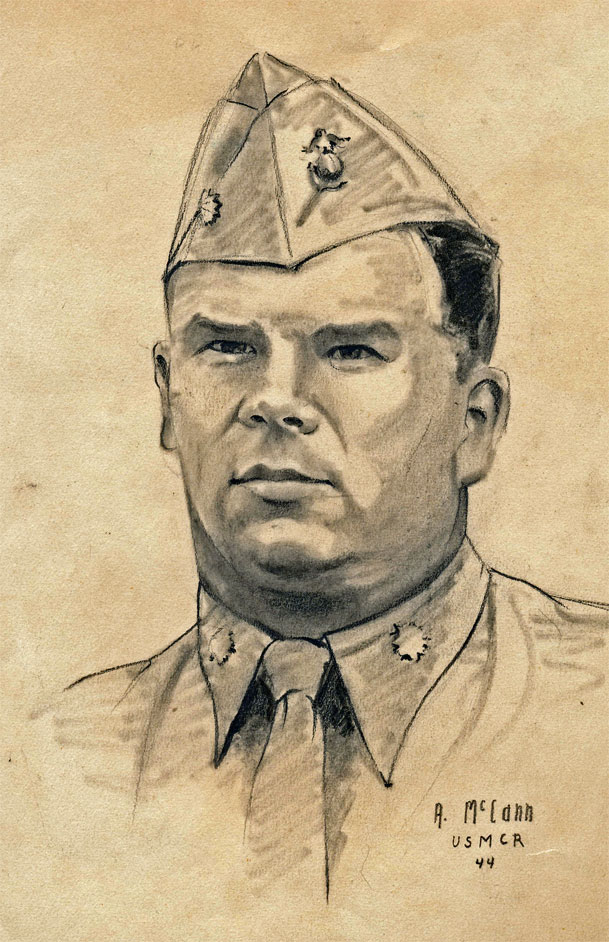 Lt. Col. Van OrmanLt. Col. Ellsworth G. Van Orman USMC played a key roll in US naval gunfire support at Saipan:
Lt. Col. Van OrmanLt. Col. Ellsworth G. Van Orman USMC played a key roll in US naval gunfire support at Saipan:
"For meritorious achievement in action against the enemy Japanese, while serving as Naval Gunfire Officer on the staff of the Commanding General, Expeditionary Troops, Fleet Marine Force, Pacific, during the Marianas Islands Campaign from 15 June to 12 August, 1944, Lieutenant Colonel Van Orman displayed marked foresight, outstanding professional ability in the conception and execution of vital plans, and tireless energy in the discharge of his duties. In the preparatory stages of the campaign, he aided in formulating and putting into operation the plans for the fire support ships. During the operation he contributed greatly to the success of the campaign by his skill in selecting targets and bringing fire to bear on them. To better coordinate Naval gunfire with artillery and air support and to observe the effects of our fire he visited the front lines and was exposed to hostile fire and observation. His devotion to duty, his tactical knowledge, the able assistance he rendered the operations, and his courage, were in keeping with the highest traditions of the United States Naval Service."
Bronze Star citation signed: Lt. General Holland M. Smith for Lt. Col. Van Orman's service at Saipan, Guam & Tinian.
Lt. Col. Van Orman also served as FMF Pac. Naval Gunfire Officer at Gilbert Islands (Nov. 1943), Marshall Islands & Enwietok (Jan.-Feb. 1944), and Iwo Jima (Feb.-March 1945). He was awarded Legion of Merit in 1945 for playing a key roll in US Naval Gunfire support throughout the Central Pacific Campaign. He also served on Guadalcanal (Aug.-Oct. 1942) and the bombardment of Kiska (July 1943). Col. Van Orman was later awarded another Bronze Star for service in Korea.
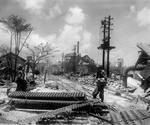 Click enlarges sugar mill13 June (D-Day minus 2) Preparation Naval Gunfire of Task Force 58:
Click enlarges sugar mill13 June (D-Day minus 2) Preparation Naval Gunfire of Task Force 58:
7 new fast Battleships and 11 Destroyers from Task Force 58, firing with plane spot, hit Saipan first. Conducted at long range against pre-determined (mapped) installations, the daylight bombardment lasted nine hours, targeting heavy gun emplacements, power plants, barracks and airfields. The new fast gunships were designed (and their crews trained) to destroy enemy fleets and defend US aircraft carriers at sea so their shelling of Saipan was limited to area firing directed by aircraft spotters without experience in identifying new targets ashore. The Navy was also wary of losing these blue water fleet ships to coastal guns, submarines, mines and air attack, especially since the Japanese Fleet was expected to challenge the US 5th fleet once the threat to Saipan was clear. So the fast Battleships fired from 16,000 yards offshore, the Destroyers from no closer than 10,000 yards, all distances that diluted effectiveness. Many militarily insignificant targets were damaged. Many high value military value were overlooked, especially hidden gun positions. CHARAN KANOA, GARAPAN, AGINIAN POINT, ALITO AIRFIELD, and batteries exposed on points of land near the landing beaches were usefully damaged. Task Force Destroyer's harassed enemy ashore all night into next morning.
14 June (D-Day minus 1) Preparation Naval Gunfire of Task Force 56.2
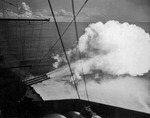 Click to enlargeThe 2nd day of Preparation Naval Gunfire was far more effective. These Landing Force Naval Bombardment Ships - 7 old battleships, 11 cruisers and 26 destroyers - were specially outfitted and trained for precision direct fire on targets not only mapped but also visually spotted from ships offshore and aircraft overhead. The ships' slow, painstaking adjustments of fire on specific targets enhanced pinpoint destruction. Key installations such as emplaced coastal guns were destroyed with close in firing that resulted in onshore counter battery fire damage to the Battleship California and Destroyer Braine. Admiral King's accelerated schedule also forced some errors. There wasn't time to fully train the plane spot personnel for the mission. Nor time to fully minesweep the waters offshore for close in firing. Nor time and ammo to fully complete the pinpoint firing, given its complexity and the press of other commitments, including Guam's assault scheduled for 3 days later. Aerial maps also failed the show, and spotter aircraft lacked the means to survey, Saipan's extensive network of mobile and camouflaged defenses just behind the beaches and those hidden within the high country far behind and flanking the long beachhead. Although US Cruisers and Destroyers conducted harassing fire that night, hidden enemy guns didn't reveal their positions by counter battery fire. Marines coming ashore the next day often had to confront these, and numberous other ugly surprises alone, until these guns were dug out and destroyed, often one by one, the hard way by infantrymen and over the next 25 days of brutal combat ashore, despite the rapid adaption and growing effectiveness of offshore, onshore and overhead supporting arms.
Click to enlargeThe 2nd day of Preparation Naval Gunfire was far more effective. These Landing Force Naval Bombardment Ships - 7 old battleships, 11 cruisers and 26 destroyers - were specially outfitted and trained for precision direct fire on targets not only mapped but also visually spotted from ships offshore and aircraft overhead. The ships' slow, painstaking adjustments of fire on specific targets enhanced pinpoint destruction. Key installations such as emplaced coastal guns were destroyed with close in firing that resulted in onshore counter battery fire damage to the Battleship California and Destroyer Braine. Admiral King's accelerated schedule also forced some errors. There wasn't time to fully train the plane spot personnel for the mission. Nor time to fully minesweep the waters offshore for close in firing. Nor time and ammo to fully complete the pinpoint firing, given its complexity and the press of other commitments, including Guam's assault scheduled for 3 days later. Aerial maps also failed the show, and spotter aircraft lacked the means to survey, Saipan's extensive network of mobile and camouflaged defenses just behind the beaches and those hidden within the high country far behind and flanking the long beachhead. Although US Cruisers and Destroyers conducted harassing fire that night, hidden enemy guns didn't reveal their positions by counter battery fire. Marines coming ashore the next day often had to confront these, and numberous other ugly surprises alone, until these guns were dug out and destroyed, often one by one, the hard way by infantrymen and over the next 25 days of brutal combat ashore, despite the rapid adaption and growing effectiveness of offshore, onshore and overhead supporting arms.
8A/ 15 June (D-Day): PRE H-HOUR NAVAL GUNFIRE PLAN AND RATIONALE BEHIND IT:
 Click to enlargeThe beachead's 10,000 yard length combined with its irregular shoreline and reef configuration to complicate the US gunfire and landing scheme at Saipan. Heavy naval shells travel on a flat trajectory. When fired at a beach from behind landing craft headed for the beach even minor elevation error can morph these shells into friendly fire once the landing craft are within 1200 yards of the beach. Secondary battery fire threaten the landing craft within 300 yards of shore. So US ships had to lift such gunfire off the beaches at the very time the Marines were most exposed to entrenched defenders onshore firing across open water at defenseless troops packed tightly into waterborne landing craft slowly coming toward those defenders. During such critical moments Marines need naval gunfire's killing power to keep the heads of the beach defenders down and thus neutralize their fire long enough for the Marines to survive their final beach approach and land in sufficient numbers to overpower beach defenders.
Click to enlargeThe beachead's 10,000 yard length combined with its irregular shoreline and reef configuration to complicate the US gunfire and landing scheme at Saipan. Heavy naval shells travel on a flat trajectory. When fired at a beach from behind landing craft headed for the beach even minor elevation error can morph these shells into friendly fire once the landing craft are within 1200 yards of the beach. Secondary battery fire threaten the landing craft within 300 yards of shore. So US ships had to lift such gunfire off the beaches at the very time the Marines were most exposed to entrenched defenders onshore firing across open water at defenseless troops packed tightly into waterborne landing craft slowly coming toward those defenders. During such critical moments Marines need naval gunfire's killing power to keep the heads of the beach defenders down and thus neutralize their fire long enough for the Marines to survive their final beach approach and land in sufficient numbers to overpower beach defenders.
One solution put gunships on the flanks of the landing beaches. This proved workable at atolls. Here distances were short and angles of fire sharp. So shells traveling crosswise landed in front of the troops, obviating the elevation risk. But the shape of Saipan's beaches and reef often reduced the angle of such naval fire to the point where elevation error again rose it ugly head. Mucho Point and the reef north of it thwarted the ships enfilade flanking fire onto the northern beaches. So did Agingan Point from the south. These points of land out into the lagoonm however gave the enemy the advantage of fierce flanking fire into Marines assault waves. So while the 10,000 yard long beachhead could put 8,000 Marines ashore in 10 minutes, it stripped those Marines on the flanks and within the center of the attack of the covering naval gunfire they needed to cross the lagoon and bust open a beachhead. Thus Saipan geography amplified amphibious assault's existential problem: how do you build within the assault the cover, momentum, and concentrated power that survives the trip in then busts down the door?
 Click to enlargeThere were no good solutions at Saipan, only painful trade-offs. The final plan landed Marines on 4 of the 6 northern beaches. So, instead of the Marines landing on Red Beach 1 and Green 3, gunships were inserted into those extreme flanks so they could fire directly into Red 1 and Green 3 and their flanks. Plus, another naval fire lane was put in the attack's center between Red 3 and Green 1. The ships inserted into these three gaps gained a sharper angle of a kind of flanking fire, but the solution also reduced length of the landing beaches. This broke the landing force into more waves that slowed and weakened the assault, giving the defenders more time to concentrate their fire on narrower fronts of amtracs coming at them slowly in wave after wave across the lagoon.
Click to enlargeThere were no good solutions at Saipan, only painful trade-offs. The final plan landed Marines on 4 of the 6 northern beaches. So, instead of the Marines landing on Red Beach 1 and Green 3, gunships were inserted into those extreme flanks so they could fire directly into Red 1 and Green 3 and their flanks. Plus, another naval fire lane was put in the attack's center between Red 3 and Green 1. The ships inserted into these three gaps gained a sharper angle of a kind of flanking fire, but the solution also reduced length of the landing beaches. This broke the landing force into more waves that slowed and weakened the assault, giving the defenders more time to concentrate their fire on narrower fronts of amtracs coming at them slowly in wave after wave across the lagoon.
To counter this weakness, the plan provided for 12 LCI gunboats and 70 amtanks to supplement beach gunfire support. The LCI Gunboats were outfitted with high explosive high trajectory 4.2 mortars to saturate the beaches as the 70 amtanks fired at the beaches from offshore then blew open the door by landing ahead of the infantry. Meanwhile, a feign landing north of Tagapag Harbor was to hold the enemy regiment in Garapan just north of Red 1 and alss divert the coastal guns there away from the US gunships that had slipped into the gap fronting Red 1 to destroy enemy forces confronting the 6th Marines landing on Red 2 and 3 (and those at Garapan if necessary). Simultaneously the fireships inserted into the gap on the south flank facing Green 3 were to blunt flanking fire from Afetna Point and Green 3 into the 8th Marines landing across Green 1 and 2.
This scheme of landing across 4 northern interior beaches (Red 2&3, Green 1&2) slowed the assault from landing 4000 Marines in 14 minutes to 20 minutes. LCI gunboats support was also limited. Unable to cross the reef, their rockets couldn't reach the beaches. And the distance diluted their 20mm cannon fire. The amtanks were untested in combat but known to be slow, under-powered, under-armored and not equiped to fire its main weapon with accuracy on the move. The benefits of the feign landing were short term and speculative. The scheme forced the gunfire ships closer inshore than desirable, exposing them to counter battery fire.
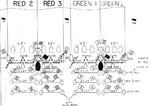 Click to enlarge8B/ So during the landings most critical phase, the Amtanks were the assault's biggest guns on the beach. Concentrating their firepower and momentum was considered critical to the assault. The Amtanks' nine inverted V echelon formations were designed to create massed fire power on Red and Green beaches by focusing seventy 75 mm Howitzers into nine tight corridors of distilled firepower, blowing open defenses directly ahead of those flying wedges, to breach defenses then force passages inland to O-1. Later waves of infantry coming in behind would then mop up by-passed enemy defenders just off the beach. That was the assault plan.
Click to enlarge8B/ So during the landings most critical phase, the Amtanks were the assault's biggest guns on the beach. Concentrating their firepower and momentum was considered critical to the assault. The Amtanks' nine inverted V echelon formations were designed to create massed fire power on Red and Green beaches by focusing seventy 75 mm Howitzers into nine tight corridors of distilled firepower, blowing open defenses directly ahead of those flying wedges, to breach defenses then force passages inland to O-1. Later waves of infantry coming in behind would then mop up by-passed enemy defenders just off the beach. That was the assault plan.
The plan was audacious but based on faultly intelligence. Murphy's Law also played its roll, raising its ugly head for the first but not the last time, when the LCI mortars were lost overboard in transit to Saipan. (See also 12/ below.)
8C/ 15 June (D-Day): THE EXECUTION OF THE SCHEDULED NAVAL GUNFIRE PLAN:
3. D Day Bombardment - a. This firing executed by Task Group 52.17 destroyed a great many important targets and neutralized beaches sufficiently for assault to effect a landing. b. Important targets did, however, escape this bombardment, most importantly enemy mortars and artillery which continued fire onto beaches, and light machine gun and troop positions in low ground immediately behind beaches. The island's size, the large number of defense installations, the enemy's excellent use of camouflage, and the mobility of many of its weapons prevented their complete destruction. Other important factors were: 1/ Lack of sufficient time to fire on all targets, 2/ Requirement that, prior to H-Hour, all targets over 1000 yards inland be left to air support, 3/ Difficulty in getting accurate information to ships regarding locations of active enemy weapons, 4/ Necessity that Task Force 53 conserve ammunition for Guam expected to take place in few days. c. As a result of Naval Gunfire and air bombardment many coastal guns were destroyed, and the enemy was, according to POW statements, forced to evacuate his prepared beach defenses, except for small delaying force. Forward slopes facing seaward were rendered only temporarily tenable to enemy, and his supply transport and communications were reduced to chaos. CHARAN KANOA town was heavily damaged, although many buildings left standing. CHARAN KANOA sugar mill, as well as many vital installations at TANAPAG, GARAPAN, and AGINGAN POINT, were demolished. Mortar and artillery positions immediately behind the beaches, however, were not detected or fired on, so that the enemy was able to inflict many casualties on our troops. Lt. Col. Van Orman, Naval Gunfire Officer, Expeditionary Troops, G-3 Report. (Emphasis Added)
(Note: the Chronology of 15 June D-Day Events by Commander of Task Group (TG) 52.2 shows how final landing plan improved the force and flexibility of Naval Gunfire that would have been otherwise available.)
 click to enlargeAt 0530 night harassment fire ends and scheduled D-Day naval gunfire begins. At 0533 the Commander of Task Force (TF) 52 Admiral Richmond Kelly Turner transfers command of naval gunfire within assault boat lanes to Admiral Harry Hill, Commander of Task Group (TG) 52.2 for duration of initial assault landings. At 0540 CTF 52 announced H-Hour 0830 for Saipan Assault. At 0543 Underwater Demolition Team reports no obstacles on reef. At 0550 CTG 52.17 report guns on MANIAGASSA ISLAND obliterated.
click to enlargeAt 0530 night harassment fire ends and scheduled D-Day naval gunfire begins. At 0533 the Commander of Task Force (TF) 52 Admiral Richmond Kelly Turner transfers command of naval gunfire within assault boat lanes to Admiral Harry Hill, Commander of Task Group (TG) 52.2 for duration of initial assault landings. At 0540 CTF 52 announced H-Hour 0830 for Saipan Assault. At 0543 Underwater Demolition Team reports no obstacles on reef. At 0550 CTG 52.17 report guns on MANIAGASSA ISLAND obliterated.
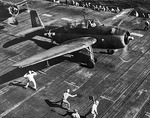 Click enlarges TBF off SaipanAt 0550 Air Coordinator (AC) reports on station overhead. At 0600 AC reports 12 VF on station for CAP. At 0602 AC reports 8 TBF on station for ASP. At 0610 AC reports machine gun and mortar fire from CHARAN KANOA beaches. At 0617 CTG 52.2 informs CFT 52 that UDT reports bad mortar fire 600 yards behind all beaches. At 0619 fire Support Unit #4 reports receiving fire from shore installations At 0624 Landing Ship Docks (LCDs) start launching LCMs carrying land tanks.
Click enlarges TBF off SaipanAt 0550 Air Coordinator (AC) reports on station overhead. At 0600 AC reports 12 VF on station for CAP. At 0602 AC reports 8 TBF on station for ASP. At 0610 AC reports machine gun and mortar fire from CHARAN KANOA beaches. At 0617 CTG 52.2 informs CFT 52 that UDT reports bad mortar fire 600 yards behind all beaches. At 0619 fire Support Unit #4 reports receiving fire from shore installations At 0624 Landing Ship Docks (LCDs) start launching LCMs carrying land tanks.
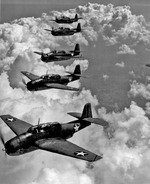 Click to EnlargeAt 0700 Naval Gunfire halts and 60 fighters, 46 dive bombers, and 40 TBFs begin air strikes. At 0700 LST Group Baker arrives on station and starts launching 4th Marine Division LVTs into sea. At 0700 on request of CTG52.2, Destroyer MERTZ of Fire Support Unit One takes position north of RED BEACHES to protect close fire support ships on north flank with counter battery fire, as directed by TF52. At 0710 LVT Group Able arrive on station and start launching 2th Marine Division LVTs in sea. At 0727 AIR STRIKE COMPLETE.
Click to EnlargeAt 0700 Naval Gunfire halts and 60 fighters, 46 dive bombers, and 40 TBFs begin air strikes. At 0700 LST Group Baker arrives on station and starts launching 4th Marine Division LVTs into sea. At 0700 on request of CTG52.2, Destroyer MERTZ of Fire Support Unit One takes position north of RED BEACHES to protect close fire support ships on north flank with counter battery fire, as directed by TF52. At 0710 LVT Group Able arrive on station and start launching 2th Marine Division LVTs in sea. At 0727 AIR STRIKE COMPLETE.
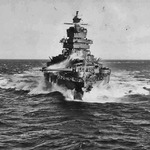 Click to enlargeAt 0729 LCI gunboats reach line of departure. At 0730 SCHEDULED NAVAL GUNFIRE RESUMES. Fire Support Units 1, 2 & 3 begin moving to final landing gunfire positions, slowly decreasing range under enfilade covering fire onto beaches from Fire Support Group 8 south of AGINGAN POINT.
Click to enlargeAt 0729 LCI gunboats reach line of departure. At 0730 SCHEDULED NAVAL GUNFIRE RESUMES. Fire Support Units 1, 2 & 3 begin moving to final landing gunfire positions, slowly decreasing range under enfilade covering fire onto beaches from Fire Support Group 8 south of AGINGAN POINT.
At 0735 CALIFORNIA ordered to fire 400 rounds A/A common onto RED 1 & 2 from HOW minus 30 to HOW Hour in addition to scheduled fire. At 0740 BELLE GROVE launches reserve waves of LVTs. At 0745 BIRMINGHAM ordered to add BLUE 1 & GREEN 1 to scheduled fire, working that fire south to north from HOW-20 to HOW Hour. At 0746, TENNESSEE ordered to fire on identified targets in Area 127Q prior to HOW-30. AT 0750 CTF 52 moves HOW HOUR to 0840 due to slow transfer of control personnel. AT 0751 CALIFORNIA ordered to fire 100 rounds W/P into 182A, B, C & D from HOW-10 to HOW Hour.
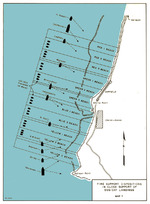 click to enlargeAt 0800 Naval Gunfire Support Sections 1, 2 & 3 are within boat lanes and assume gunfire control. At 0805 2nd Division air observer on station. At 0810, Destroyers begin close supporting fire. At 0810 Commander Control Group reports 'Everything set and ready." At 0813 1ST ASSAULT WAVE leaves Line of Departure. At 0816 LCI Gunboats start firing. At 0818, 2nd Wave leaves for RED & GREEN BEACHES. At 0823 planes form up over beaches. At 0826 3rd Wave leaves for RED & GREEN Beaches. At 0832 fire support ships ordered to get W/P (Smoke) on the ground. At 0832, heavy machine gun fire reported on RED 2. At 0833 CALIFORNIA ordered to halt Smoke. At 0834 4th Wave leaves for RED and GREEN Beaches. At 0839 VF air strafing and rocket attack hit all beaches. 0840 message to all ships: Estimate leading waves will be late on all beaches. At 0843 splashes seen near CAMBRIA'S starboard bow. At 0846, AC asked to locate origin of fire into boat lanes.
click to enlargeAt 0800 Naval Gunfire Support Sections 1, 2 & 3 are within boat lanes and assume gunfire control. At 0805 2nd Division air observer on station. At 0810, Destroyers begin close supporting fire. At 0810 Commander Control Group reports 'Everything set and ready." At 0813 1ST ASSAULT WAVE leaves Line of Departure. At 0816 LCI Gunboats start firing. At 0818, 2nd Wave leaves for RED & GREEN BEACHES. At 0823 planes form up over beaches. At 0826 3rd Wave leaves for RED & GREEN Beaches. At 0832 fire support ships ordered to get W/P (Smoke) on the ground. At 0832, heavy machine gun fire reported on RED 2. At 0833 CALIFORNIA ordered to halt Smoke. At 0834 4th Wave leaves for RED and GREEN Beaches. At 0839 VF air strafing and rocket attack hit all beaches. 0840 message to all ships: Estimate leading waves will be late on all beaches. At 0843 splashes seen near CAMBRIA'S starboard bow. At 0846, AC asked to locate origin of fire into boat lanes.
At 0848 1ST WAVE LANDS ON RED AND GREEN BEACHES. LVTs reported across airstrip behind GREEN BEACH. AT 0854 waves headed for YELLOW 2 get fire from AGINGAN POINT. At 0905 Mortar Fire from inland seen landing inside reef. At 0907 LVT(2)s seen in Area 127 C. At 0911 all initial waves landed. CO Task Force 52 takes control of all naval gunfire support.
9/ Coral and Brass, by Holland McTyeire Smith, C. Scribner's Sons (1949)
9(A) This is photo is of 3rd Armored Amphibian Battalion Amtank in action on Island of Pelelieu. Photos of other units in other battles used herein for purposes illustration will be noted and idenified as discovered and all notes edited. In addition, a history of WWII Amtank Battalions in the Pacific, including all such Marine Battalions and photographs, will be included in the Website found at amphibiouslanding.com
10/ Army Amphibian Tractor and Tank Battalions in the Battle of Saipan 15 June - 9 July 1944, by Russell A. Gugeler, January 1945
11/ Robert Sherrod, On to Westward, by copyright, 1945
12/ Ibid.
13/Headquarters Expeditionary Troops Task Force 56, Report by G-5 on Forager, Enclosure B - Headquarters, Fleet Marine Force, Pacific, para. 4 and 5.
13A/ Admiral King's accelerated schedule spread US Navy resources thin, forcing the Navy to prioritize between equally critical tasks. The Pacific high command's squabbe over timing and target lists after the Marshalls' campaign (which varied between Truk, Carolines, Palau, and Marianas) accerbated the allocation of resources problem, spreading Naval aerial photo recon assets thin. This impacted Marine Corps planning, given its reliance on Naval air and submarine photography for its mapmaking. The planning for Saipan's beach assault suffered grieviously. Earlier the Corps had requested 4 stages aerial photograph missions taken over island targets on D-Day minus 90 days, D-Day minus 60, D-Day minus 30, and D-Day minus 15, all at 1:5,000 scale oblique and vertical photographs plus horizontal submarine photos of all shoreline features, including landing beaches. The press of other commitments limited US Navy photos of Saipan to air combat missions on 23 February (D-Day minus 113) adnd 18 April (D-Day minus 57). These photos were untimely, incomplete, misleading, and scaled wrong, the 1st at 1:10,000 scale, the 2nd at 1:20,000. Cloud cover and rigors of air combat also diminished quality. Submarine sortie photos taken April 2 and 29 did not include landing beaches. Later Navy air photos taken 28 May and 7 June weren't delivered in time to reach Marine assault elements before they left Eniwetok for battle.
This left the Marines planning the Saipan operation with topo contour lines marked at 20 foot intervals that grossly distorted beach topography and altogether missed the steep berms that prevented exit off the beach. So the landing plan's central tenet, a blitzkreig attack, rested on an illusion. This single error transformed Saipan's blitzkrieg into a traffic jam under heavy enemy fire. A 2nd intelligence error compounded the mess. The underwater recon of the lagoon occurred at a different time of day from the D-Day assault so failed to detect and report that strong currents would flow northward just off the beaches on D-Day morning. One error in battle often compounds others, triggering chain reactions that unravel in detail all the parts of an otherwise sound plan. So the closely packed initial assault waves designed to hit Saipan's beaches with a shock that overwhelmed its enemy defenses created a monster traffic pile-up accident onshore instead. Wave upon wave of amtracs crammed with troops and amtanks carried north of their assigned beaches by currents kept hitting the beach, jamming up against each other on beaches already full of packed troops and equipment stimied by the steep slopes that thwarted their attack inland. Marines were left trapped on a narrow beach toehold beneath some 16 enemy 105mm Howitzers, 8 150mm howitzers, 30 75mm field pieces and untold numbers of mortars hidden on reverse slopes far distant that chopped up Marine units all day long with near impunity.
Yet, like at Tarawa, the Marines kept coming. The strong US Marine combat unit cohension and tenacity and example of individual Marines fighting within those units combined with US Naval counterbattery gunfire offshore that learned on the job to save the day. Admiral King's strategic judgments and the Marine Corps hard earned Amphibious Doctrine also proved sound in the face of all these surprises, despite inadequate joint amphibious training for all units at Saipan due to Admiral King's aggressive schedule.
(See Report of ACofS, G-2, Expeditionary Troops, Task Force 56, on FORGAGER Operation, 31 August, 1944. See also above Footnote 4B/ on counterbalancing benefits that accrued from accelerated schedule. See also Comments of Lt. Col. Reed M. Fawell, Jr., CO, 2nd Armored Amphibian Battalion, in After Action Report summarized in this website's Amphibious Tank section, on ways to alleviate future problems)
13B/ POST H-HOUR NAVAL GUNFIRE:
15 June (D-Day): POST H HOUR NAVAL GUNFIRE from 15 June to 20 June:
Post H-hour Naval Gunfire support included Call Fire and Special Missions. Shore Fire Control Parties (SFCP) that landed with each Infantry Battalion early on D-Day spotted and called in Naval Gunfire support from ships assigned to support their Battalion. This Call Fire Support was available 24/7. Flexibility was built into the systems. More than one ship might support one battalion. Other times one ship supported several battations. Frequently SFCP's worked with overhead plane spotters and Marine Artillery. Call Fire included Starlight Illumination, highly effective during nighttime Bonzai attacks. Special Missions included Post H-Hour Naval Gunfire that didn't originate from a Battalion. It included Heavy Preparation Fire, Deep Support Fire, Targets of Opportunity Fire, Night Harassing Fire, Ammunition of Special Targets Fire.
All requests were approved and packaged through Naval Gunfire Liason Officers at Regimental, Division, and Landing Force levels before they reached the Task Force 52 Gunnery Officer who, aboard Flagship of Task Force Commander, worked with Naval Gunfire Officer, Expeditionary Troops, to first order and then coordinate fire from the ship assigned to support the Battalion from among 4 Battleships, 2 Heavy Cruisers, 3 Light Cruisers, and 39 Destroyers then on station offshore for Naval Gunfire support.
14/ 2nd Armored Amphibian Battalion Special Action Report Saipan Battle, 22 July 1944
15/ Phillip A. Crowl, Campaign in the Marianas, Center for Military History, US Army, 1960
16/ Report of ACofS, G-2, Expeditionary Troops, Task Force 56, on FORGAGER Operation, 31 August, 1944.
17/ Ibid.
18/ Ibid.
19/ The Japanese lost more than 50% of their front line troops and most of their artillery by 20 June but the hard fighting was not over. Quite the reverse. Japanese troops almost never surrendered. To quote and paraphrase above referenced G-2 Report:
Throughout the entire operation, the enemy offered bitter resistance ... organizing his forces in a spirit of fanatical determination and taking full advantage of the opportunities for defense offered by the terrain, his numberous units and separate detachments, using small arms and machine gun fire often supported by artillery tanks and mortar fire held their positions with tenacity until annihilated under the force of our assault. The enemy tactics were highly varied, and effective. Regularly they infiltrated our lines, and attacked or sniped for the rear. Often they erected then defended roadblocks, mined areas, field fortifications. They fought from foxholes, dugouts, covered emplacements, from behind rocks and boulders, from inside caves, from high rugged defiles, and from wherever else they fire could deliver fire against our front and flanks. They counter-attacked often, always with fanaticism, in groups up to 2000 men supported by tanks, and were repulsed only when annihilated. Trapped in caves, or bunkers, or otherwise they resisted until the end, reserving only enough ammo to commit suicide at the end. Enemy surrender was rare. Ibid.
20/ On to Westward, by Robert Sherrod, copyright, 1945
21/ Major Carl W. Hoffman, Saipan: The Beginning of the End, USMC Historical Monograph
22/ Shaw, Nalty, Turnbladh, Central Pacific Drive, History of US Marine Corps Operations in WW II, 1966
23/ Coral and Brass, by Holland McTyeire Smith, C. Scribner's Sons (1949)
24/ Ibid. (Note: to summarize and then elaborate on General Smith's reasoning, the Saipan battle in his view breached Japan's inner defenses and destroyed its hope for resisting our advance. This was because it destroyed what he called Japan's Pearl Harbor, and forced Japan's Combined Fleetr to confront US Navy air power, resulting in Japan's grievous air loses during the Great Marianas' Turkey Shoot. It also severed Japan's empire at the waist, isolating its resource rich southern Pacific conquests from its industrial home islands, and it cut off the north's abililty to fly military supplies into the Central and Southern Pacific. And it brought those home islands into range of US long range strategic bombers which convinced those Japanese willing to admit it that Japan would lose the War. For all these reason the Battle of Saipan forced Japan's Prime Minister Togo and his War cabinet to resign. These officials in large measure had been the human engine that drove Japan's entry into its War against the United States.)
Footnote 25/ (this footnote is labelled Footnote 2 in narrative text to oral histories above.)
This footnote 25 is under construction and is edited as of JUNE 5th, 2015 by Reed M. Fawell III -
INTRODUCTION
Despite the critical roll America's seizure of Saipan played in the Pacific War of WW11, the island was hardly mentioned in the Orange Plans formulated during the 1920s through the mid-1930's to win a war against Japan. US planners instead focused the Pacific Fleet's rapid transit to the Western Pacific via other routes to save or recapture US Navy and Army bases in the Philippines, particularly those at Manila and Subic Bays on Luzon's west coast. But, whatever the route, the task was deemed essential to holding the Philippines and safeguarding US interests along Asia's Pacific Rim to insure open doors into China and open sea-lanes vital to commerce from Korea south to French Indo-China, British Malaya and Dutch Indonesia. In short, the Philippines anchored US power in the Western Pacific, most particularly against nearby Japan. Such a fleet could block any Japanese naval thrust into the South China Sea. It could also sail north to quickly engage Japan's fleet in a climatic sea battle that protected the Philippines and sea lanes to China, and ultimately subdue Japan's home islands. Thus a dominant US Navy that operated out of the Philippines gave the United States a cornucopia of military options to protect an array of criticial US interests in the Far East, and thus hopefully also deterred war altogether.
US planners also feared the flip side. Americas' loss of the Philippines to Japan would dramatically alter the balance of power in the Far East. It would magnify Japan's advantage as the only great seapower headquartered in the Western Pacific. It would remove not only a powerful obstacle to Japan's ambitions in north and central China but also in the rim of southeast Asia, giving Japan a springboard into the South China Sea and the lands that rimmed those waters - Indo-China, the Malayan Peninsula and Indonesian Archipelago. Japan's hegemony there would strip America of its means to protect its burgeoning trade with the Orient that was beginning to rival its trade with Europe. Indeed, given its recent expansion across the American West, America's new strength and opportunity lay in the fact that its now fully secure 2500 mile wide continent, on each of its east and west coasts, fronted for some 1500 miles on one the world's two greatest oceans. Given its abundant interior riches, it huge natural resources and industry, and its rapidly developing west coast from San Diego to Seattle, America sat poised on the cusp of a fabulous era of massive trade across the Pacific in addition to its long enjoyed trade across the Atlantic with Europe. Hence America's strident open door China policy. Japan's closing of those doors threatened this lucrative US Far Eastern commerce, harming the US economy, and America's rise as a world power.
US Navy planners every early on agreed that a powerful and well supported US fleet operating out of Luzon would secure these vital interests. And that its absense would expose those far away interests to great harm. Either way, whether that potential be for harm or benefit, it would surely grow over time. That's how Teddy Roosevelt, Admiral George Dewey and Captain Alfred Thayer Mahon saw matters unfolding in the Far East from and after the turn of the 19th century into the 20th.
The Japanese, however, faced radically different circumstances. The small size and meager resources of their home islands led them to conclude that their manifest destiny (security, prosperity, and power) as an industrious people initially lay due east in nearby Korea and Manchuria and ultimately in their acquisition of hedemony over China and Asia's resource rich Southern Pacific Rim. Why not? This was game the European colonial powers had played with great success. And had not America done the same in its conquest of North America? And, after Japan's victory at Tsushima as other European colonial powers faded in the Western Pacific, the Japanese came to believe that the US controlled Philippines were the major obstacle to the territorial expansion and regional hegemony that Japan needed to guarantee its rightful future. Later economic bad times seemed to prove their home islands internal weakness. This enboldened strident Japanese nationalists who morphed this 'foreign obstacle' into the Point of an American Knife at Japan's throat. Such demagoguery built political power at home and abroad for hard line nationalists. So it should be no surprise that Teddy Roosevelt after Tsushima came to realize that any US occupation of the Philippines without the protection of a strong US fleet anchored at Luzon was a receipt for disaster. He called it America's Heal of Achilles. This was only the start. This potent brew of geography, ideology, alien cultures, and conflicting interests drove rising fears and ambitions. Rampant nationalism became increasingly toxic. As the Western Pacific grew pregnant with troubles, America became Japan's central problem in the minds of Japanese nationalists.
America's central problem, however, was always distance. The Philippines lay 7,000 miles by sea from America's west coast and 14,000 miles from its east coast before the opening of Panama Canal. In contrast, Japan occupied Formosa 530 miles north of Luzon. So the central question was plain: how could America defend the Philippines given that Japan could seize Luzon long before the main US battle fleet could reach it? Although raised before America took the Philippines from Spain in 1898, this problem came into sharper focus during the 1904-1905 Russo-Japanese War when Japan bottled up and destroyed Russia's Far East Fleet in Port Arthur while it's amphibious troops, after landing to the south, encircled the port and then captured it, opening the door to Korea and Manchuria, before Russia's main battle fleet sailing half way around the Globe could arrive on the scene. Then matters got far worse for Russia. After Japan had liquidated the remnants of the Russian Asiatic Fleet fleeing Port Authur, its main Battle Fleet positioned itself to render Russia remaining seapower at Vladivostok impotent while taking a station perfectly positioned to anniliate Russia's main Battle Fleet after its arrival in the Tsushima Straights off Korea in late 1905. The debacle destroyed Russian seapower worldwide, rocked Russia back on its heals at the Pacific Rim and destabilized the Czarist regime in St. Petersburg, while it also opened Korea and Manchuria to Japanese hegemony on Asia's mainland. This in turn diluted the strength of Japan's remaining competitors in the Western Pacific, and whetted Japan's long term appetite for empire. Why not? After all, the small resource poor island archipelago of Japan with its booming industrious population had achieved a victory at war of historic consequences. For the first time in modern history a far eastern nation had defeated in war a major western power. That fact alone had long term impact on Japan's national pyschology, and its future ambitions.
Of even greater significance for its western rivals was Japan's masterful military display. The variety and coordination of its combined arms, their cummulative power and effectiveness on land and sea, and at the waters' edge, during two years of war astounded the world. This included Japan's mastery of the world's most modern and powerful weapon, the emergent Dreadnaut battleship, within an oriental fleet deployed with brilliant tactics enhanced by a sea attack and blockade of Port Arthur and accillary amphibious landings south of Port Arthur establishing an advance base that supported its sea and land siege operations against that port and later ground operations inland, together with neutering of Vladivostok to the north by the Japanese Fleet. The logistics demanded by this series of complex operations was also a magnificent achievement. Japan during the Russo-Japanese war changed the face of modern warfare. It also rocked and cracked the foundation of the international world order, opening seams of weakeness, strength, and opportunities that would take two world wars and several cataclymic civil wars that consumed most of the 20th Cenury, before the World finally settled roughly back into the semblance of normality.
The lessons here were many and profound. Fortified ports supported by accillary US fleets alone would not defend America's occupation of the Phillipines, only invite America's defeat there and its ejection from the Western Pacific. But a trans-Pacific crossing by America's main battle fleet to engage Japan's fleet in the Western Pacific was also a highly risky venture, given Japan's now proven military power on land and sea as amplified by its home field advantage. US Naval seapower scholars like Mahon also discerned the multiplier affect that worked within Japan's homefield advantage. Its central location with its short interior lines within the Western Pacific ramped up Japan's power defensively and offensively both onshore and offshore. The short operating radius of the coal fired boilers of the new steam powered war fleet accentuated the advantage of Japanese fleets operating within the nearby and relatively closed waters of the Sea of Japan, Yellow Sea, and East China Sea. In contrast, each mile of the 15,000 mile journey that the Russian fleet had to sail to engage Japan in its own back yard multiplied Japan's advantage while it exposed Russian interests worldwide to ever greater risks, absent powerful solutions. Meanwhile each Japan's success during the war on land and sea leveraged its advantages, first over Russia's Asiatic Fleet and its ground forces onshore, whether in Korea or Manchuria, and then over the Russian battle fleet that finially arrived exhausted and heavily laden to challenge it. Likely too these advantages were not static, but would grow over time. Japan's post-war growth as a regional power would likely magnify its advantage regionally vis a vis its competitors there, and worldwide. This of course applied to America's strategic and tactical situation in the Far East. Thus, for example, Japan would likely defeat any future US Fleet sent across the Pacific to protect US interests, absent powerful and complex solutions to counter Japan's advantages. Thus, America's best planners came to realize that time's passage most likely would favor and incrementally increase the power of Japan's position and its inherent advantages. If so, future US battle fleet tasked to transit the Pacific to fight Japan had to be ever more powerful, multi-faceted, and self-sustaining on its departure from home port, during its transit, and on its arrival in the Western Pacific, than its Japanese opponent. Otherwise its chances of victory at sea or ashore would become increasingly unlikely, increasing difficult to reverse, and ever more difficult for American to fully recover from, given the ever more dire consequences of any US naval defeat in the Western Pacific.
Other Japanese advantages in the Western Pacific emerged. One of them proved Mahon right yet again: given the new state of naval technology, heavily armored gunships concentrated in battle were now essential to winning major fleet engagements at sea. US Lt. Commander Sims refined and distilled Mahan's doctrine to assert that Japan's big gunships at Tushima, their superior power and reach and mobility, had neutered the smaller gunned Russian ships. The short-armed Russians never laid a glove on the long-armed Japanese who stood off at a distance, out of range of Russian ordinance, while pounding the less mobile Russian squadron into scrap iron. The Dreadnaught age had arrived. This yet again compounded Japan's locational advantage. For 300 years, powerful European nations had been sailing the globe, using far smaller and lesser squadrons, to carve out and dominate for themselves markets and spheres of influence. Now only Dreadnaughts in massed formation assured any such nation unfettered access to the sea lanes it needed for international commerce and colonial expansion. Japan, however, had mastered its technology and application in battle, on offense and defense. Now it needed only to concentrate its Dreadnaught fleet in the Western Pacific to achieve its ambitions. For now it wielded a weapon that not only could deny entry by others into the sea lanes it dominated along the north China and Korea coastline, it could also deploy that same weapon offensively to project its power south along the Pacific Rim into the South China Sea. And, even then, Japan's desired area of hegemony - what it needed to satiate its ambitions - was far more local than its primary opponents, all of whom suffered from the disadvantages of distance as concerned the Far East, as well as a wide variety of other far flung conflicting obligations, including troubles brewing among themselves at home in Europe and elsewhere around the globe.
These factors magnified the power of an otherwise small and resource poor Japan while they lessened the power of its potential adversaries to oppose Japan's vaulting ambitions. For, unlike Japan, its potential adversaries that aspired to hold their own on the world stage after the Russo-Japanese War - to expand markets, trade, and economic and military power - had to build fleets around Dreadnaughts and possess the means to operate, maintain, and rapidly deploy those fleets over great distances on call worldwide. This, for example, put enormous strain on the smaller Dutch and stagnant French economies that were already struggling to hold their own in Europe, and worldwide, against rising powers such as Germany. Plus Japan had already neutered France's ally Russia, weakening both. This left only on the long time international heavyweight Britain, and the rising powers America and Germany, in a position to challenge Japan in the Western Pacific. And Japan in 1902 had wisely allied itself with Britain. Meanwhile Germany and Britain armed with Dreadnaught Fleets could deny America access to markets worldwide. America had a two-ocean problem, growing in the Atlantic and Pacific. Japan's was centered in the Western Pacific.
These new realities spun off several corallaries and complications for US Navy planners. For starters, the US Navy did not have enough ships to go around. Any plan that split the main US battleship fleet between the Atlantic and Pacific Oceans before sending one part of it into a Western Pacific battle alone against Japan's Fleet would launch a Fool's Errand. Also highly problematic now were the chances for success of any bluff or harrassment action against the Japanese by a small US Asiatic Fleet in defense of the Philippines. Indeed, any plan that now sent the entire US main battleship fleet across the Pacific to defend or recapture the Philippines was highly problematic. Too many inherent disadvantages, obstacles, and variables were in play. These ranged from: 1/ the speed of that fleet's mobilization, its points of departure, and its lines of transit with assemblage and reinforcement along the way to and including at its point of arrival at the Philippines; 2/ to its capacity to achieve its mission that increasingly demanded an array of essential and interdependent missions - not only sea battles but also scouting missions, amphibious landings, follow on ground operations and occupation forces; 3/ to the secure convoy of increasingly massive logistics trains to fuel, resupply, repair, maintain and defend the ever more specialized and complex machinery of a modern steel trans-ocean fleet in the course of its long journey to the Philippines, and thus 4/ the need to build secure lines of communications along the Fleet's lines of transit to include points of land based critical infrastructure - ranging from docks, fuel depots, repair yards, storage, assembly and collection points - within the mid-ocean and at the fleet's point of final arrival.
Thus any serious study of the problem made clear that, absent powerful solutions and stupendous effort, these complications would likely overwhelm the Fleet's mission, and multipy over time. Hence a prudent "trans-Pacific campaign" would be fraught with the risk and expense of ever changing demands and would likely deplete US naval forces and resources elsewhere, worldwide. European colonial powers increasingly faced similar problems, unlike Japan.
Thus, a US battle now fleet sent across the Pacific without secure home port(s) in transit and/or on its arrival (for collection of assets, resuppy, regrouping, planning, overhaul, and defense) would severely compromise its chances for victory. Indeed, the lack of such support and reinforcement might transform the trans-Pacific mission into a debacle. And the greater the size and complexity of the US fleet that had to be deployed, the greater was the potential for its irretrievable loss, including one that left America and its Western Hemisphere naked against strong European aggressors, such as Germany.
In short, a trans-Pacific US seabattle disaster could easily compound worldwide. This was not theory. The 1905 Tsushima disaster anniliated Russian's international seapower, knocked Russia off the world stage, and opened doors to Japan's further conquests. Those consequences confronted US Navy and Marine planners like an ogre. Any US trans-Pacific naval campaign to save the Philippines then defeat Japan's fleet in the Western Pacific without the immense size, multi-purpose capability and steadfast support to achieve its mission carried horrible risks: the loss of a major war, the loss of US interests in the Far East, and the loss of a battle fleet essential to America's defense and its seapower worldwide. Such monumental risks alway carry a flip side. Here they gave Japan the potential for great upside should it go to war with America and win or draw. It invited War. Indeed it was quite incredible. By December, 1941, America had still failed to build a sustainable, or even a colorable, defense to its power in the Western Pacific. Japan would collapse US power there like a house of cards, simply by destroying or chasing off the feeble US fleet and airpower at Luzon in a matter of hours then head south into the South China Sea, leaving behind the wreckage of US defenses, including Corregidor, to ben cleaned up later with amphibious landings. Why not? The US oil embargo had forced Japan to act. It could either capitulate to the US demand that it abandon its ambitions on the Asian continent in return for oil that left it dependent on its enemies, or it could join the German Axis powers in war and attack those who threatened its survival and Manifest Destiny. So by then War was inevitable. Capitulation might start some oil flowing again but it would leave resources critical to Japan's survival at the mercy of the US and its Allies in the Pacific, and expose Japan to its enemies in Asia and the German war machine that would surely arrive in the Far East after it conquered the Soviet Union and Britain. Or it could join the Axis Powers against the already defeated or collapsing western colonial powers in the Far East, conquer their oil and rubber rich colonies at the rim of the South China Sea, and then finish its ongoing war in China with victory and launch from Manchuria and Korea into Asian Russia. (see Onslaught at Amphibiouslanding.com).
For lack of a US deterence or respectable defense, war became unavoidable in 1941. Yet, despite all of the obstacles and disgraceful delays to the US building such a deterence or defense in the Far East, American leaders discerned as early as 1902 the essential ingredients of workable solutions that fell naturally within the prime responsibility and unique capacity of the US Naval Services. Those very early solutions were deemed to require four daunting projects:
1/ That America build two operationally independent world class US battle fleets, one for the Pacific Ocean, and one for the Atlantic Ocean;
2/ That America build as rapidly as possible and control and defend a Panama Canal that linked those two fleets, and,
3/ That America build a secure line of transit across the Pacific from Hawaii to Guam to a world class multi-purpose US naval base at Subic Bay in Luzon 30 miles north of Manila to support all operations of the entire Pacific Battle Fleet.
Teddy Roosevelt and Admiral George Dewey not only saw these solutions very early on, they implemented those solutions with rare skill and conviction, both militarily and diplomatically in the Atlantic. During and after America's war with Spain, they erased the threat posed by distance and it's ugly sister, diluted military force, when they established a strong and permanent US base at Guantanamo Bay, Cuba and an advanced base at Culebra Island off Puerto Rico. This foresighted action built on Mahonian teachings allowed them in 1902 to concentrate nearly the entire US fleet in the Caribbean which doubled its size over that of its opponents and amplied its power with short interior lines and strong position reinforced by advanced bases, a strong US Marine force and logistics train, all of which they'd need to deter war by gathering the means to defeat a combined German and British fleet off the coast of Venezuela. The results built on this foundation were spectacular and long lasting. They achieved results that not only avoided war but also thwarted German ambitions in the Western Hemisphere and cemented US and British long term cooperation in the Atlantic, which in turn: 1/ assured America's building the Panama Canal, 2/ secured the Monroe Doctrine against future foreign threat, 3/ and foreshadowed the Anglo-American alliance in World War I in the Atlantic. This resulted in a century of prosperity and trade in the Americas free from outside interference, and it set the stage for America's roll in helping to thwart the German Kaiser's conquest of Europe. It's a powerful testament to the benefits of overwhelming US Naval power when it is wisely and deftly deployed in a timely manner.
Conversely, and in stark contrast, US policy in the Pacific resulted a world war that included a series of military debacles. Why the difference? Weakness invites War. Roosevelt, Dewey and Mahan who understood the risks were collectively the most influencial trio of naval proponents in US history, yet they were unable to translate critical military needs into fully funded and properly executed public policy, sure proof of the difficulties inherent in the task. Indeed, only World War II that threatened to annihilate Western Civilization and America along with it could rouse America to achieve proper security for its interests in the Far East and only then after Japan devastated the US Fleet at anchor in Pearl Harbor. So the obstacles were obviously many that thwarted America's building of the military forces that were necessary to deter Japan from attacking the Philippines or regions south of the Philippines. One of Roosevelt's most stubborn obstacles was congressional pork. The US Congress refused regularly to build overseas bases because it wanted those defense appropriations to go into building unecessary and unwanted US naval stations in its own districts. Unfortunately, too, the US Army took advantage of this opening to become a another daunting obstacle to building any naval base in the Philippines that possessed the location, infrastructure, and mix of forces and command structures, that could assure a complete US naval victory over Japan, most particularly one properly supported by its US Marine Corps. US Army leaders, notably General Leonard Wood (and later Douglas MacArthur) feared that these solutions would threaten their personal and institutional interests. So the US Army worked fanatically to thwart the Subic Bay naval base if only because they feared public recognition that the US Navy and Marine Corps working together were uniquely qualified and able to execute solutions necessary to win an ocean war against Japan. In short, any recognition that handed the command of offensive operations in the Pacific Ocean to the US Navy and its Marine Corps was unacceptable to these overly ambitious Army officiers. This may have been the key factor between failure and success in finding an effective solution to the defense of US interests at the Pacific Rim during the first two decades of the 20th Century. Thus Congress opposed Roosevelt's request on the grounds of disagreements within the US military when its real motive was buying votes by handing out pork that stripped America of critically needed naval bases in the Far East. More obstacles to Naval solutions were erected in 1920s and 1930s, including several erected by elements of the US Navy.
But what were the alternatives? A half-hearted or incompetent effort that built a smaller naval base alongside a massive Army Fort in Manila Bay served only to lure Japan into war by offering it confidence in victory and a hostage afterward. Yet how could America just walk away? To abandon the Philippines was a sure receipe for the collapse of America's legitimate interests in the Far East. It would open a void there that Germany or Japanese would likely fill, a windfall they'd use to later challenge and expel US interests in the Far East. Plus the US army would have to walk away from its prime overseas command. America, unwilling to forthrightly address these problems and realities, papered them over instead, and so hid them from public view. Roosevelt was reduced to short term fixes such as sending the Great White Fleet through the Western Pacific on its World Tour and playing off Japan against Russia, while giving Japan mostly a free reign in northern China. Ultimately this chronic failure of national leadership brought disasters of monsterous proportions. In the Western Pacific 40 years later it left an obsolete Army fort and small ineffective naval base to defend against a battle hardened Japanese Navy, Army and Air force second only to Germany's armed forces. US forces on the Philippines were doomed to a quick and ignominous defeat. That disgrace destroyed US military power in the Western Pacific in the first 12 hours of America's World War 11. The debacle left America's defenses grieviously exposed throughout the Pacific Basin at the worst possible time, the start of a World War that suddenly engulfed US forces in the Atlantic and Pacific. (See FOOTNOTE 1(G) to website banner labelled Tinian)
Still, despite its huge loses, the US Naval Services against all odds found remarkable ways to rush their forces into the breach (after picking up the broken pieces left over from the debacle) and against fearsome odds staunch the losses at Guadalcanal after they'd leveled the field at Midway, and then put America's war on the right track going up the Solomons before driving it through the Central Pacific to achieve the means for an unconditional victory over Japan. In a nutshell that is precisely what the US Navy and Marine Corps did. And most of it was achieved over the vociferous objections of US Army leaders led by Douglas MacArthur. (see Amphibiouslanding.com).
How did the US Navy and Marine Corps succeed despite all the obstacles erected to America's defenses in the Pacific. These obstacles dominated US Naval strategic thinking from 1906 to 1945. The road to their solution was long and arduous. It required hard choices, altered political landscapes, and the pursuit of many blind alleys to find transformative solutions and innovations. Many arose only when America was forced to battle its way through a World War. But the quest for solutions before the war by a relatively few Americans gave rise to these accomplishments, including the development and deployment of long range, self sustaining, multi-purpose battle fleets amplified by a startling array of modern technologies and capabilities that included:
1. Trans-ocean, self sustaining seaborne US airpower that could dominate at will vast swaths of sea and sky most anywhere in the Pacific Basin,
2. Trans-ocean, self sustaining seaborne assault shock troops fit to win contested ship to shore amphibious landings that, under the cover of the US Naval Air and Battle Fleets, could reach across thousands of miles of open ocean to seize strategic enemy island strongholds that, once secured, vastly expanded the power and reach of the US Naval sea and air power as well as Army Air force land based airpower operating therefrom, and
3. Long range, land based US Army Air Force strategic air power that, operating from newly seized enemy open ocean island strongholds, could reach across thousands of miles of open water to devastate Japan's home islands, and ultimately deliver the Pacific Ocean War's knock-out punch.
Items 1 and 2 proved essential to overcoming the daunting obstacles that confronted America in its 1942 to 1945 maritime war against Japan. These arms, working in tandem, projected and multiplied US power with devastating results over vast ocean spaces by revolutionary means. Without them, and those who took them into battle, the great hardships of the Pacific War would have at best been far greater, and its results far more speculative.
How did this immense, unexpected, and world changing achievement of the US Navy and Marine Corps in World War II happen? This article endeavors to answer this question (or at least shed more light on the answer to it).
GENESIS OF VICTORY
It's argued that all the truly great western philosophers of the last 2300 years have written only footnotes (meaning elaborations or refinements) to the earlier works of Plato on what he learned from Socrates and later passed on to his student Aristotle. It is all quite remarkable: such was the great power, long reach and all encompassing scope found in the seminal works of this triumvirate of Greek philosophers that their collective works encompass even today the universe of the discipline they practiced. And, if this be true, those later philosophers who's work refined and elaborated on the works of this ancient Greek triumvirate are each great in their own right, destined to have major impact on Western Civilization as it later unfolded and will continue to unfold so long as Western Civilization works its way upon this world. And, conversly too, it follows that those who failed to write their own footnotes to Plato by and large wasted their own time (and that of others) pursuing the dead ends they conjured up to the detriment of posterity, Karl Marx for a prime example. Some find such truth threatening. Hence Socrates was forced to drink the Hemlock that killed him. For, otherwise, those then in power feared that the truth and force of Socrates ideas would unset the status quo, and benefit all, at the expense of the power and priviledge of those few demanding control of everyone else. No good deed goes unpunished. Fortunately, Plato circumvented the plot. So should we, whenever we see this Iron Law of Unchecked Political power raise its ugly head to thwart America's interests. So this story on seapower and amphibious landings unfolds. It tells of the battle that raged for 70 years, from 1880 to 1950, and still simmers today just below the surface, of today's Pacific Ocean.
Similarly, it can be persuasively argued that all truly great politicians, strategists, tacticians, warriors and logisticions of the Pacific Ocean War between the United States and Japan, and of its antecedent events, wrote only footnotes, whether they be in words or actions, to the seminal works of a triumvirate of earlier American seapower prophets. These three practicioners and philosophers of naval seapower showed the world how it was best deployed in peace and war to influence events and render consequences. They worked in tandem. Each complimented and enhanced the abilities and expertise of the other two, creating a whole greater than its parts, for cumlative impact.
To simplify: Captain Alfred Thayer Mahon built the intellectual framework, Theodore Roosevelt absorbed Mahon's ideas then assembed and focused the political power to build the tools and design the campaigns that Admiral Geoge Dewey deployed, using mostly America's naval services, the US Navy and Marine Corps, to build US power and influence worldwide for generations. This included building the foundation and superstructure of American power that still stands today in the Western Pacific and Western Hemisphere. American leaders who followed in the footsteps of their achievements were either one of two types. They either stood on the shoulders of Mahon, Roosevelt, and Dewey to preserve and enhance what those men accomplished at the turn into the 20 century, or they nearly destroyed those earlier achievements by later neglect, incompetence or willful intent, typically by reason of their vigorous opposition driven by selfish parochial interests that lasted in its most virulent form for 70 years right up through 1949. This terminus is easily marked the "Revolt of the Admirals" and its aftermath. Thus, traveling in the wake of great accomplishments, while reinforcing and improving those exceptional achievements, is far more difficult and rare that it might initially appear. The foibles of human nature more often drive competitors the destroy the achievements of others deemed rivals or drive later generations to do the same by reason of an overbearing zeal to make one's own mark by first destroying what earlier generations have built. Alternatively, destruction occurs slowly through neglect or indifference whose consequences grow over time, largely unseen by later generations who fail to learn their profession or conduct themselves based the historical experience of others, and thus fail to see or appreciate the benefits they have derived from what they are allowing to fall apart. This is everywhere around us. It's said that William Shakespeare invented and put on stage the universe of human experience for all of us to vividly see, hear, feel, better understand and appreciate. Unlike Socrates, he was lucky enough to avoid the gallows despite his achievement. But ever since he's endured constant attack. Now, during our time, these assaults are accomplished by character assasination or teaching ignorance, the latest in a long line of interations, the one most current now being that Shakespeare is only one more parlous example of the "dead white male" who's work is oppressive, pernicious, obsolete, and irrelevant. Such claims only mirror their own image looking into the darkened glass. Below, as regards the US military and its leaders, we will see this pattern repeat itself again and again.
Thus too it can be said that T. Roosevelt, Mahon and Dewey, working together from the 1890's through 1915, did for naval seapower that Shakespeare did for humanity, showing its constituent parts, how they move and work, and what they can achieve, for good or ill. So great was their collective universe that later and radically new seaborne fleets of warplanes, and the resultant altered states of battleships, all fit neatly into their grand scheme as simply more moving parts to project naval power, and be subject to its principles, within the same universe this Triumvirate exposed for all the world to see should anyone of us have the capacity to open our eyes to the suddenly obvious. Unfortunately, far too many individuals who should have known better, or who did, but refused to subordinate their own narrow selfish interests, were not up to the task that honor or their profession required. This group too often wasted their own time (and that of others) following dead and/or counterproductive ends that gravely damaged America's war effort, Leonard Wood and Douglas MacArthur being prime among many examples. We will discuss this group in detail as it is a chronic plague on war fighters from here to internity. And, in so doing, we will also see examples of the reverse, how an older generation can work just as hard to sabotage critical solutions driven by the innovations of the junior officers who follow them. The chronic plague walks a two way street.
Conversely, those officers who built on the legacy of this American triumvirate had major positive, indeed decisive, impact on America's defeat of Japan. This group includes General John A. Lejeune, Lt. Col. Earl H. Ellis, Admiral Joseph M. Reeves, General Holland H. Smith, and Admiral Ernest J. King, along with a great host of other US Navy and Marine Corps officers (as well as US Army too), dating back to the 1880's and before. If America's triumvirate of seapower prophets had a Saint Peter, the Apostle who's force of character and learning drove their seapower teachings into actions that saved the world, that Apostle would be Ernest J. King. And thanks to the Marine Commandant Holcomb, Gen. Holland Smith's "take no prisoners approach" to standing up America's amphibious landing capability was going full bore before Pearl Harbor. Thanks to Admiral King, Gen. Holland Smith later became the driving force behind amphibious landings in the Central Pacific despite the obstacles put in their path by Admiral Nimitz and the US Army.
Of course there are many other examples of military officer who swam against the tide like King and Smith with highly positive impacts. But King's and Smith's contributions were so grand, and their success so great, that angry competitors then and now have made every effort to erase their names and achievements from US history, and too often succeeded. But, of course, King's and Smith's success rested on the achievements of many others, not least the entire US Navy, including its seaborne airpower that cleared the way for amphibious assaults, and many other capabilities of America's naval and air services. But no good deed goes unpunished. "There's no reason for having a Navy and Marine Corps. General Bradley tells me that amphibious operations are a thing of the past. We'll never have any more amphibious operations. That does away with the Marine Corps. And the Air Force can do anything the Navy can do nowadays, so that does away with the Navy," declared Secretary of Defense Lewis A Johnson (a Washington Lawyer and fundraiser for Harry Truman) during 1949 efforts to destroy Naval air power and the Marine Corps altogether at the behest of General George Marshall among others. The usual suspects were playing a very old song going back to the 1880s, one that'd been played many times since, only to be proven wrong each time at a terrible price.
Balance in unedited rough draft as of May 5
A Near Suicide to a Modest Beginning to Modern US Naval and Marine Warfare
After the Civil War the US Navy as an effective seapower fighting force collapsed. By 1870 its 700 ship Civil War navy comprising 5,000 guns had been stripped to 52 commissioned ships mounting fewer than 500 guns, most obsolete. The Navy not only ripped up its war fleet, it actively sought to destroy root and branch new and rapidly advancing technologies that had emerged before and during the war and that now were critical to the US Navy future warfighting success. These included the fantastic technological advances that made by the US Navy a world leader in ship architecture, ordinance, and steam propulsion. It also torn up many of the strategies and tactics it had deployed with success during the war, and it ignored or refused to reaffirm, develop or refine strategies, tactics, and weapons needed to counter new post war threats to America. The Navy tried to pretend the Civil War never happened, refused to plan for the future or learn from the past while trying to hide in it. In short, the leaders, who mostly got their way exercising command of the US Navy from 1865 to roughly 1880, put their own navy on an unsustainable course that nearly drove the US Navy into a state of institutional suicide.
Misc. Notes/// Most steam boilers within those ships had been altered to permit only auxiliary steam should wind power fail during an emergency. Thus steam boiler driven ships were re-rigged with full sails, and boiler power cut back then further tamped down by replacing four bladed props with two blades to reduce drag on wind power sail efficiency. The fastest ship afloat, the U.S.S Wampanoag, a revolutionary high propulsion steam driven commerce raider and cruiser built to move at nearly 18 knots was decommissioned altogether in 1868. In 1869 the US Navy mandated full sail power for all its ships. It forbid the use of steam to power its ships save when absolutely necessary a year later.1/ It halted new contruction of armored ships and ignored advances in modern ordinance and other martitime technologies while touting its monitors despite their rapid obsolescense in port defense and uselessness on the high seas. Admiral Daniel Ammen similarly declared that "the time is not distant when marine rams will take the place of the enormously expensive iron armor-plated gun-bearing ships of today. The Navy's top Admiral, David D. Porter declared that "powerful ironclad fleets" would never decide wars ... One vessel like the (Confederate) Alabama roaming the ocean, sinking and destroying (commerce at sea), would do more to bring about peace than a dozen unwieldy iron clads cuising in seach of an enemy of like character.1/ The Alabama, 1862 british build Confederate wood hulled sloop of war commerce raider (driven by sails with auxilary retractable twin blade screw) was sunk in battle by the armor clad USS Kearsarge in 1862 off Cherbourg, France.
INSERT MORE.
26/ Photo Credits UNDER CONSTRUCTION: Header Home Page, USGov Archives; Saipan Section: p1. US Navy Photographer, US National Archives; p2 Roebling, USMC Air Ground Museum; p3 Roebling estate, archbold-station.org/legacyRoeblingArchbold.htm; p3A USMC photo; p4 Shirley p5 Stallman p7 Orlosky p9 Roberts, p12 Fawell p14 Rose p23 Mackey: 2nd Armored Amphibian Battalion USMC WW II, ISBN - 9656571-0-7; p6 Whitis, US Coast Guard Photo; p8 Howitzer Motor Carriage M8, Wikipedia Commans; p8A LVT(A)2 USMC Photo; p8B boot camp National Archives Photo; p10 LVT(A)1, AMTRAC.Org Photo; p11 p13 LVT(A)1, Dean Weeky, Together we served.com; p11A marching troops USMC Photo: p17 p18 p19 ships Alcyone Comet Hammondsport, navsource/archives; p20 Shoup US Navy photo Gen Smith USMC photo; p21 Maui, Ben Bradshaw, hq224usmc.com:p22 LVT(A)(4) USMC photo; p22A Camp Maui 1945 courtesy of Jim Phillips n303wr; p24 Nimitz, Naval History & Heritage Command; p25 p27 LTS US Archives; p26 west lock disaster sanctuaries.noaa.gov: p 28 curtesty of CPO Frederick l Cooper USCG(ret) BALANCE OF PHOTO CREDIT UNDER CONSTRUCTION. Beach Assault:First wave of American invasion, Saipan, June 1944, )PD-USGov-Military - Navy)
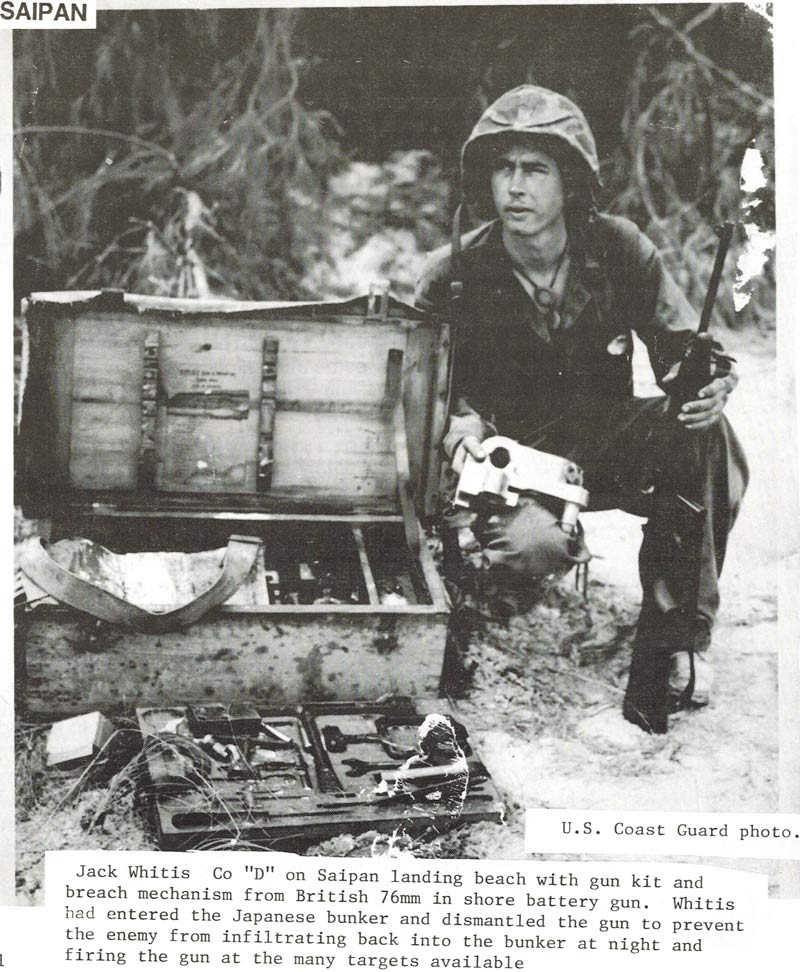
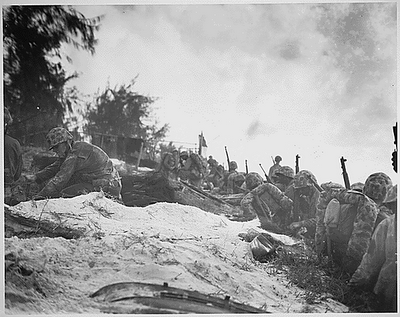
At Saipan...

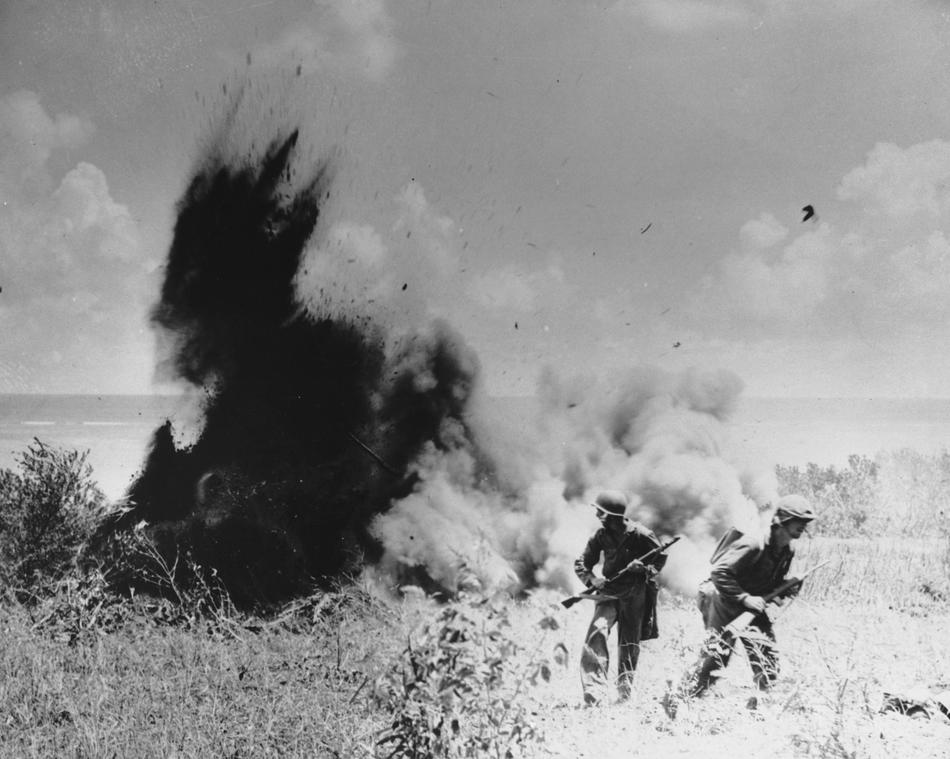
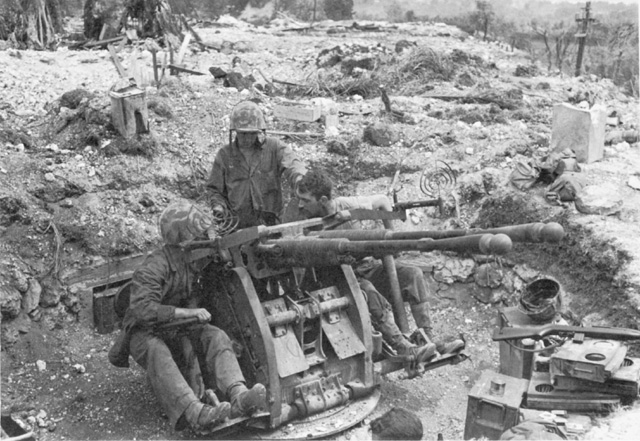
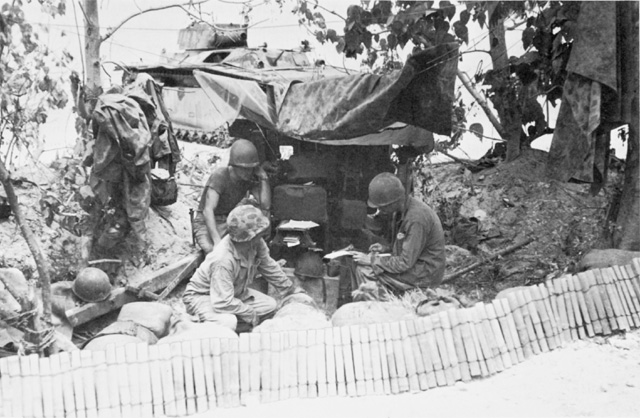
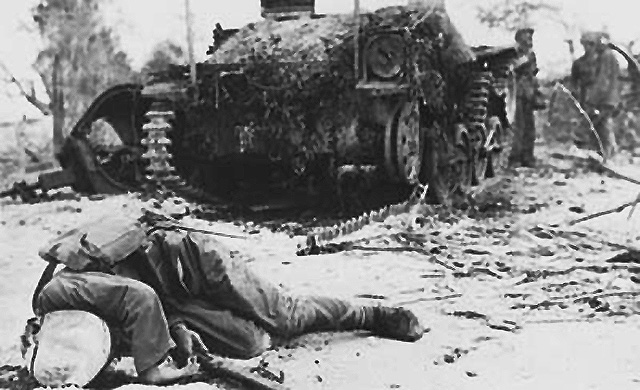
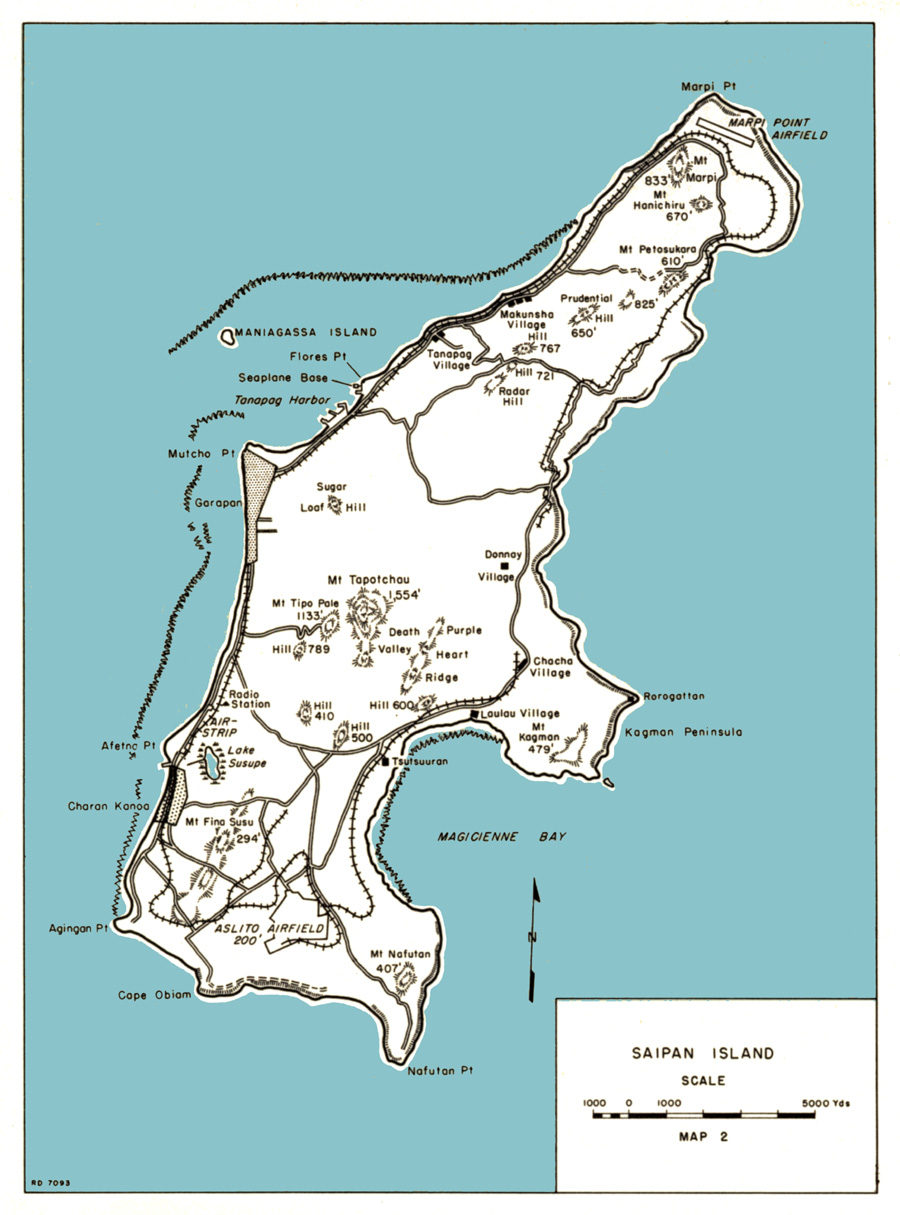
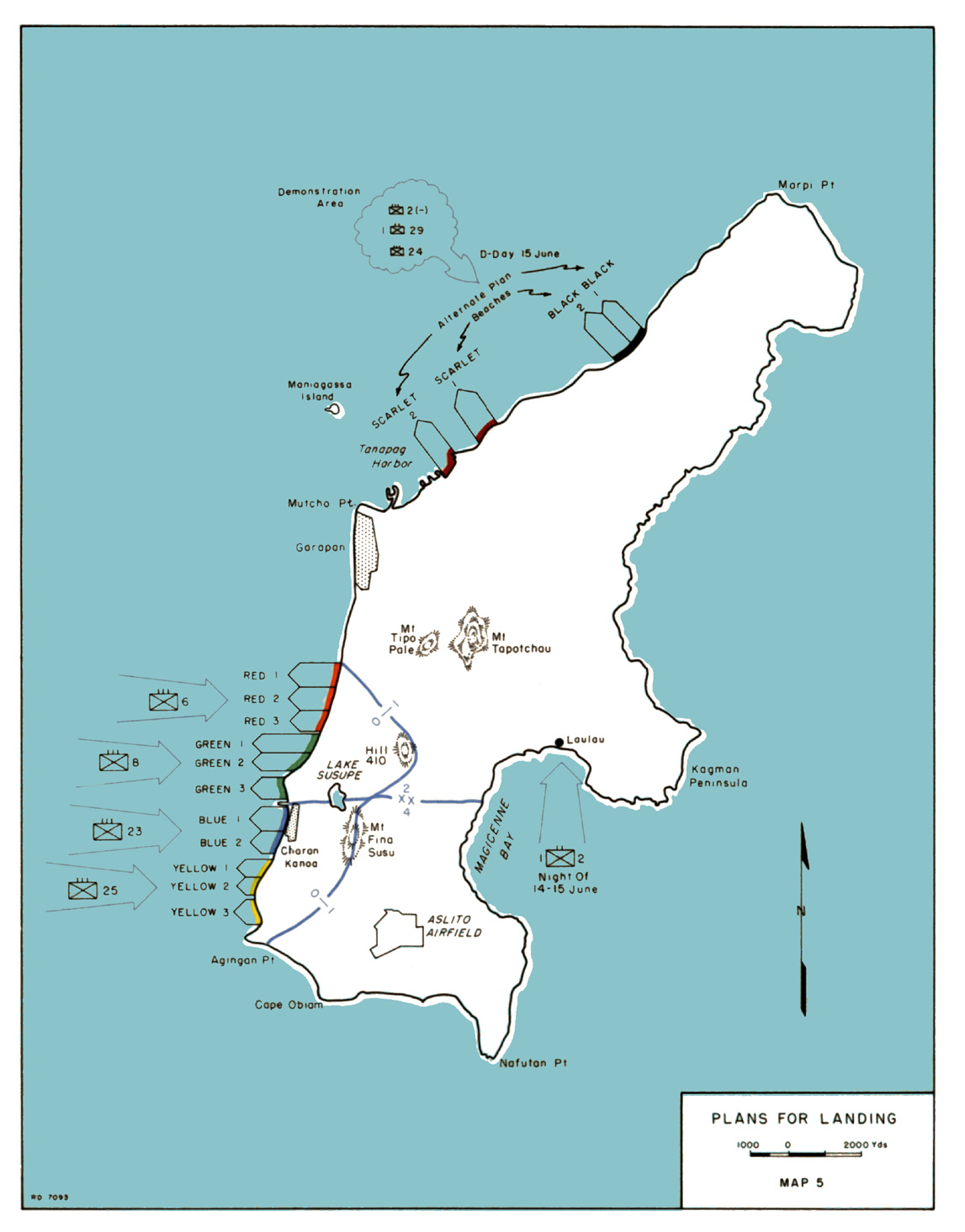



((((((((misc. editing notes Saipan's size, configuration, and topograpthy Earlier assaults had targeted atolls. There, the Navy could mass its firepower against the tightly clustered revetments on the small flat islets, including highly effective fire from the flanks. Plus, atolls were defended by a less than 1, 000 troops, not Saipan's 30,000. Tarawa's initial assault, for example, comprised 1500 men landing on 3 beaches fronting a 390 acre atoll. Saipan required 8000 men landing 8 beaches spanning 6000 yards fronting a 70 square miles of island. Massing firepower on and behind such a beachhead - i.e. finding and hitting targets on the many square miles of ground used to defend those 6000 yards of beachfront - was a far tougher problem. The sheer size of the geography available to the defenders of the beachhead greatly diluted the striking power of naval gunfire. Thus much of the mortars and machine gun emplacements behind the beaches, and most all artillery at higher elevations (particularly on reverse slopes) were overlooked, given that naval gunfire was limited to areas within 1000 yards behind the beach. Obviously, here, some folks were still fighting the last battle, atoll destruction based on map locations. Thus active cooperation between airborne spotters and seaborne batteries in searching out and zeroing in on new targets, (as opposed to those shown on maps), was spotty. The Navy's highly aggressive scheduling of Guam also limited the old battleships preparatory shelling of Saipan and ammo expendure to single one day. (Under Construction - Other natural obstacles magnified the problem. It was feared that Saipan's fringing reef would stop the LCI Gunboats before their rockets and 20mm cannons were within effective range of Red and Beaches beaches. Nor could defiladed naval flanking fire hit those beaches due to shoreline and reef configuration north of Garapan. Troop carrying LVTs carried 18 troops apiece plus 10 cases of small arms ammo, 2 boxes of grenades, 1 coverleaf of mortar ammo, and 4 cans of water.)))))
